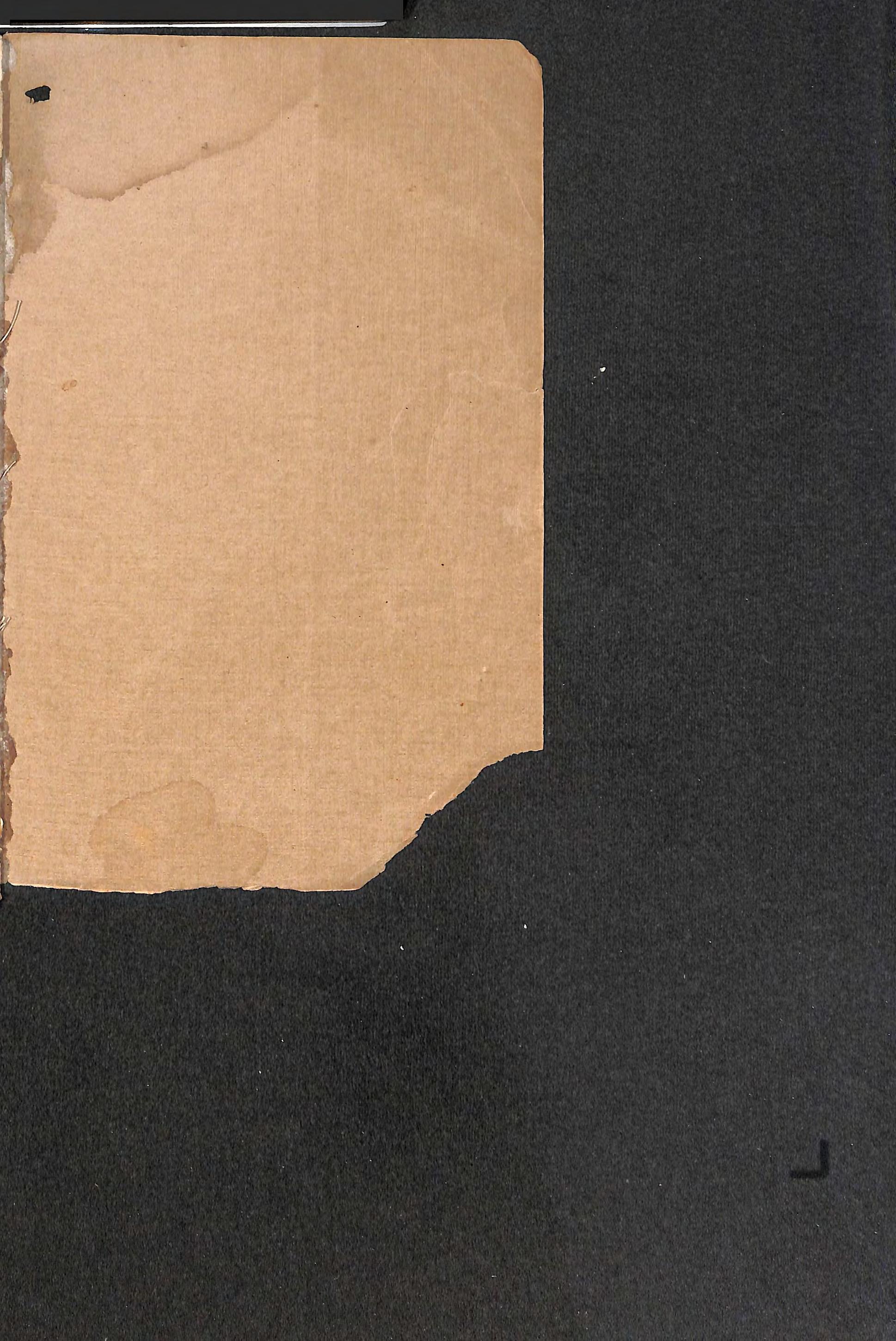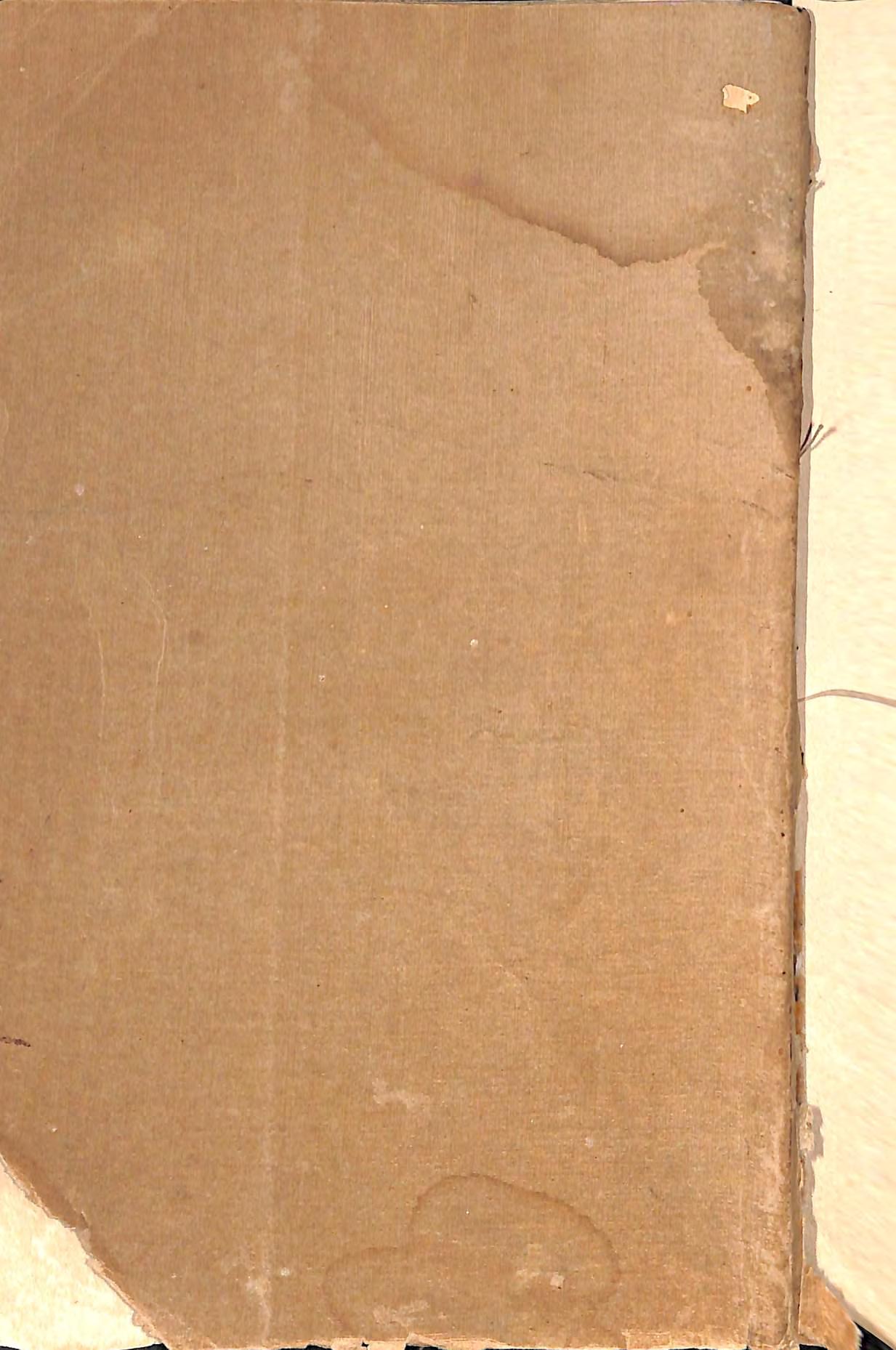

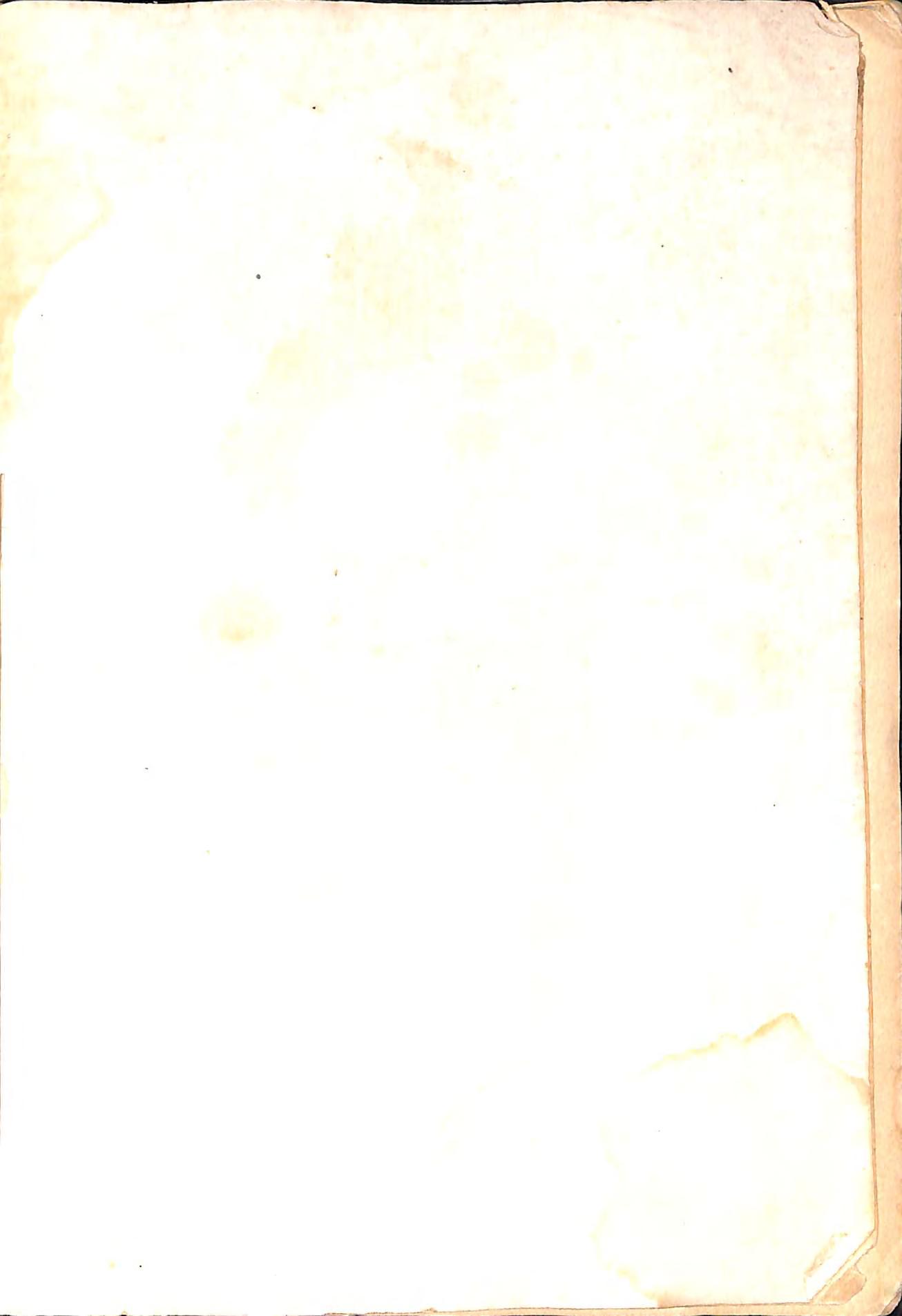







PUBLISHEDBY"
Entered assecond-class matter November12,1914,at thepost-officeatFarrovUle, Virginia,undertheActofAugust24,1912.




1917—^Wednesday, September 12—Opening of Session XXXIV.
Thursday, December 20, Noon—Christmas Holiday begins.
1918—Thursday, January 3—Classes resumed. Monday,January 28—Fall Term ends. Tuesday, January 29—Spring Term begins. April—Easter Monday Holiday. June4—CloseofSession.
Note.—ThoDormitory ■will not be open for boarders until Tuesday, September 11. All newstudents aro required to come on that day, so as to be in place for classification on the morning of September 12. All former students are also required to como on that day, so that the Sched ule Committee may wait upon them before Friday. All Seniors who expect to teach in the Training School must report to the Director of the Training School not laterthan September 12.
Dormitory room will not be reserved for students later than the morning of "Wednesday, September 12, except in cases of special ar rangement.

Wednesday,September12.
9:00RoomB—CourseISecondYearProf.
9:00BoomE—CourseHSecondTearProf.TeachingSection.
9:00RoomD—CourseIIISecondTearProf.TeachingSection.
9:00Room C—CourseXV SecondYearProf.
9:00Room A—CourseV Second YearProf.
10:00 Room E—Course II Second Year Prof. Academic Section.
10:00RoomD—CourseIIISecondYearProf.AcademicSection.
11:30RoomD—FourthYearH.S.,A.L.(OldStudents).
11:30RoomE—FourthYearH.S.,M-Z(OldStudents).
2:30RoomD—ThirdYearH.8.,A-L(OldStudents).
2:30RoomE—ThirdTearH.S.,M-Z(OldStudents). Thursday,September13.
9:00 Auditorium—^All First Year Professional students, including thoseclassifiedWednesday.
11:30TrainingSchool,NinthGradeRoom—SecondYearH.S.
11:30TrainingSchool,EighthGradeRoom—FirstYearH.S.
2:30RoomF—FourthYearH.S.(NewStudents).
2:30RoomE—ThirdYearH.S.(NewStudents).
4:30 Room F—All students not yet scheduled. Saturday,January2G.
9:00RoomB—CourseISecondYearProf.
9:00 Room E—Course II Second Year Prof. Teaching Section.
9:00 Room D—Course III Second Year Prof. Teaching Section.
9:00RoomC—CourseIVSecondYearProf.
9:00RoomA—CourseV—SecondYearProf.
10:00RoomE—CourseIISecondYearProf.AcademicSection.
10:00BoomD—CourseIIISecondTearProf.AcademicSection.
11:30RoomD—FourthYearH.S.,A-L.
11:30RoomE—FourthYearH.S.,M-Z.
2:30RoomF—Specialcasesbyappointment. Monday,January28.
9:00Auditorium—AHFirstYearProf,students.
9:00TrainingSchool,NinthGradeRoom—SecondYearH.S.
9:00 Training School,Eighth Grade Room—First Year H. S.
2:30RoomD—ThirdYearH.S.,A-L.
2:30RoomE—ThirdYearH.S.,M-2.
*Afeeofonedollarmustbepaidbyallstudentswhohaveschedulesmade aftertheappointedtimefortheirclass,unlesstheycangiveasatisfactory reason for the delay.
Note—Now students, when they report to tho Schedule Oommittco, must show their receipts for matriculation and first month's board and their classifi cationrecord. Oldstudentsmustshowthesomereceiptsandtheirsessioncard. Allstudentsarerequiredto_matriculate,paythofirstmonth'sboard,regis trationandmedicalfees,andtuition(ifnotStateStudents)immediatelyupon entrance. See page 30. Immediate attention to thisfacilitates the work of the Olasflfication and Schedule Committees.

JonN"W.Price,President
V.B.Shackelford,Vicc-PTCsident
A.StuartKobertson,Secretary-Auditor HenryCarterStuart,GovernorofVirginia (exofficio)
R.0.Stearnes,SuperintendentofPublic Instruction(exofficio)
JudgeJohnW.Price Brietol,Va.
V.B.Shackelford Orange,Va.
Hon.Eicn.vRDB.Davis " Petersburg,Va.
MerrittT.Cooke 423W.ButeSt.,Norfolk,Va.
D.D.HuiiL,Jr Boanoko,Va.
W.C.Locker .....805E.MarshallSt.,Richmond,Va.
OthoP.Mears Eastville,Va.
W."W.Kino Staunton,Va. AlfredG.Preston Amsterdam,Va.
GeobqeB.Russell DrakesBranch,Va. OscarL.Shewmakb Surry,Va. BrockT.White Keezletown,Va.
ExecutiveCommittee—Messrs.King,Cooke,Locker,Price,and Shackelford.
FinanceCommiiteo—Messrs.Shewmake,White,Eussell,andHull.

J.L.JAEMAN,B.A.,LL.D.,President.
B.A.EmoryaodHenryCollege;UuiversityofVirginia,1886-1889;LL.Z>. Hampden-Sidnoy College.
SAMUELPAGEDUKE,B.A.,M.A., EducationandDirectorandPrincipalofTrainingSchool.
B.A.Bundolph-Macon College,1906;M.A.Teachorfl College. Columbia TJciversity, 1913.
^F.A.MILLIDGE,B.A.,M.A.,Ph.D., Geography.
B.A.University of New Brunswick. Canada;M.A.University of Now Brunswick, Canada; Ph.D.Leipsic University; Student at Normal School, NewBrunswick,1878-'79;SummerCoursesatCookCountyNormalSchool, 1892,1893;Chautauqua Science Course,1893; Summer Coursca University of Chicago. 1894. 1895.
J.M.LEAE,B.A.,M.A., HistoryandSocialSciences.
B.A.and M.A.Randolph-Macon College, Ashlond, Vo.; Student at liolpsic University,1903,-'05;SummerCourseatChicagoUniversity,1910;Summer Courses atColumbio University,1912.1913.
JAMESM.GRAINGER,B.A.,M.A., English.
B.A.UniversityofCincinnati;M.A.UniversityofNorthCarolina.
THOMASD.EASON,B.S., Biology.
B.S.Clemson College(Agricultural and Mechanical College of South Caro lina)1907-GraduateStudentNorthCarolinaCollegeofAgricultureand MeclianicolArts,1908;SummerSession,UniversityofVermont,1914.
M.BOYD COYNER,B.A.,M.A., History of Education.
B.A.ConcordiaCollege,1908;M.A.UniversityofVirginia,1911;Sum merSession,.ColumbiaUniversity,1911;Graduate StudentColumbia University, 1914-'l5.
RAYMOND V.LONG,B. S., M. A., Industrial Arts.
B.S.TeachersCollege,ColumbiaUniversity,1918;M.A.TeachersCollege, Columbia University. 1914.
G. T. SOMEES, B. A., M. A., Psychology.
B.A.CollegeofWillianiandMary,1907;StudentinEducation,University ofVirginia 1908-'09and1909-10;M.A.ColumbiaUniversity,1913;Master'sDiplomainEducation,TeachersCollege,1912. 1DiedNovember22.1916.

CHAELESWILKINSMASON,B.S.,
Affriculturc,andFarmDemonstratorforPrinceEdwardCounty. n. S. MicluRnn Agricultural College, 1909; Taught Agriculture and Science. Hillside (Mich.) High School, ]009-'10; Agricultural Agent, Land and Industriol Department, Southern Railway Company, 1011-'16.
MAETHAW.COULLING,L.I., Drawing.
L.I.,PcahodyNormalCollege,1887;Martha'sVineyardSummerSchool, 1888;StudentunderFredH.Daniels,Summer1900,andunderW.T.Boar, ChauinuQua Summer School,1894;Student in Teachers College, Now York, 1895*'96and1903-'04:AppliedArts,SummerSchool,Chicago,1900.
MINNIE V,RICE, Latin.
OradiiaioFnrmvilloCollege;SummerCourseatHarvardUniversity;Sum mer Course at Columbia University, 1911.
ESTELLESinTEEY,B.A., French and German.
B.A.Handolph-MaconCollege,Ashland,Va.,1915;DiplomaofL'Allionce Francaisc,Paris,1899;StudentattheSorbonnc,Paris,1904-'05;Summer Courses at Columbia University. 1913 and 1914.
LELAG.WINSTON,B.S.,Ph.D., ChemistryovdPhysics.
B.S. Richmond College; Summer Courses in Chemistry and Fhyaics. Harvard University,1903,1906,1907;Ph.D.JohnsHopkinsUniversity, 1911;Summer Course at Columbia University,1914.
LILA LONDON, !Mathcmaiics.
QraduatoHighSchool,Roanokc,Va.jCourseinSurveying,RoanokoCol lege, Salcm. Va.; Special Student in Mathematics xindor Dr. Wm.M. Tliornton,UniversityofVirginia;SummerCourseatKno.willo,Tenn., 1903,andatCornellUniversity,1909.
»FANNIEWYCHEDUNN,L.I.,B.S., Eural Education.
h.I.PcahodyNormalCollege,Nashville.Tenn.;B.S.TeachersCollege, ColumbiaUniversity,1915;Diploma,TeacherofRuralEducation,Teachers College; Graduate Student University of Wisconsin, Summer, 1915.
MABYD.PIEECE,L.I.,B.A., RuralEducation.
L.I.Peabody Normal College, Nashville. Tenn.;B.A.University of Nashvillo; Summer Course,University of Chicago.
GRACE ELDEIDCE MIX,B.S., KindergartenEducation,andSupervisorofKindergarten.
B. S. Columbia University, 1912; Diploma. Hindcrgarton Supervision, Teachers College, 1912; Student Wellesley Collcgo; Graduate Eindergarton TrainingSchool,Worcester,Mass;.StudentClarkUniversity,Worcester, Mass.
LULAV.WALKER, HomeEconomics
Diploma,TeachersCollege,ColumbiaUniversity;Diploma,MarylandState NormalSchool;SummerCourses.TeachersCollcgo,ColumbiaUniversity, ^ nn A Qltvn^n AW* 0«s%«mf*nA T i ^ TT 1 ^
iXOrUlUK OCilUUt I kJUUit44Vfc WW—•MWW, .«• va lit V Vi 190C,1007,1914,1916;SummerCoursesJohnsHopkinsUniversity, 1011, 1913.
^On leave of absence, student at Columbia University.
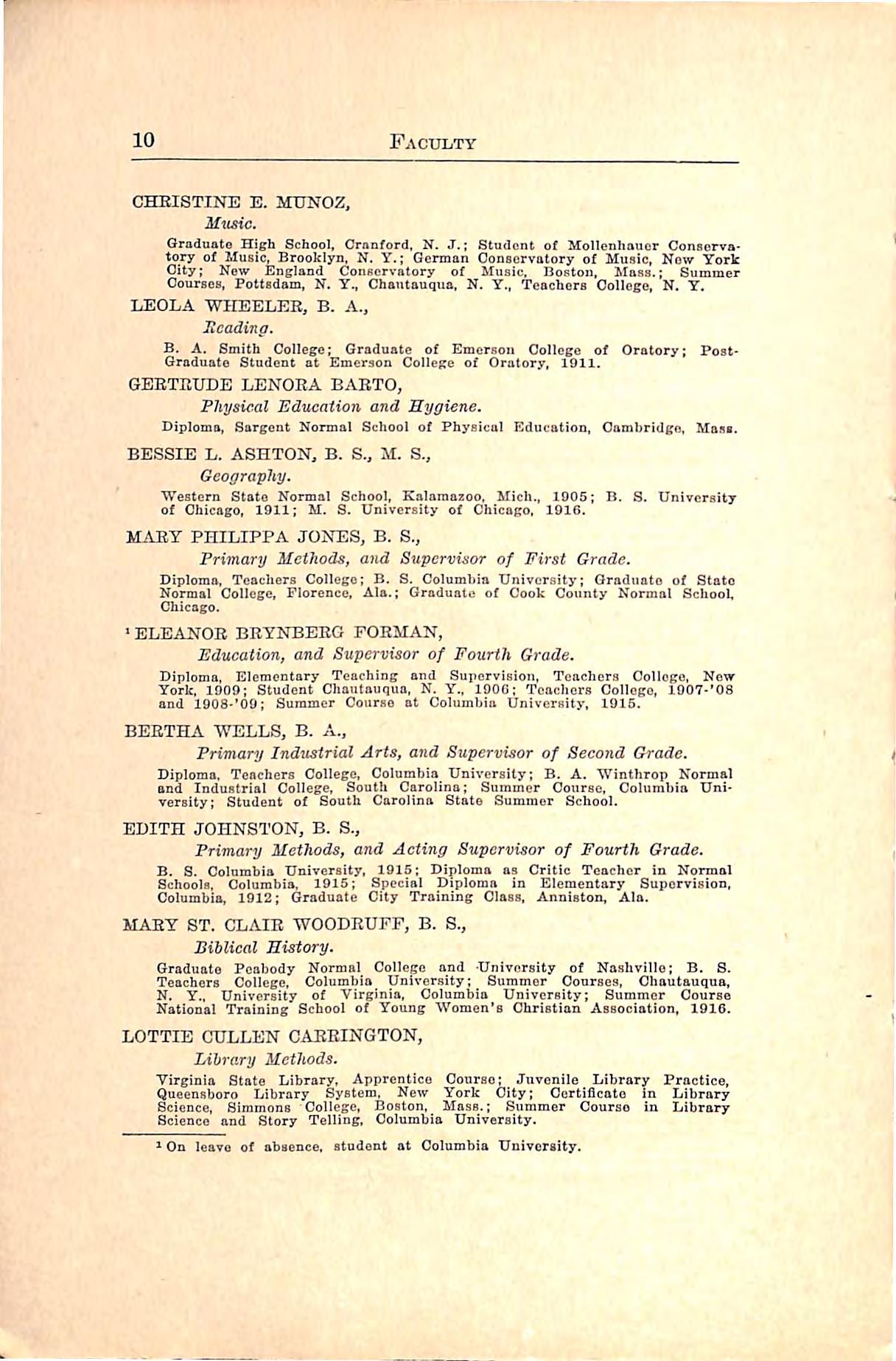
CHRISTINE E.MUNOZ, Mxisic.
Graduate High School, Cranford, N. J.; Student of Mollonliouor ConaorvatoryofMusic,Brooklyn,N.Y.;GermanOonscrvatoryofMusic,NowYork City; Now England Conservatory of Music, Boston, Moss.; Summer Courses, Fottsdam, N.Y., Chautouqiia, N. Y., Teachers College, N. Y.
LEOLAWHEELER,B.A., Heading.
B.A.Smith College;GraduateofEmerson CollegeofOratory;PostGraduate StudentatEmerson Collegeof Oratory,1911.
GERTRUDELENORABARTO, PhysicalEducationandHygiene. Diploma,SargentNormalSchoolofPhysical Education,Cambridge,Mass.
BESSIE L.ASHTON,B.S., M.S., Geography.
YTestern State NormalSchool,Kalamazoo,Mich.,1905;6.S.University of Chicago, 1911; M. S. University of Chicago, 1916.
MARYPHILIPPAJONES,B.S.,
PrimaryMethods,andSupervisorofFirstGrade.
Diploma,TeachersCollege;B.S.ColumbiaUniversity;GraduateofStato NormalCollege,Florence,Ala.;Graduateof Cook County Normal School. Chicago.
*ELEANOR BRTNBERG FORMAN, Education,andSxipervisorofFourthGrade.
Diploma, Elemcntory Teaching and Supervision, Teachers College, New York,1909;StudentChaiitauqua,N.Y.,1906;TeachersCollege,1907-'08 and1908-'09;Summer Course at Columbia University,1915.
BERTHAWELLS,B.A.,
PrimaryIndxistrialArts,andSupervisorofSecondGrade.
Diploma,Teachers College,Columbia University;B.A.Winthrop Normal and Industrial College, South Carolina; Summer Course, Columbia Uni versity; Student of South Carolina State Summor School.
EDITHJOHNSTON,B.S.,
PrimaryMethods,andActingSupervisorofFourthGrade.
B. S. Columbia University, 1915; Diploma as Critic Teacher in Normal Schools, Columbia, 1915; Special Diploma in Elementary Supervision, Columbia,1912; Graduate City Training Class,Annlston, Ala.
MARYST.GLAIRWOODRUFF,B.S.,
Biblical History.
Graduate Peabody Normal College ond University of Nashville; B.S. Teachers College. Columbia University: Summer Courses, Chautauqua, N. Y., University of Virginia, Columbio University; Summer Course NationalTrainingSchoolofYoung Women'sChristian Association,1916.
LOTTIECULLENCARBINGTON, LibraryMethods.
Virginia State Library. Apprentice Course; Juvenile Library Practice, Queensboro Library System, New York City; Certificate in Library Science, Simmons College, Boston, Mass.; Summer Course in Library Bcienco and Story Telling, Columbia University.
2Onleaveofabsence,student atColumbia University.
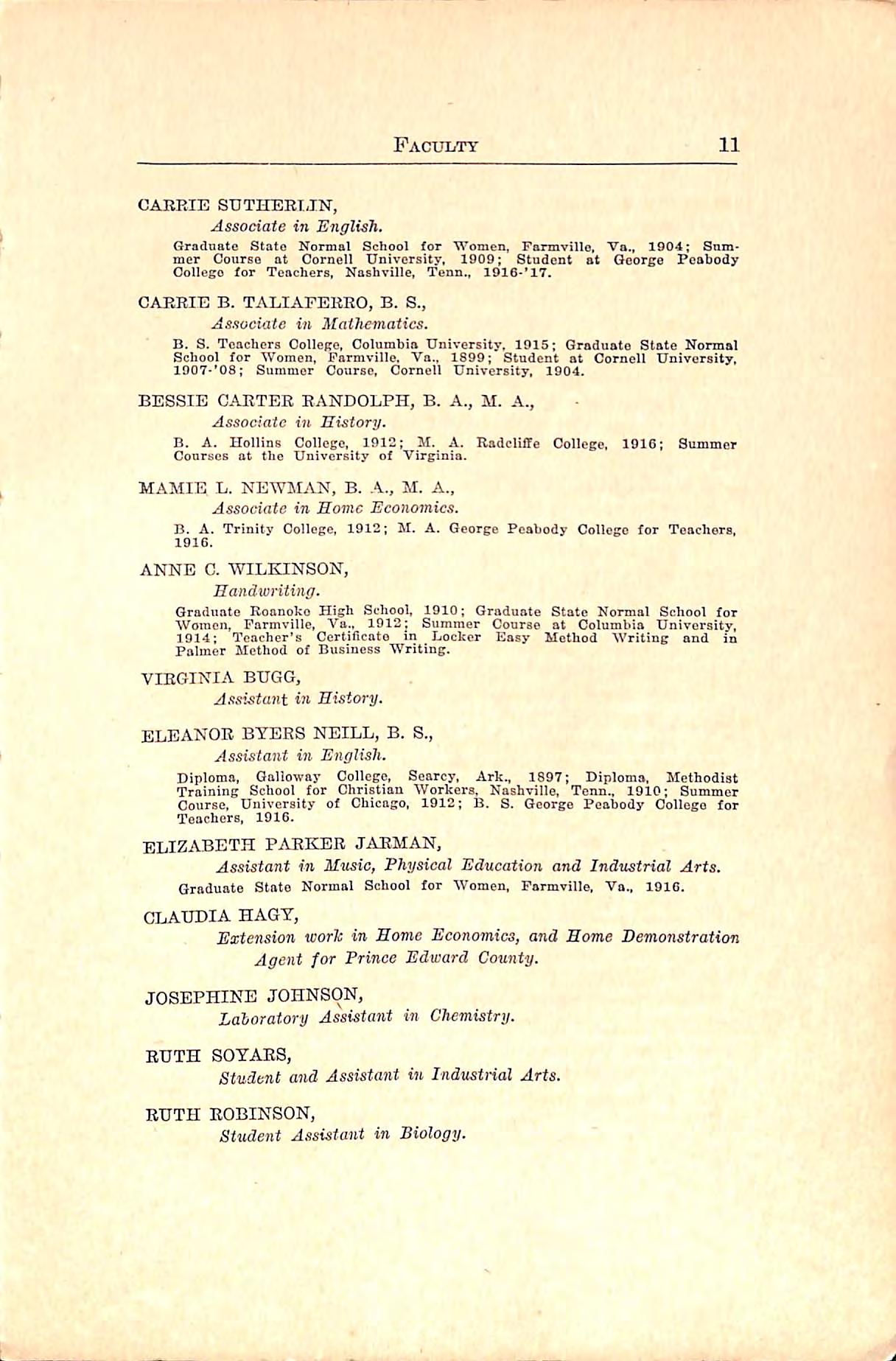
CAKRIE SUTHERTJN, Associatein English.
Qradnatc State Normal School tor Women, Farmvillo, Va., 1904; Sammor Coiirso at Cornell Universtty, 1909; Student at Ocorge Pcabody College for Teachers, Nashville, Tenn., 1916-'17.
CARRIE B.TALIAEERRO,B.S., Associate in Mnt?iematics.
B. S. Teachers OoUogo, Columbia University. 1915; Gradusto State Normal Schoolfor Women,Farmville. Vn.,1899;Student at Cornell University, 1907-'08; Summer Course, Cornell University, 1904.
BESSIECARTERRANDOLPH,B.A.,M.A., AssociateinHistory.
B. A. Holtins College, 1912; H. A. RadclifFe College, 1916; Summer Conrscs ot the University of Virginia.
MAMIEL.NEWMAN,B.A.,M.A.,
Associate in Home Economics. B.A.Trinity Oollcge,1912;II.A.GeorgePcahody Collegefor Teachers, 1916.
ANNE C. WILKINSON, Handwriting.
Graduate Roanoko High School, 1010; Graduate State Normal School for Women,Parmville, Va., 1912; Summer Course at Columbia University, 1914; Teacher's Certificate in Locker Easy Method Writing and in Palmer Method of Business Writing. VIRGINIABUGG, in History.
ELEANORBYERSNEILL,B.S.,
Assistant in English.
Diploma, Galloway College, Searcy, Ark., 1897; Diploma, Methodist Training School for Christian Workers,Nashville, Tenn.,1910;Summer Course,UniversityofChicago,1912;B.S.GeorgePcabodyCollegefor Teachers, 1916.
ELIZABETHPARKERJARMAN, AssistantinMusic,PhysicalEducationandIndustrialArts. Graduate State Normal School for Women,Farmville,Va.,1916.
CLAUDIAHAGT, ExtensionxoorhinHomeEconomics,andHomeDemonstration Agent for Prince Edward County.
JOSEPHINEJOHNSON, LaloratoryAssistantinChemistry.
RUTHSOTARS, StudentandAssistantinIndustHalArts.
RUTHROBINSON, StudentAssistantinBiology.
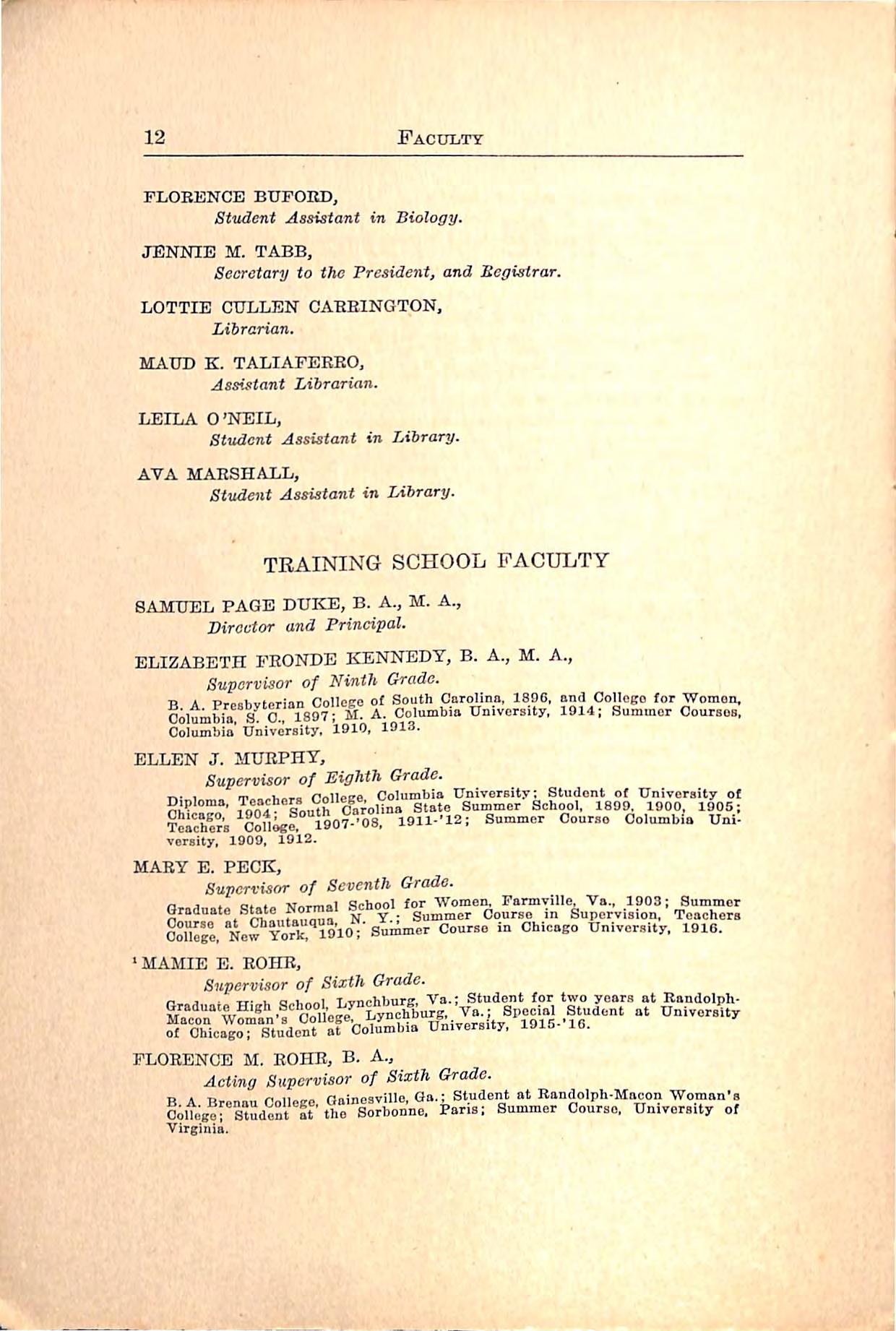
FLOEBNCE BUFOKD, StudentAasistantin Biology.
JENNIE M.TABB, SecretarytothePresident,andBegistrar.
LOTTIE CULLEN CABEINGTON, Librarian.
MAUDK.TALIAFERRO, AssistantLibrarian.
LEILAO'NEIL, StudentAssistantinLibrary.
AVA MARSHALL, StudentAssistantinLibrary.
SAMUEL PAGE DUKE,B.A.,M.A., DirectorandPrincipal.
ELIZABETH FRONDE KENNEDY, B. A., M. A., Supervisor of Ninth Grade. B A Prcsbvterion CollGge of South Carolina,1806, ond CoUoee for Women. Columbia a C 1897; A.Columbia University, 1914; Summer Ooursoa, Columbia'University.1910,1913.
ELLENJ.MURPHY, Supervisor of Eighth Grade. T^., m n/.ii/.f»A ColumbiaUniversity:Studentof Univoraityof Diploma, SummerSchool.1899.1900.1905; ¥53ri Cofligf l90?°03, 1911.'12i Summer Oour.o Oolumbi. U„iversily, 1909, 1912.
MARY E.PECK, Supervisor of Seventh Grade. GraduateStateNormalSchool Co^"S; Ne?Srk;'r91oTsIm^^^^ Course in Ohicaeo University, 1916.
>MAMIE E.EOHR, Supervisor of Sixth Grade. » xt:..!.a»i,nnlUvnchburff,Va.;StudentfortwoycorsatRandolphnnivursu. Of Chicago; Student at Columbia University, 1915- 16.
FLORENCEM.EOHR,B.A., Acting Supervisor of Sixth Grade. T,,T> 11^ nniTiAsvillo.6a.;StudentatRandolph-MaconWoman'sOilfeg?rsWd¥S°SfUh°;°l«b.nBe, JParis; Summer Ooeree. Hnirereit, of Virginia.

PAtTLINE BROOKS WILLIAMSON, SupervisorofFifthGrade.
Graduate State Normal School for Women, Farmville, Va., 1900; Summer OoursoatHarvardUnivorsity,1008;SummerCourse,ColumbiaUniversity, 1912,1913;SummerCourse,ChicagoUniversity,1915.
ELEANORBRYNBERGFORMAN, SttperiiworofFourthGrade.
I'iploma, Elementary Teaching and Supervision, Teachers Oollcgo, New York, 1909: Critic, State Normal Training School, Brockport, N. Y., 1909-'10; Student Ohautauqua,N.Y.,1906;Teachers College,1907-*08 and 1008-'09;Summer CourseatColombia University,1916.
EDITH JOHNSTON,B.S., ActingSupervisorofFourthGrade,andPrimaryMethods.
B. S. Columbia University, 1915; Diploma aa Critic Teacher in Normal Schools, Columbia, 1015;'Special Diploma in Elementary Supervision, Columbia, 1912; Graduate City Training Class, Anniston, Ala,
ELIZA LAVINIA EMERY, Supervisor of Third Grade.
Diploma,PrimarySupervision,TeachersCollege,NewYork,1914;Graduate Olarksvillo High School and Buford's College, Clarksville, Tenn., 1901; Student Chnutauqua, N. Y., 1906-'07; Summer Courses, University of Tennessee,Knoxvillo,1903,1904,1909,and Columbia University,1910. 1911, 3012, 1913.
BERTHA"WELLS,B.A., Supervisor of Second Grade, and Industrial Arts in PrimaryGrades.
Diploma,TeachersOolloeo,ColumbiaUniversity;B.A."WinthropNormal and Industrial College, llock Hill, S. C.; Summer Course, Columbia Uni versity;StudentofSouthCarolinaStateSummerSchool.
MARYPHILIPPAJONES,B.S., SupervisorofFirstGrade,andPrimaryMethods.
B. S. Columbia University; Graduate of State Normal College, Florence, Ala.; Graduate of Cook County Normal School, Chicago.
grace eldeidge mix,B.S., SupervisorofKindergarten,andKindergartenEducation.
B. S. Columbia University, 1912; Diploma, Kindergarten Supervision, Teachers College, 1912; Student Wellesloy College; Graduate Kindergarten TrainingSchool,Worrcster,Mass.;StudentClarkUniversity, ■Worcester. Mass., 1906.
JULIA JOHNSON, Assistant in Kindergarten and First Grade. Graduate of Lcache-Wood Seminary, Norfolk, Va.; Kindergarten Graduate of State Normal School for Women, Farmville, Va., 1910; Summer Coarse at Columbia Univorsity. 1912.
THELMA W. BI.ANTON, Secretary to the Director of the Training School, and Assistant in Second Grade.
Graduate of State Normal School for Women, Farmville, Va,, 1918.
* On leave of absence, student at Columbia University. 4
CommitteeonScheduleofRecitation—MissCoulling,MissSiitherlin, MissBugg,MissDuim,Mr.CoTner,Mr.Somors,andMissEandolph.
Committeeon CourseofStudy—Mr.Jarman,MissLondon,Mr. Grainger,Mr.Lear,Mr.Duke,Mr.Eason,MissCoulling,Mr.Long, MissDunn,andMissAshton.
CommitteeonClassiixcation—MissBice,MissSmithey,MissLondon, and Miss Taliaferro.
CommitteeonTrainingSchoolCourseofStudy—Mr.Duke,Afiaa London,Mr.Lear,MissFonnan,MissPierce,andMr.Grainger.
CommitteeonEntertainments—MissCoulling,Miss Wbeeler,Minn Munoz,andMissBarto.
CommitteeonLibrary—Mr.Grainger,Mr.Duke,andMissMix.
Committee on Bulletins—Mr. Duke, Mr. Grainger, Miss Williamson, MibsLondon,andMissDunn.
CommitteeonAnnual—Mr.Lear,Miss-Coulling,Mr.Eason,Miss Sutherlin,and Miss Neill.
Committee onLiterarySocieties—Mr.Grainger,Mr.Lear,Miaa Wheeler,andMr.Somers.
CommitteeonSchoolMagazine—Mr.Grainger,Miss Wheeler,Mr. Lear,andMissEandolph.
CommitteeonAveragingGrades—MissCoulling,MissLondon,Miss Forman,and Mr.Duke.

^TheProsidentisexofficiomomborofAllcommittoesandcbairmsn ofthe Oommittee on OourBd of Study.

BusinessDepartment 15 BUSINESSDEPARTMENT
Mb. B. M. cox BitsinesaManager
Miss WINNIE HINEE Clerk to Business Manager
MissMAEYWHITECOX Se.ad of the Home
Mrs.MARYPAYNEHARRIS AssistantHeadoftheHome
Miss SUSIE E. ALLEN jdfisisianiinSomeDepartment
MissESTHERFORD Assistant in Home Department
Mes.ANNIESLATER NightMatron
Mbs.BESSIECAMPERJAMISON
Mes.NANNIEV.BERGBB Housekeeper AssistantHousekeeper
Mrs. LILLIAN V. NUNN Supervisor of Laundry
Dr.MARY EVELYNBEYDON Besidcnt Physician
MissLAURAE.VANORMEE,B.N. Trained Nurse
MissMARYST.CLAIRWOODRUFF F.W.C.A.GeneralSecretary

OFFICERS OP STUDENT
StudentGovernmentAssociation
ElsieBaqby President
EstherCovington 5entorVice-Presidcnt
Josephine Gleaves) , ^
Heleh Arthcb 1 V^ccPreMenU
Clara Greene Secretary
ToungWomen'sChriatiai^Association
MelvillbFagg President
Margaret Alexander Vicc-President
IrvingBlanton CorrespondingSecretary
LauraMeredith SecordingSecretary
Jessie Brett Treasurer
Ida Wessells Librarian
MissMartSt.ClaibWoodrupp GeneralSecretary
ArgusLiterarySociety
Buth E. Cook
Mary Ellen White I Presidents
AthenianLiterarySociety
Helen Cahill
Florence Bdfohd I Presidents
CunninghamLiterarySodeiy n
CoNWAT Howard
PierianLiterarySociety AIN )
GertrudeCbiskr
BbttieBoard
JeffersonDebatingSociety
Annie B. Ixickard j Presidents
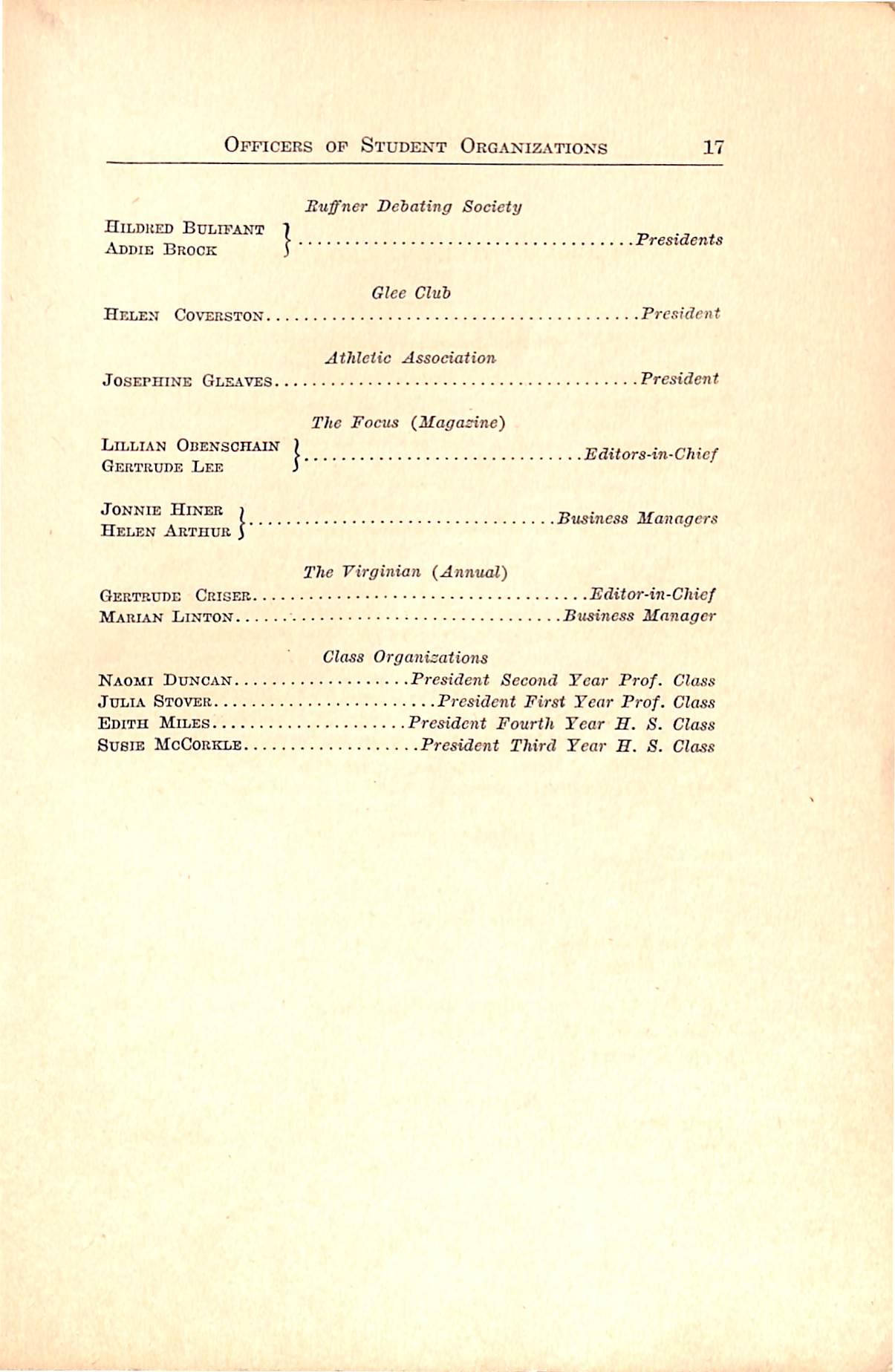
OfficersopStudentOrganizations 17
Suffner Debating Society
HiLDllEDBuLIFANT1 -o ^ Abdie Brook S Pres^^nU
Glee Club
Helen Covzeston President
Athletic Association
Josephine Gleaves President
TheFocus{Magazine)
Lillian OnENSOHAm ) saUors-in-Chief
Gertrude Lee )
JonnieHin-ee BuHness M<,ncgers HelenArthur$
TheVirginian(Annual)
GertrudeCriser Editor-in-Chief
MarianLinton ■ BusinessManager
ClassOrganisations
NaomiDuncan PresidentSecondTearProf.Class
JuliaStover PresidentFirstTearProf.Class
Edith Miles PresidentFourth TearH.S.Class
Susie McCorklb President Third Tear E.S. Class
For some years it lias been the cuErtom of the graduating 4^ class to leave with the school a parting gift,as a token of their i love and loyalty. The follo^ving is a list of the gifts which have resulted from this beautiful custom:
ClassofJanuary,1904—^BiblofoxAuditorium.
ClassofJune,1904—ReadingstandforAuditorium.
ClassofJanuary,1905—Statue(VenusdoMilo).
ClassofJune,1905—Statue(WingedVictory).
ClassofJanuary,1906—Statue(Urania).
ClassofJune,1906—Statue(MinervaJustiniana).
Class of January,1907—Picture (Aurora).
Class of June,1907—Picture (Dance of the Muses).
Class of 1908—Statue (Diana Robing).
Class of January,1909—Picture (Corot Landscape).
Class of June,1909—Flag for dome of Main Building.
Clas.s of 1910—$140.00 for Normal League.
Class of 1911—$140.00 for Normal League.
Class of 1912—$100.00 for pictures for Trainmg School.
Class of 1913—$100.00 for boolis for Infirmary.
Class of 1914—Statue(JeanneD'Arc).
Class of 1910^$100.00 for pictures for Training School.
CLass of 191C—Portrait of President Jarman.
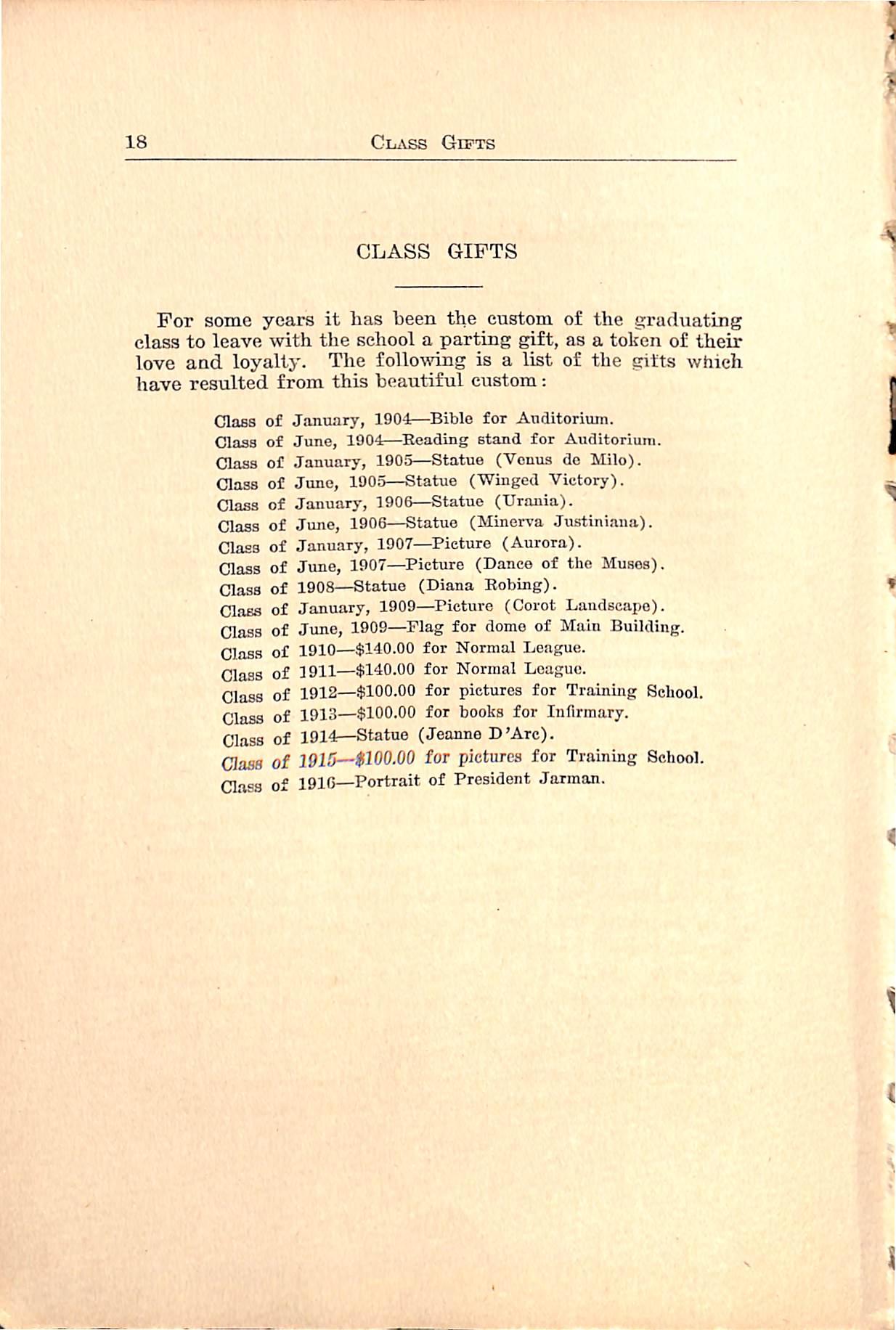
1

Itwasnotnntilaboutforty yearsagothatthe public mind in Virginia came to connect thestableness offree institutions with the intelligence of the people, and to see that general education isthe basisof generalthrift. Thefii^st Legislature to assemble after the adoption of tlie post-belUim Constitution established, July 11, 1870, a system of public schools. For twelve years or more the conduct of these schools was en trusted to such teaching force as was found ready at hand. In this experimental period nothing was more fully demon strated than that, if the returns were to be in any wise com mensurate with the cost and the high mission ofthe system, some provision must be made for a reliable source of supply of teachers fitted by education and training for their work. To meetthis demand the Legislature,in March,1884,passed an act establishing the State Female Normal School. In October of thesame year work was begun,buildingslong in use for school purposes having been procured in the town of Parmville.
Onehundredtenstudentswereenrolledthefirstsession. From the outset the school has steadily grown,making neces sary, from time to time, the enlargement of its accommoda tions. In January, 1914, the Legislature changed the name of the school to State Normal School for Women at Farmville.
In January, 1916, the Legislature granted to the Virginia Normal School Board the privilege of conferring degrees in education. Atthe next meeting of theBoard thisschool was authorized to extend Course IV—"Leading to teaching in high schools"—to a four-year course, leading to the degree of Bachelor of Science in Education.
During the thirty-three years of its existence the school has sent out 1,722 graduates,nearly all of whom are,or have been,

teachers of the public schools in the State. There have been 5,890 matriculates. Of these, a large number (besides those whohavegraduated)havecarriedtothedifferentsectionsof the State some knowledge of the methods and aims of the school. There is hardly a county or city in the State where one of its graduates may not be found,and no section where itsinfluencehasnotbeenfelt.
The State Normal School for Women exists as a technical institution for the training of teachers to carry on the work of popular education in the State of Virginia. The central idea in the school is to inspire young women to enter the pro fession ofteaching with clear and accurateideasofthe various educational problems that confront the public school teacher. Itisnolonger deemed adequatethatateacher be proficient in subject matter only;professional training must be added. Hence, even in the academic work of the school, the profes sional idea is emphasized. Incidental instruction in methods is everywhere given in connection with the presentation of subject matter. Courses in psychology are given to throw light on the laws of mental development,that these may not be violated in the training of youth. Courses in the history of education give the teacher the evolution of the educational ideals ofthe present day,and bring herface toface with the educatorsandteachersofallages,togetherwiththeir methods and sy.stems. Courses in scliool management are designed to help the teacher in organizing and conducting a school upon sound pedagogical principles. Actual teaching in our Training School under the guidance and criticism of special supervisors gives to the State a body of teachers specially trained for their profession. Every department in the institution lends its assistance to the department of education in inspiring the young teachers with the loftiest ideals of what the true teacher should be, and what sort of service should be given the State. Thus, it becomes apparent that the purpose of the institu tion is to give to the teachers of the State of Virginia the

highest profcssiorial skill possible in the training of her future citizens.
Farmville is a healthful and pleasant town of about three thousandinliabitants. Itisoneofthechieftobaccomartsof Virginia, having a large export trade. Hampden-Sidney College is near by, and the social life of the town has the advantages that have come of over a hundred yeare of whole some college influence. It has good schools and five churches— Baptist, Episcopal, Methodist, Presbyterian, and Lutheran. Its location at the junction of the Tidewater and Western Railroad with the Norfolk and Western, about midway between Lynchburg and Petersburg, puts it in communica tion with all parts of the State.
The main building is a three-story brick structure, contain ing an auditorium, a reception hall, parlors, students' sittingroom,a library, reading-room, thirty class-rooms, chemical, biological, and geographical laboratories, manual training worlcshop, gymnasium, six offices, and home accommodations forfourhundredtenstudents.
There is steam heat and electric light throughout the build ing. The dormitories are attractively furnished and are pro videdwithwhiteironbeds.
Nearthemain building,yetentirelyapartfrom it,isa wellequipped infirmary, in charge of a woman physician and trained nurse, both of whom live in the building and give their entire time to tlie health of the students.
The new Training School is a modern school building, planned and constructed so as to meet the needs of a tnoroughly up-to-date school and at the same time facilitate the training ofteachers.
The Normal School is supported by the State in order that, through the agency of trained teachers, the large annual ap-
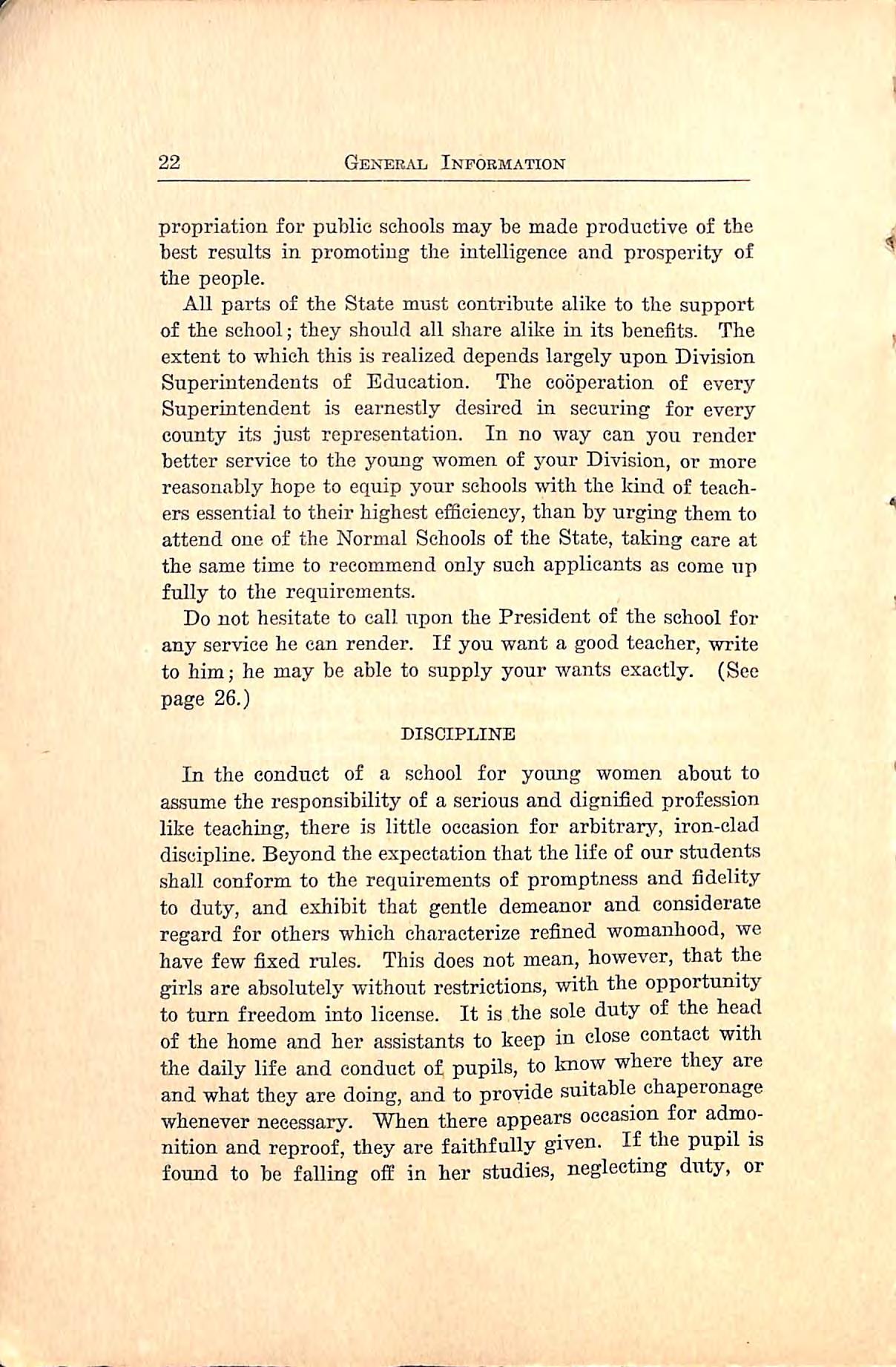
propriation for public schools may be made productive of the best results in promoting the intelligence and prosperity of the people.
AH parts ofthe State must contribute alike to the support of the school;they should all share alike in its benefits. The extentto which this is realized dependslargely upon Division Superintendents of Education. The cooperation of every Superintendent is earnestly desired in securing for every county its just representation. In no way can you render better service to the young women of your Division,or more reasonably hope to equip your schools with the kind of teach ers essential to their highest efficiency, than by urging them to attend one ofthe Normal Schoolsofthe State,taking care at the same time to recommend only such applicants as come up fully to the requirements.
Donothesitate to callupon the Presidentofthe schoolfor any service he can render. If you want a good teacher, write to him; he may be able to supply your wants exactly. (See page 26.)
In the conduct of a school for young women about to assume the responsibility of a serious and dignified profession like teaching, there is little occasion for arbitrary, iron-clad discipline. Beyond the expectation that the life of our students shall conform to the requirements of promptness and fidelity to duty, and exhibit that gentle demeanor and considerate regard for others which characterize refined womanhood, we have few fixed rules. This does not mean, however, that the girls are absolutely without restrictions, with the opportunity to turn freedom into license. It is the sole duty of the head of the home and her assistants to keep in close contact with the daily life and conduct of pupils, to know where they are and what they are doing, and to provide suitable chaperonage whenever neeessary. When there appears occasion for admo nition and reproof, they are faithfully given. If the pupil is found to be falling off in her studies, neglecting duty, or

exerting an unwliolsome influence, prompt steps are taken for her amendment. A young woman who does not show some disposition to conform to high standards can hardly be considered good .material for a teacher; so, if one is found imrcspousive to patient endeavors to bring her to the line of duty, her connection with the school is quietly severed by virtue of the following order of the trustees: "If, in the judgment of the President, it shall at any time appear tliat a studentis not making proper use of the advantageswhich the State offers in the State Normal School for"Women,or that her influence isin any way prejudicial to the interests of the institution, or of her fellow students, it shall be his duty to declare her place vacant."
The purpose of the association is to preserve the student honor and to further the interest of the school as far as lies within its power.
It has jurisdiction over the girls during study period and in the dining-room,and in all cases in which the good name of the student body as a whole would be involved.
Decisionsrendered bytlie Student Government Committee are reviewable by the President.
While a State institution, and heuce not under denomina tional influence, the importance of a life higher than the intellectual is fully realized, and the religous interests of the students are a matter of constant and prayerful concern. School is opened every morning with the reading of the Scrip tures, a hymn, and prayer. The ministers of the several de nominations of the town take part in conducting these services.
The members of the faculty, at the beginning of each term, obtain lists of students of their respective denominations, and see that each one is invited to tlie church and Sunday school which she is in the habit of attending at home. There are

several teachers belonging to each of the religious denomina tionsrepresented in Parmville,and ourstudents are cordially welcomed at whatever church they may attend, and are urged to join Sunday-school classes. Attendance on church services is not compulsory, but its regular observance is urged upon the students as a sacred duty.
Theschool endeavors to maintain high moral and Christian standards, and to create an atmosphere of earnestness; lor it is esteemed to benottheleastimportantmission oftheinstitu tion to send out young women equipped with a steady purpose toperform wellandfaithfullythedutiesthatliebeforethem— a holy purpose to make the most of themselves, that they may do most for others.
The Young "Women's Christian Association aims to unite all the students in school in common loyalty to Jesus Christ, building them up in the knowledge of Christ through Bible study and Christian service. It urges upon its members the value of church membership, church loyalty, and responsibilty forsomeformofchurchwork.Itsinterdenominationalchar acter widens its interest, broadens its sympathies, and deepens its spirituality.
The Association is affiliated with the National Board of Young Women's Christian As.sociations of the United States, and thus with the national organizations of eighteen other nations, whose entire membership includes 500,000 Christian women.
The activities of the Association are entirely in charge of the student members. They hold weekly devotional meetings in the auditorium every Wednesday evening at 6:30 o'clock, besides conducting evening prayers after supper every night, and morning watch daily at 7:15 o'clock. The Bible Study Committee urges every student to do some form of daily Bible study and invites her to join a class in the Sunday school of her own denomination, taught by faculty membens. Mission

reading circles,led by membersofthe faculty,afford students an opportunity of becoming acquainted with world conditions, and foster a spirit of world interest and fellowship. The SocialServiceCommitteeseekstobeofserviceoutsidethe Association itself in many practical ways.
Our Association contributes to the support of Miss Elsie Green, an Association Secretary in Tokyo.
A Town Girls Committee has as its sole activity the reach ingofthestudentsboardingin and livingintown. Itlocates all these girls assoon astheir addresses are obtainable in the fall, asks them to become members of the Association, ar ranges special gatherings at times when they can meet,and keeps them informed of all school and Association acti"\dties.
As many girls as possible are asked to go as delegates to theSummer ConferenceatBlueRidge,North Carolina,which is one of the most notable opportunities offered by the school
A well-furnished sitting and readingroom belongingto the Association affords a placeforsocial affairs,or,better still,a place where one can be quiet, away from the hurry of school.
The members of the Association show every courtesy to the new student as slie adjusts hcr-self to the new and bewil dering routine of school life. Hand-books, issued by the As sociation and giving a concise account of student life in the school, are sent to girls about to enter for the first time.If any girl happens to be overlooked, the General Secretary, whose lieadquarters are in room 52,will be very glad to give them to the newcomers at any time. She would deem it a great favor if every new girl would find her out and make herself known to her some time during the first week of the term.
Every j'oung woman attending the school is cordially in vited to become a member of the Young Women's Christian Association and to help it to realize its purpose through her interest and heartysupport.
The Virginia Normal League was organized in the spring of 1898 by Dr. Robert Frazer, then president of the school.
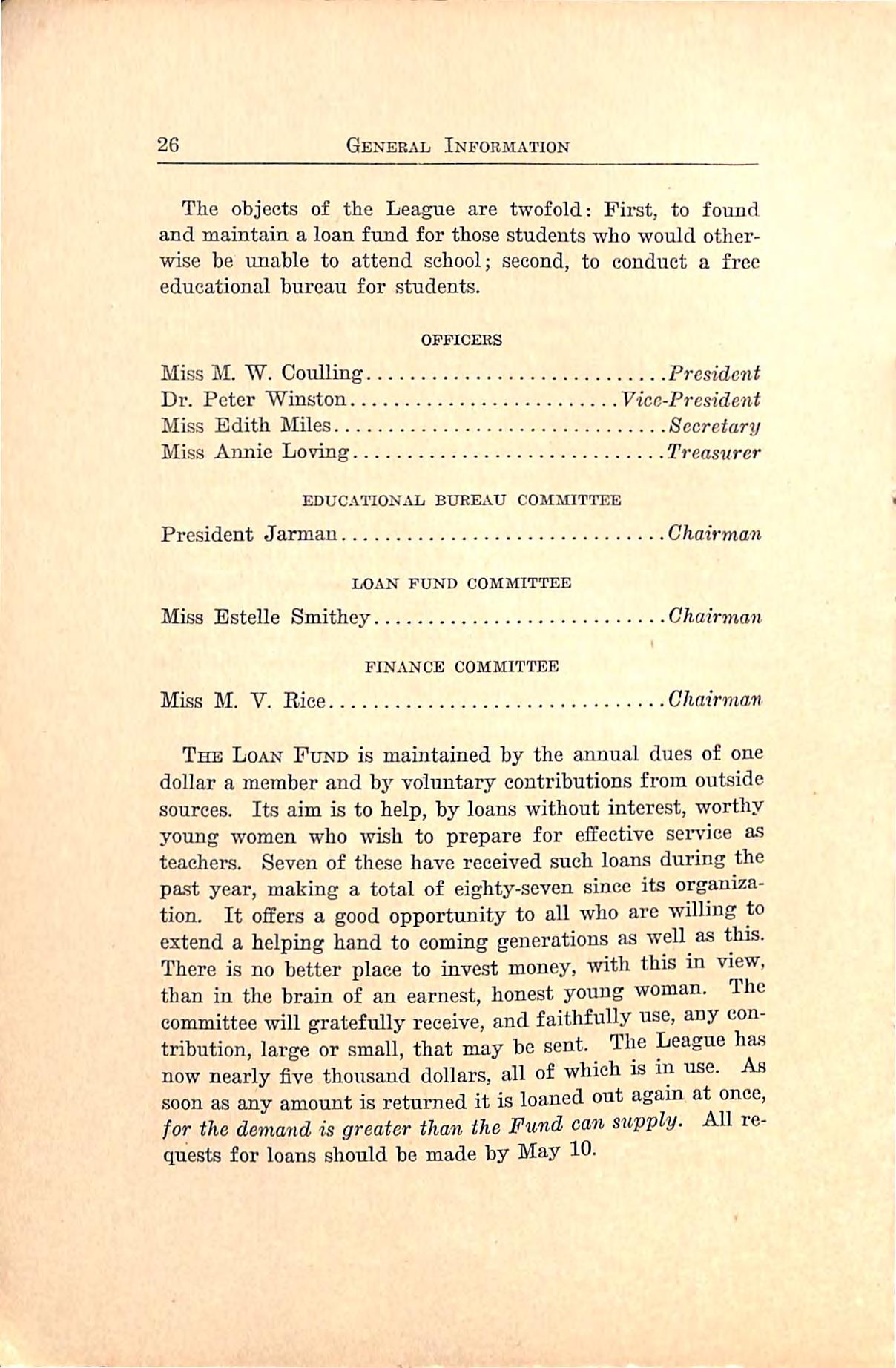
The objects of the League are twofold: First, to found andmaintainaloanfundforthosestudentswhowouldother wise be unable to attend school; second, to conduct a free educationalbureauforstudents.
Miss M.W.CouUing President
Dr.Peter"Winston Vice-President
Miss Edith Miles Secretary
Miss Annie Loving Treasurer educationaij bureau committee
PresidentJarmau Chairman
LOAN FUND COMMITTEE
Miss Estelle Smithey Chairman {
FINANCE COMMITTEE
MissM.y.Rice Chairman
The Loan Fund is maintained by the annual dues of one dollar a member and by voluntary contributions from outside sources. Its aim is to help, by loans without interest, worthy young women who wish to prepare for effective seiwice as teachers. Seven of these have received suchloans during the past year, making a total of eighty-seven since its organiza tion, It offers a good opportunity to all who are willing to extend a helping hand to coming generations as well as this. There is no better place to invest money, with this in view, than in the brain of an earnest, honest young woman. The committee will gratefully receive, and faithfully use, any con tribution, large or small, that may be sent. The League h&s now nearly five thousand dollars, all of which is in use. soon as any amount is returned it is loaned out again at once, for the demand is greater than the Fund can supply. All re quests for loans should be made by May 10.

TheEducationalBureauseekstoserveasafreemedium of coirmiunicatiou between tcaebers trained and approved by the school, and persons who wish to employ teachers. It engages to recommend only such as are believed to be thor oughly qualified for the work contemplated, and in all respects trustworthy. County superintendents, school trustees, and others desiring good teachers, will do well to apply to the Bureau. Fullinformationwillbefurnishedwithoutcost.
We shall be glad to hear from former students of the school. Tell us where you are, and what you are doing. Please bring the Bureau, as far as you can, to the Imowledge of the public, especially those interested in employing teach ers, and inform us of vacancies whenever you can. We bog you also to talce the lead in organizing auxiliary chapters in your counties. Eight have already been organized—in Bristol, Roanoke, Farmville, Danville, Richmond, Lynchburg, Covington, and Salem. Information as to these wiU be sent on ap plication. Address, Virginia Norm.\l League, Farmville, Virginia.
The Alumme of the school who graduated during the administration of Dr. John A. Cumiingham, from 1886 to 1896, have raised a fund, intending to establish a scholarship in memory of his faithful and loving service to them and to the State, feeling that the most fitting tribute that could be paid him would be the effort to give to those who are unable to obtain it for themselves the training for the work to which he devoted his life.
When this fund amounted to $1,000 it was decided that, imstead of letting it lie idle until it reached a sufficient sum to endow the scholarship, it should be placed in the hands of the President of the school, to be loaned at five per cent, interest to worthy students who could not pay their own expenses. Thus, it is hearing fruit even before the scholarship is estab lished, and proving of great assistance to some of our best students.

Those wishing to obtain a loan from this fund should apply to President Jarman.
The State of Virginia providesthatasum equalto one per cent,ofthe annual appropriation of State institutions be used asaLoanFundforthebenefitofstudentswhoareunableto defray their expenses. Not more than $100.00 per session is loaned to a student. The interest required is four per cent., and all notes must be properly endorsed. Applications for assistance from the State Loan Fund shouldbeaddressedtoPresidentJarman.
Thestudents aresupplied with collateral reading,reference work, and recreative reading from a library of 8,088 classified volumes and a reading room containing encyclopedias, dic tionaries, atlases, twelve daily and thirty-four weekly and semi-weekly papers of the State, besides one hundred nine well-selected departmentaland popular periodicals.
There are four literary societies, the Argus, the Cunning ham, the Pierian, and the Athenian, and two debating socie ties, the Jefferson and the Ruffner. These are an important factor in the intellectual and social life of the school. They impart a strong impulse to literary work and debating, and bring the girls together at regular times for a common intel lectual purpose. The literary societies aim primarily to pro mote a real interest in literature, the debating societies to afford an opportunity for practice in debating to every stu dent above the second year class who will avail herself of the opportunity. All of the societies attempt to develop and ex ercise individual talent, to arouse and encourage social in stincts, and to afford practice in organization and in parlia mentaryusage.
Meetings are held every two weeks throughout the year,

and asph'it offriendly rivalry isshown in the effort to offer interesting programs. Each literary society chooses some special period ofliterature orsome wi'iter or group of writers to be studied during the year. Thisstudyforms the basis of the literary programs. Debates also arc held at regular inter vals by the literary societies. The debating societies hold spirited debates regularly. These debates develop the powers of argument, clear and logical thinking, and forceful expres sion. In addition to this work all the societies hold special meetings, which add variety. The programs for these meet ings are in a lighter vein, and afford opportunity for the exercise andencouragementof musical and histrionictalent.
TheFocusisa monthly magazine published by thestudents. The editorial staff is composed of the students and two alumjiffl, who are assisted by reporters from the different classes and school organizations. The magazine aims to pro mote literary activity among the students. Trophies are awarded to those who contribute the best work. The Virginianisan annual publication whichis edited and published by the Second Year Professional class.
Any young lady desiring an appointment as State student should apply to the President for application blank. This blank, when filled out and signed by the Division Superin tendent, should be returned to the President. If the appli cation is favorably considered, the applicant will be notified of her appointment. Every State student is required to sign a pledge that she will teach in the public schools of Virginia for at least two years after leaving the Normal School. While th\is teaching she receives pay for her services as any other teacher.
Upon tlie expiration of this period she is required to send to the President a statement, signed by a Division Superin tendent, to the effect that she has fulfilled this pledge; or make
to Mm a satisfactory explanation of her failure to do so. Otherwise, she will receive a bill for her tuition.
All students applying for State scholai'ships must be at least fifteenyearsofage,ofgood moralcharacter,andsound health. Young women from Virginia, not appointed as State students, and applicants from other States, arc admitted as pay students; the charge for tuition being $30.00 per session.
A registration fee, payable in advance,for entire session, $10.00. Public school teachers entering in April are charged no registration fee.
A medical fee,payable in advance,for entire session,$5.00. No medicalfeeischargedstudentswhosehoihcsareinFarmville. Board,including furnished room,fuel,lights,laundry, bed ding and towels, everything for the entire session, $162,004* Board is not charged by the month, but for the entire ses sion; and, for the convenience of the students, is divided into nine equal payments, payable one month in advance. No re duction will be made for absence under thirty days, nor for Christmas holidays.
Students must come prepared to make the following pay mentson entrance:

Total
The remaining payments on board are due the tenth of each month, and must he paid when due.
Checks for board or tuition should not be made payable to the President, but to the student herself.
The fees for laboratory courses are stated in connection withtheoutlinesofthesecourses.
Tuition for pay students, for the half session, payable in advance, $15.00.
*0n account of the unuBual and uncertain prico j^Vo^'flnd to rosorvo the privilege of rajBjng tho hoard for ^ho Se«ud ..avment will Itttbvolulelvnecesaarv,withtheunderstandingthattheroouthlyiy W not exceed $20.00.

The total expense per session for a State student,as shown above,is $177.00;for a pay student,$207.00.
Ail money due the Scliool should be paid to Mr.B.M.Cox, Business Manager,and receipts taken therefor.
Registration fees should be paid to Mr. Cox as soon as possible after arrival at school, as no student is enrolled in herchLssosuntilshecanshowareceiptforthisfee.
No diploma or certificate is granted to anyone until all sums due the school arc paid, nor are students at liberty to occupy the rooms previouslj^ assigned to them until they have madetheadvancepayment.
Eachstudentmustsupplyherowntext-books.Bookswill be furnished at publishers' prices, with cost of handling added.
All communications of inquiry, requests for catalogues, etc., should be made to the President or Registrar.
In writing,always give your county as well as post office. The School has to do with counties and cities, not post offices. Ifyou wish yourletterto receive promptattention,give your county,even though youlivein a town.
Eachstudentisallowedareasonablenumberofarticlesin the laundry each week, but elaborately trimmed garments are not received.
The Dormitories accommodate four hundred fifty students. For applicantsin excess of this number board is obtained in private families at prices about equal to those given above. Nostudent,however,is allowed to board outside of the build ing without the consent of the President.
The course of study (see page 39) is arranged by terms, the A classesbeing offered in thefalland theB classesinthe spring terra. The work of the fall term is not repeated in the spring term, hence it is much better for students to enter in September than in February.
In classifying pupils, tbc aim is to make their classification

as nearly regular as possible, yet the graded system is not strictly adhered to.
The following are the general regulations governing en trance and classification:
1. Graduates of approved high schools are admitted as follows:
Graduatesfrom approved four-year high schools may enter Professional Courses I, II, III, IV, or V, and upon the com pletion of Courses I,II,III,or V,or the first two years of Course IV,receive the Diploma. Upon the completion of allfour yearsof CourseIV theyreceive the Degree ofBachelor ofScienceinEducation.
Graduates of approved three-year high schools, or the equivalent, are required to take another year of high school work before entering upon the professional work. The work of this year isselected by the Committee on Classification to fitthe ca.se in question.
Professional Courses I, II, III, and IV lead to teaching in the kindergarten-primary, the primary grades, the grammar grades and the high school, respectively. Course V leads to the teaching of Home Economies and to Rural Demonstration Work.
ThefalltermoftheFirstYearofallfivecoursesisthe same,so that a student has a whole term of contact with pro fessional work before she is called upon to decide where she isbestfittedtoteach,and hence,which coursesheshould elect.
In addition to the above requirement applicants for Course I (kindergarten-primary) must have sufficient knowledge of instrumental music to enable them to play simple marches with ease. They must also be capable of leading the children in the singing of simple songs. This ability in music is tested by the Supervisor of the Kindergarten.
2. Students coming from approved high schools before graduating are fitted into the High School Course. If, however, they lack only a few points of graduation from a
Notb.—See "Courses and Certificates" (page 36).

four-year high school they are allowed, if they prefer it, to complete the requirements of their own school.
3. Students coming from colleges, academies, or private schools, having done the equivalent of high school work, are admitted upon trial, subject to the same conditions as high school graduates. Those not having done the equivalent of high school work are fitted into the High School Course.
4. Holders of First Grade Certificates may enter the First Tear of Coui*se II,HI,or V,and upon the completion of the year's work may receive from the Department of Public InstructiontheProfessionalFirstGradeCertificate.
5. All candidates for admission by certificate must file with the Classification Committee not later than September 1 their certificates of preparation made out on the blank fur nished by the registrar. These blanks must come from some recognized institution or accredited school, must be made out by some member of the faculty, and must bear the signature of the head of the school from which they come. They must come direct to the Classification Committee and not through the hands of the candidate in question. The persons filling out these blanks are requested to make them full, explicit, and definite as possible.
Certificates of preparation from private tutors and from ungraded rural schools will not be accepted. Students thus prepared must in aU cases take entrance examinations.
6. All classification based upon certificates and diplomas from other schools is conditional. If at any time the student shows inability to do the work of any class to which she has been thus admitted, she is assigned to a lower class at the discretionoftheteacher.
7. Teachers of public schools are admitted without exami nation to any classesthey are prepared to take,on a basis of their licenses, and without tuition fees.
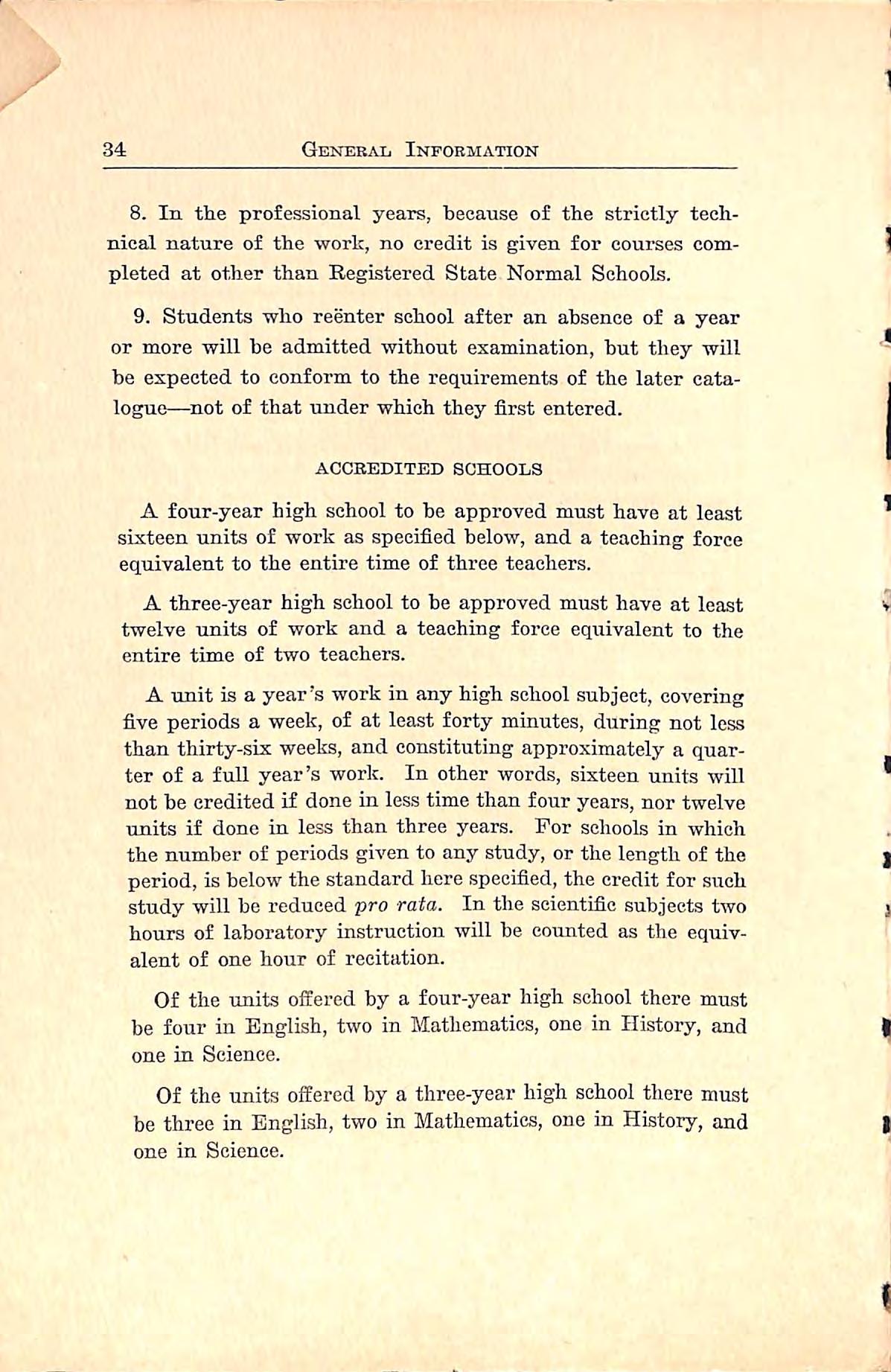
8. In the professional years, because of the strictly tech nical nature of the work,no credit is given for courses com pleted at other than Registered State Normal Schools.
9. Students who reenter school after an absence of a year or more will be admitted without examination, but they will be expected to conform to the requirements of the later cata logue—not of that under which they first entered-
A four-year high school to be approved must have at least sixteen units of work as specified below, and a teaching force equivalentto the entire time ofthree teachers.
A three-year high schoolto be approved must have at least twelve units of work and a teaching force equivalent to the entiretimeoftwoteachers.
A unit is a year's work in any high school subject, covering five periods a week, of at least forty minutes, during not less than thirty-six weeks, and constituting approximately a quar ter of a full year's work. In other words, sixteen units will not be credited if done in less time than four years, nor twelve units if done in less than three years. For schools in which thenumberofperiodsgiventoanystudy,orthelength ofthe period,is below the standard here specified,the credit for such study will be reduced pro rafa. In the scientific subjects two hours of laboratory instruction will be counted as the equiv alent of one hour of recitation.
Of the units offered by a four-year high schoolthere must be four in English, two in Mathematics, one in History, and oneinScience.
Of the units offered by a three-year high school there must be three in English,two in Mathematics, one in History, and oneinScience.
The remaining units may be selected from the following list:
Subject
English:
Mathomatics: Topics
GrammarandComposition
RhetoricandComposition
EnglishLiterature,withcriticalstudyofselec tions
American Literature, or critical study of any portionofAmerican,orofanyportionof English Literature
Algebra,toQuadraticEquations. SecondaryAlgebracompleted....
Piano Geometry
SolidGeometry
PlaneTrigonometry

History:
Latin: AncientHistory MedimvalandModemEuropeanHistory. EnglishHistory
German:
French: Science:*
AmericanHistoryandCivilGovernment.
Grammar,CompositionandTranslation.. Cosar'sGallicWars,I-IV;Grammar, position
Com-
Cicero'sOrations(6);Grammar,Composition.. Virgil's.^neid,I-VI;Grammar,Composition..
Grammar,Composition,andTranslation. Grammar,Composition,andTranslation. PhysicalGeography
ChemistrywithLaboratorywork
isunderstoodthattheunitsascreditedinthislistcoverthorequired timeandreferonlytohighschoolwork.
*HighSchoolcoursesinScience,otherwiseadequate,willboallowedonly half credit unless field work and individual laboratory work have been dono and attestedeitherbycortillcatoorbytbopresentationofproperly certiflod note books.

This school offers five professional courses, four leading to a diploma and one to a degree, as follows: Courses I,II, III, and V to a diploma; Course IV to the degree of Bachelor ofScienceinEducation.
Professional Course I prepares for kindergarten-primary; Course II, for primary; Course III, for grammar grades; CourseIV,for high school; Course V,for county demonstra tion work andfortheteachingof Home Economics.
Courses II and III have A and B groups, preparing respect ivelyforcity andfortown orcountryschools.
CourseIVissoarrangedthatadiplomamay begiven upon the completion ofthefirsttwo years,and the degree of Bach elor of Science in Education upon the completion of the four years.
The entrance requirement for all these courses is the same; namely,a diplomafrom afour-year high school or the equiv alent, which must, in every case, represent not less than six teenunitsofwork.
The following certificates are given by the Department of Public Instruction for the completion of tliese courses and parts thereof,as follows:
1. State Normal School Certificate: The diploma of the school entitles the holder to a State Normal School Certificate given by the Department of Public Instruction. This certifi cate continues in force for ten years and may be renewed for ten.
2. Junior State Normal Certificate: The completion of the First Year of Couises I, II, III, IV, or V, entitles the student to the Junior State Normal Certificate given by the Depart ment of Public Instruction. This certificate continues in force for seven years and may be renewed for seven.
3. Professional First Grade Certificate: The completion of the First Year of Courses II, HI, or V, based upon a State First Grade Certificate, entitles the student to a Professional First Grade Certificate, given by the Departjneut of Public
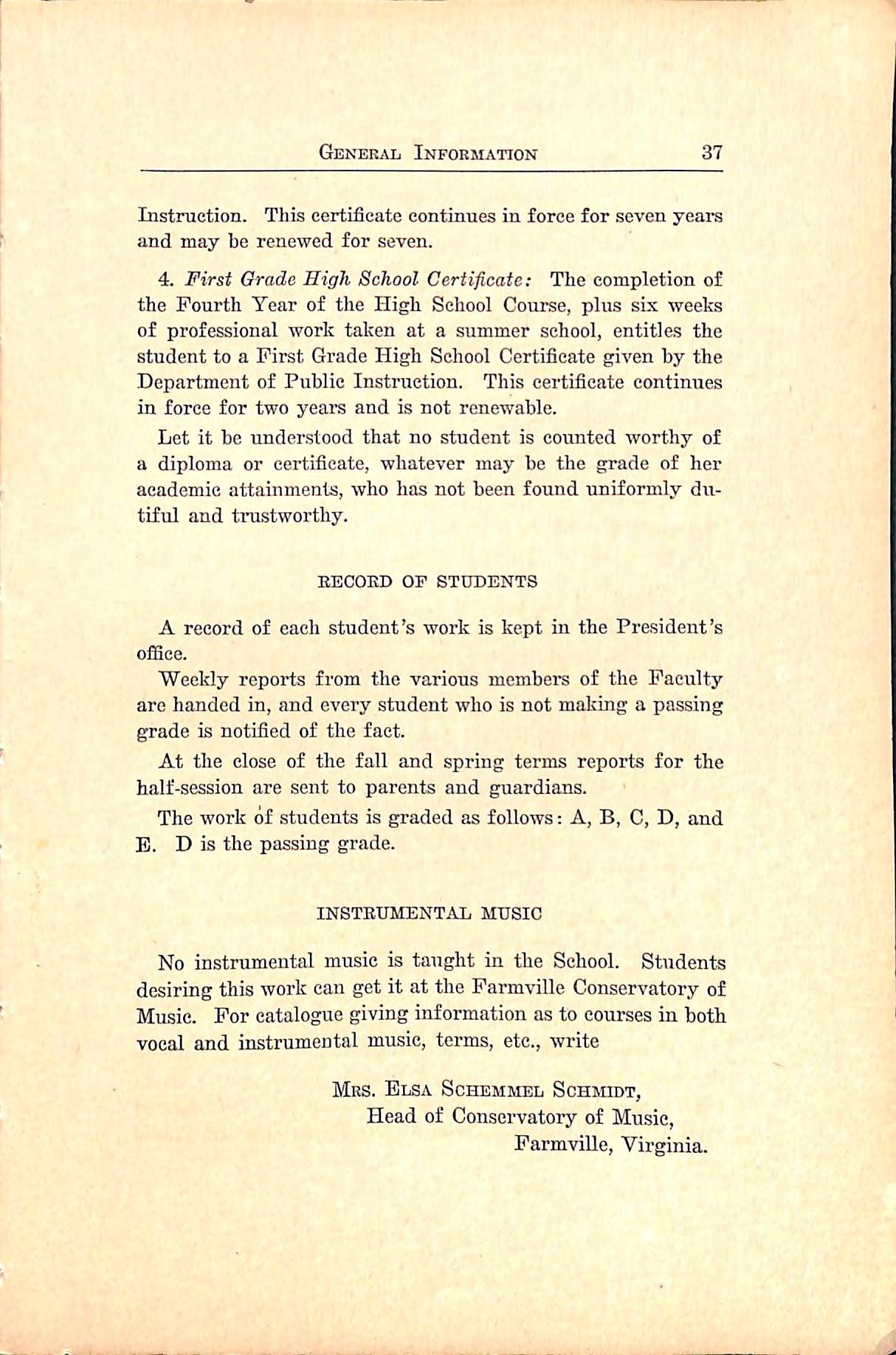
Instruction. Thiscertificate continuesinforceforseven years and may be renewed for seven.
4. First Grade High School Certificate: The completion of the Fourth Year of the High School Course, plus six weeks of professional work taken at a summer school, entitles the student to a First Grade High School Certificate given by the Department of Public Instruction. This certificate continues inforce for two years and is not renewable.
Let it be understood that no student is counted worthy of a diploma or certificate, whatever may be the grade of her academic attainments,who hasnot been found uniformly du tiful and trustworthy.
A record of each student's work is kept in the President's office.
Weekly reports from the various members of the Faculty are handed in, and every student who is not making a passing grade is notified of the fact.
At the close of the fall and spring terms reports for the half-session are sent to parents and guardians.
The work of students is graded as follows: A,B, C, D, and E. D isthe passing grade.
No instrumental music is taught in the School. Students desiring this work can get it at the Farm\'ille Conservatory of Music. For catalogue giving information as to courses in both vocal and instrumental music,terms,etc.,write
Mrs. Blsa Schemmel Schmidt, Head of Conservatory of Music, Farmville, Virginia.
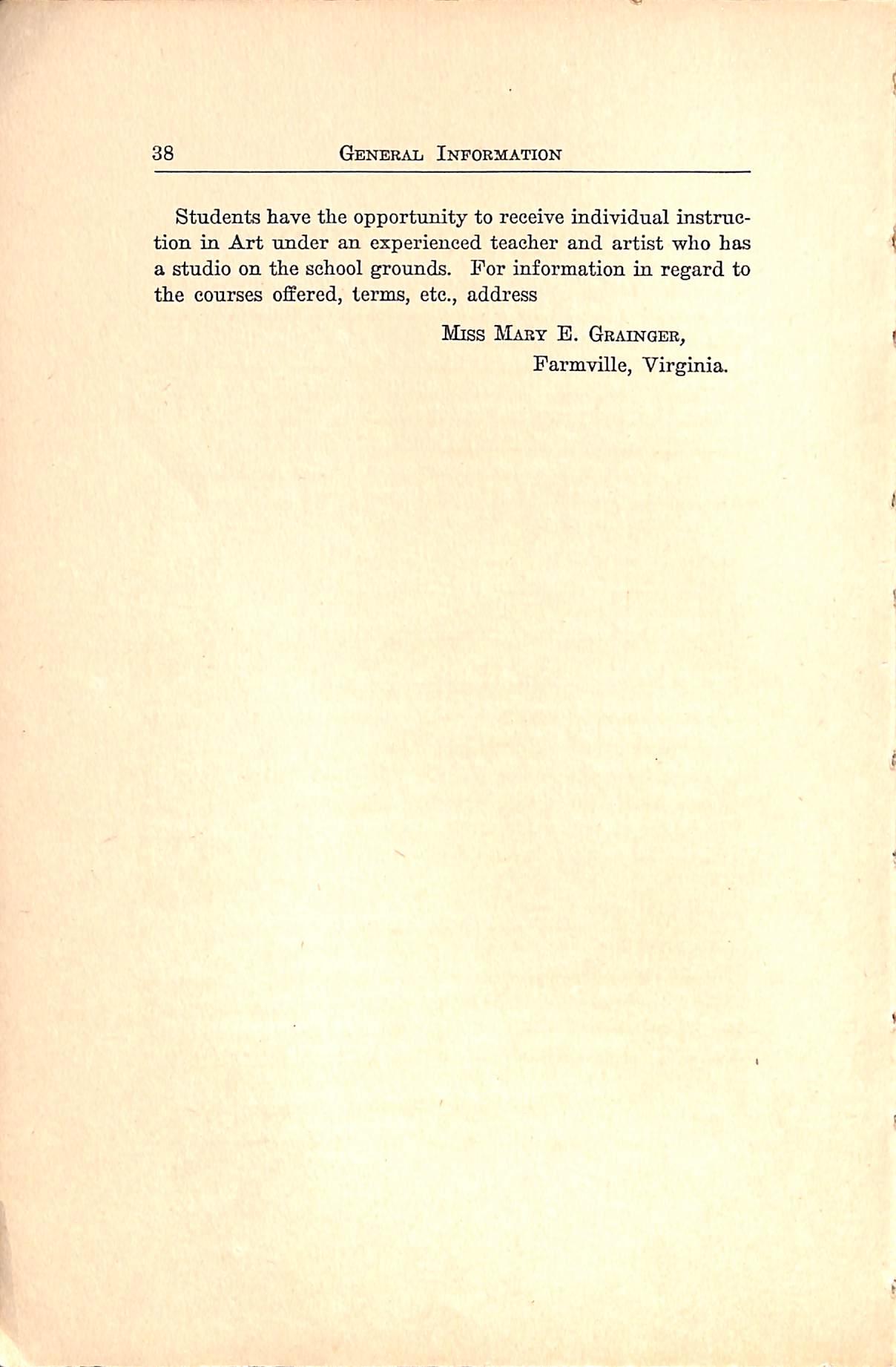
Studentshavethe opportunitytoreceiveindividualinstruc tion in Art under an experienced teacher and artist who has a studio on the school grounds. For information in regard to tiie courses offered, terms, etc., address Miss Mary E. Grainger, ParmviUe, Virginia.
Note.—TholettersAandBindicaterespectivelytheFall,orATono,and the Spring, or B Term. The figures under these letters show tho number of fort'y'lve minute periods per week.
The numbers and letters in parentheses refer to the numbers of tho courses as written up under the various departments. A number followed by "a," as Algebra(71a),indicates acourseoffered in theFallTerm only;a number followedby"b,"asArithmetic(72b),indicatesacourseofferedintheSpring Termonly;anumberfollowedbyboth"a"and"b,"asReading(25a,b), indicates acoursecontinuingthrough both terms. A numberfollowed byno letterindicatesaone-termcourseofferedintheFallandrepeatedinthoSpring for different sections of the same class.
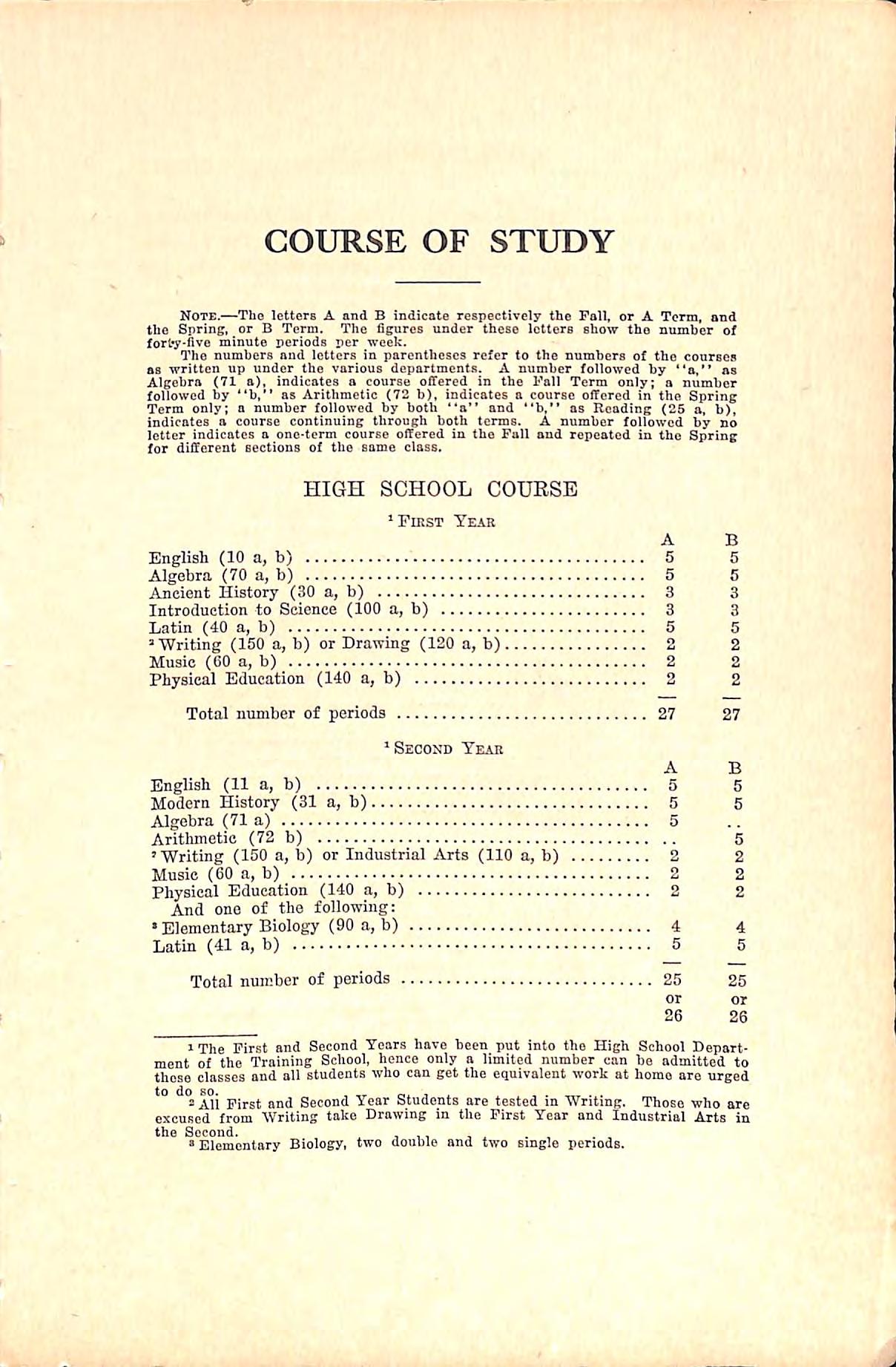
iTheFirstandSecondTearshavebeenputintotheHighSchoolDepart mentoftheTrainingSchool,henceonlyalimitednumbercanbeadmittedto thoseclassesandallstudentswhocangettheequivalentworkathomooreurged to do ^0^ Second Year Students are tested in Writing. Those who are excused from Writing take Drawing in the First Year and Industrial Arts in tho Second. , ,, ,
«Elementary Biology, two double and two single periods.
*Andatleastfifteenperiodseachtermofthefollowing:
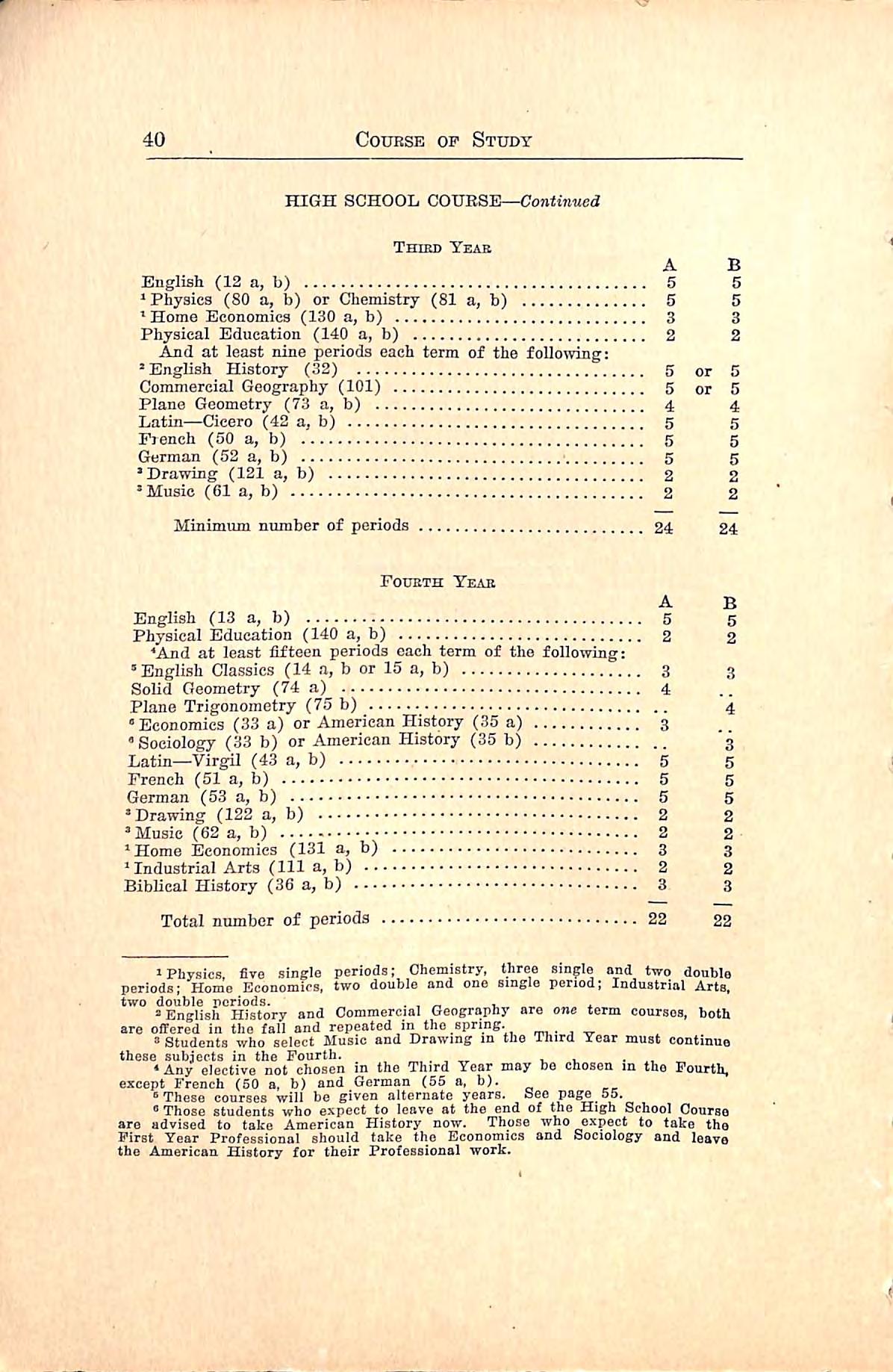
Totalnumberofperiods
»Physics, five single periods; Chemistry, three single and two double periods;HomeEconomics,twodoubleandonesingleperiod;IndustriolArts, two double periods. , ^ ^
®EnglishHistoryandCommercialGeographyareonetermcourses,both areofferedintliofallandrepeatedinthespring.
'Students who select Music and Drawing m the Ihird Year must continue thesesubjectsintheFourth. _., ^
•AnyelectivenotchosenintheThirdYearmaybechosenmtheFourth, exceptFrench(50a,b)andGerman(55a,b).
'Thesecourseswillbogiven alternate years. Seepage55.
®Those students who expect to leave at the end of the High School Course are advised to take American History now. Those who expect to take the First Year Professional should take the Economics and Sociology and leave the American History for their Professional work.
'AmericanHistory(35a)orEconomics(33a)
'Drawing(123aor124a)or*IndustrialArts(112a)....

'American History must be chosen by all students except those who have haditintheFourthTearHighSchoolhere,orwhohavepasseditoffby examination.
'See page 107. , ,, . - , 'IndustrialArts,onedoubleandonesjngleperiod;IndustrialOccupations, twosingleperiods.IndustrialOccupationsisexcusedintheSecondYearfor thosestudentswhoelectedIndustrialArtsintheFirstYear. *Seepage77. 'WhicheverofthesecoursesisnottakenintheFirstYearistakenId tbo Second Year.
Literature (18) or Primary Methods (162)
Primary Methods (163 b)
Games and Folk Dances (181 b)
' Drawing (123 b or 125 b)
Arts (113 b)
(141 a)
•And one of the following groups:
PSociology (33 b) A-j Geography and Methods (102 b)
[Educational Psychology (161 b)
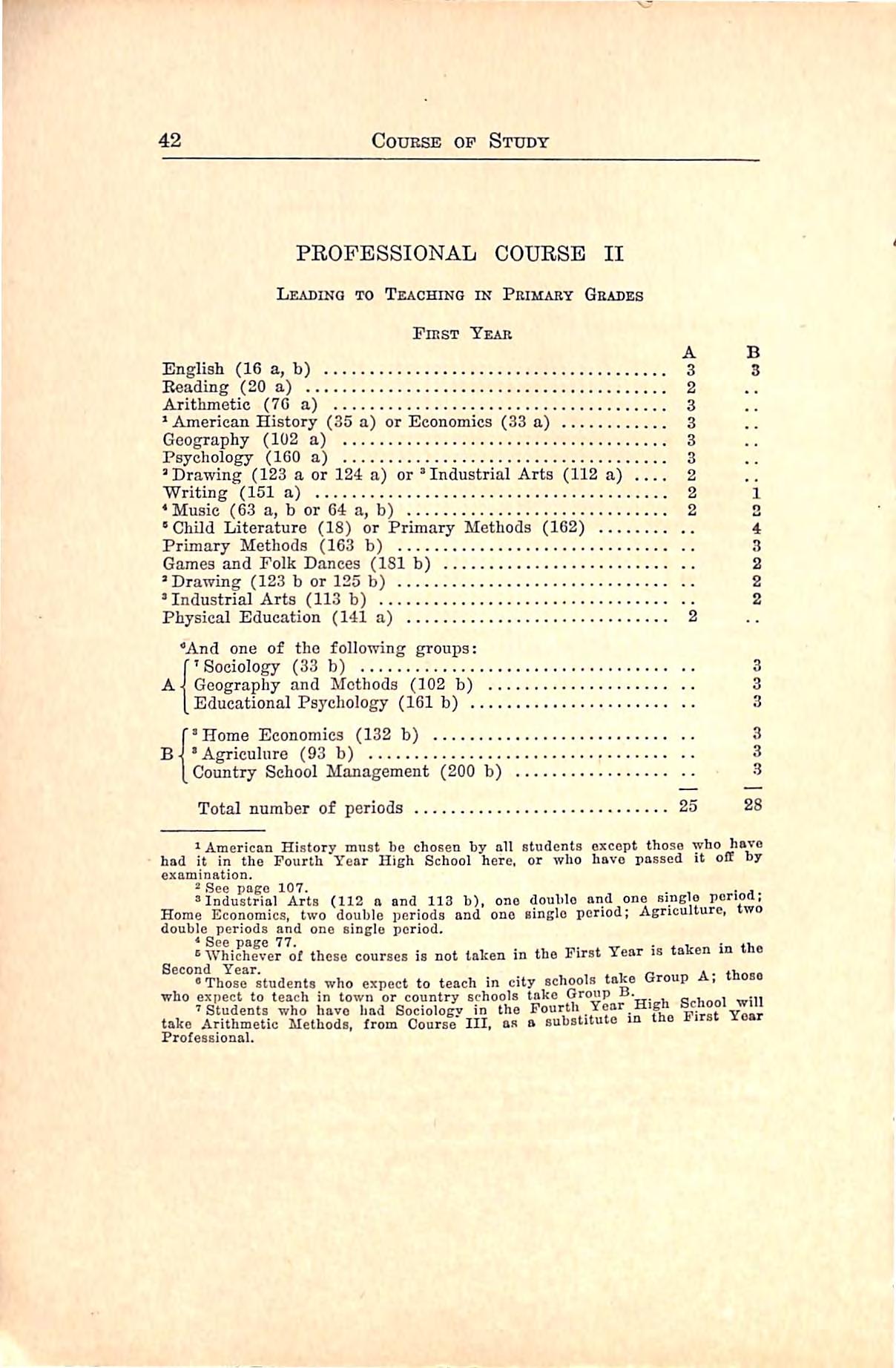
^American History most be choseD by all students except those who have had it in the Fourth Year High School here, or who hove possed it off by examination.
2 See page 107. , , ..j.
'Industrial Arts (112 a and 113 b), one double and one single ponod. Home Economics, two double periods and one single period; Agriculture, two double periods and one single period.
•Whichever of these courses is not taken in the First Year is taken in the
•Those students who expect to teach in city schools Group A, those who exiiect to teach in town or country schools take Group win 'Students who have had Sociology in the Fourth Year pgh School ^ take Arithmetic Methods, from Coarse III, as a substitute in Professional.
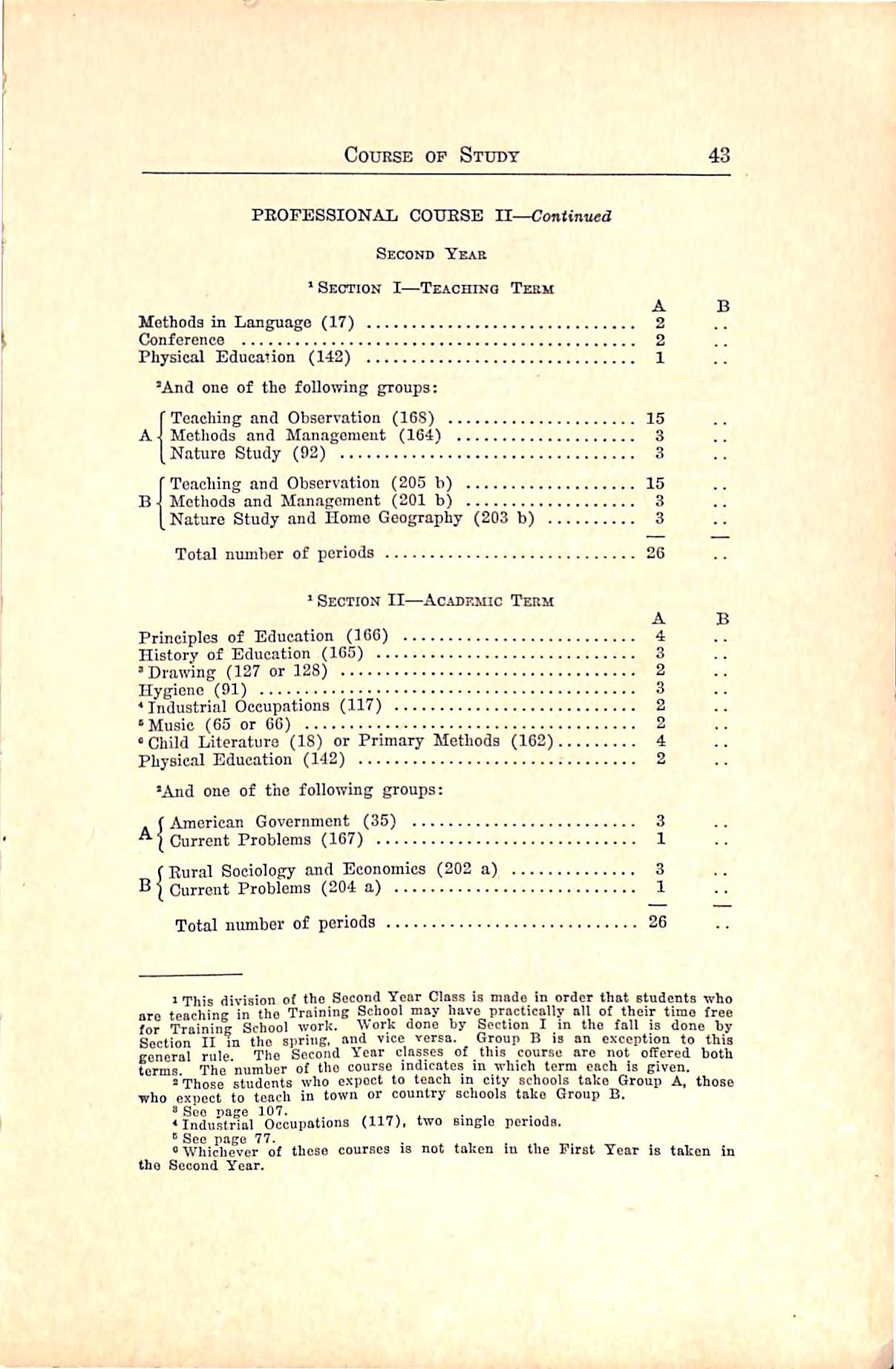
;ThisdivisionoftheSecondYcnrClassismadeinorderthatstndentswho areteachingintheTrainingSchoolmayhavepracticallyalloftheirtimefree fnr Trnininp School work. Work done by Section Iin the fall isdone by for Training School work, work done Oy Section 1 m the fall is done by SectionIIinthespring,andviceversa. GroupBisanexceptiontothis generalrule TheSecondYcnrclassesofthiscoursearenotofferedboth terms.Thenumberofthecourseindicatesinwhichtermeachlagiven.
•Those students who expect to teach in city schools take Group A those whoexpecttotenchintownorcountryschoolstakeGroupB.
'See page 107. ,,,-x • , , •Indu.strial Occupations (117), two single periods.
® See pA^e 77« 'Whicheverofthesecoursesisnottaken in theFirstYeariataken in tbo Second Year.

»And one of the following groups: r*Drawing(123bor126b) . 'IndustrialArts(114b) "I * Music (63 b or 64 b) [Methods in Physical Education (143 b)
'IndustrialArts(115b) B-l'Home Economics(132 b) 'Agriculture (93 b)
1AmPTicnnHistoryisrequiredofoilstudentsexceptthosewhohsTOhad itin the Fourth Year High School here,or who have passed Jtoffbyexamination.
s TnHnifrlal ^A^t's one double and one single period; Agriculture and Homo EconomicB two double periods and one smglo period.
5 Those"!Udlnts who expect to teach in city schools take Group A, those who eipect to teach in town or country schools take Group B.

^This division of tho Second Year Class is made in order that students who are teaching in tho Training School may have practically all of their time for Training School work. Work done by Section I in tho fall is done by Section II in tho spring, and vico versa. Group B is an exception to this general rule. The SecondYearclasses of this group are not offered both terms. The number of tho course indicates in which term each is given.
3 Those students who expect to tench in city schools take Group A, those who expect to teach iu town or country schools take Group B.
• See page 107.
* Industrial Arts, one double and one single period; Agriculture, two double periods and one single period.
■ See page 77.

1Thecompletionofthefirsttwoyearsofthiscoursa to a diploma, the completion of the four years entitles her to t g Bachelor of Science in Education.
'TermAoftheFirstYearofallcoursesisthesame. . i,«*'American History must be chosen by all atudeiUs . •. had it in tho Fourth Year High School here, or who have passed it off by examination.
•• See pago 107.
•Seepage77.

* Ono taken in A Term and the other in B Term, Note—As will be seen from the above distribution of Bubjccts, the fouryearcourserequires140term periodsinadditiontotheFirstYearConstant, distributed as follows: English 14, Education 18, Teaching and Obsorvation 20,Major24or28,Minor16or20,Elcctivestocompletethetotalof140. The majors, minors, and electives in Course IV may bo chosen from the eonrscs ollcrod by tho various departments numbered above 300.
'Drawing(123aor124a)orIndustrialArts(112a)....
'Music(63aor64a)
'HomeEconomics(420b)
"HomeEconomics(421b)
'HomeEconomics(133b)
'HomeEconomics(422b)
'TypesofIndustry(116b)
'HomeEconomics(423b)
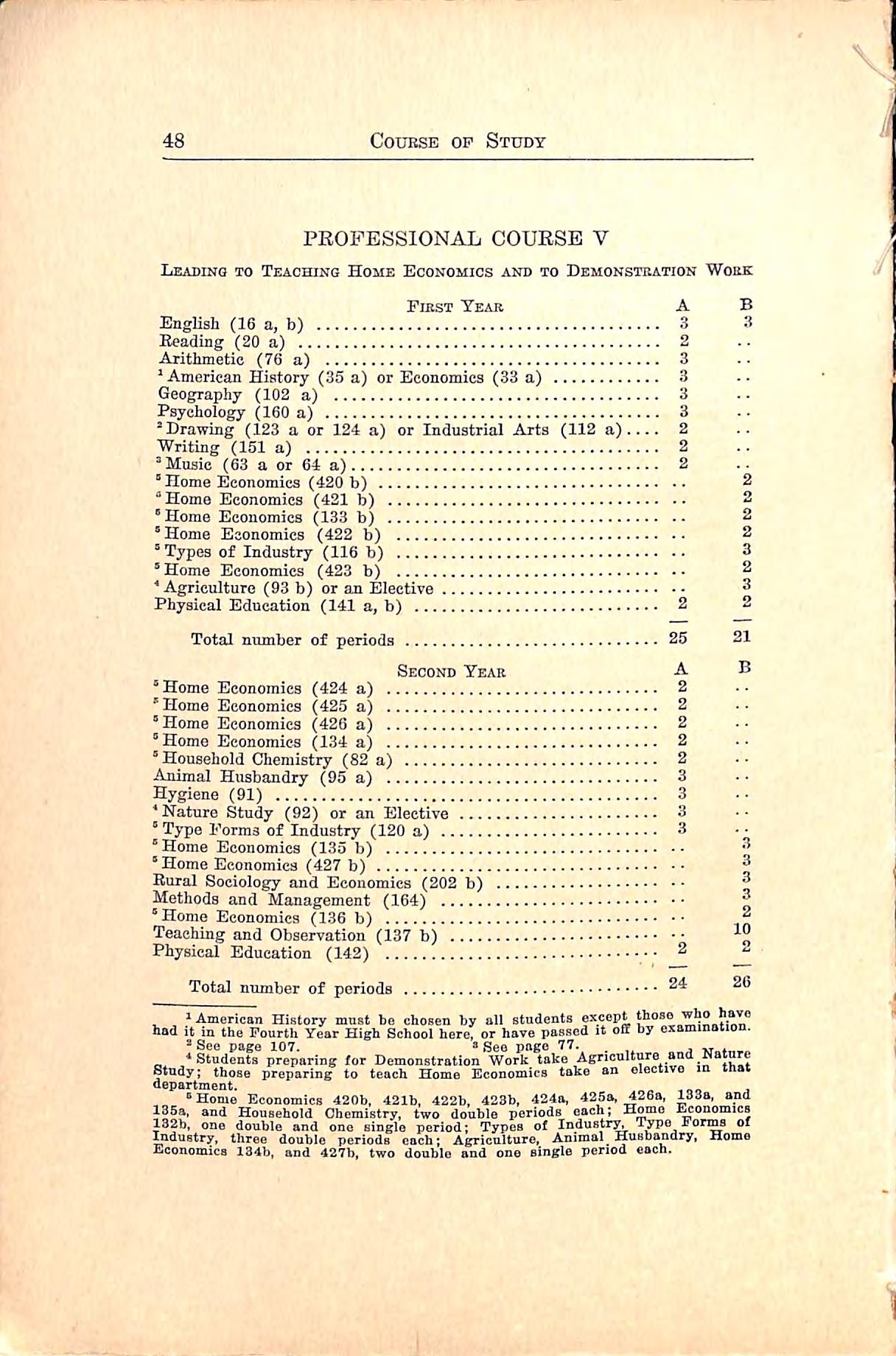
'Home Economies (135 b)
and Economics(202 b)
Methods and Management (164)
'Home Economics (136 b)
Teaching and Observation (137 b)
^AmericanHistorymuBtbochosenbyallstudents haditintheFourthYearHighSchoolhere,orhavepasseditoffbyexammoiion.
2See page 107.
*Seo pngo 77. , 'StudentspreparingforDemonstrationWorktakeAgricnltnreandN Study;thosepreparingtoteachHomeEconomicstakeanolectivoinmat department.
135a,®HomoEconomics420b,42Ib,422b,423b,424a,425a,426a,1338,and andHouseholdChemistry,twodoubleperiodseach;Homo^onomics 132b,onedoubleandonesingleperiod;TyposofIndustry,Typorormaof Industry,threedoubleperiodseach;Agriculture,AnimalHusbandry,Home Economics134b,and427b,twodoubleandonesingleperiodeach.
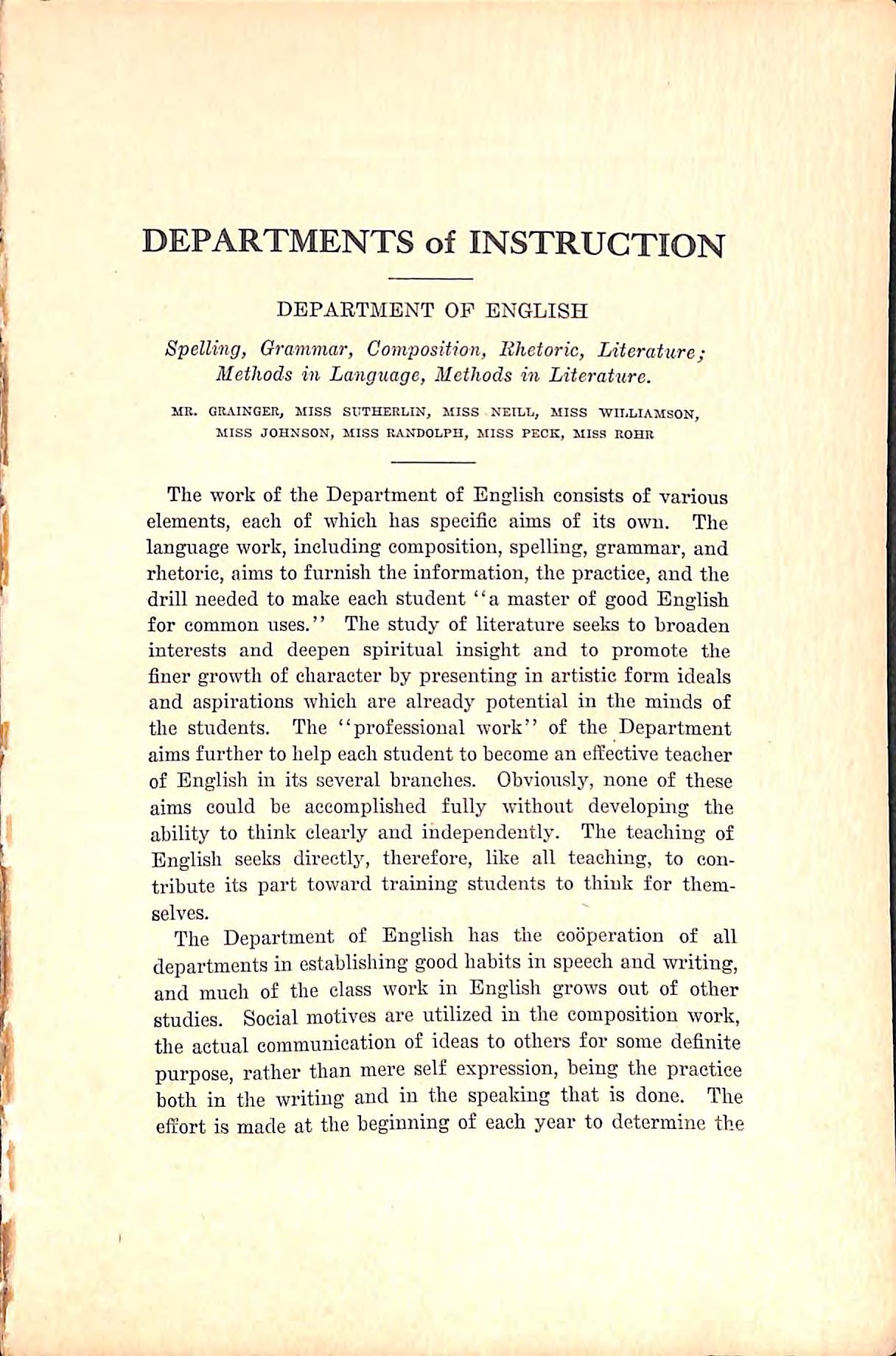
DEPARTMENTOFENGLISH
Spelling, Grammar, Composition, Rhetoric, Literature; Methods in Language,Methods in Literature.
MR. GRAINGER, MISS SUTHERUN, MISS NEILL, MISS "WITiLlAMSON, MISS JOHNSON, MISS RANDOLPH, MISS PECK, MISS ROHB
The work of the Department of English consists of various elements, each of which has specific aims of its own. The language work, including composition, spelling, grammar, and rhetoric,aimstofurnish theinformation,the practice,and the drill needed to make each student "a master of good English for common uses." The study of literature seeks to broaden interests and deepen spiritual insight and to promote the finer growth of character by presenting in artistic form ideals and aspirations which are already potential in the minds of the students. The "professional work" of the Department aims further to help each student to become an effective teacher of English in its several branches. Obviously, none of these aims could be accomplished fully wdthout developing the ability to think clearly and independently. The teaching of English seeks directly, therefore, like all teaching, to con tribute its part toward training students to think for them selves.
The Department of English has the cooperation of all departments in establishing good habits in speech and writing, and much of the class work in English grows out of other studies. Social motives are utilized in the composition work, the actual communication of ideas to others for some definite purpose, rather than mere self expression, being the practice both in the writing and in the speaking that is done. The effortis made atthe beginning of each year to determine the

actualabilityofeachstudentineachoftheseveralbranchesof English work. Class work is then adapted to the needs of the majority, and individual effort is directed toward the cor rection ofindividual weaknesses and the cultivation of special gifts. Studentswhoarepreparingtoteach Englishinthehigh school find the opportunity to specialize in this subject throughout the professional years.
yrospec'tive students in the Department of English are advised to bring text books formerly used in classes in gram mar, composition, rhetoric, and literature, and standard edi tions of such literary classics as are prescribed in the English course to be taken. A good handbook of composition, prefer ably Woolley's Sandhook of Composition, and a good dic tionary should be on every student's table, together with a copy of the English Bible, for reference and reading.
The High School and Professional courses offered by this department are as follows:
English (10 a, b) First, Tear (Taught in the Training School). Five periods a week throughout the year. Ele mentary Composition, Grammar, and Reading. In this and the following years,the composition work,oral and written, growsoutofthe socialand intellectualneedsand interests of theclassandthevariousactivitiesinwhichthestudentsare engaged. The special task in the Fh-st Year is to make a social working unit of a group of students from various places and totraintheindividualstothink. Naturalself expression comesingettingacquaintedwitheachother;andtherealcommimication of the pupils' own ideas, under the guidance of the teacher of English, furnishes practice in various kinds of speaking and writing and motivates study and drill in the technical elements. Thestudents'work is carefully observed for errors in grammar, spelling, pronunciation, form, and idiom,andpracticaldrillsare givento correctbad habits,cor rectness being evei*ywhere considered merely one of the means
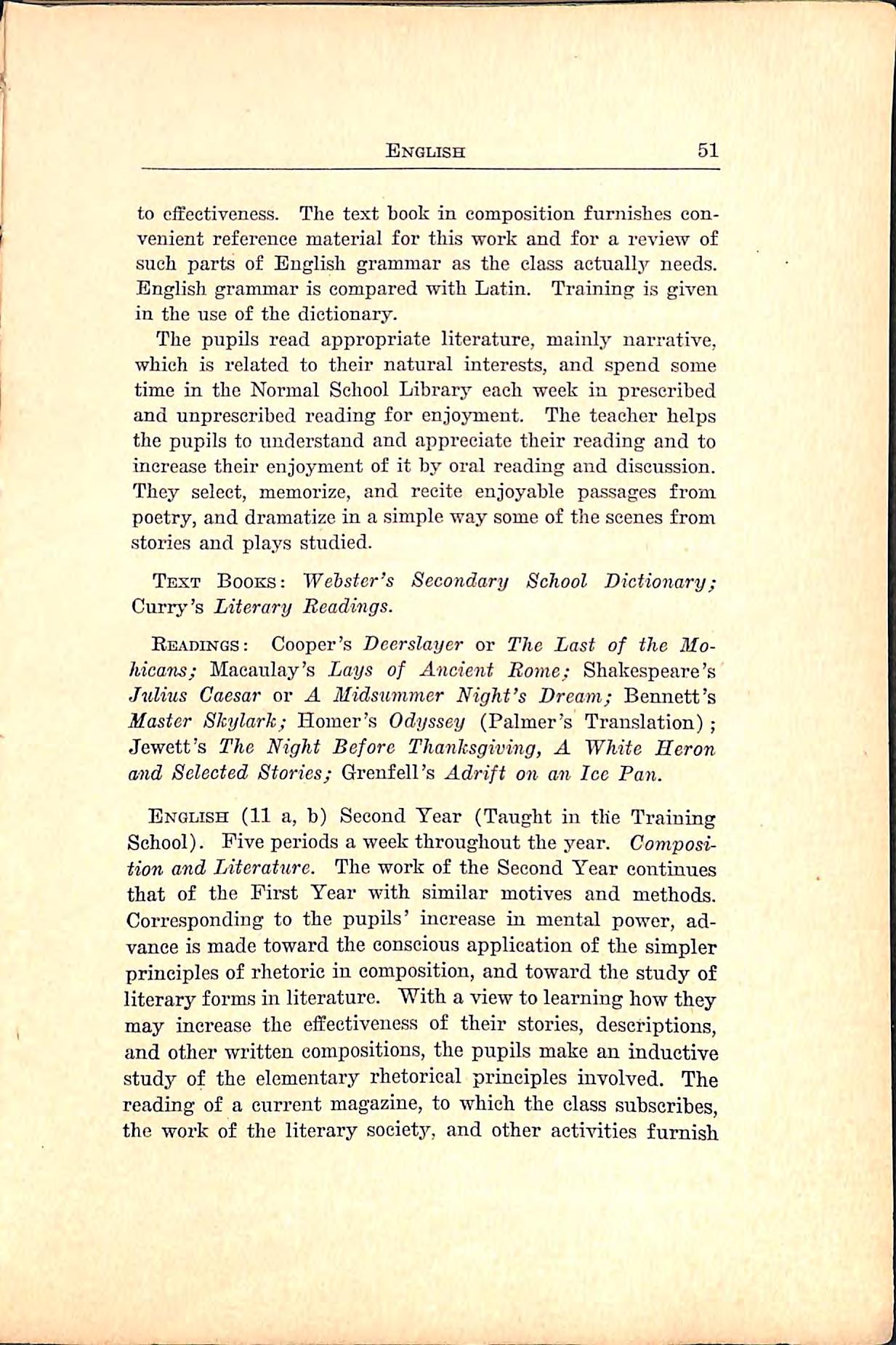
to effectiveness. The text book in composition furnishes con venientreferencematerialforthisworkandforareviewof such parts of English grammar as the class actually needs. English grammar is compared with Latin. Training is given in the use of the dictionary.
The pupils read appropriate literature, mainly narrative, which is related to their natural interests, and spend some time in the Normal School Library each week in prescribed and unprescribed reading for enjoyment. The teacher helps the pupils to understand and appreciate their reading and to increase their enjoyment of it by oral reading and discussion. They select, memorize, and recite enjoyable passages from poetry,anddramatizeinasimplewaysomeofthescenesfrom stories and plays studied.
Text Books: Webster's Secondary School Dictionary; Curry's Literary Readings.
Readings: Cooper's Deerslayer or The Last of the Mohicam; Maeaulay's Lays of Ancient Rome; Shakespeare's Julius Caesar or A Midsummer Night's Dream; Bennett's Master Skylark; Homer's Odyssey (Palmer's Translation); Jewett's The Night Before Thanksgiving, A White Heron a/nd Selected Stories; Grenfell's Adrift on an Ice Pan.
English (11 a, b) Second Year (Taught in the Training School). Five periods a week throughout the year. Composi tionandLiterature.TheworkoftheSecondYearcontinues that of the First Year with similar motives and methods. Corresponding to the pupils' increase in mental power, ad vance is made toward the conscious application of the simpler principles of rhetoric in composition, and toward the study of literary forms in literature. With a view to learning how they may increase the effectiveness of their stories, descriptions, and other written compositions,the pupils make an inductive study of the elementary rhetorical principles involved. The reading of a current magazine, to which the class subscribes, the woi'k of the literary society, and other activities furnish

interesting material for simple, systematic exercises in oral and written composition, and for regular weekly themes. Individual conferences are held when necessary.
The classics for study and reading are selected for their literary and historical value as well astheir adaptation to the pupils and relations to other school interests. Special atten tion is given to Southern writers. During the first term the literature studied is mainly narrative and descriptive prose, especially the short story; during the second term it is mainly poetry,especiallythe lyric,and persuasive prose.
Text Books: Brooks's English Composition, Book I, En larged (for reference and topical study any standard text in high school composition already owned by the pupil may be used). Webster's Secondary School Dictionary; Mims and Payne's Southern Prose and Poetry; Palgrave's Golden Treasury ofSongs and Lyrics.
Eeadings: (For class study) Narrative and poetic por tions of the Bible; Shakespeare's Merchant of Venice; Burroughs's Sharp Eyes and Other Papers; George Eliot's Silas Marner; (For outside reading) Scott's Quentin Durward, The Talisman, Kenilworth; Dickens's A Tale of Two Cities; George Eliot's Romola; Helen Keller's The Story of My Life; Blackmore's Lorna Doone; a collection of short stories.
English (12 a, b) Third Year. Five periods a weekthroughout the year. Composition and English Literature. The work of this year begins with a survey of the attainments of individuals in the class during the past two years' study of English. Personal and business letters are written with a specific view to securing adaptation to the persons addressed, and practice is given in everyday kinds of correspondence,ex planation, description, and narration, with a view to gaining clearness, interest, and adequacy of treatment according to the purpose for which the writing is done. Current events, the reading of standard magazines, class work in literature and other studies, student life and relations, experience out side of school, all furnish subjects for oral class reports, out-

lines, explanations, discussions, debates, and for broadening and organizing the students' interests.
By the time they reach the Third Year students have gained sufficient mental grasp to be able to read mature literary classics, if properly introduced to them, and to ap preciate to a certain extent the detailed study of authors and their times. Accordingly, the basis of this year's work in literature is a study of English literature accompanied by a rapid sketch of the literary history, paralleling the course in English history. The study, however, is not altogether chrono logical. Beginning with Burns, a universal favorite, it passes rapidly to typical works of Wordsworth, Coleridge, Scott, Shelley,Keats,Tennyson,Browning,Arnold,in poetry;and Lamb, Carlyle, Maeaulay, Ruskin, Stevenson, in prose. Turn ing, then, to the beginning of English literature, the course takes cursory notice only of "Beowulf" in translation, Chaucer, the ballads, "Everyman," Malory, and Spenser, dwelling for a time on Shakespeare and Milton, and passing very rapidly to Bunyan,Drydeu,Addison,Pope,Defoe, Swift, Gray, Goldsmith, Cowper, Dickens, and George Eliot. This rapid survey is intended to give the student a general view of the whole range of English literature to be used as a basis for future reading and study. The emphasis is placed on the study of literature as a reflex of social conditions mth especial attention to the growth of the democratic spirit and the development of social ideals in education.
Text Books: Woolley's Handbook of Composition; Metcalf's English Literature; Newcomer and Andrew's Twelve Centuries of English Prose and Poetry; Webster's Secondary School Dictionary.
English (13 a, b) Fourth Year. Five periods a week throughout the year. Advanced Composition, American a7id Recent Literature. Some of the problems of the last year in high school English are to sum up the present attainment of each student, to round it out and bring it into relation with present-day life, and to prepare for the more rigid work of the

professional years. By means of tests applied at the beginning of the year, the students realize their standing in each of the various branches of English equipment. Much of the work of the year is directed toward bringing up individual de ficiencies and developing special talent or capacity asindicated by the tests. "Wide reading in the library in both current and classic literature in connection with the study of significant questions of the day in which the students show an interest, provides much materialfor presentation in class in thefonn of oral and written reports, discussions, and debates. The special problem in composition, therefore, is the effective use of books and reading in the preparation and presentation of sustained exposition and argument. The writing of stories based on the students' own experience and observation, and occasionally of verse, to be .submitted for publication in the school magazine, gives variety to the work and with the more capable students an opportunity to try to apply some of the principles of writing revealed by the study of American literature.
A rapid survey of the development of American literature from colonial times gives a background for the more particular study of recent writers. The class is organized into a current literature club to discuss and debate present-day problems of all sorts encountered in recent books and magazines. Each member subscribes to a standard magazine and reads widely in other periodicals in the Library. Different groups in the class specialize according to their tastes in the study of litera ture dealing with politics and government, international relatious, scientific progress, business and economic develop ments, social and religious que-stions, or new movements in literatureand art. In connection with her special topic each student selects one modem writer for intensive individual reading, and from time to time is given opportunity to share the results with the class. Some of the authors suggested for study in t.biR way are: Irving, Lowell, Hawthorne, Emerson, Holmes, Longfellow, Whittier, Mark Twain, 0. Henry.

Practicein oral reading and a review of English grammar are given during the year.
Text Books: Woolley's Eandbooh of Composition,Bciihler's English Grammar, Metcalf's American Literature, Calhoun and McAlarney's Readings from American Litera ture, Webster'sSecondary School Dictionary. Reading: Prose selections from Irving, Hawthorne, Emerson, Lowell, Burroughs, and othei*s.
English (14 a) Fourth Year. Three periods a week for term A. Nineteenth Century Poets. Given in 1917-1918, al ternating annually with English (15 a). This eom*se aims to give as thorough an acquaintance as the time allows with the chief English poets of the last century.
Text Books. Page's British Poets of the Nineteenth Cen tury.
English (14 b) Fourth Year. Three periods a week for term B. Shakespeare. Given in 1917-1918, alternating an nually with English (15 b). Three important plays of Shakespeare, a comedy, a tragedy, and a history, are carefully studied as representatives of these three types. As such they are compared with specimens ofsuch playsof recentauthor ship and with pre-Shakespearean forms of English drama. The development of the types from these early examples is traced rapidly, and finally Shakespeare's life and the growth of his art are studied in connection with six or eight plays, which are considered in chronological order.
Text Books: Shakespeare's Complete Works, Everyman's Library Edition; Dowden's Shakespeare Primer.
Sotplementary Reading: Dowden's Shakespeare, His Mind and Art, and other standard criticisms of Shakespeare.
English (15 a) Fourth Year. Three periods a week for term A. The American Short Story. [To be given in 19161917, alternating annually with English (14 a)]. The shortstories of Irving,Poe,Hawthorne,Bret Harte,0. Henry,and several contemporary writers are read and studied. The aim
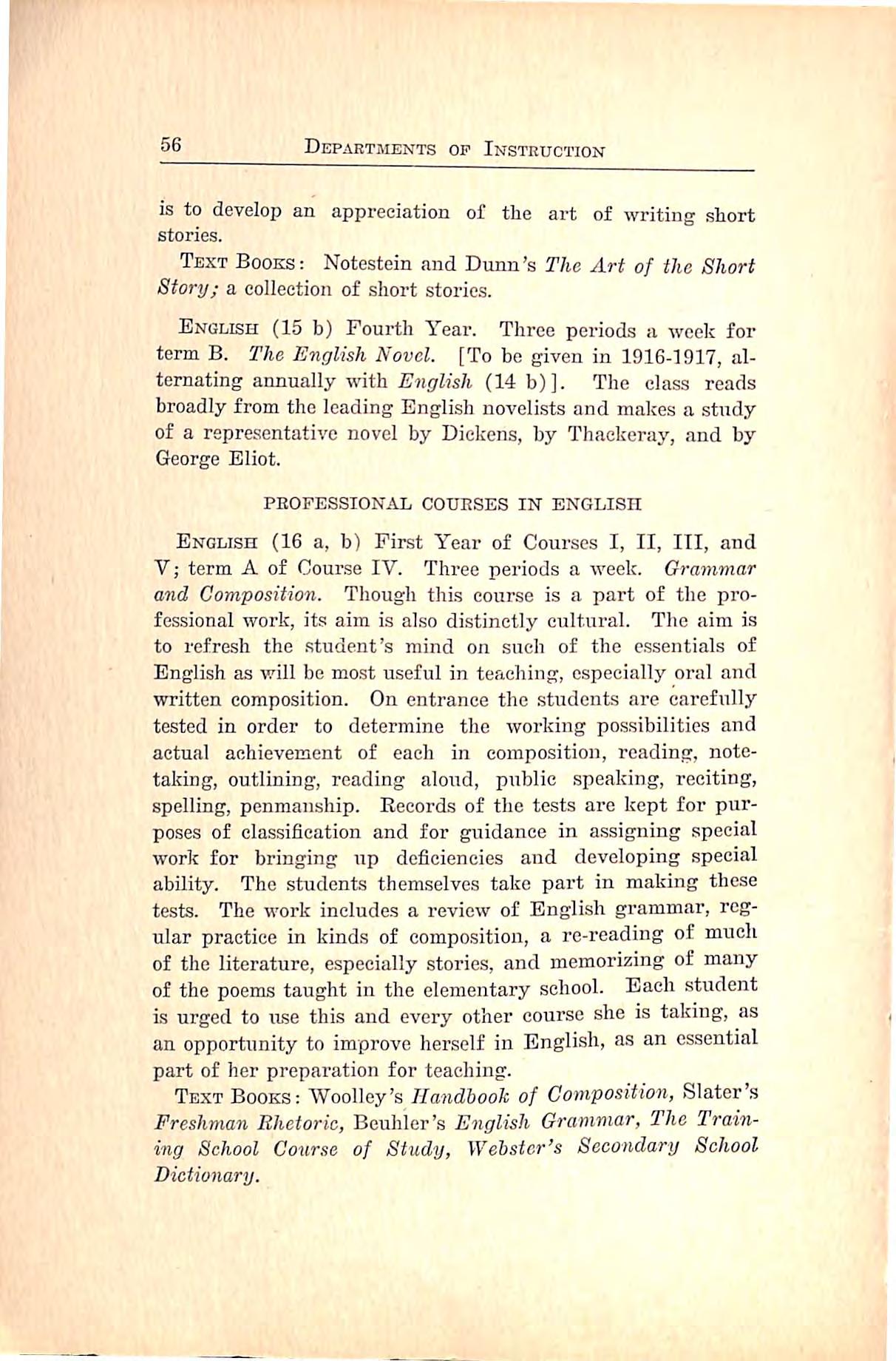
is to develop an appreciation of the ai-t of writing short stories.
Text Books: Notestein and Dunn's The Art of the Short Story; a collection of short stories.
English (15 b) Fourth Year. Three periods a week for term B. The English Novel. [To be given in 1916-1917, al ternating annually with (14 b)]. The class reads broadly from the leading English novelists and makes a study of a representative novel by Dickens, by Thackeray, and by George Eliot.
English (16 a, b) First Year of Courses I, II, III, and V;term A of Course IV. Three periods a week. Grammar and Composition. Though this course is a part of the pro fessional work, its aim is also distinctly cultural. The aim is torefreshthe.student'smindonsuchoftheessentialsof English as will be most useful in teaching, especially oral and written composition. On entrance the students are carefully tested in order to determine the working possibilities and actual achievement of each in composition, reading, notetaking, outlining, reading aloud, public speaking, reciting, spelling, penmanship. Records of the tests are kept for pur poses of classification and for guidance in assigning special work for bringing up deficiencies and developing special ability. The students themselves take part in making these tests. The w-ork includes a review of English grammar,reg ular practice in kinds of composition, a re-reading of much of the literature, especially stories, and memorizing of many of the poems taught in the elementary school. Each student is urged to use this and every other course she is taking, as an opportunity to improve herself in English, as an essential part of her preparation for teaching.
Text Books: Wcolley's Handbook of Composition,(Slater's Freshmaii Rhetoric, Beuhler's English Grammar, The Train ing School Course of Study, Webster's Secondary School Dictionary.

Englosh 57
Reading: Palmer's Self Cultivation in English, school classics, stories from classic and Norse mythology, folk tales, etc.,listed in The Training School Course of Stiidy.
IIethodsin Language(17)Second Year of CoursesIIand III. Two periods a week for one term. This course presents asfully as passiblein thetime allowed the essentials of matter and metliod in tlie language work of all the gradesin the ele mentary school. No dogmatic presentation of arbitrary cutand-dried methods is attempted;rather the effort is made to stimulate the student-teacher's originality and ingenuity in making her own methods. Such composition work is rcquii'ed as the student will have to teach in the elementary school. Problems met by the student-teachers in their work in the Training School form the basis of much of the work.
Text Books: The Training School Course of Study; English ui the Elementary Grades, Bulletin of the State Normal School for Women at Farmville, September 1915.
Child Litekature (18) First Year Courses I and II. Four periods a week for term B. Repeated in Second Year termAofsamecoursesfortheothersectionsoftheclass.In this course a study is made of literature appropriate for the Kindergarten and Primary Grades, with discussion of the principles underlying the selection of poems and stories for children and their presentation to them. Folk and fairy tales, fables, myths, legends, history, and Bible stories, realistic stories,rliyraes,and poemsareconsidered. Thecourseaimsto present a broad range of material which will give a good basis for the appreciation and selection of stories and poetry suitable to children of different ages. Thefactors essential to a good story are discussed, and the application of them is made in original composition. The opportunity for individual presen tation of stories is provided for. Juvenile magazines and pic ture books are examined and discussed. Methods for the de velopment in the child of a taste for good literature, and the selection of books for the home and school library are also considered.

Text Book: MeClintoek's Literature in the Elementary School.
English (310 b) Required in First Year of Course IV. Five periods a week for term B. This course is a continua tion of English (16 a) with the addition of a rapid sur^^ey and reading course in American literature. In order that the students may begin definite preparation for the teaching of high school English they are required to read American literature thatissuitable for high school pupils and to prac tice the kindsof writing usually done in the high school. A current magazine is taken, both to inform the students on happenings of the times, and to show them how to make use of magazines in English classes. Much practice is given in oral interpretation of"high school classics."
Text Books: In addition to those named above, Metcalf's American Literature, or Long's American Literature, the texts of "high school classics" from American literature. SupplementaryReading:Selected bystudentsfrom thelist of Boolcs for Home Reading, compiled by a Committee of National Council of Teachers of English.
English (311 a) Required in Second Year of Course IV. Four periods a week for term A. A beginning is made during this term in a course in English literature which continues throughout the year. An intensive study of representative English masterpieces is accompanied by readings in the his tory of English literature. The composition work includes instruction and practice in the kinds of writing and speaking that are expected of grammar grade and high school teachers in the school as leaders in the community. Much of the work prepared for this class is actually used in the student's own directed teaching in the Training School. Incidentally, the class also discusses the teaching of English being done by some of its members in the first and second years of the high school.
Text Books: In addition to those named above, which should be kept for reference and study, Long's English Lit-
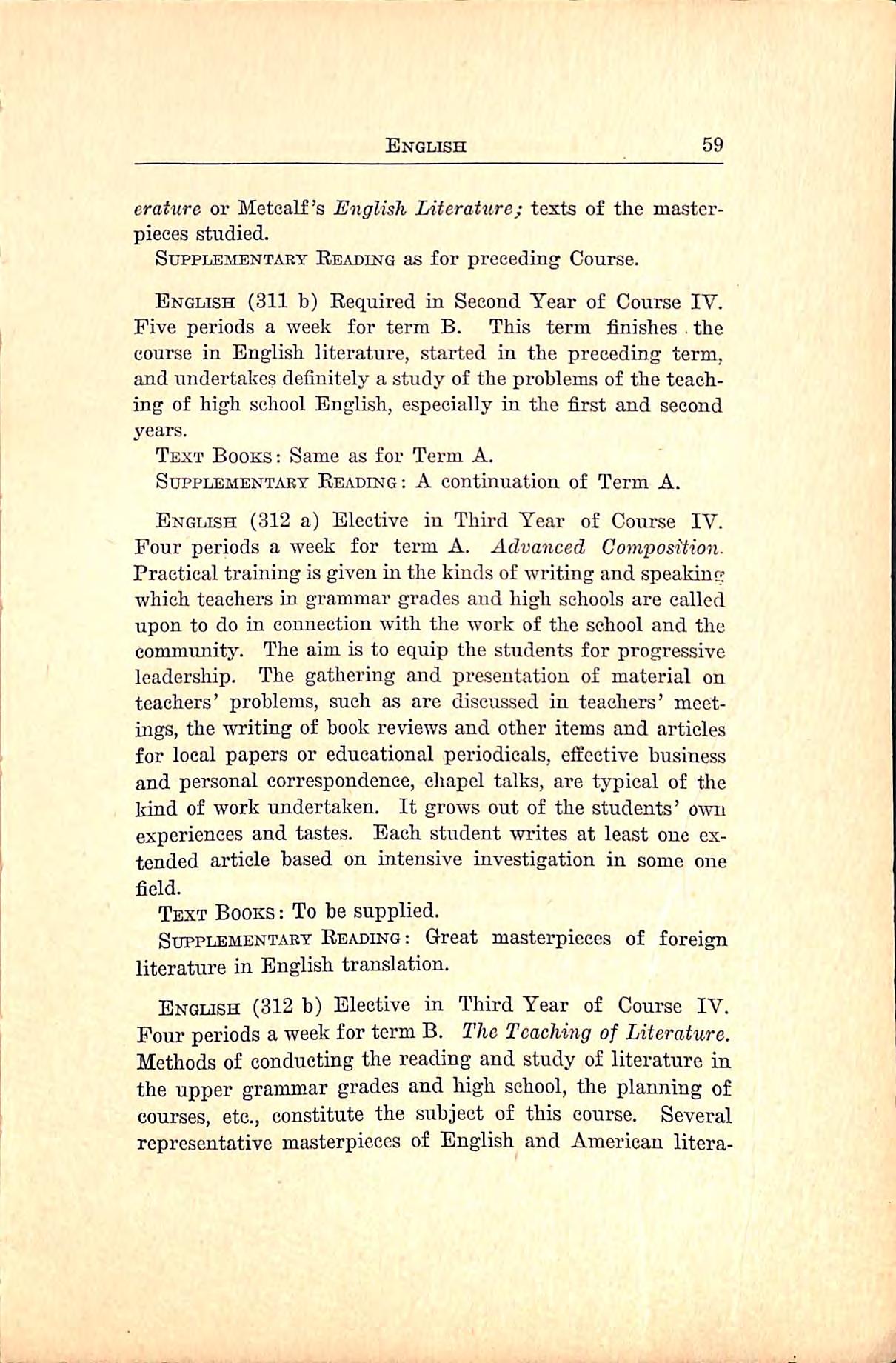
erature or Metcalf's English Literature;texts of the master pieces studied.
Supplementary Reading asfor preceding Course.
English (311 b) Required in Second Tear of Course IV, Five periods a week for term B. This term finishes.the course in English literature, started in the preceding term, and undertakesdefinitelyastudyofthe problemsoftheteach ing of high school English, especially in the first and second years.
TextBooks:SameasforTermA.
SupplementaryReading:AcontinuationofTermA.
English (312 a) Elective in Third Tear of Course IV. Pour periods a week for term A. Advanced Composition. Practical training is given in the kinds of writing and speaking which teachersin grammar grades and high schools are called upon to doin connection with the work oftheschooland the community. The aim is to equip the studentsfor progressive leadership. The gathering and presentation of material on teachers' problems, such as are discussed in teachers' meet ings,the writing of book reviewsand other items and articles for local papers or educational periodicals, effective business and personal correspondence, cliapel talks, are typical of tlie kind of work undertaken. It grows out of the students'own experiences and tastes. Each student writes at least one ex tended article based on intensive investigation in some one field.
Text Books: To be supplied.
Supplementary Reading: Great masterpieces of foreign literaturein English translation.
English (312 b) Elective in Third Year of Course IV. Four periods a week for term B. The Teaching of Literature. Methods of conducting the reading and study of literature in the upper grammar grades and high school, the planning of courses, etc., constitute the subject of this course. Several representative masterpieces of English and American litera-

ture are studied by way of exemplification of methods dis cussed.
TextBooks:Smith'sWhatCanLiteratureDoForMef Bolenius's Teaching Literature in the Grammar Grades and High Schools.
Supplementary Reading: Great masterpieces of foreign literature in English translation.
English (313 a) Elective in Fourth Year of Course IV. Four periods a week for term A. The English Language. A survey of the liistory of the language is undertaken with a view to enabling the prospective teacher better to under stand the structure of English of to-day, its vocabulary, grammar, and idioms, as an aid in handling the language aspects of English teaching in the high school, and in order to increase the student's command of the mother tongue. The study of derivation, exercises in translation into the English of various periods, comparison of English with other languages, the investigation of present day developments, are typical of the kind of work undertaken.
Text Book: Champney's History of the English Language. Supplementary Reading: Selected work from the litera ture of the various periods studied in the development of the language.
English (313 b) Elective in Fourth Year of Course IV. Four periods a week for term B. The Teaching of Composi tion and Grammar in Grammar Grades and High Schools. Conduetinff the work in composition and grammar is considered with a view to solving its special problems and utilizing its opportunities. Emphasis is laid upon social and personal motivation for making the work of the class-room effective in the life of the student. The school paper or mag azine, literary and debating societies, entertainments, special programs, the cooperation of departments, etc., are .some of the means of motivation discussed. The work also includes practice in writing, and the criticism of manuscripts; and in-

struction byconference,and bylectures;the use ofstandards, examination,and scales;the organization of coursesin compo sition,andin grammar,incidentalandformal.Each studentin this course is required to take one of the regular courses in English in the high school under the regular instructor and to prepare either to recite with the class or to take charge of the instruction of it at any time.
Text Books: Leonard's Composiiion as a Social Prohlem, Ward's WhatisEnglish?
Supplementary Reading: Extensive reading in some branch of contemporary literature.
Speclvl Spelling: Two periods a week as long as neces sary. This special class is formed the first of October. To it are assigned all students from any class who, during the fii*st month's work, show wealniess in spelling. Other stu dents are required to enter the class later, as it may seem necessary, and all are kept there until decided and perma nent improvement is shown. The professional classes are watched with especial care, and no student notably poor in spelling is graduated until such weakness is remedied. Since it is the special object of this course to remedy marked wealcness in spelling, earnest and intense study is given to every possible principle, plan, or device that may appeal to the eye, the ear, the hand, and the intellect, in impressing correct word-forms upon the memory.
Text Book: Payne's Common Words Commonly Mis spelled.
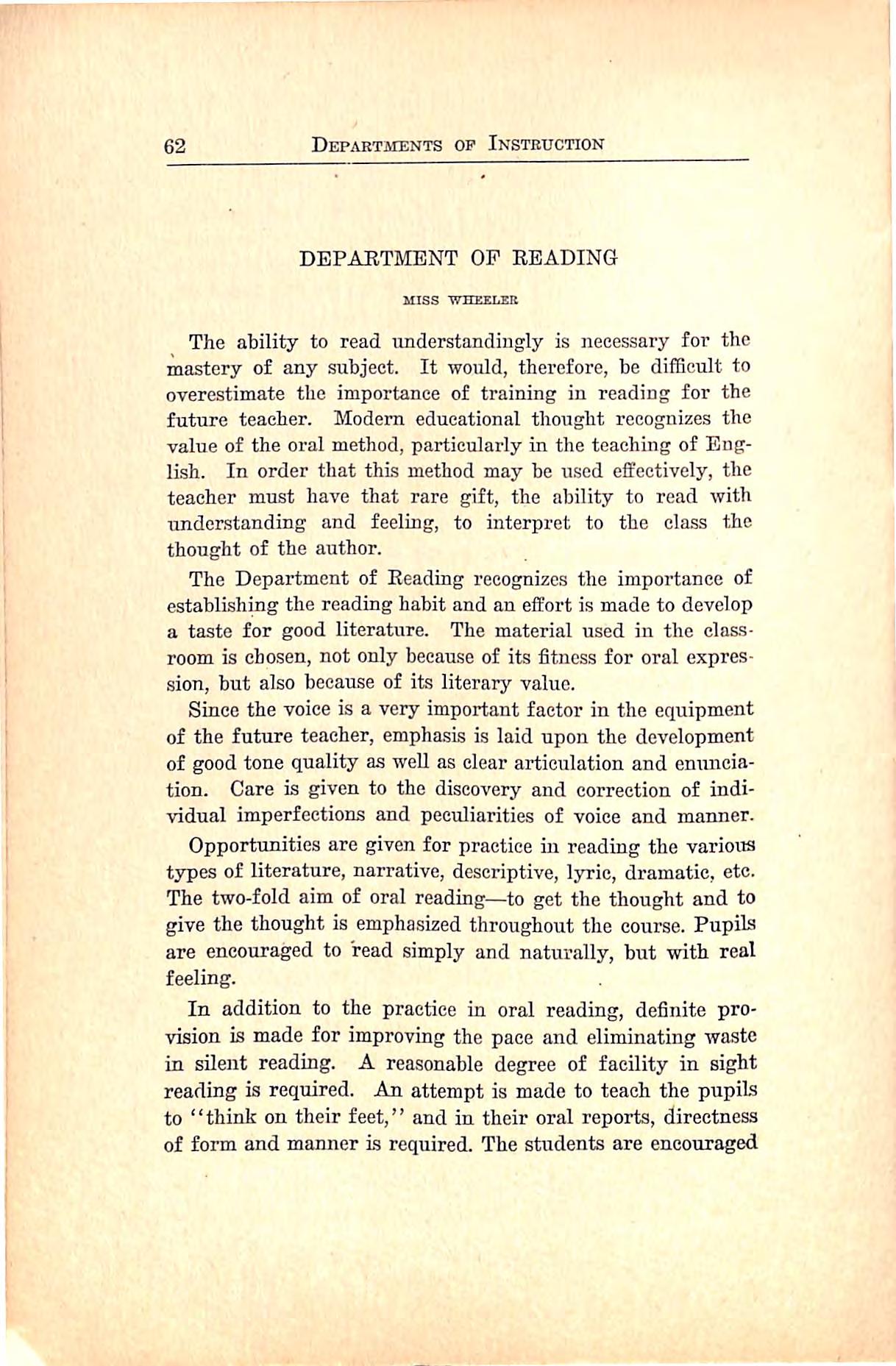
The ability to read imderstandingly is necessary for the mastery of any subject. It would,therefore, be difficult to overestimate the importance of training in reading for the future teacher. Modem educational thought recognizes the value of the oral method, particularly in the teaching of Eng lish. In order thatthis method may be used effectively,the teacher must have that rare gift, the ability to read with understanding and feeling, to interpret to the class the thought of the author.
The Department of Reading recognizes the importance of establishing the reading habit and an effort is made to develop a taste for good literature. The material used in the class room is chosen,notonly becauseofitsfitnessfor oralexpres sion, but also because of its literary value.
Since the voice is a very important factor in the equipment of the future teacher, emphasis is laid upon the development of good tone quality as well as clear articulation and emuiciation. Care is given to the discovery and correction of indi vidual imperfections and peculiarities of voice and manner.
Opportunities are given for practice in reading the various types of literature, narrative, descriptive, lyric, dramatic, etc. The two-fold aim of oral reading—to get the thought and to give the thought is emphasized throughout the course. Pupils are encouraged to read simply and naturally, but with real feeling.
In addition to the practice in oral reading, definite pro vision is made for improving the pace and eliminating waste in silent reading. A reasonable degree of facility in sight reading is required. An attempt is made to teach the pupils to"think on theirfeet,''and in their oral reports,directness of form and manner is required. The students are encouraged

to memorize passages from the poetry whicli they have en joyed and a practicable method of memorizing is worked out. Some dramatic work is included in all the courses, as this is believed to be one of the best waysto overcomeself-consciousness and to develop the imagination.
Thisdepartmentoffersno High Schoolcourses. TheProfes sionalcoursesareasfollows:
Rel\ding (20 a) First Year of all Courses. Two periods a week for term A. This course aims to improve the pupil's own reading, and to give her, as a teacher of reading, definite standardsofcriticism.
Text Book:Emerson's Evolution of Expression,Vol.IV.
Reading Methods (20 b) First Year of Course III. Two periods a week for term B. This course includes the discus sion of methods, application of standards of criticism, outlines and plans of lessons made by pupils, and practice teaching beforethecla.ss.
Text Books; Briggs and Coffman's Ucading in Puhlio Schools; Haliburton and Smith's Teaching, Poetry in the Grades.
Reading Methods (21) Second Year of Course III, Two periods a week for one term. This course is a continuation of Reading (20 a and 20 b).
A special effort is made to correlate the work with the directed teaching in the Training School. The students dra matize and stage some standard piece of literature. In this way, the rules of stage business, which are essential in the coaching of amateur performances, are mastered. Some time is given to the discussion of festivals and pageants. The stu dents are able to work out their theories in the assembly periods of the Training School.
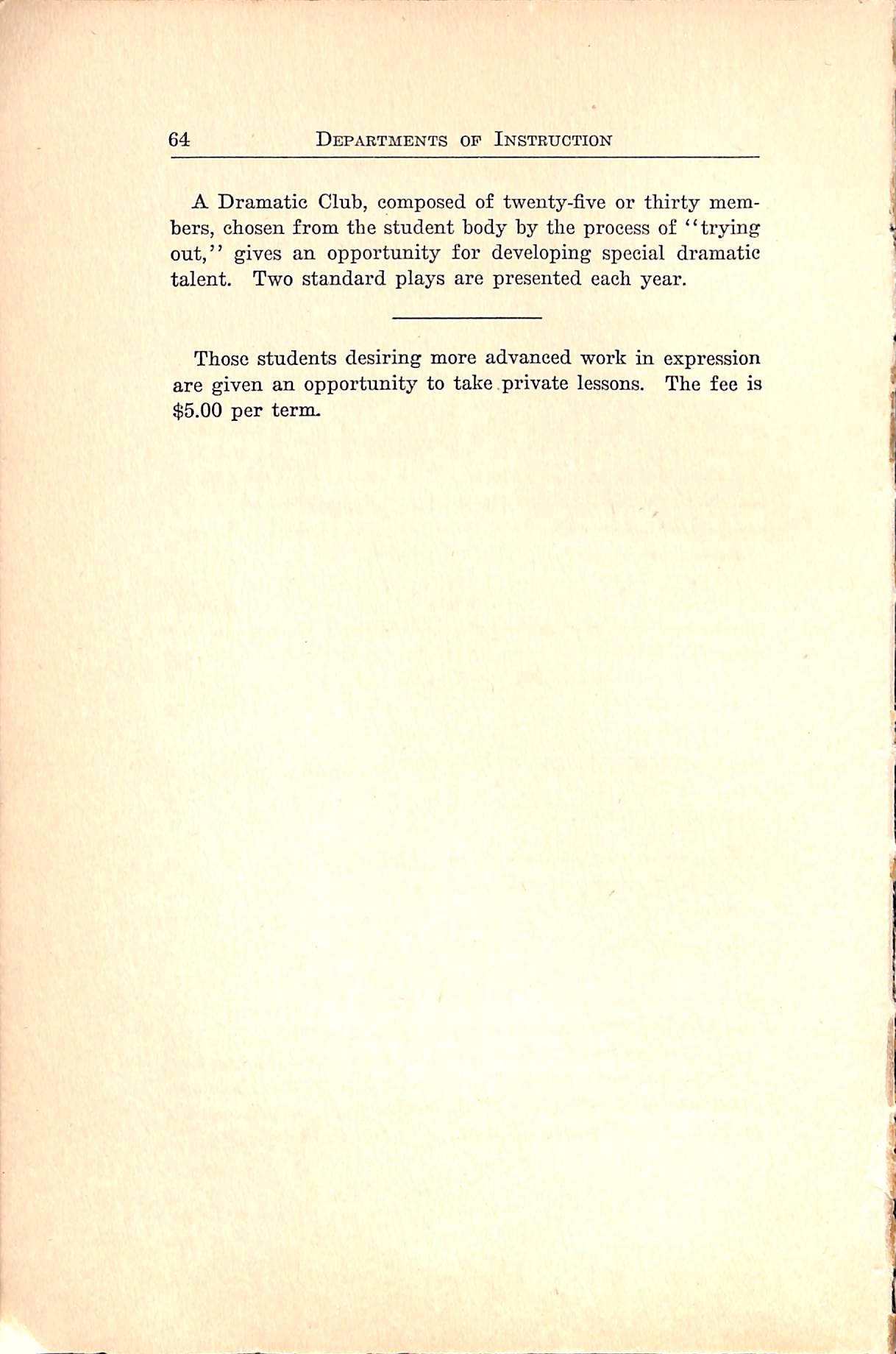
A Dramatic Club,composed of twenty-five or thirty mem bers,chosen from the student body by the process of"trying out," gives an opportunity for developing special dramatic talent. Two standard plays are presented each year.
Those students desiring more advanced work in expression are given an opportunity to take private lessons. The fee is $5.00perterm.

MR. LEAR, MISS RANDOLPH, MISS BUGG, MISS WOODBUPF
The work of the fii*st two years of the High School Course is intendedtomakethestudentconsciousofthevastnessand dignity of the province of history, to enlarge her sympathies and appreciations,and to bring her to regard history not as a series of disconnected facts,butas the life story of humanity, andtorealizethateventhevicissitudesofnationsarebut incidents in the steady progress of the race. Instruction in methods of study is given frequently and persistently.
The elective courses in history, economics, and sociology are designed to give the student who is fond of history an opportunity of pursuing the subject further and of gaining an introduction to the kindred sciences. She maythusfit herself forthe teaching ofhistoryin the high school as well asin the grades.
The High School and Professional Courses offered by this department are as follows:
high school courses in history and social sciences
Ancient History (30 a, b) First Year. Three periods a week throughout the year. The work covered in this year extends from the earliest times to 800 A.D.
TextBook: Webster's AncientSistory.
Modern History (31 a, b) Second Year. Three periods a week throughout the year. The thread of European history is followed from the time of Charlemagne down to the present day.
Text Book:Harding's Essentials in Mediaeval and Modern History.
English History (32) Third Year. Five periods a week in term A and repeated in term B for another section of

the same class. A survey of English history from the earliest times to the present is attempted. Social and indus trialdevelopmentand tlie growth ofthe political powerofthe people are the two phases that receive chief attention. In order to gain time for these studies all save the most highly significant events in the military history and foreign political relations of England arc omitted from consideration.
Text Book: Cheyney's Short History of England.
Economics (33 a) Fourth Year, High School or First Year, Professional of all courses. Three periods a week for term A. The courses previously required in commercial geography and in the economic history of the United States may be expected to equip the student with a very considerable number of eco nomic facts which will help her now to reach an understand ing of the general laws that everywhere and under all condi tions govern the business relations of men.
Text Book: Berch and Nearing's Elements of Economics.
Sociology (33 b) Fourth Year, High School or First Year, Professional of Courses II and HI. Three periods a week for term B. The present social structure and social conditions in America are studied, and efforts now being put forth toward social betterment are discussed. Especial attention is given to educational activities.
Text Book: Blackmar's Elements of Sociology.
Biblic.\l History (34 a, b) Fourth Year Higli School. Three periods a week throughout the year. (Taught by the Y."W.C.A.Secretary.)
This course is a study of early history of the Clu-istian Church as given in the Book of Acts. Emphasis is laid upon a knowledge of the Book itself, especially as to purpose, style, and its relation to the Gospels and Epistles. This is foUowed by a study of the moral condition of the world in the Apostolic Age, together with a study iof the power and influence of the three world-nations, and the part each played in preparing the way for the spread of the Gospel.
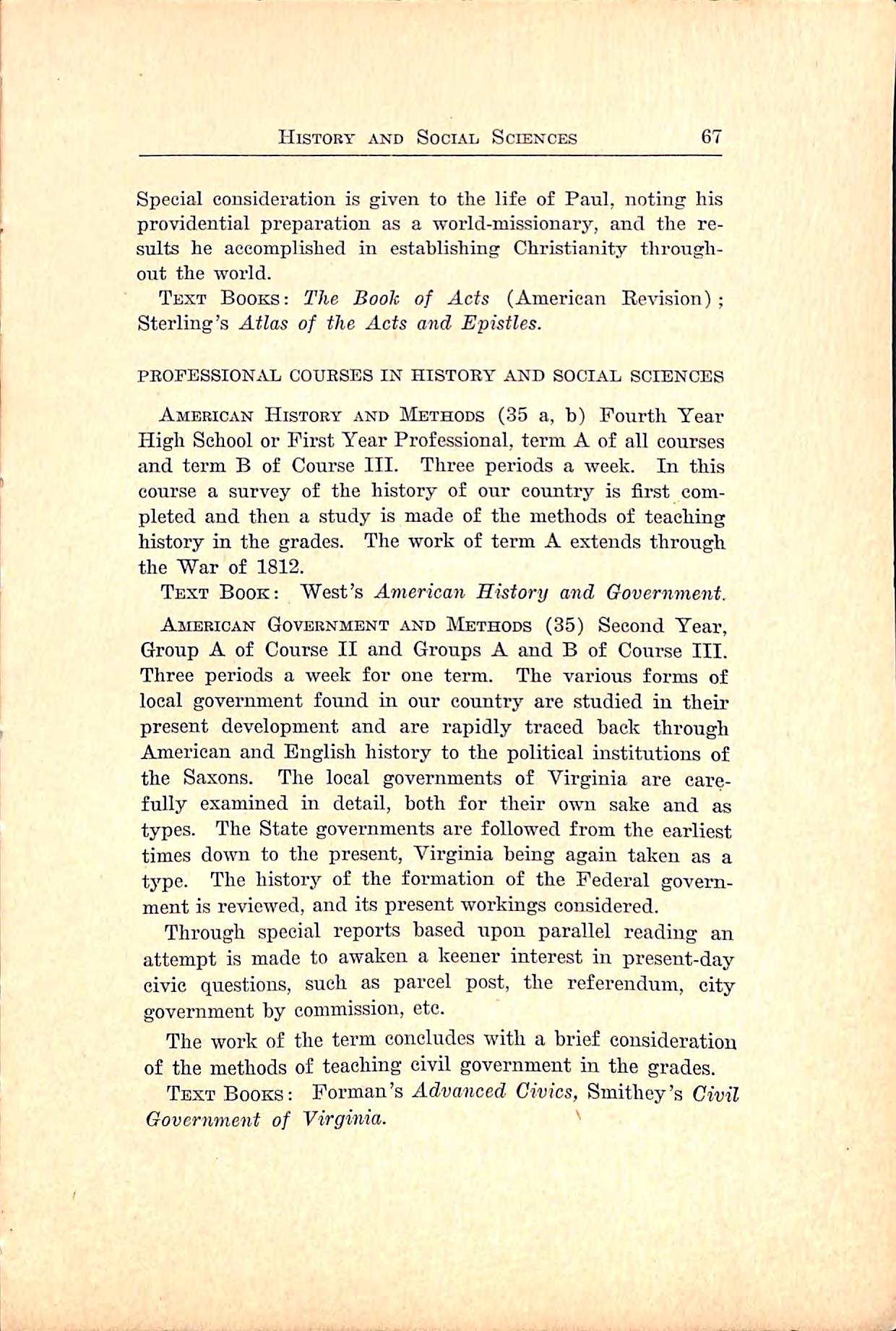
Special consideration is given to the life of Paul, noting his providential preparation as a world-missionary, and the re sults he accomplished in establishing Christianity through outtheworld.
Text Boobb: The Booh of Acts (American Revision); Sterling's Atlas of the Acts and Epistles.
PBOFESSION/VLCOURSESINHISTORYANDSOCIALSCIENCES
American History and Methods (35 a, b) Fourth Year High School or First Year Professional, term A of all courses and term B of Course HI. Three periods a week. In this course a survey of the history of our country is first com pleted and then a study is made of the methods of teaching history in the grades. The work of term A extendsthrough the War of 1812.
Text Book: West's American History and Government. American Government and Methods (35) Second Year, Group A of Course II and Groups A and B of Course III. Three periods a week for one term. The various forms of local government found in our country are studied in their present development and are rapidly traced back through American and English history to the political institutions of the Saxons. The local governments of Virginia are care fully examined in detail, both for their own sake and as types. The State governments are followed from the earliest times down to the present, Virginia being again taken as a type. The history of the formation of the Federal govern mentisreviewed,and its present workings considered.
Through special reports based upon parallel reading an attempt is made to awaken a keener interest in present-day civic questions, such as parcel post, the referendum, city government by commission, etc.
The work of the term concludes with a brief consideration of the methods of teaching civil government in the grades.
Text Books: Forman's Advanced Civics, Smithey's Civil Government of Virginia. '
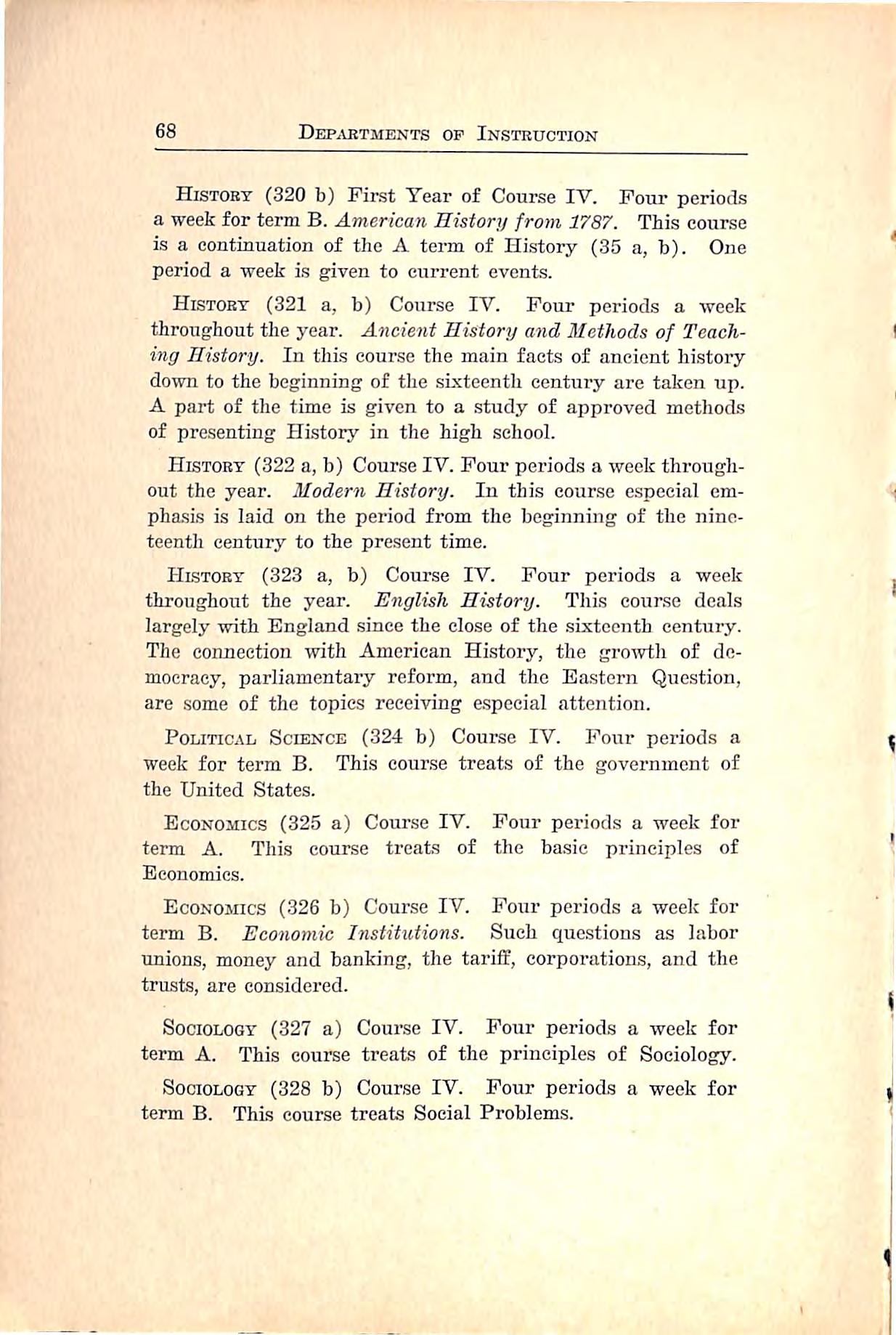
Histobt (320 b) Fii*st Year of Course IV. Four periods a weekforterm B.AmericanHistoryfrom 1787. Thiscourse is a continuation of the A tenn of History (35 a, b). One period a week is given to current events.
History (321 a, b) Course IV. Four periods a week throughout the year. Ancient History and Methods of Teach ing History. In this course the main facts of ancient history down tothe beginning ofthe sixteenth century are taken up. A part of the time is given to a study of approved methods of presenting History in the high school.
History (322 a, b) Course IV. Four periods a week through out the year. Modern History. In this course especial em phasis is laid on the period from the beginning of the nine teenth century to the present time.
History (323 a, b) Course IV. Four periods a week throughout the year. English History. This course deals largely with England since the close of the sixteenth century. The connection with American History, the growth of de mocracy, parliamentary reform, and the Eastern Question, are some of the topics receiving especial attention.
Political Science (324 b) Course IV. Four periods a week for term B. This course treats of the government of theUnitedStates.
Economics (325 a) Course TV. Four periods a week for term A. This course treats of the basic principles of Economies.
Economics (326 b) Course IV. Four periods a week for term B. Economic Institutions. Such questions as labor unions, money and banking, the tariff, corporations, and the trusts,are considered.
Sociology (327 a) Course IV. Pour periods a week for term A. This course treats of the principles of Sociology.
Sociology (328 b) Course IV. Four periods a week for termB. ThiscoursetreatsSocialProblems.

In the study of Latin, the following objects are kept in view:
1. Etjonology of English words of Latin origin. Pupils are encouraged to look for the English derivatives of Latin words with correspondences and differences in shades of meaning.
2. Comparative Grammar. Roman forms of thought are examinedin orderto make a comparison with English forms. A pupil never knows that his own language contains idioms until he has studied some language other than his own. The study of one language throws light upon another.
3. Mental Discipline. The expression in the equivalent forms of one language of the thought gained in another gives power.
An effort is made throughout this work to study the gov ernment and the private life of the Romans as well as their literature and language.
The High School and Professional courses offered by this department are as follows:
Latin (40 a, b) First Year. Five periods a week through out the year. Drill in theforms of inflection and the essentials of syntax;derivation of words;translation of easy Latin prose into English and English into Latin.
Text Book: Montgomery's A Year in Latin.
Latin (41 a, b) Second Tear. Five periods a week through out the year. More difficult prose; exercises based upon text; short course in grammar.
TextBook:Walker'sCaesar.

Departments op Instruction
Latin (Cicero) (42 a, b) Third Xear. Five periods a week throughout the year. In Catilinam, I and II, Pro Lege Manilla, and Pro A. Licinio Archia; exercises based upon the text;syntaxofcasesandverbs.
Text Books: Cicero;Bennett's Grammar.
PARAiiLEL Ek\ding: Life and Times of Cicero.
Latin (Virgil) (43 a, b) Fourth Year. Five periods a week throughout the year. Four books of the ^ueid; ele ments of Latin versification; mythology of the Romans.
Text Books: Virgil's AEneid; Fairbank's Mythology of GreeceandBorne.
Parallel Reading: Life and Times of Yirgil.
Latin and IMethods (330 b) Course IV. Four periods a week for terra B. Intensive study of Caesar. Personality and career of Caesar, significance of his conquests, his writ ings as history and as literature, Roman military system, geog raphy of Gaul, sentence structure and word order, drill in the building of a vocabulary, practice in sight reading, brief course in grammar, prose composition based on Caesar.
Text Books: Caesar's Gallic War;Bennett's Grammar; D'Ooge's Composition,Part I; Jenks's Manual of Latin Word Formation.
Latin (331 a) Course IV. Four periods a week for term A. Teaching of Latin. Review of pronunciation; rapid survey of the syntax of cases, moods, and tenses; principles of Latra order; simple sentence structure; methods of presentation; proper emphasis upon geography, ancient life and historical connections; use of maps, pictures, and various class-room helps.
Text Books: Bennett's Teaching of Latin; Andrew's Praeceptor.
Latin (331 b) Course IV. Four periods a week for term B. Life and Literature of the Romans. Roman life as seen in
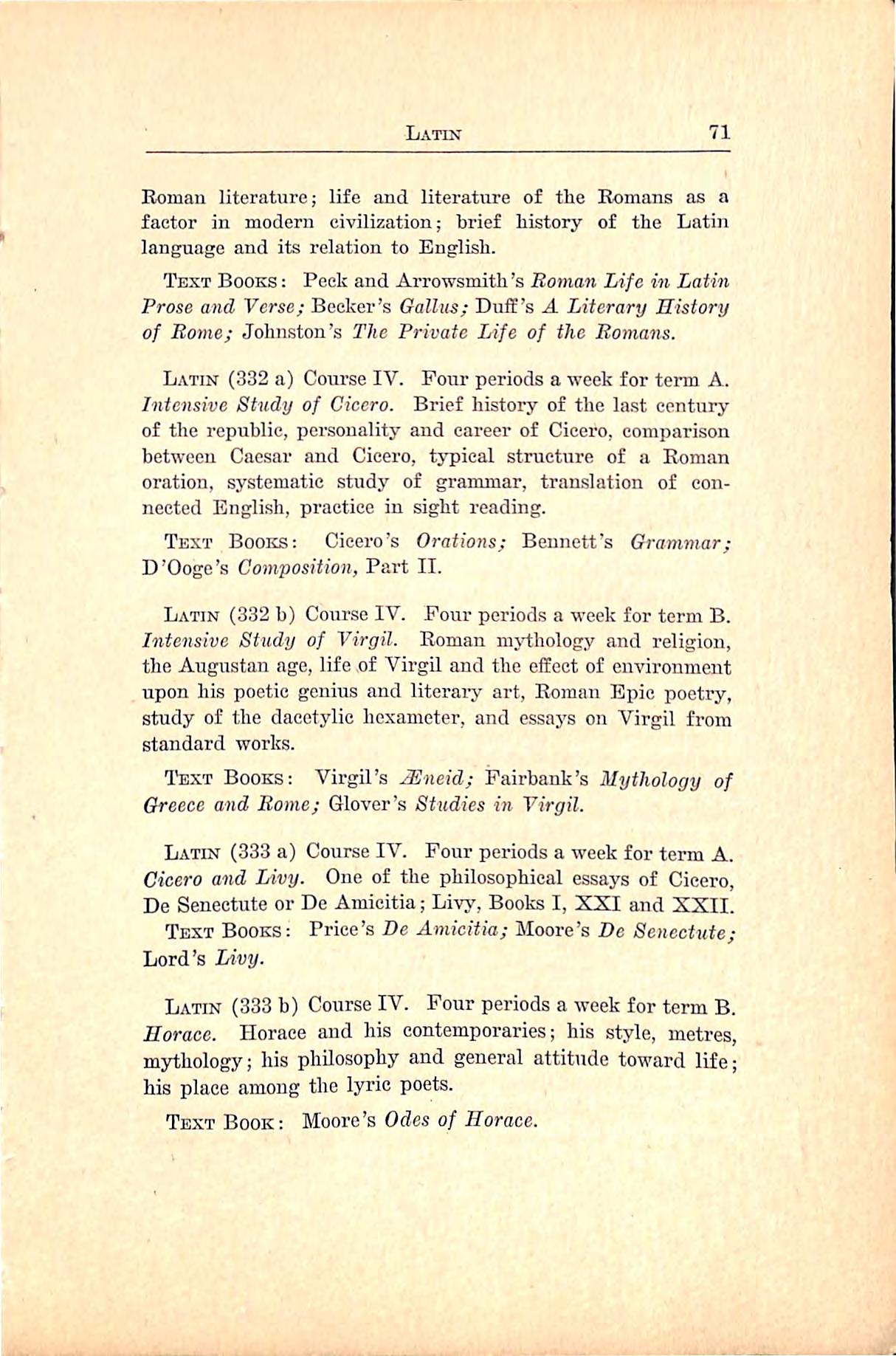
Koman literature; life and literature of the Romans as a factor in modern civilization; brief history of the Latin language and its relation to English.
TextBooks: Peck and Arrowsmith'sUonian Life inLatin P" rose and Verse;Becker's Gallus;Duff's A Literary History of Home;Johnston's The Private Life of the Romans.
Latin(332a)CourseIV. Pour periodsaweekfor term A.
Intensive Study of Cicero. Brief history of the last century of the republic, personality and career of Cicero, comparison between Caesar and Cicero, typical structure of a Roman oration, systematic study of grammar, translation of con nected English, practice in sight reading.
Text Books: Cicero's Orations; Bennett's Grammar; D'Ooge's Composition, Part II.
Latin (332b)CourseIV. Pour periodsa weekfor term B. Intensive Study of Virgil. Roman mj'thology and religion, theAugustan age,life of Virgiland the effectofenvironment upon his poetic genius and literaiy art, Roman Epic poetry, study of the dacctylic hexameter, and essays on Virgil from standardworks.
T'ext Books: Virgil's JEneid; Pairbank's Mythology of Greece and Rome; Glover's Studies in Virgil.
Latin (333 a) Course IV. Pour periods a week for term A. Cicero and Livy. One of the philosophical essays of Cicero, De Senectute orDe Amicitia;Livy,BooksI,XXIand XXII.
Text Books: Price's De Amicitia; Moore's De Senectute; Lord's Livy.
Latin (333 b) Course IV. Pour periods a week for term B. Horace. Horace and his contemporaries; his style, metres, mythology; his philosophy and general attitude toward life; his place among the lyric poets.
Text Book: Moore's Odes of Horace.

In addition to the general disciplinary value that comes from the serious study of a language other than the mother tongue,the workin French and German is designed to develop the following:
1. Mental alertness. By training the tongue, the ear and the eye, pupils are made more alert, quicker to receive impres sions,and morereadytoimparttheir own thouglitsto others. Thus they become more wide-awake.
2. Feeling for the language. An effort is made from the first lesson to enable the pupil to grasp the thought from theFrenchorGermanwithouttheaidoftranslation. This gives an appreciation of the beauty and genius of the lan guage and literature and an insight into the life and heart of the people that never comes to those who merely translate from onelanguage into another.
3. The enlargement of ideals. The opening up of a new literatureto one carries with itthe privilege of entering into the intellectual and emotional life of its people. Any serious study of the manners and customs, the ideals and institutions, thesuccesses and failures of another nation,must broaden the sympathies and give alarger view of life.
The High School and Professional courses offered by this department are as follows:
French (50 a,b) Third Year. Five periods a week through out the year. In the first term the elements of the language are studied through the medium of the language itself. Fre quent exercises in the simplest forms of sentence structure are required. Dictation in French is begun the fii^t week,
and iscontinued throughoutthe entire course. In the second
term simple original compositions in French are assigned. Easy prose and a few lyrics are studied.
Text Books: Walter and Ballard's Beginner's French; Guerber's Contes et Legendes.
French (51 a, b) Fourth Year. Five periods a week throughout the year. The study of French Grammar from a text book is continued in this class. French composition is continued. Translation ofFrenchinto English and connected S passages from English into French is a part of the work of
this class. In the second term much oral and -written reproductioninFrenchofstoriesandanecdotesreadinclassisre quired. Every effortis madetostimulate studentsto become independent in grasping the thought and in discovering the meaning ofnew wordsfromthe context.
Text Books: Walter and Ballard's Beginner's French; Coppee's Le Luihier de Cremone et Le Tresor; Labiche's La Cigale chez Les Foumis; and Legouve's Le Voyage de Mon sieurPerrichon.
German(52a,b) Third Year.Five periods a week through out the year. The work for this year is similar to that of the second year in French. Much oral drill is given, so that students may acquire fluency in pronunciation and some feeling for the language. In the second term short original papers in German are required.
Text Books: Bagster-Collins' First Book in German; Guerber's Mdrchen und Erzdhlungen.
German (53 a, b) Fourth Year. Five periods a week throughout the year. The study of grammar is continued in this class. Translation from German into English and much reproduction in German of texts read in class form a part of the work of this term. In the second term more difficult texts are read, but the character of the work is the same.
Text Books: Qliick Auf; Bacon's German Composition. Short texts to be selected for this class.
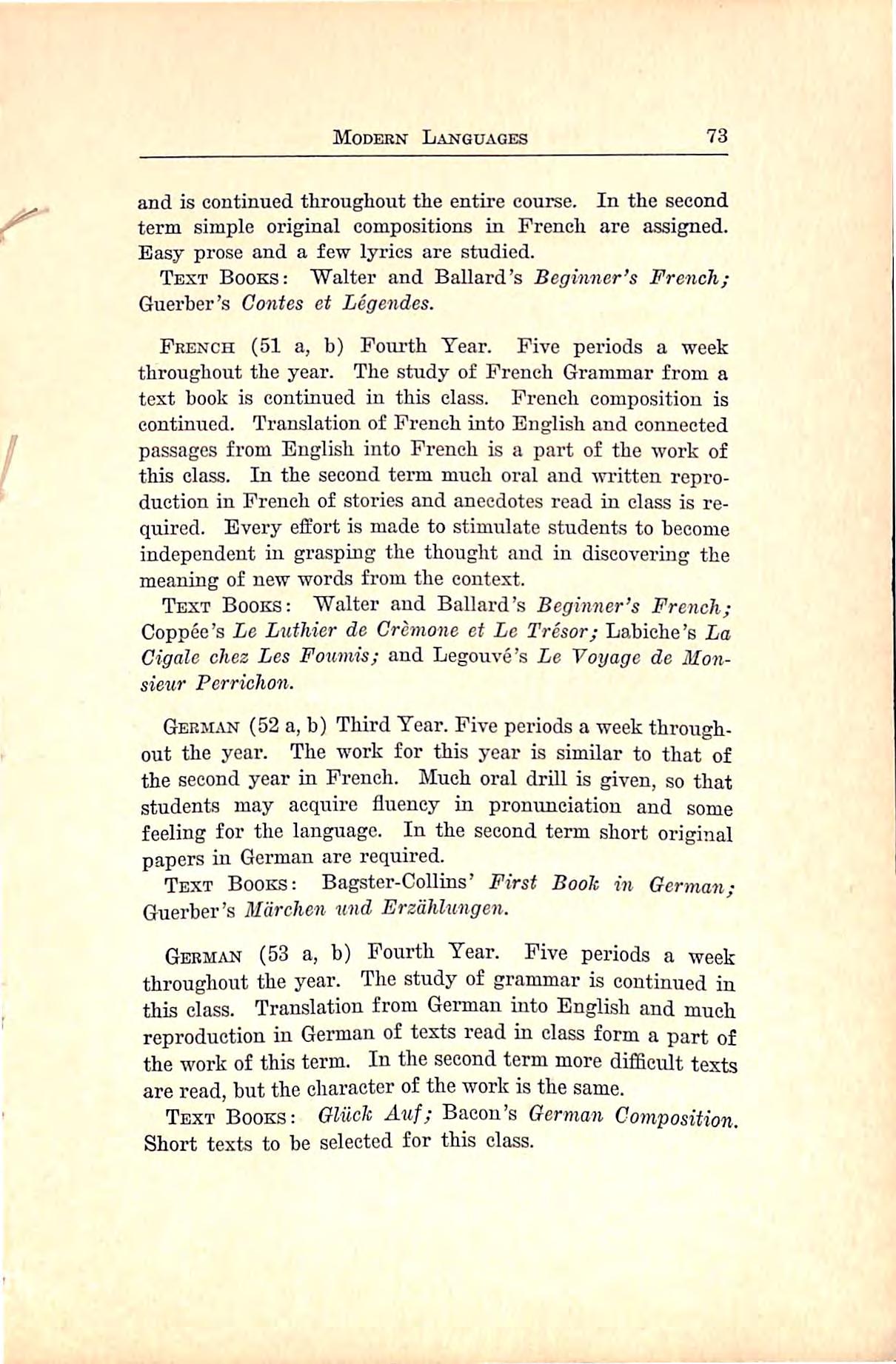
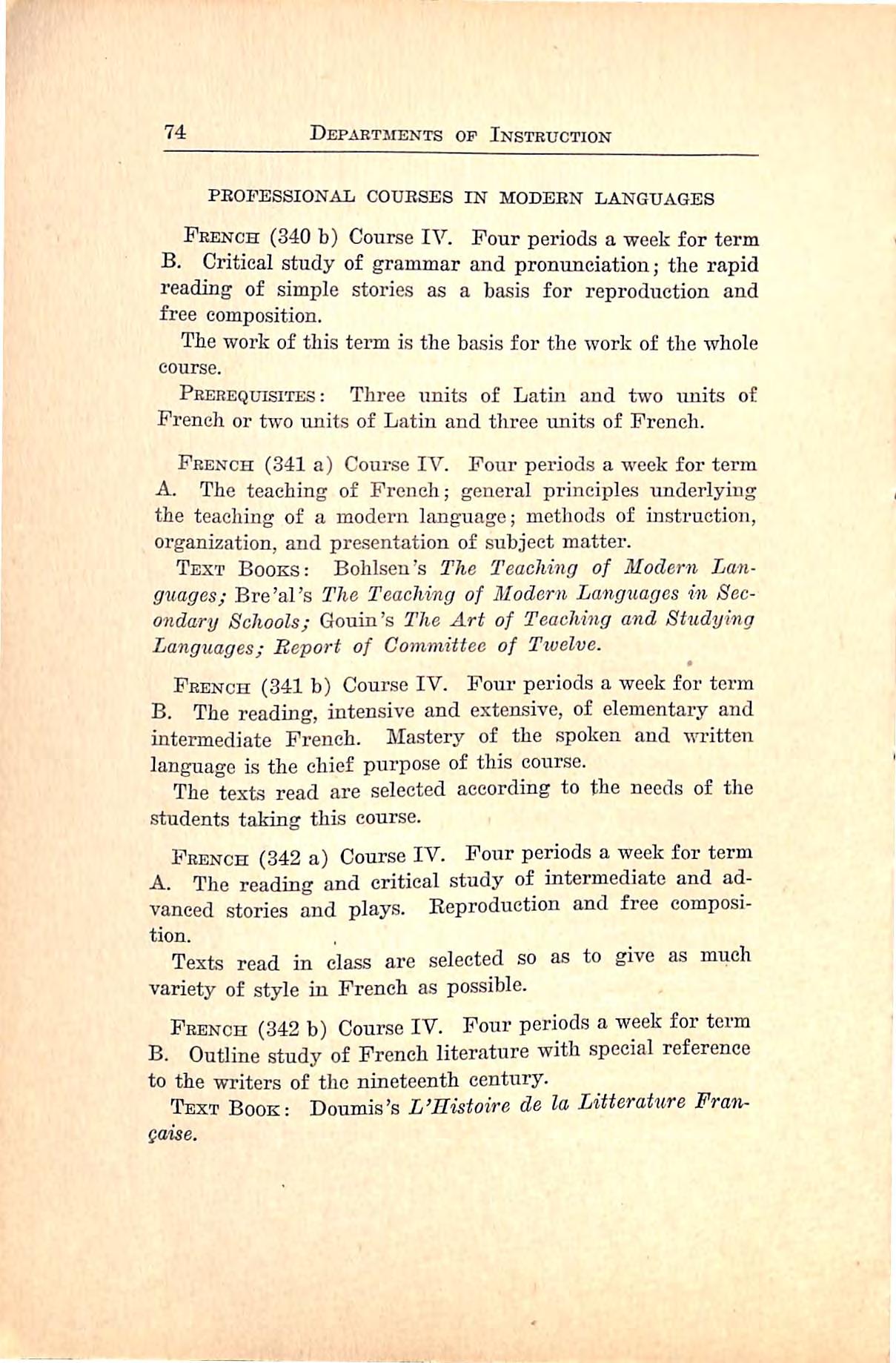
PEOFESSIONALCOUESESINMODEENLANGUAGES
French (340 b) Course IV. Four periods a week for term
B. Critical study of grammar and pronunciation; the rapid reading of simple stories as a basis for reproduction and free composition.
Theworkofthistermisthebasisfortheworkofthewhole course.
Prerequisites: Three units of Latin and two units of French ortwo units of Latin and three units of French.
French (341 a) Course IV. Four periods a week for term
A. The teaching of French; general principles underlying the teacliing of a modern language; methods of Instruction, organization,and presentation ofsubject matter.
Text Books: Bohlseu's The Teaching of Modern Lan guages; Bre'al's The Teaching of Modern Langiiages in Sec ondary Schools; Gouin's The Art of Teaching and Studying Languages; Report of Committee of Twelve.
French (341 b) Course IV. Four periods a week for term
B. The reading, intensive and extensive, of elementary and intermediate French. Mastery of the spoken and written language is the chief purpose of this course.
The texts read are selected according to the needs of the students taking this course.
I'rench (342 a) Course IV. Four periods a week for term
A. The reading and critical study of intermediate and ad vanced stories and plays. Reproduction and free composi tion.
Texts read in class are selected so as to give as much variety of style in French as possible.
French (342 b) Course IV. Four periods a week for term
B. Outline study of French literature with special reference to the writers of the nineteenth century.
Text Book: Doumis's L'Histoire de la Litterature Frangaise.

French (343a)CourseIV. Four periods a weekfor term
A. Literature of tlie classic period.
Text Books: Crane's La Societe Frangaisc an Dix-Septieme Siecle; Taine's L'Ancien Regime; Selected plays and lettersfrom this period.
French (343b) CourseIV. Four periods a week forterm
B. Study of the Romantic Movement in French Literature.
TextBook: To be selected.
German(350b) CourseIV. Four periods a week for terra
B. Critical study of grammar and pronunciation; the rapid reading of elementary German as a basis for reproduction and free composition.
Theworkofthistermisthebasisfortheworkoftheen tirecourse.
Prerequisites: Three units of Latin and two units of GermanortwounitsofLatinandthreeunitsofGerman.
German (351a) CourseIV. Four periods a week for term
A. The teaching of German; general principles underlying the teaching of modern foreign languages; methods of in struction; organization and presentation of subject matter.
Text Books: Bagster-Collins's German in Secondary Schools; Jespersen's Hoxv to Teach a Foreign Langnage.
Note.—See list of text booksfor French (341 a).
German (351 b) Course IV. Four periods a week for term
B. Extensive and intensive reading of elementary and in termediate German; oral and written reproduction of texts read and free composition.
Special purpose of the work of this term, mastery of the spoken and written language.
German (352 a) CourseIV. Four periods a week for terra
A. Outline course in German literature with special refer ence to some of the writers of the nineteenth century.
Textsread areselected with reference to needs ofstudents inclass.
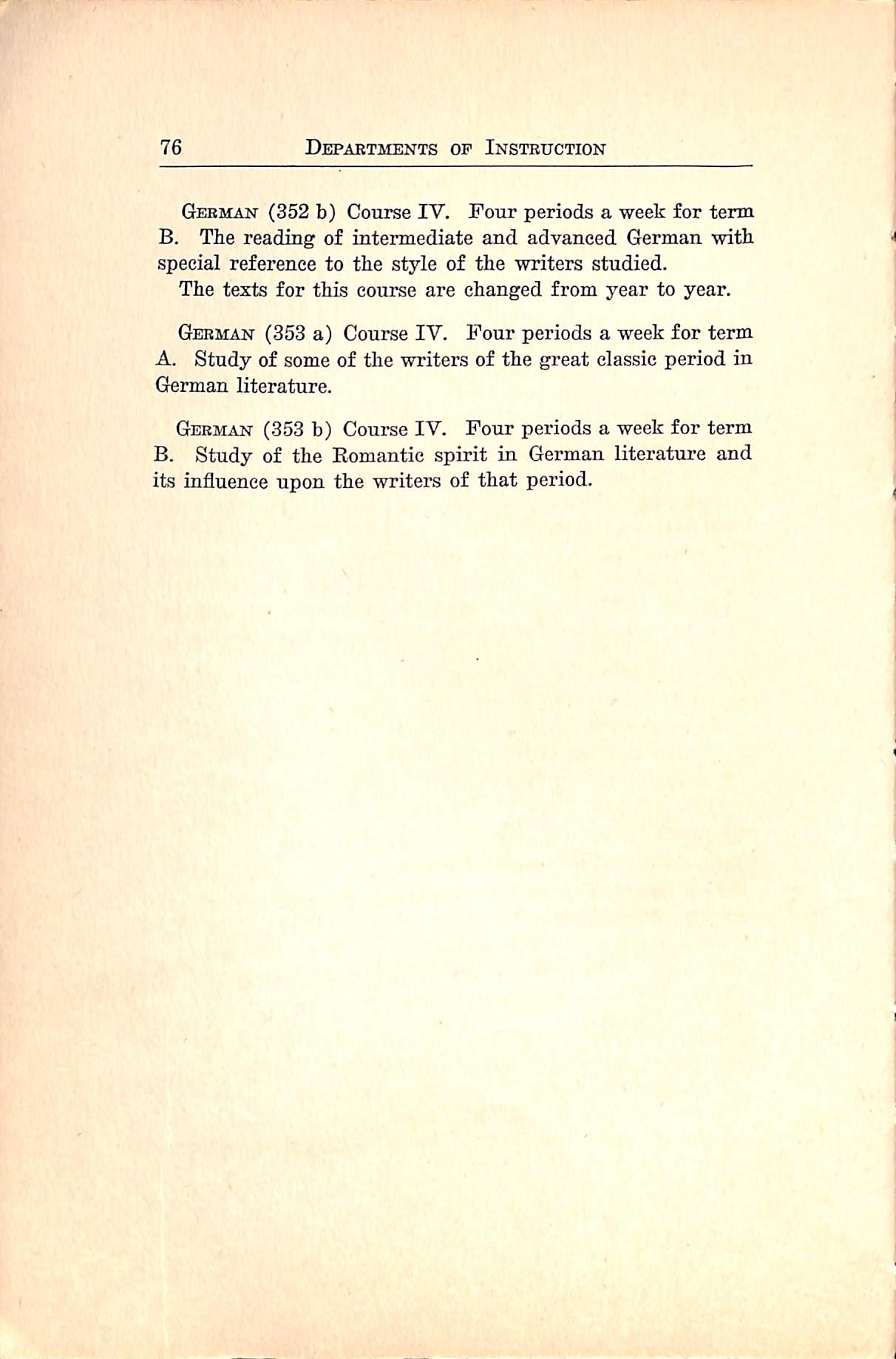
German(352b) CourseIV. Four periods a week for term
B. The reading of intermediate and advanced German witk special reference to the style of the writers studied.
The texts for this course are changed from year to year.
German(353a)CourseIV. Fourperiodsa weekforterm
A. Studyofsomeofthe writersofthegreatclassic periodin Germanliterature.
German (353 b) Course IV. Four periods a week for term
B. Study of the Romantic spirit in German literature and its influence upon the writers of that period.
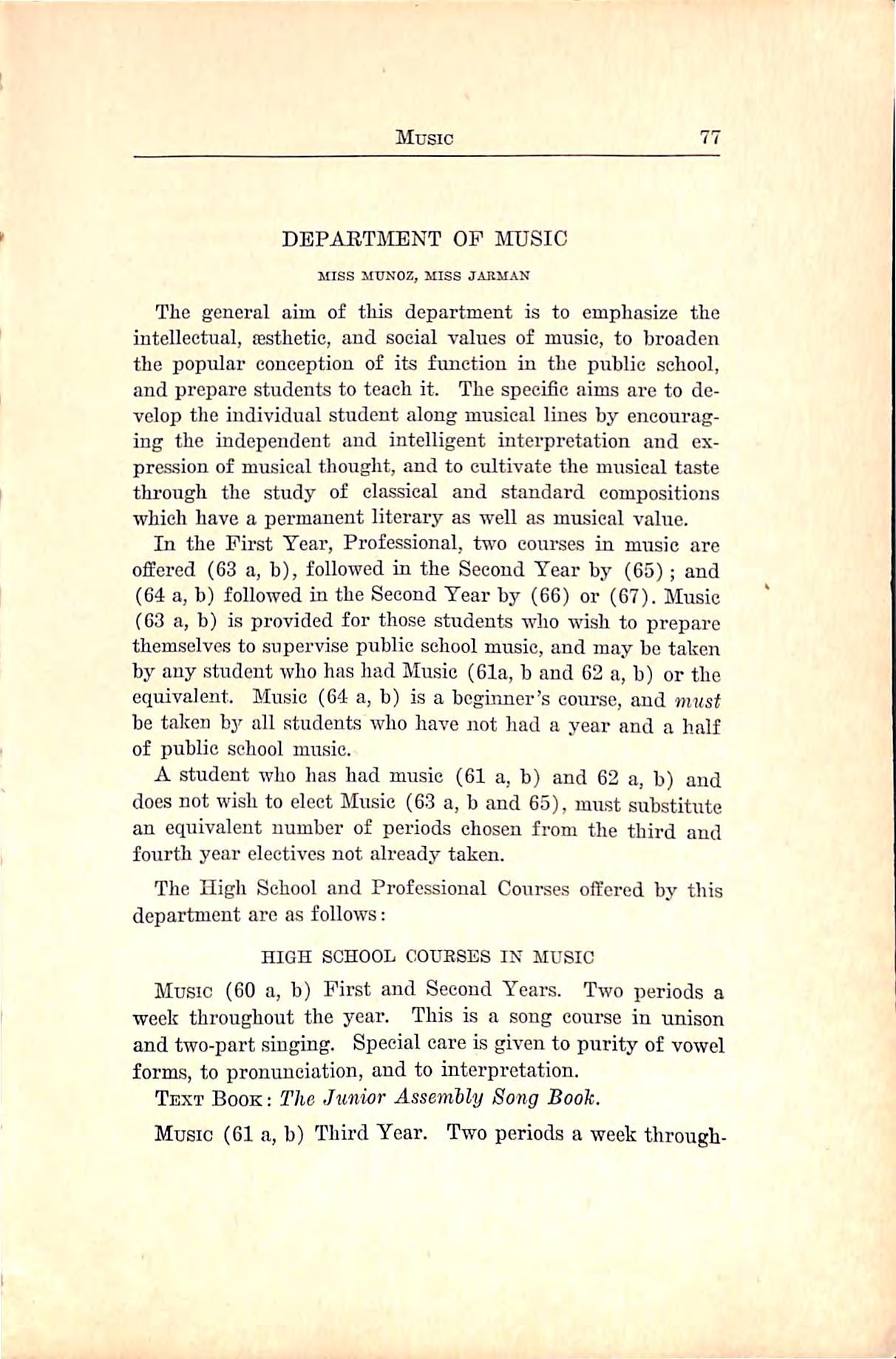
The general aim of this department is to emphasize the intellectual, sesthetic, and social values of music, to broaden the popular conception of its function in the public school, and prepare studentsto teach it. Thespecific aims are to de velop the individual student along musical lines by encourag ing the independent and intelligent interpretation and ex pression of musicalthought,and to cultivate the musical taste through the study of classical and standard compositions which havea permanentliterary as well as musical value.
In the First Tear, Professional, two courses in music are offered (63 a, b), followed in the Second Year by (65); and (64 a, b)followed in the Second Tear by (66) or (67). Music (63 a, b) is provided for those students who wish to prepare themselves to supervise public school music, and may be taken by any student who has had Music (61a, b and 62 a, b) or the equivalent. Music (64 a, b) is a beginner's course, and must be taken by all students who have not had a year and a half of public school music.
A student who has had music (61 a, b) and 62 a, b) and does not wish to elect Music (63 a, b and 65), mast substitute an equivalent number of periods chosen from the third and fourth year electivcs not already taken.
The High School and Professional Courses offered by this department are as follows:
Music (60 a, b) First and Second Years. Two periods a week throughout the year. This is a song course in unison and two-part singing. Special care is given to purity of vowel forms, to pronunciation, and to interpretation.
TextBook:TheJunior Assenibly Song Book.
Music (61 a,b) Third Tear. Two periods a week through-

out the year. This course is designed for beginners in sight singing and consists of such theory as is essential to the in telligentreading ofselectionscontained in the firsttwo books oftheaveragetext-book series.
During the firstterm,the major scale, octave,tonic arpeg gio, and tetrachord are considered as type forms to facilitate phrase reading. Signatures of the nine keys commonly used in public-school music are developed from, scale ladders. Analysis and application of time signatures is made through study of varieties of rhythm. Reference is made to the chromatic scale, as the introduction of chromatics in a selec tion requires it.
Part singing is introduced during the latter part of the first term by means of rounds, canons, and simple two-part songs.
The work of the second term consists of more advanced two-part singing with constant alternation of voices, except in special cases, where the alto tendency is strong. Common in tervals of two-part songs are learned. Chromatic scale is de veloped and reproduced in nine keys. Minor mode is intro duced by means of songs containing both major and minor intervals. Study is made of the minor scale in its several forms as related to the major.
Structure and location of the major and minor triads of the major scales are studied.
The vocal work is supplemented by written work as a fur ther means of ear and eye training.
Text Books; Harmonic Series, Primer and First Book.
Music (62 a, b) Fourth Year. Two periods a week throughout the year. This course includes a survey of the music of ancient and primitive periods and traces the develop ment of modern music up to the presenttime. A classification of the most important vocal and instrumental forms is made with particular stress on folk music, considered from the his torical and literary as well as musical viewpoint, and a typical song of each nation is learned.

Music (63 a,b) First Year of all courses. Two periods a week throughout the year. This is the beginning of a threeterm course (63 a,b and 65) planned for those students who wishto preparethemselvesforthesupervision of public school music,and may be taken by any student who has had music (61a,b)and(62a,b)or the equivalent,or who hashad two yearsstudyof pianoforte andtwo yearsvoice culture.
Term A includes more difficult part singing, melody writing in one partform,and elementarj'harmonic analysis, consisting of the singing of triads and chords of the seventh in all positions and uivei*sions, also the recognizing and writ ing of them. Modulation is introduced and analysis of song is carried along "udth this work.
Term B presents general educational principles, applying them to the teaching of music. The work begins with a brief history of public school music teaching, with discussions as to the relative merits of the Fixed Do and Movable Systems. A complete course of study for public schools from kinder garten to high school is given. Practical applications of this course of study to the various conditions in ungraded, graded, and city schools is made. Definite plans of work are outlined, .subject matter systematized, and methods of procedure sug gested.
Text Books: Broeckoven's Harmony;James Bates' Voice Culture for Children; Harmonic Series, Book III.
Music(64a,b)FirstYear,term A of all courses and term B of Courses I, II, and Group A of Course III. Two periods a week throughout the year. This is the beginning of a threeterm course (64 a, b and 66 or 67) provided for those students who have had no music. The purpose of this course is to sup ply a basal experience in music similar to that with which the student is equipped in the elementary school branches upon entering our school. The course is essentially the same as course (61 a, b) with much more individual sight singing.
Text Books: Harmonic Series, Primer and First Reader.
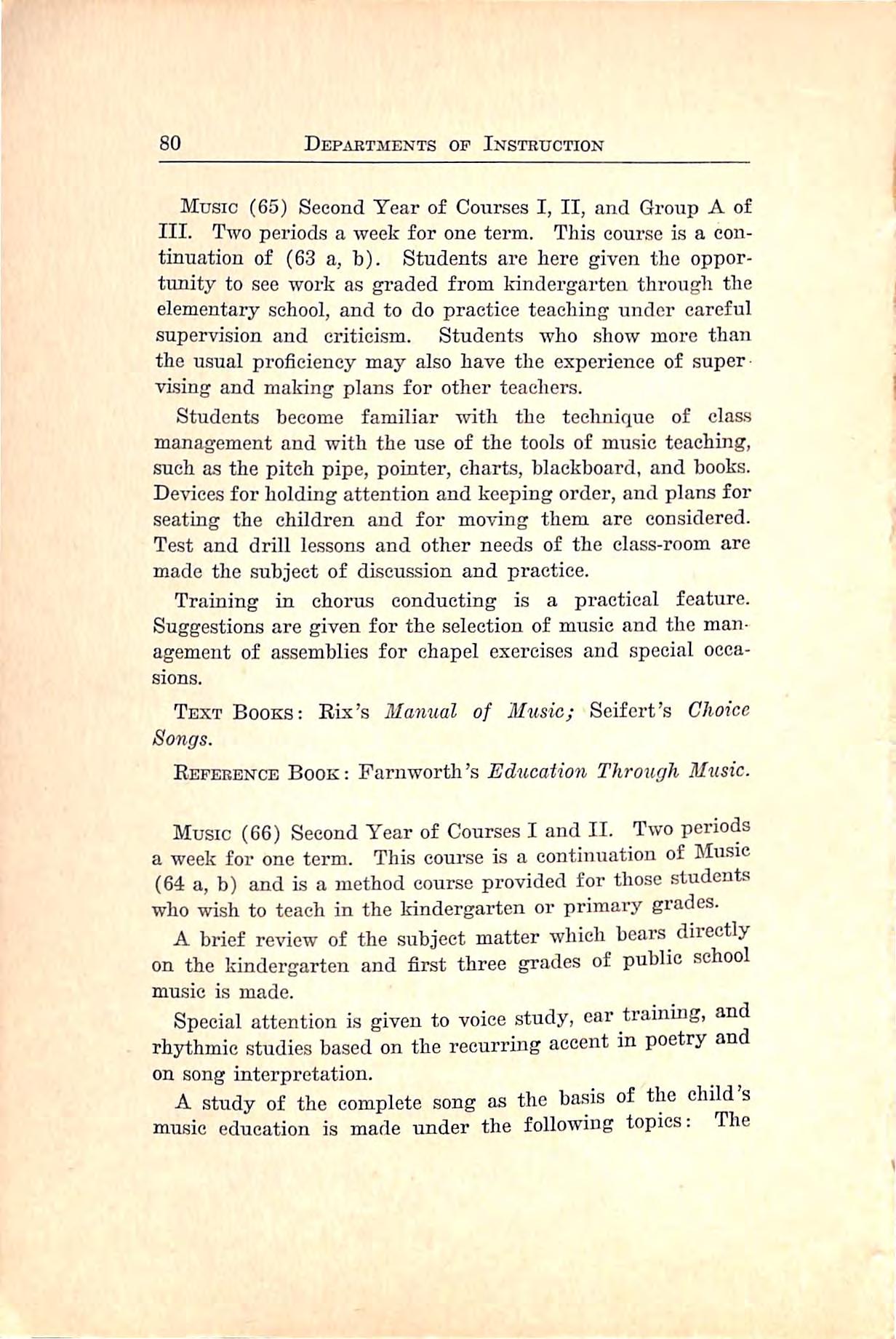
Music (65) Second Tear of Courses I, II, and Group A of III. Two periods a week for one term. This course is a con tinuation of (63 a, b). Students are here given the oppor tunity to see work as graded from kindergarten through the elementary school, and to do practice teaching under careful supervision and criticism. Students who show more than the usual proficiency may also have the experience of super vising and making plansfor other teachers.
Students become familiar with the teeliniquc of class management and with the use ofthe tools of music teaching, such as the pitch pipe, pointer, charts, blackboard, and books. Devices for holding attention and keeping order,and plans for seating the children and for moving them are considered. Testanddrilllessonsandotherneedsoftheclass-roomare made the subject of discussion and practice.
Training in chorus conducting is a practical feature. Suggestionsare givenfortheselection of musicand the man agement of assemblies for chapel exercises and special occa sions.
Text Books: Bix's Manual of Music; Seifert's Choice Songs.
Repebbnce Book: Farnworth's Education Through Music.
Music (66) Second Year of Courses I and II. Two periods a week for one term. This course is a continuation of Music (64 a, b) and is a method course provided for those students who wish to teach in the kindergarten or primary grades.
A brief review of the subject matter which bears directly on the kindergarten and first three grades of public school musicismade.
Special attention is given to voice study, car training, and rhythmic studies based on the recurring accent in poetry an on song interpretation.
A study of the complete song as the basis of the child s music education is made under the following topics: The

selection of songs (a) witli reference to their vital relations to the child's interests and activities, (b) with reference to their melodic and rhythmic construction as the true interpre tationoftheircontent,and(c)with reference tothe pitch and compass of tlie child's voice; method of teaching the song; observation of the simpler elements of the song,such as the phrase, measure, recurring type forms of melody and rlijtihm : transition from rote to note singing through the three formal steps of observing, acting and picturing of pitch, duration and pulse; visualization of notation of familiar songs; and part nership work as a preparation for absolute sight singing.
The use of the chromatic pitch pipe in the giving and fre quent rapid testing of pitch is taught.
Text Book:Ris's Manual of Mnsic.
Reference Text Book:Farnsworth's Education Through Music.
Music (67) Second Year, Group A of Course III. Two periods a weekfor oneterm. This course is a continuation of (64a,b)and is a method course provided for those students who wish to teach in the intermediate and grammar grades. The method.s taught are based on those used in the Training School from the fourth to the eighth grades.
Special study of the classification and use of voices for partsingingis made.
Lessons are given in the theory and practice of teaching partsongs.
A tentative course adaptable to the average school is out lined.
TextBook;Rix'sManual of Music.
Reference Text Book: Farnsworth's Education Through Music.
Music (68 a) Second Year, Group B of Course III. Two periods a week for one term. This course has not been worked up yet, but will be designed to meet the needs of students who expectto teach in the rural schools.

A course in musical appreciation is given throughout the entire course by means of Victrola records selected especially for that purpose.
A Glee Club composed of forty or fifty members, selected by the director of music from the music classes and best singers of the student body, receives weekly training in two, three,and four-partsinging. Public recitals are given once or twice a year.
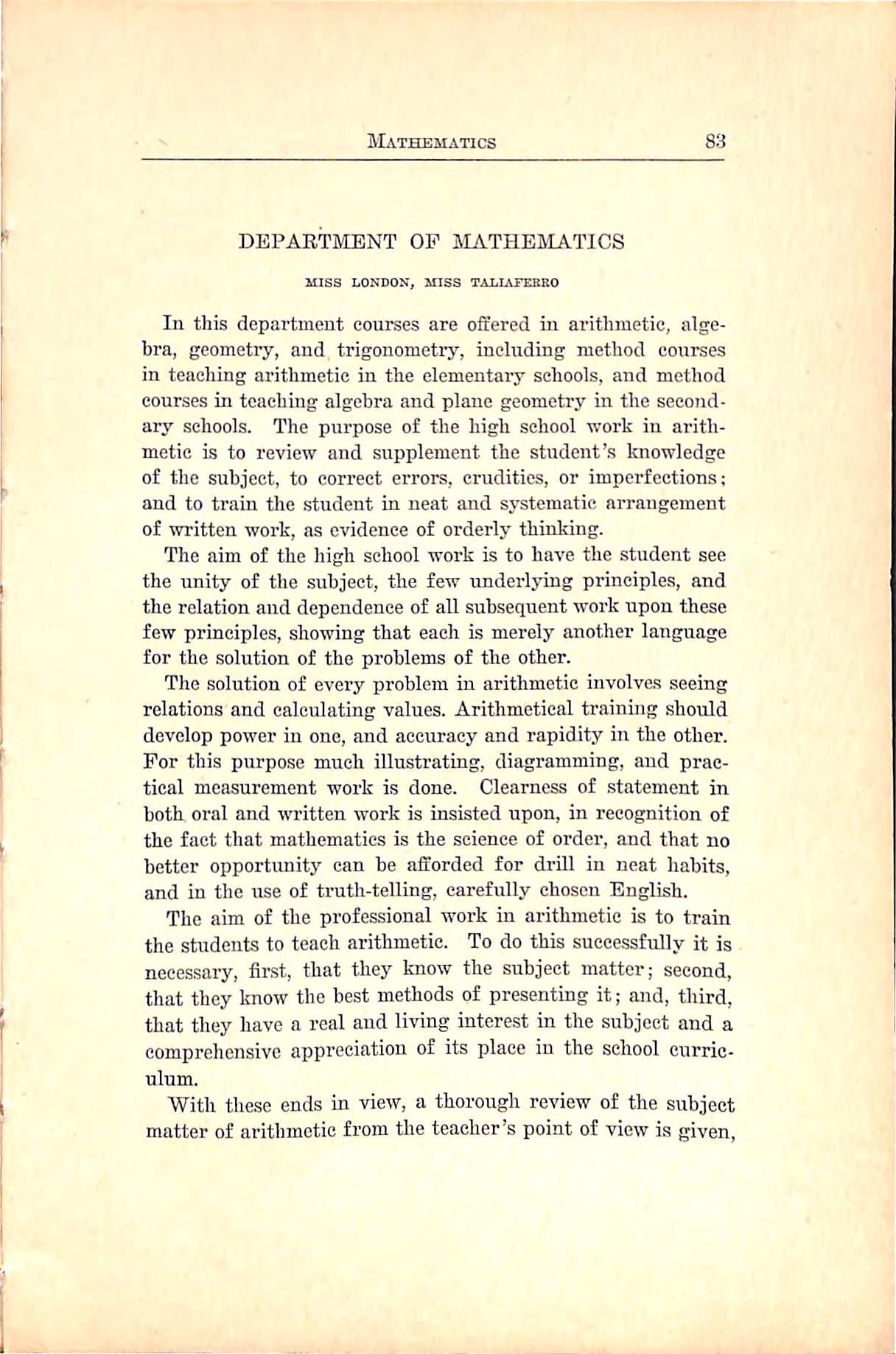
In this department courses are offered in arithmetic, alge bra, geometiy, and trigonometry, including method courses in teaching arithmetic in the elementary schools, and method courses in teaching algebra and plane geometry in the second ary schools. The purpose of the high school work in arith metic is to review and supplement the student's knowledge of the subject, to correct errors, crudities, or imperfections; and to train the student in neat and systematic arrangement of written work, as evidence of orderly thinking.
The aim of the high school work isto have thestudentsee the unity of the subject,the few underlying principles, and therelationanddependenceofaUsubsequentworkuponthese few principles,showingthat each is merely anotherlanguage for the solution of the problems of the other.
Thesolution of every problem in arithmetic involvesseeing relations and calculating values. Arithmetical training should develop powerin one,and accuracyand rapidityinthe other. For this purpose much illustrating, diagramming, and prac ticalmeasurementworkisdone. Clearnessofstatementin both oral and written work is insisted upon,in recognition of the fact that mathematics is the science of order,and that no better opportunity can be afforded for drill in neat habits, and in the use of truth-telling, carefully chosen English.
The aim of the professional work in arithmetic is to train the students to teach arithmetic. To do this successfully it is necessary, first, that they know the subject matter; second, that they know the best methods of presenting it; and, third, that they have a real and living interest in the subject and a comprehensive appreciation of its place in the school curric ulum.
With these ends in view, a thorough review of the subject matter of arithmetic from the teacher's point of view is given,

a text book is used,and the material is chosen to fit the needs of each particular class. A discussion of methods of teach ing arithmetic in the grades follows. The work is taken up both topically and by grades,and the mostapproved methods of teaching the subject discussed.
By an intelligent study of algebra the view of the whole field of mathematics is broadened, and the ability to think more abstractly than heretofore is gained. Moreover, the understanding of algebraic truths and principles is funda mentally necessary to the further pursuance of mathematics, and also to a clear understanding of the more abstract pro cesses of arithmetic.
The work in advanced algebra is given for those students who are preparing to teach algebra in the high school and hence wish a broader outlook upon the subject.
In teaching geometry tlie effort is made to develop in the studentthe power oflogical,sj'stematic thought,and tosecure clear and accurate expression.
Special attention is given to original work and construc tions, in order to develop self-reliance and to stimulate the spirit of inquiry into mathematical truths.
The language of geometry furnishes an excellent di'ill in exactness of expression—not over-saying nor under-saying the truth.
A short course in Plane Trigonometry is given. The aim of this course is to give, as briefly as is consistent with clear ness, the fundamental principles of the subject; to have the student derive the necessary formulas and then to make the problems as practical and as interesting as possible.
Theaimofthemethodcour.seinmathematicsistotrain studentstoteach algebra and plane geometry in the first and second yearsofthesecondaryschools. To avoid the tendency to treat these branches of mathematics as isolated subjects bearing no relation to each other or to arithmetic, the student is brought to appreciate the unity of mathematics, by observ ing how each subject supplements and broadens the mathe maticaltruthstreatedintheothers. a

The High School and Professional Courses olfered by this department are as follows:
Alqebra (70 a, b) First Year. Five periods a week through outthe year. Tlie work of the first term includes the funda mental operations, the use of symbols of aggregation, the combining and simplifying of simple equations, the various methods of factoring, and common divisors and multiples. Tlie work of the second continues through Chapter XIV.
Text Book: Wells and Hart's Nciv High School Algebra.
Algebra (71 a) Second Year. Five periods a week for term A. An abridged course in secondary algebra is com pleted, begmning with a rapid review of the work of the pre vious term.
Text Book:Wells and Hart's New High School Algebra. Arithmetic(72b)Second Year. Five periodsa week for term B. The aim of this course is to review, complete if necessary,and toextendthe previous workin arithmetic. The material is chosen each year to meetthe needs of the class.
TextBook:Smith'sModernAdvancedArithmetic.
Plane Geometry (73 a, b) Third Year. Four periods a week throughout the year. In the first term simple geometrical construction workisdone. Thestudentsarethen led toframe and demonstrate theorems based upon these constructions. The ground covered is usually the first two books of Plane Geometry. In the second term an abridged course in Plane Geometry is completed.
Text Book: Weutworth-Smith's Plane Geometry.
Solid Geometry (74 a) Fourth Year. Four periods a week for term A. An abridged course in Solid Geometry is completed.
Text Book:Wentworth-Smith's Solid Geometry.
Plane Trigonometry (75 b) Fourth Year. Four periods a week for term B. A brief course in Plane Trigonometry

is given, with special attention to the practical application of the subject.
Text Book: Bobbins' Plane Trigonometry.
Abithmetic and Methods (76 a, b) First Year, term A of all courses,term B of Course III. Three periods a week throughoutthe year. Thefirstterm ofthiscourse is given to reviewing and vitalising the subject matter of arithmetic. The second term is devoted to general work in methods. A stand ard course of study is outlined, and the most approved methods of teaching the subject in the grades are discussed.
TextBooks:FortermA—Tobeselected. FortermB— J."W. A. Young's The Teaching of Mathematics, David Eugene Smith's The Teaching of Elementary Mathematics, and The Training School Course of Study.
Solid Geometry (360 b) Course IV. Four periods a week for term B. The first part of this term is given to original exercises in Plane Geometry and to strengthening class weak nesses disclosed by this work. The usual propositions and original exercises of Solid Geometry follow. Various matters ofinterestto the teacher of geometry are discussed,and oral reports, chiefly along historical lines, are required.
Text Books: Any standard Plane Geometry. "Wells and Hart'sSolidGeometry.
College Algebra(361a)CourseIV. Four periodsa week for term A. Some review of high school algebra comes first, with emphasis upon the principles underlying the mechanical operations, correlation with arithmetic, the importance of cheeking results. The text-book is followed rather closely Oral and written reports are made from required reading.
TextBook:Fite's College Algebra.
Method op Teaching High School Mathematics (361 b) Course IV. Four periods a week for term B. This course begins with such general topics as the reasons for teaching

tlie differeut branches of mathematics,a brief history of their development,the correlation of subjects"with each other and "with other courses in the curriculum, the subject-matter to be offered. A study of the presentation of tj'^pical parts of arithmetic,algebra,and geometry is made next,special atten tion being given to the introductory "work; and the "viewpoint of both teacher and pupil is considered, particularly with reference to arousing the interest of the latter. The text book work is supplemented by the reading and discussion of reports,magazine articles, and other books dealing with mod ern tendencies in the teaching of mathematics. Directed teaching and observation are included in the work of this term.
Text Books: J. W. A. Young's The Teaching of Mathe matics,Da"vid Eugene Smith's The Teaching of Geometry.
Plane Teigonometry(362a) Course IV. Four periods a weekfor term A. In the beginning of the course the students are led to be independent of the book in discovering the con stancy of the trigonometric ratios, in building a simple table of natural functions, and in originating formulae and prob lems.Some field work,with improvised instruments,is given to impress the practical nature of the subject. The usual topics are studied, and the question of method is keptin mind.
Text Book:To be supplied.
Historyof Mathematics(362b) CourseIV.Four periods a week for term B. The student derives an intelligent appre ciation of the science from a knowledge of its sources and of its development through the centuries, in spite of the obstacles which,from time to time,retarded its growth. A very human interest is gained from the study of the lives of those who have contributed to this growth.
Eeferences: Histories of Mathematics and magazine articles.

PiiANE Analytical Geobietrt(363 a).
Elementary Coursein the Calculus(364 b).
Differential Calculus (365 a).
Integral Calculus (366 b).
Rapid Review of High School Mathematics (367 b).
The five courses listed above,363 a to 367 b,inclusive, are offeredaselectivesintheFourthYearofCourseIV.Bach course runsfour periods a week for one term. Students majoring in mathematics are required to take up two of these courses, the selection being made with reference to the needs andwishesoftheclass.

MISSWINSTON
In this departmeut the effort is made to develop the scien tific habit of thought, to teach the student to observe accu rately and to make application of her knowledge to the facts which are common in her daily experience.
The High School and Professional Courses offered by this department arc as follows:
Physics(80a,b)ThirdYear.Fiveperiodsaweekthrough out the year. This course consists of lectures with illustrative experiments, combined with recitations, and includes the solving of numerous problems. The work of the first term takes up sound, light, and heat; the second term magnetism and electricity, and the mechanics of solids, liquids, and gases.
The prerequisites for physics are algebra, through quad ratic equations and mensuration,in arithmetic.
Text Book: Millikan and Gale's First Course in Physics.
Chemistry (81 a, b) Third Year. Two double laboratory periods and three recitation periods a week throughout the year. Inorganic Chemistry. The first term deals with nonmetals. In the second term the metals are studied by means of a brief course in Qualitative Analysis.
Text Books: Morgan and Lyman's Elementary Chemistry, Stoddard's Qualitative Analysis.
Laboratory Fee:One dollar per term.
Physics (370 a, b) Course IV. Four periods a week throughout the year. This course includes a review and exten sion of High School Physics. The aim is to furnish a back-
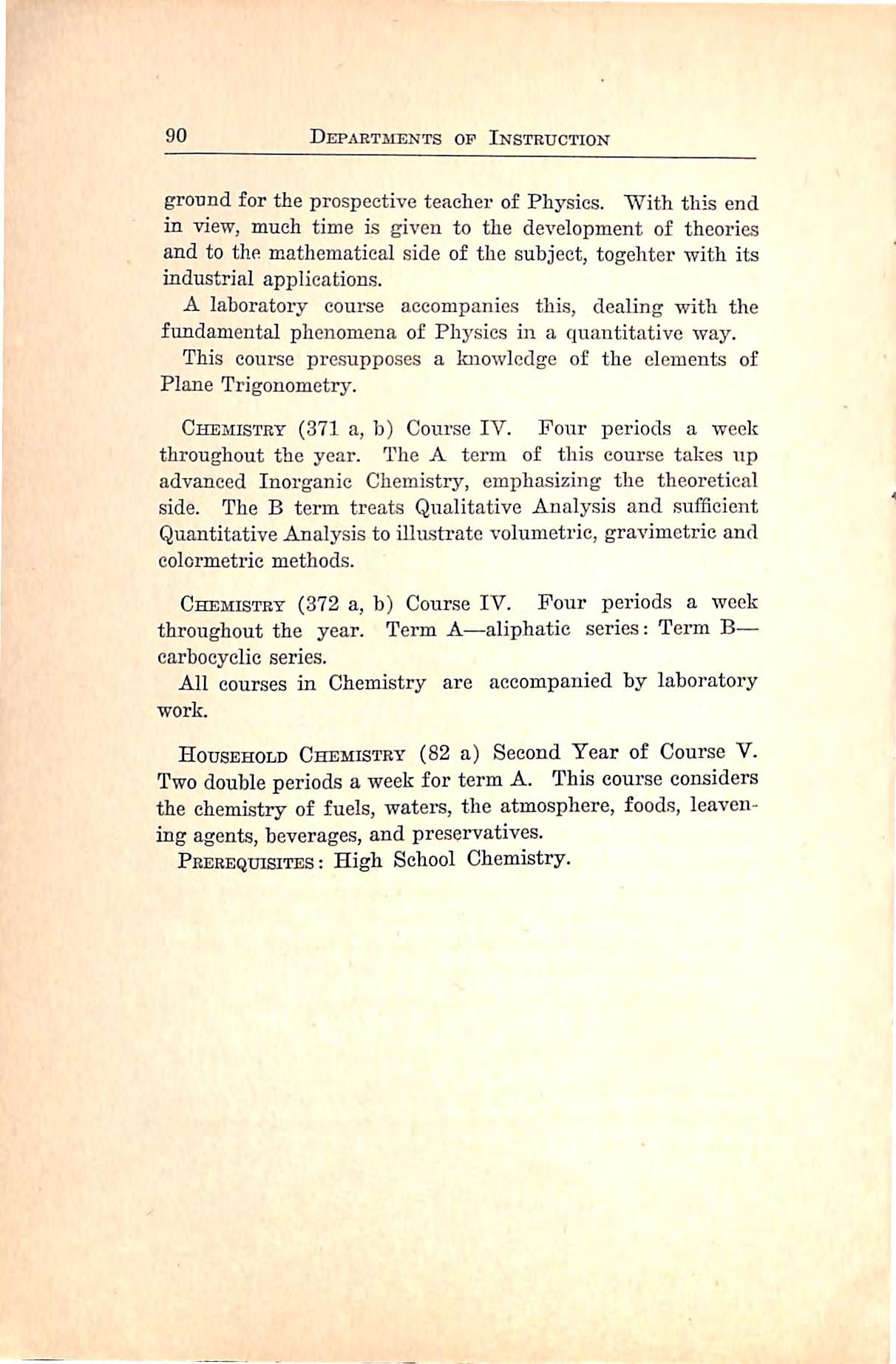
ground for the prospective teacher of Physics. "With this end in view, much time is given to the development of theories and to the mathematical side of the subject, togehter with its industrial applications.
A laboratory course accompanies this, dealing with the fundamental phenomena of Physics in a quantitative way. This course presupposes a knowledge of the elements of Plane Trigonometry.
Chemistry (371 a, b) Course I'V. Four periods a week throughout the year. The A term of this course takes up advanced Inorganic Chemistry, emphasizing the theoretical side. The B term treats Qualitative Analysis and sufficient Quantitative Analysis to illustrate volumetric, gravimetric and colormetricmethods.
Chemistry (372 a, b) Course IV. Pour periods a week throughout the year. Term A—aliphatic series: Term B— carbocyclic series.
All courses in Chemistry are accompanied by laboratory work.
Household Chemistry (82 a) Second Tear of Course V. Two double periods a week for term A. This course considers the chemistry of fuels, waters, the atmosphere, foods, leaven ing agents, beverages, and preservatives.
Prerequisites: High School Chemistry.

Elementary Biology,Advanced Biology, Hygiene and Sanitation,Nature
MK. EASON, MR. MASON, MISS BARTO
In this department courses are provided for students entering the regular work and for students wishing to special ize in this department to fit themselves for teaching the bio logical sciences.
Tlie aim of the work isto develop interestin nature and to acquire habits of accurate observation, exact statement, and independent thought. It is believed that the study of living organisms, their structure, activities, and relations, will give the student a broader and deeper appreciation of all life, while a scientific viewpoint is essential for the solving of many oftheproblemswhich confrontthe public-schoolteacher.This training will better fit her to inspire and direct the spirit of observation and investigation in her pupils, thus carrying into the public schools principles of accuracy and thoughtful inquiry, in addition to a broader love for nature and an interestin thelife-processessurrounding us.
The laboratory is equipped with Bausch and Lomb com pound microscopes, black-topped tables, and an aquarium with flowing water, besides various glass aquaria, chemicals, glassware, instruments, prepared slides, material for the pre servation and mounting of specimens, charts of the human body, plaster easts of the eye and ear, and a limited number of museum specimens—the nucleus of a museum which will grow from year to year.
The High School and Professional Courses offered by this department are as follows:
ElementaryBiology(90a,b)Second Year, Two double and two single periods a week throughout the year. This
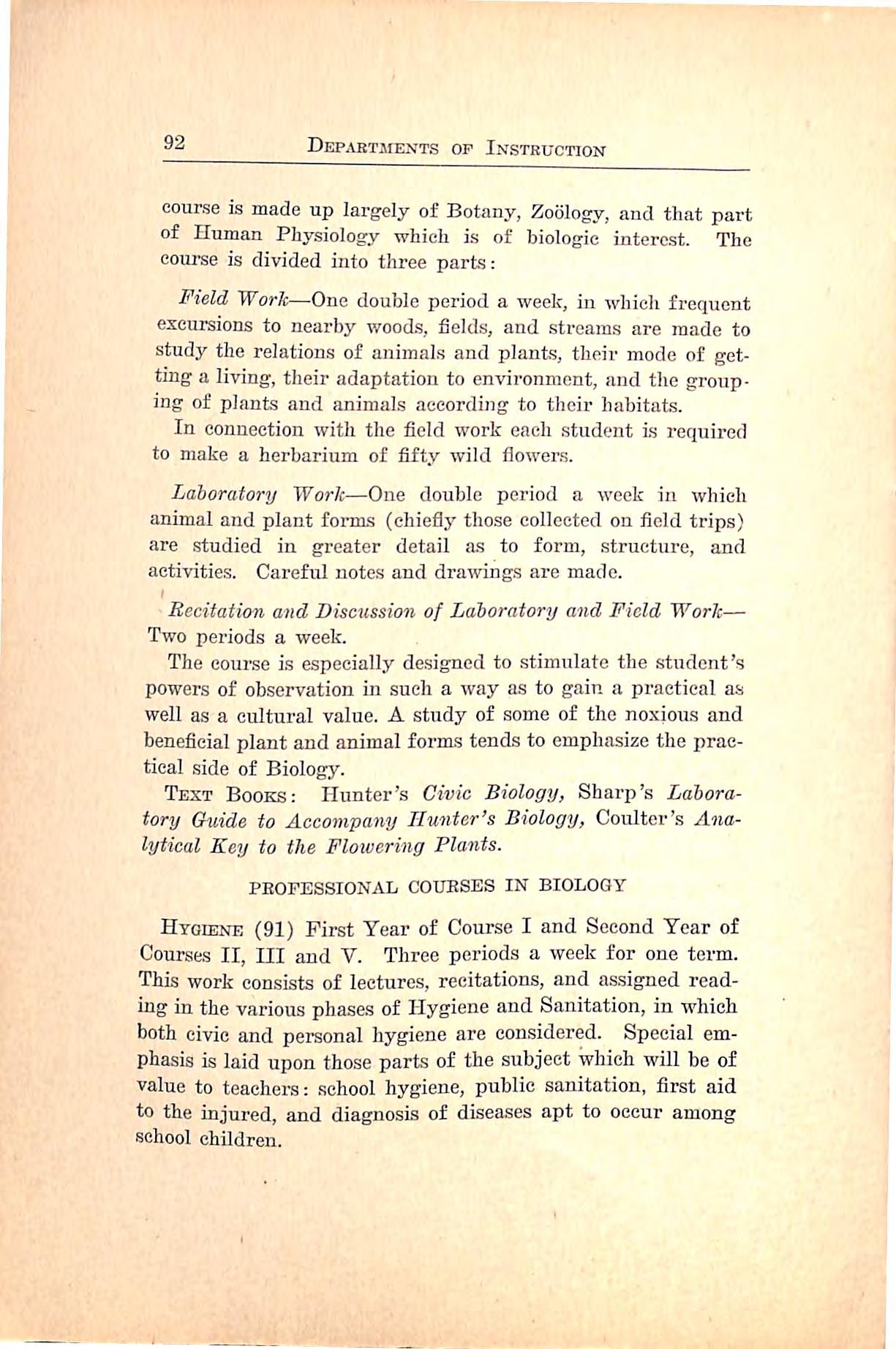
course is made up largely of Botany, Zoology, and that part of Human Physiology which is of biologic interest. The course is divided into three parts:
Field Work—One double period a week, in which frequent excursions to nearby woods, fields, and streams are made to study the relations of animals and plants, their mode of get ting a living, their adaptation to environment, and the group ing of plants and animals according to their habitats.
In connection with the field work each student is required to make a herbarium of fifty wild flowers.
Laboratory Work—One double period a week in which animal and plant forms (chiefly those collected on field trips) are studied in greater detail as to form, structure, and activities. Careful notes and drawings are made.
I Recitation and Discussion ofLaboratory and Field Work— Two periods a week.
The course is especially designed to stimulate the student's powers of observation in such a way as to gain a practical as well as a cultural value. A study of some of the noxious and beneficial plant and animalforms tends to emphasize the prac tical side of Biology.
Text Books: Hunter's Civic Biology, Sharp's Labora tory Guide to Accompany Hunter's Biology, Coulter's Ana lytical Key to the Flowering Plants.
Hygiene (91) First Year of Course I and Second Year of Courses II, III and V. Three periods a week for one term. This work consists oflectures,recitations,and assigned read ing in the various phases of Hygiene and Sanitation,in which both civic and personal hygiene are considered. Special em phasis is laid upon those parts of the subject which will be of value to teachers: school hygiene, public sanitation, first aid to the injured, and diagnosis of diseases apt to occur among school children.
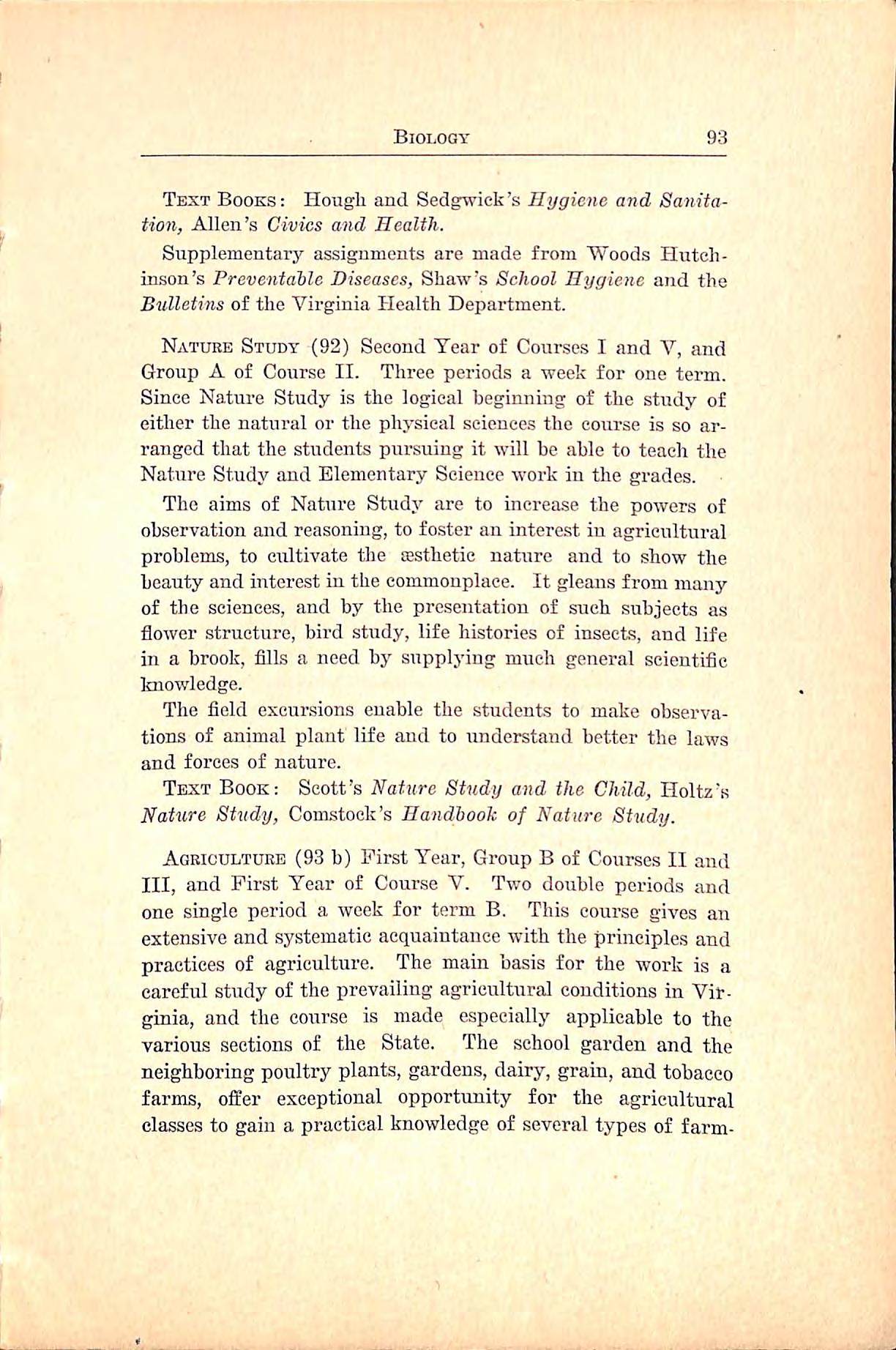
TestBooks: Hough and Sedgwick's Hygiene and Sanita tion,Allen's Civics and Health.
Supplementary assignments are made from Woods Hutchinson's Preventahle Diseases,Shaw's School Hygiene and the Bulletinsofthe Virginia Health Department.
NatureStudy(92)Second Year of CoursesI and V,and Group A of Course II. Three periods a week for one term. Since Nature Study is the logical beginning of the study of either the natural or the physical sciences the course is so ar ranged that the students pursuing it will be able to teach the Nature Studyand Elementary Science workin the grades.
The aims of Nature Study are to increase the powers of observation and reasoning, to foster an interest in agricultural problems,to cultivate the esthetic nature and to show the beauty and interest in the commonplace. It gleans from many of the sciences, and by the presentation of such subjects as flower structure, bird study, life histories of insects, and life in a brook, fills a need by supplying much general scientific knowledge.
The field excursions enable the students to make observa tions of animal plant life and to understand better the laws andforcesofnature.
Text Book: Scott's Nature Study and the Child, Holtz's Nature Study, Comstock's Handbook of Nature Study.
Agriculture (93 b) First Year, Group B of Courses II and III, and First Year of Course V. Two double periods and one single period a week for term B. This course gives an extensive and systematic acquaintance with the principles and practices of agriculture. The main basis for the work is a careful study of the prevailing agricultural conditions in Vir ginia, and the course is made especially applicable to the various sections of the State. The school garden and the neighboring poultry plants, gardens, dairy, grain, and tobacco farms, offer exceptional opportunity for the agricultural classes to gain a practical knowledge of several types of farm-

ing. The following subjects suggest the line of work: Soils (types, drainage, fertilizers, etc.); Plant Production (farm crops, gardening, weeds, etc.); Animal Husbandry (dairying, poultry, etc.); Horticulture j Farm Mechanics, etc.
By constant use of the Farmers'Bullciiiis and other mate rial sent out by the Agricultural College at Blacksburg and the District Agricultural Schools and by occasional addresses from the Farm Demonstrators and Instructors from the abovenamed places,the studentsare broughtinto closer touch with the agricultural problems of the State and the best means of coping with them.
Text Book: Warren's Elements of Agriciilture.
Agriculture (94 a) Second Tear, Group B of Course III. Two double periodsand onesingle period a weekforterm A. A continuation of Agriculture (93 b).
Prerequisite: Agriculture (93 b).
Text Book: Warren's Elements of Agriculture.
AnimalHusb.vndrt(95a)Second Yearof Course V.Two double and one single period a week for term A. This course is particularly concerned with the raising and marketing of poultry and eggs. However, considerable attention is given to selection and raising of hogs and cows and other domestic animals. Attention is given to good and profitable rations, method of housing, selection from the standpoint of market value, location of markets, etc., breeding, etc., Excursions are made to near-by poultry plants and stock farms.
Introduction to Gener^vl Science (380 b) First Year of Course IV. Four periods a week for term B. This course takes up the elements of heat, light, electricity, mechanics, etc., with a view of bringing out the bearing of science upon practical every-day life. The correlation of the various sci ences with each other and the application to Physical Geog raphy is developed.
Advanced Biology (381 a, b) Course IV. Two double periods a week for laboratory work and field excursions and
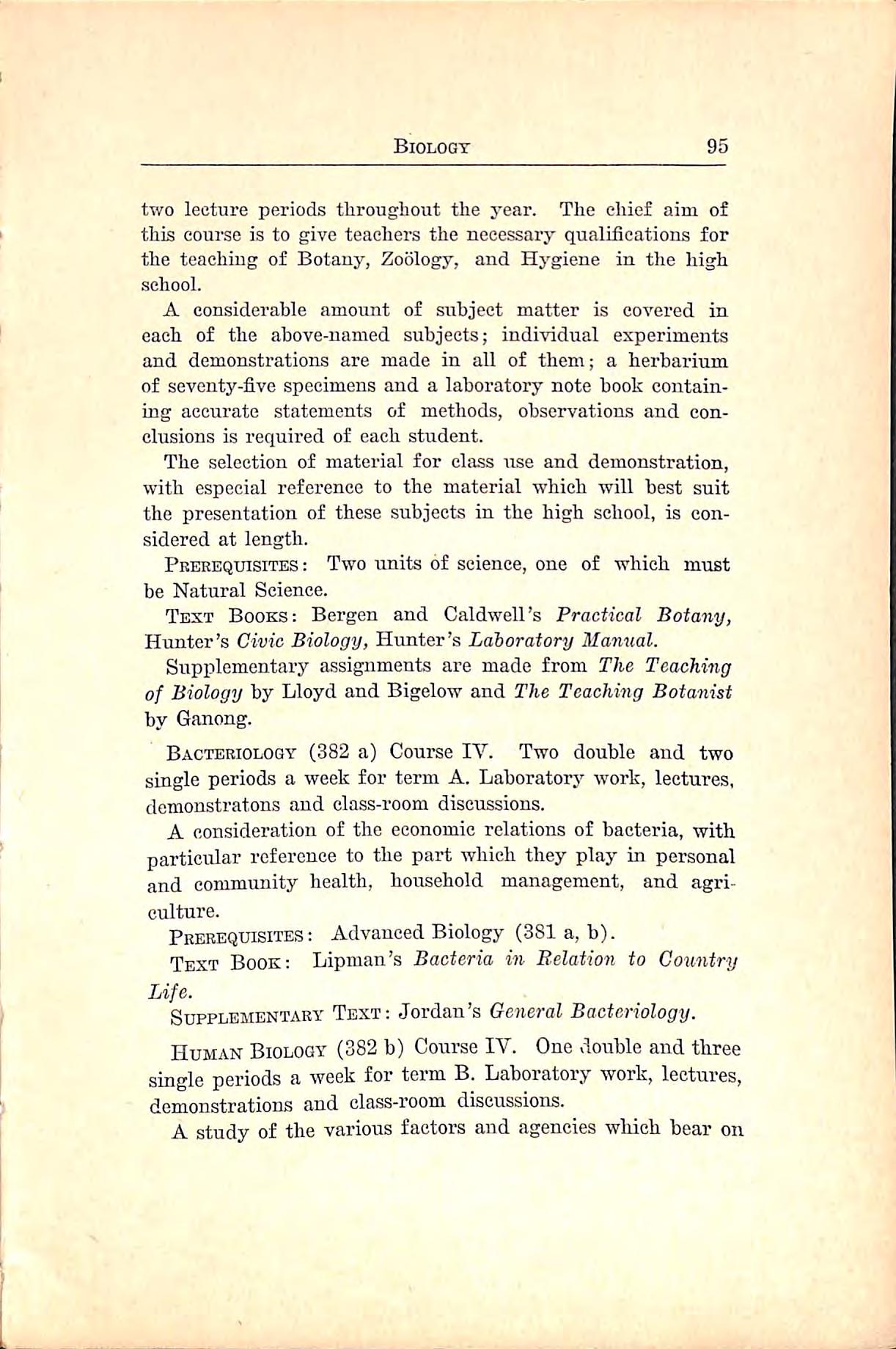
two lecture periods tliroughout the year. The chief aim of this course is to give teachers the necessary qualifications for the teaching of Botany, Zoology, and Hygiene in tlie high school.
A considerable amount of subject matter is covered in each of the above-named subjects; individual experiments and demonstrations are made in all of them; a herbarium of seventy-five specimens and a laboratory note book contain ing accurate statements of methods, observations and con clusions is required of each student.
The selection of material for class use and demonstration, with especial reference to the material which will best suit the presentation of these subjects in the high school,is con sidered at length.
Prerequisites: Two units of science, one of which must beNaturalScience.
Text Books: Bergen and CaldwelPs Traciical Botany, Hunter's Civic Biology,Hunter's Laboratory Manual.
Supplementary assignments are made from The Teaching of Biology by Lloyd and Bigelow and The Teaching Botanist by Ganong.
Bacteriology (382 a) Course IV. Two double and two single periods a week for term A. Laboratory'- work, lectures, dcmonstratons and class-room discussions.
A consideration of the economic relations of bacteria, with particular reference to the part which they play in personal and community health, household management, and agri culture.
Prereqxhsites: Advanced Biology (381 a, b).
Text Book: Lipman's Bacteria in Relation to Country Life.
Supplementary Text: Jordan's General Bacteriology.
Human Biology (382 b) Course lY. One double and three single periods a week for term B. Laboratory work, lectures, demonstrations and class-room discussions.
A study of the various factors and agencies which bear on
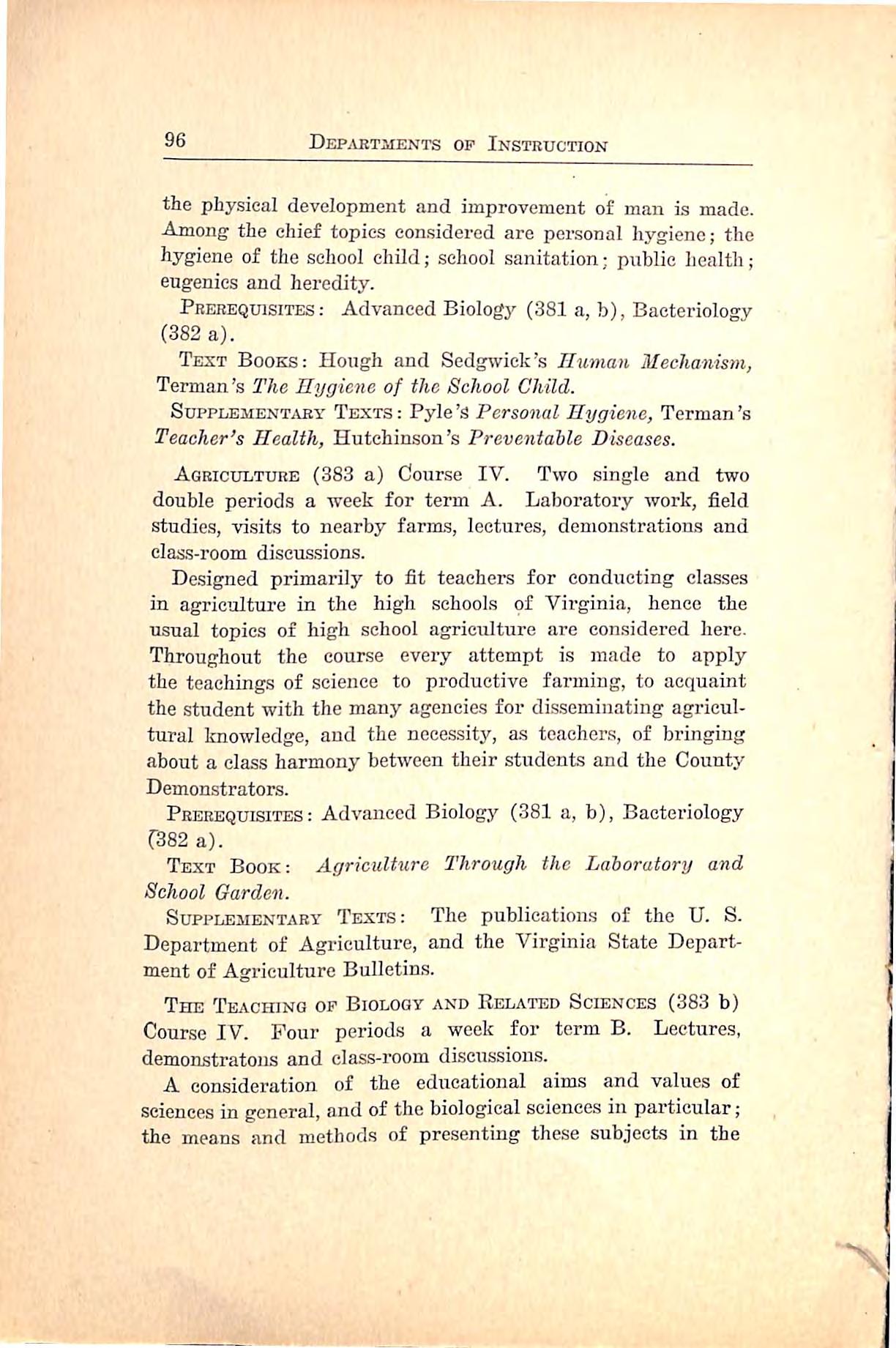
the physical development and improvement of man is made. Among the chief topics considered are personal hygiene; the hygiene of the school child; school sanitation; public health; eugenics and heredity.
Prerequisites: Advanced Biology (381 a, b),Bacteriology (382a).
Text Books: Hough and Sedgwick's Human Mecliamsm, Terman's The Hygiene of the School Child,
SupPLEMENT^VRY Texts:Pylc'sPersonalHygiene,Terman's Teacher's Health,Hutchinson's Preventable Diseases.
Agriculture (383 a) Course IV. Two single and two double periods a week for term A. Laboratory work,field studies, visits to nearby farms, lectures, demonstrations and class-roomdiscussions.
Designed primarily to fit teachers for conducting classes in agriculture in the high schools of Virginia, hence the usual topics of high school agriculture are considered here. Throughout the course every attempt is made to apply the teachings of science to productive farming, to acquaint the student with the many agencies for disseminating agricul tural knowledge, and the necessity, as teachers, of bringing aboutaclassharmony between theirstudentsand the County Demonstrators.
Prerequisites: Advanced Biology (381 a, b). Bacteriology r382a).
Text Book: Agriculture Through the Laboratory and SchoolGarden.
Supplementary Texts: The publications of the U. S. Department of Agriculture, and the Virginia State Depart ment of Agriculture Bulletins.
The Teaching of Biology and Related Sciences (383 b) Course IV. Four periods a week for term B. Lectures, demonstratons and class-room discussions.
A consideration of the educational aims and values of sciences in general, and of the biological sciences in particular; the means and methods of presenting these subjects in the

later year of tlie grammar school and in all of the years of the high school organization of courses of study in Introduc tion to Science, Elementary Biology, Botany, Zoology, Hygiene, and Agriculture; planning, equipping and maintaining a laboratory; collecting and preserving material for study.
PREREQtnsiTES:Advanced Biology (3S1 a, b),Bacteriology 382 a), Human Biology (3S2 b), and Agriculture (383 a).
Text Books:Lloyd and Bigelow's The Teaching of Biology, McMurray's Teaching of Elementary Science. Supplement^uryTexts:TLwcameVBMaterialandMethods in Agriculture, Ganong's The Teaching Botanist.

Geography is one of the great culture studies of the comraon schools. Its special task is to carry the pupil out of the narrow bounds of his home, to dignify his life by making it partofthe greatlife of mankind. Beginning with observation of the known,it cultivates the imagination by transferring the knowledge thus gained to the comprehension of the un known. The moral effect upon the pupil in thus coming into harmony with the world in which he lives is notless valuable than the training of the faculties of observation, comparison, and judgment which this study,if properly taught,so richly supplies. The aini of the work in the Department of Geog raphy is three-fold:
First, to train the mind of the student to observe closely and accurately the world in which we live, to note the forces at work moulding its surface and fitting it to be the home of man,and toreason accuratelyuponthe phenomena presented byobservation,alwaystracingthe relation between cause and effect.
Second;by the fullest possible presentation of the races of mankind, their homes, industries, and habits, to lead the stu dent to wider s;5Tnpathies and broader views. The process of tracing the relation between geographical conditions and life responses is a mental discipline of the highest value.
Third, to prepare the student to teach the subject in the commonschools.
Commercial Geography treats of the conditions of interde pendence among the civilized nations of the eai'th. It studies industrial progress, and the influence on _this progress exer cised by climate, topogi'aphy, social conditions, manufacturing and transportation facilities, and financial conditions. The United States is studied in detail.
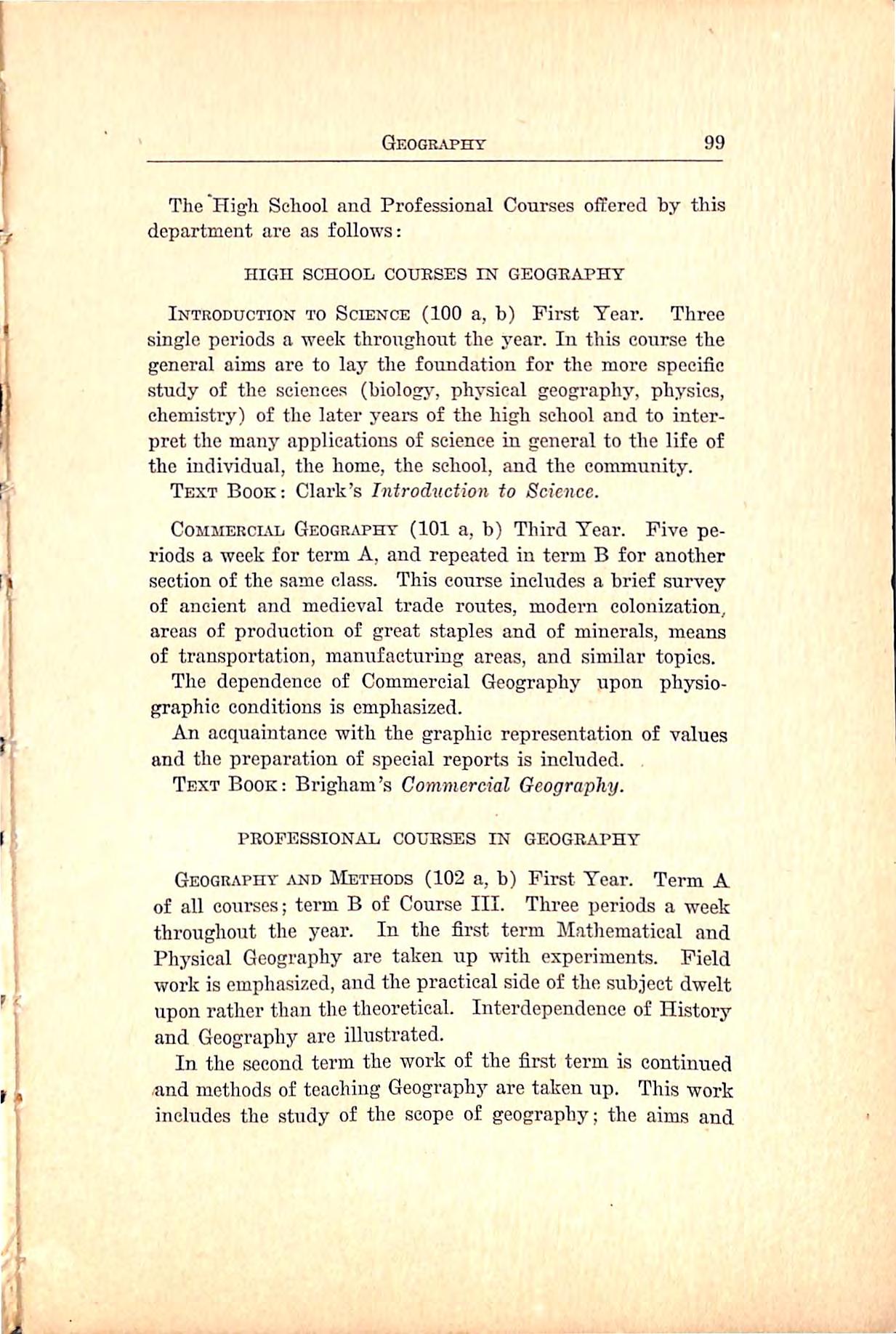
The Higli School and Professional Conrees offered by this department are as follows:
HIGH SCHOOL COUESES EST GEOGEAPHT
Introduction to Science (100 a,b) First Year. Three single periods a week throughout the year.In this course the general aims are to lay the foundation for the more specific study of the sciences (biologj', physical geography, physics, chemistry) of the later years of the high school and to inter pretthe many applications of science in general tothe life of the individual, the home,the school, and the community.
TextBook:Clark'sIntroductiontoScience.
CoMMERCLVL GEOGRAPHY (101 a,b)Third Year. Five pe riods a weekfor term A,and repeated in term B for another section ofthesameclass. Thiscourseincludesa briefsurvey of ancient and medieval trade routes, modern colonization, areas of production of great staples and of minerals, means of transportation, manufacturing areas, and similar topics.
The dependence of Commercial Geography upon physio graphic conditionsis emphasized.
An acquaintance with the graphic representation of values and the preparation of special reports is included.
Text Book: Brigham's Commercial Geography.
PROFESSIONAL COLTISES IN GEOGRAPHY
Geography and Methods(102 a,b) First Year. Term A of all courses; term B of Course III. Thi*ee periods a week throughout the year. In the first term Mathematical and Physical Geography are taken up with experiments. Field work is emphasized,and the practical side of the subject dwelt upon rather than the theoretical. Interdependence of History and Geography are illustrated.
In the second term the work of the first term is continued /and methodsofteaching Geography aretaken up. This work includes the study of the scope of geography; the aims and

DepartmentsopInstruction
contents of geography for the various grades: correlation withothersubjects,mapreadingand map making;text-books, and supplementary materials.
TextBook:Salisbuiy,Barrow and Tower'sModern Geog raphy.
TheInfluenceop Geographyon American History (390 b) Course IV. Four periods a week for term B. This course includes a study of the geographic conditions that have influenced American history and is offered for students ofgeographyandhistory.Afamiliaritywiththefundamental principles of geography and the main facts of American history is presupposed. Open to third and fourth year students.
Political Geography (391 b) Course IV. Four periods aweekfortermB.Thiscourseincludesatreatmentofthe development of nations as determined by geographic con ditions, and of the commercial and political relations be tween nations and is of special value to the student of Modern European History. Open to third and fourth year students.
Prerequisite: Geography (102 a), or its equivalent.
Geology (392 b) Course IV. Pour periods a week for term B. This course includes a study of the geological pro cesses and their relation to life; brief treatment of the most important phases of structural and historical geology; prac tice in reading and interpreting topographic maps; field excursions. Open to third and fourth year students.
Prerequisite: Geography (102 a), or its equivalent.
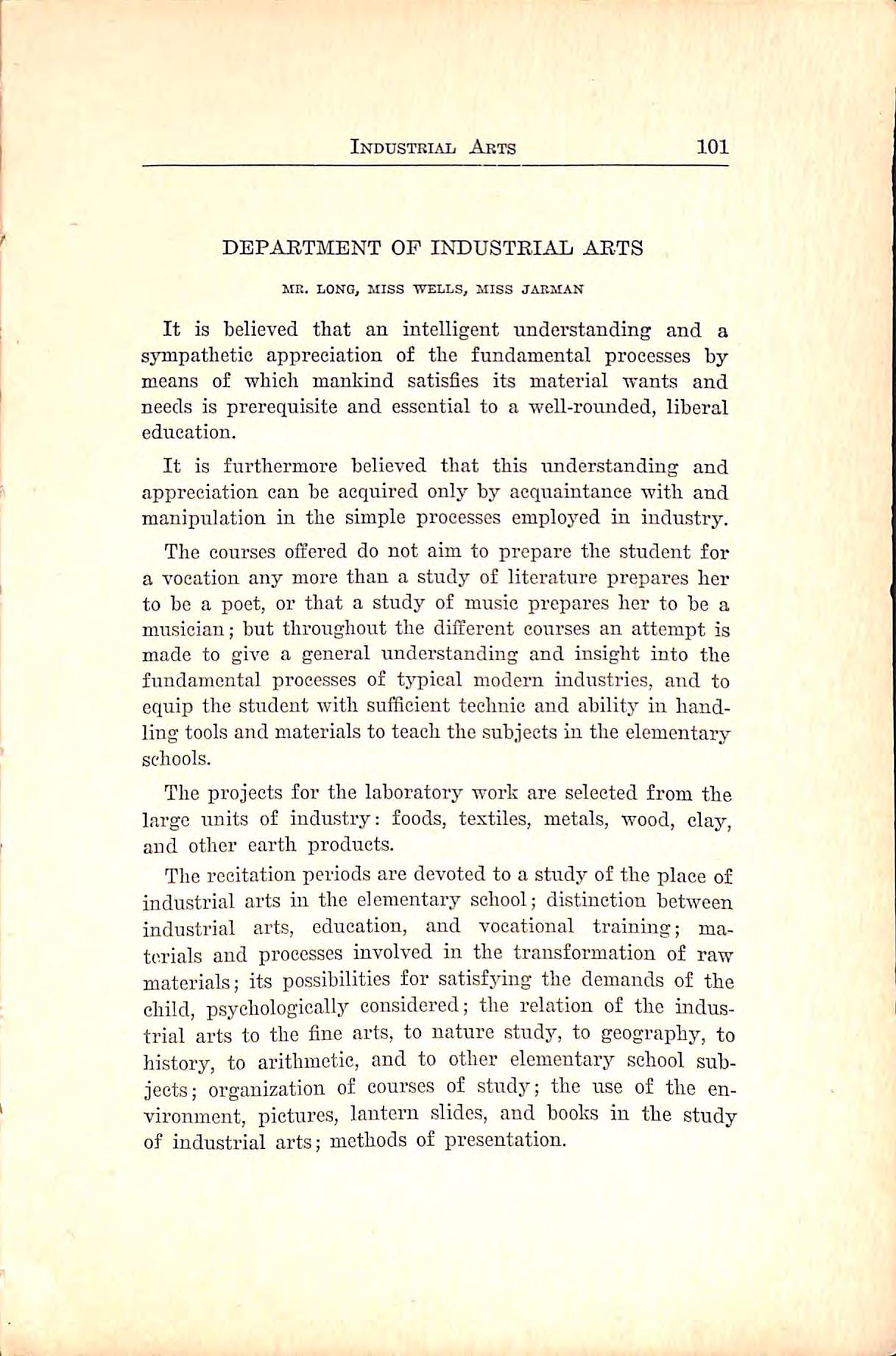
It is believed that an intelligent understanding and a sympathetic appreciation of the fundamental processes by meansof"whielimankindsatisfiesitsmaterialwantsand needs is prerequisite and essential to a "well-rounded, liberal education.
It is furthermore believed that this understanding and appreciation can be acquired only by acquaintance "with and manipulation in the simple processes employed in industry.
The courses offered do not aim to prepare the student for a vocation any more than a study of literature prepares her to be a poet, or that a study of music prepares her to be a musician; but throughout the different courses an attempt is made to give a general understanding and insight into the fundamental processes of typical modern industries, and to equip the student with sufficient technic and ability in hand ling tools and materials to teach the subjects in the elementary schools.
The projects for the laboratory work are selected from the large units of industry: foods, textiles, metals, wood, clay, and other earth products.
Therecitation periodsare devoted toastudyofthe place of industrial arts in the elementary school; distinction between industrial arts, education, and vocational training; ma terials and processes involved in the transformation of raw materials; its possibilities for satisfying the demands of the child, psychologically considered; the relation of the indus trial arts to the fine arts, to nature study, to geography, to history, to arithmetic, and to other elementary school sub jects; organization of courses of study; the use of the en vironment, pictures, lantern slides, and books in the study of industrial arts; methods of presentation.

The High School and Professional courses offered by this department are as follows:
Industrial Arts (110 a, b) Second Year. Two double periods each week throughout the year. This is a course in household mechanics, and consists of such projects as the fol lowing: repairing furniture, gluing, upholstering, paint ing, varnishing, staining, soldering, picture framing, mend ing utensils, and the construction of simple projects, such as waste baskets, taborets, window boxes, etc. The purpose of this course is to acquaint students with the tools, materials, and technic of making and repairing simple things about the house.
Laboratory Fee: One dollar each term.
Industrial Arts (111 a, b) Fourth Year. Two double laboratory periods a week throughout the year. This course consists of projects in paper, wood, clay, textiles, and metals; the elements of mechanical drawing; the application of de sign to projects; readings and discussions.
Theaimofthiscourseistosecureforthestudentanin telligent understanding of, and ability in handling, the tools and materialsthat are employedin the work,and to give an elementary knowledge of processes of manufacture. The projects are selected from the following list: simplex note book, portfolio with pockets, small commercial book, hand kerchief or glove box, desk set, picture frame, simple furni ture, simple pottery—hand-made pieces, molding in plaster of paris forms, simple projects in weaving, copper bowl or tray, etc.
Laboratory Fee: One dollar each term.
Industrlvl Arts (112 a) First Year of all courses. One double laboratory period and one single recitation period each weekfortermA.

Group I. An advanced coiu'se for all those who have had Industrial Arts (111). It is largely a continuation of In dustrial Arts (111) with more advanced projects. The reci tation period consists of class discussions and required read ings. The aim is to establish a point of view and under standing of the meaning of industrial arts education and the place it should occupy in the school curriculum.
Text Books: Cole's Industrial Arts for the Elementary School. Bonser and Russell's Industrial Education, and Dewey's Schools of To-morrow.
Laboratory Fee: One dollar each term.
Group II. This is an abbreviated form of Industrial Arts (111)for those who have had no work of this nature and are not prepared to enter Group I.
The recitation period covers the same ground as Group I.
Laboratory Pee: One dollar each term.
Industrial Arts (113 b) First Year of Course II. One double laboratory period and one single recitation period each week for term B. This course is arranged for those students who expect to teach in the primary grades. The aim is to work out such type projects as may be suitable for primary grades. The projects are selectedfrom tlie large units men tioned above. By means of excursions, readings, pictures, and lantern slides, a study is made of typical modem in dustries and processes of manufacture.
Text Books: The same as Industrial Arts (112).
Laboratory Pee: One dollar each term.
IndustrlvlArts(114b)First Year Group A of Course III. One doublelaboratory period and one single recitation period per week for term B. This course is arranged for those students who expect to teach in grammar grades. Such projects are selected and worked out as may be used in the grammar grades. In this, as in all other courses,the relation betweenIndustrial Artsand othersubjectsis pointed outand

discussed. A study is made of typical modern industries and processes of manufacturing.
Text Books: The same as Industrial Arts (112).
Laboratory Fee: One dollar each term.
Industrial Arts (115 b) First Year Group B of Course
III. One double laboratory period and one single recitation period per week for term B. This course is arranged for those students who expect to teach in rural schools. The projects are such as may be practically worked out in a rural com munity with small equipment and are selected from the fol lowing: bird house, dog kennel, flower box, iceless refrigerator, firelcss cooker, poultry house, laying concrete sidewallc, simple repairing and mending of furniture, utensils, etc.
TextBooks: The same as Industrial Arts (112).
Laboratory Fee: One dollar per term.
Types of Industry (116 b) First Tear of Course V. Three periods a week for term B. This course gives a rudimentaiy knowledge of, and an insight into, the processes of manufac ture, and industries represented in and around the average home. The industrial phases receiving chief emphasis are such as the following: the qualities and structure of silk, woolen,cotton, and linen and mixed fabrics, dyes and methods of home dyeing; the distinction and recognition of the differ ent common woods and their appropriate uses in furniture, implements, and devices about the home and on the farm, and furniture from the standpoint of construction, finish, utility, and service; simple construction of rolling dish trays, fireless cookers, iceless refrigerators and labor saving devices, chairs, tables, egg cartons and carriers, poultry coops and crates, model brooder houses and poultry houses; different paints and finishes and how to use them; simple upholstery, etc.
I and II. Two single periods a week for one term. The aim of this course is to give an intelligent and inquiring attitude towards industrial work in the elementary school system, a

tangible basis for selection of subject matter for primarygrades, and methods of teaching it. The work has special reference to the problems of Grades I,II,III,and IV. The course also aims to enable the students to acquire skill in andstandardsfordoingtheindustrialworksuited to primarygrades. The following topics are considered: a general sur vey of industrial phases of present-day education; the relative place and educative value of this work in the lower grades; problems of subject matter in relation to en-sdronment, child interests, and other subjects of the curriculum; method with emphasis placed upon self-direction. Much of this work is accompanied by and based upon observation in the Training School. Students do as much practical work astime permits.
IndustelvlArts(118)Second Year Group A of Course
III. One double and one single period per week for one term. This course is a continuation of Industrial Arts (114 b) and bears directly upon the problems in the grammar grades; modern principles xuiderlying organization of industrial arts in the elementary school; organization of courses of study showing relations with other subjects in the curriculum; methods of study and presentation of Industrial Arts; use of en-vironment, pictures, etc.; and observation and directed teaching in the Training School.
IndustrlvlArts(119a) Second Year Group B of Course
III. One double laboratory period and one single recitation period per week for term A. This course is a continuation of Industrial Arts (115 b). The projects are selected from a similar field,and sequence is considered as far as practicable. Throughout the course emphasis is laid upon a study of rural needs and the construction of such projects as are practical and applicable to rural conditions.
Type Forms op Industry (120 a) Second Year of Course
V. Three double periods a week for term B. This course is based on types of Industry (116 b) and to some extent is a continuation of the same. Especial emphasis is placed upon

such, subjects as plumbing and the installation of simple electric lighting plants, where to look for trouble with the telephone, with a stove that will not draw, how to repair broken utensils, how to sharpen tools, how to install a milk tester, how to build a small canning factory for the home, how to hang wall paper, etc.

MISS COTTLLING
The purpose of the work in drawing is to train the powers of obseiwation,secure some degree of skill in expression, de velop originality, and cultivate an appreciation of the beau tiful.
In the First Year Professional two courses in drawing are offered, (123 a, b) followed in the Second Year by (127), and (124 a and 125 b, or 126 b) followed in the Second Year by (128 or 129). Drawing (123 a, b) is provided for those stu dents who wish to prepare to supervise drawing in the public schools,and may be taken by any student who has had drawing (121 a, b and 122 a, b) or the equivalent. Drawing (124 a, with 125b or126b)isa beginner'scourse,and is forstudents who have not had previous training in drawing. A student who has had drawing(121 a,b and 122a,b)and doesnotwish totake drawing (123 a,b) must substitute an equivalent number of periods chosen from the Third and Fourth Year electives not already taken.
The High School and Professional courses offered by this department are as follows:
Drawing (120 a, b) First Year. Two periods a week throughout the year. A general course in freehand and me chanical drawing, design color, and some lessons in msthetic appreciation.
Nature drawing in the fall and spring. Design units de veloped from nature motives, and applied to cushion top, curtain border, or other definite end; bowl and vase designed, colored, studied as to its use as a decorative object and re ceptacle for flowers; posters and book covers for lettering, decoration, color; study of some of the famous pictures with lessons in selecting, framing, and hanging pictures; copying
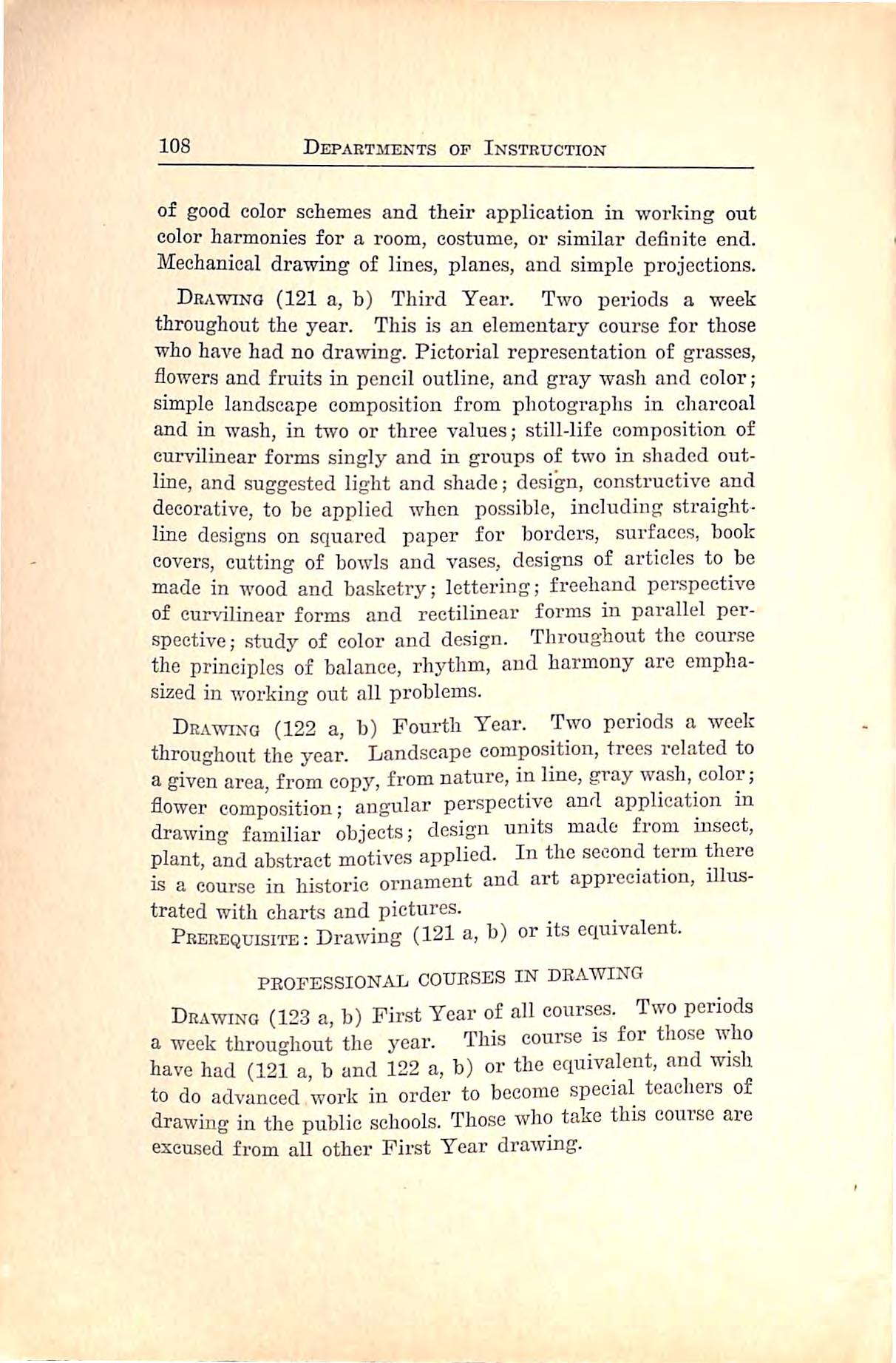
of good color schemes and their application in working out color harmonies for a room, costume, or similar definite end. Mechanical drawing of lines, planes, and simple projections.
Drawing (121 a, b) Third Year. Two periods a week throughout the year. This is an elementary course for those whohave had no drawing.Pictorialrepresentation of grasses, flowers and fruits in pencil outline, and gray wash and color; simple landscape composition from photographs in charcoal and in wash,in two or three values;still-life composition of curvilinearformssingly and in groupsoftwo in shaded out line, and suggested light and shade; design, constructive and decorative, to be applied when possible, including straightline designs on squared paper for borders, surfaces, book covers, cutting of bowls and vases, designs of articles to be made in wood and basketry; lettering; freehand perspective of curvilinear forms and rectilinear forms in parallel per spective; study of color and design. Throughout the course the principles of balance, rhythm, and harmony are empha sised in working out all problems.
Drawing (122 a, b) Fourth Year. Two periods a week throughout the year. Landscape composition, trees related to a given area,from copy,from nature,in line, gray wash, color; flower composition; angular perspective and application in drawing familiar objects; design units made from insect, plant, and abstract motives applied. In the second term there is a course in historic ornament and art appreciation, illus trated with charts and pictures.
Prerequisite:Drawing (121 a,b) or its equivalent.
Drawing (123 a, b) First Tear of all courses. Two periods a week throughout the year. This course is for those w lo have had (121 a, b and 122 a, b) or the equivalent, and wish to do advanced work in order to become special teachers of drawing in the public schools. Those who take this course are excused from all other First Year drawing.
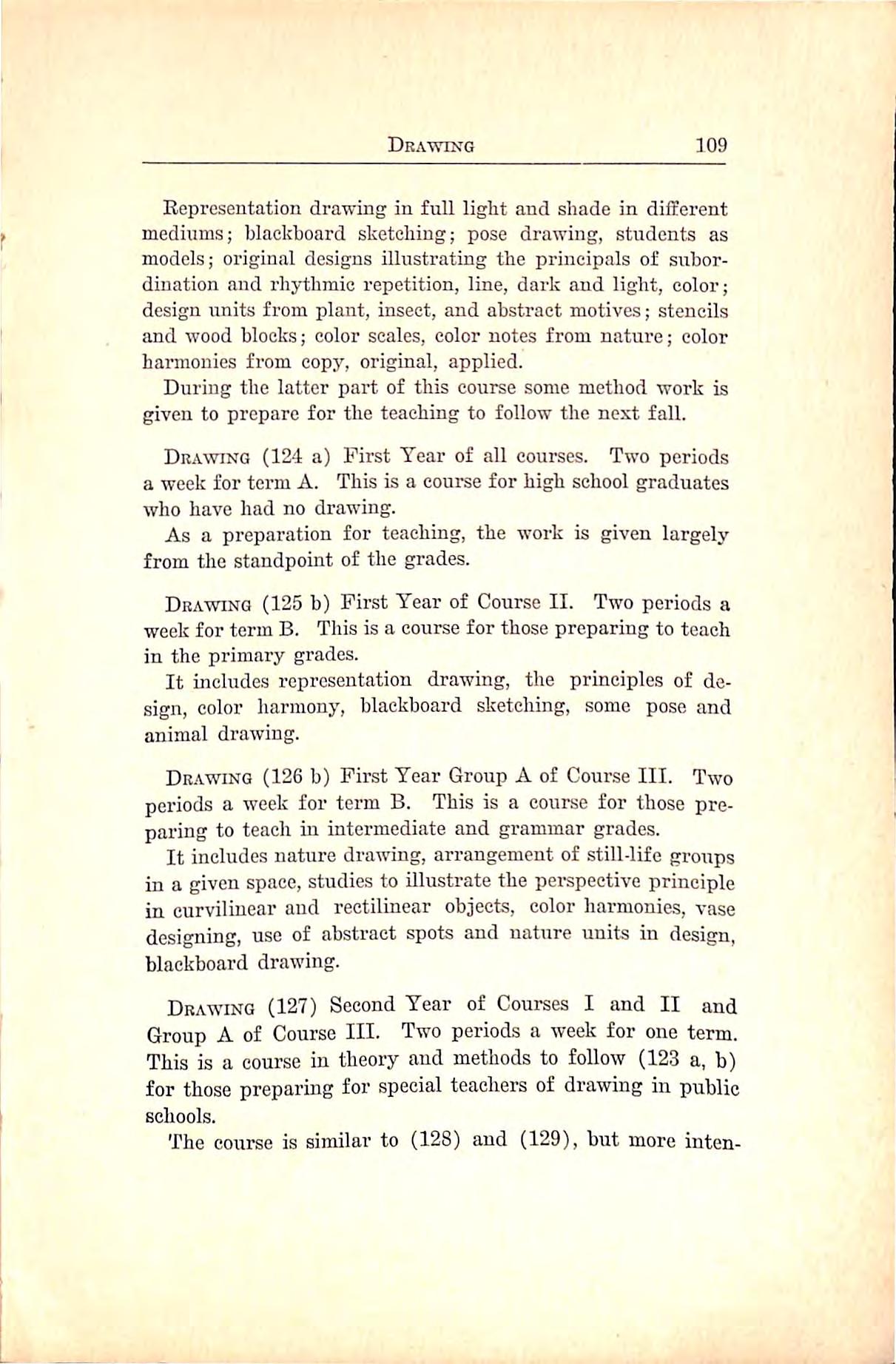
Representation drawingin fulllight and shade in different mediums; blackboard sketching; pose drawing, students as models; original designs illustrating the principals of subor dination and rhythmic repetition, line, dark and light, color; design unitsfrom plant,insect,and abstract motives;stencils and wood blocks; color scales, color notes from nature; color harmonies from copy, original, applied.
During the latter part of this course some method work is given to prepare for the teaching to follow the next fall.
Drawing (124 a) First Year of all courses. Two periods a weekfor term A. Thisisa coui'sefor high school graduates who have had no drawing.
As a preparation for teaching, the work is given largely from the standpointofthe grades.
Drawing (125 b) First Tear of Course II. Two periods a week for term B. This is a course for those preparing to teach in the primary grades.
It includes representation drawing, the principles of de sign, color harmony, blackboard sketching, some pose and animal drawing.
Drawing (126 b) First Year Group A of Course III. Two periods a week for term B. This is a course for those pre paring to teach in intermediate and grammar grades.
It includes nature drawing, arrangement of still-life groups in a given space,studies to illustrate the pei*spective principle in curvilinear and rectilinear objects, color harmonies,vase designing, use of abstract spots and nature units in design, blackboard drawing.
Drawing (127) Second Year of Courses I and II and Group A of Course III. Two periods a week for one term. This is a course in theory and methods to follow (123 a, b) for those preparing for special teachers of drawing In public schools.
The course is similar to (128) and (129),but more inten-

sive. Sargent's 3ow Children Learn to Draw is the basal text used. Othercourses are compared with this.
Students taking this course are given additional teaehing of drawing in several different grades.
Drawino(128) Second Year of Courses I and II. Two periods a week for one term. This course in methods of teaching drawing for those preparing to teach in the kinder garten and primary grades.
Sargent's 3oxv Children Learn to Draw is used as a guide in the study of courses of drawing. Different systems of drawingare examined critically,lesson plans written and dis cussed, and practice in drawing is continued throughout the course in relation to each topic under consideration.
Drawing (129) Second Tear Group A of Course III. Two periods a week for one term. This is a course in methods of teaehing drawing for those preparing to teach in the interme diateandgrammar grades.
Sargent's Hoiv Children Learn to Draw is used as a guide in planning courses of study. Sets of drawing books are ex amined carefully, and their relative values considered. With the workin methodsas much time as possible is given to con tinued practice in drawing.
Drawing (410 a) Course IV. Two periods a week for term A. This is a general course in art appreciation for those taking course IV. There will be the study of elementary com position and design, and pictorial composition. Many pictures will be used to illustrate the course, and students will keep a note book for preseiwation of drawings and pictures.
Drawing (411 b) Course IV. Two periods a week for term B. This course is planned for students taking science in Course IV. The purpose ofthe course is to teach the use of the black board for illustrative purposes. There is much blackboard drawdng,some pencilsketching,lettering,some color work.The topics considered are selected from the sciences the class is studying and adapted to special needs.
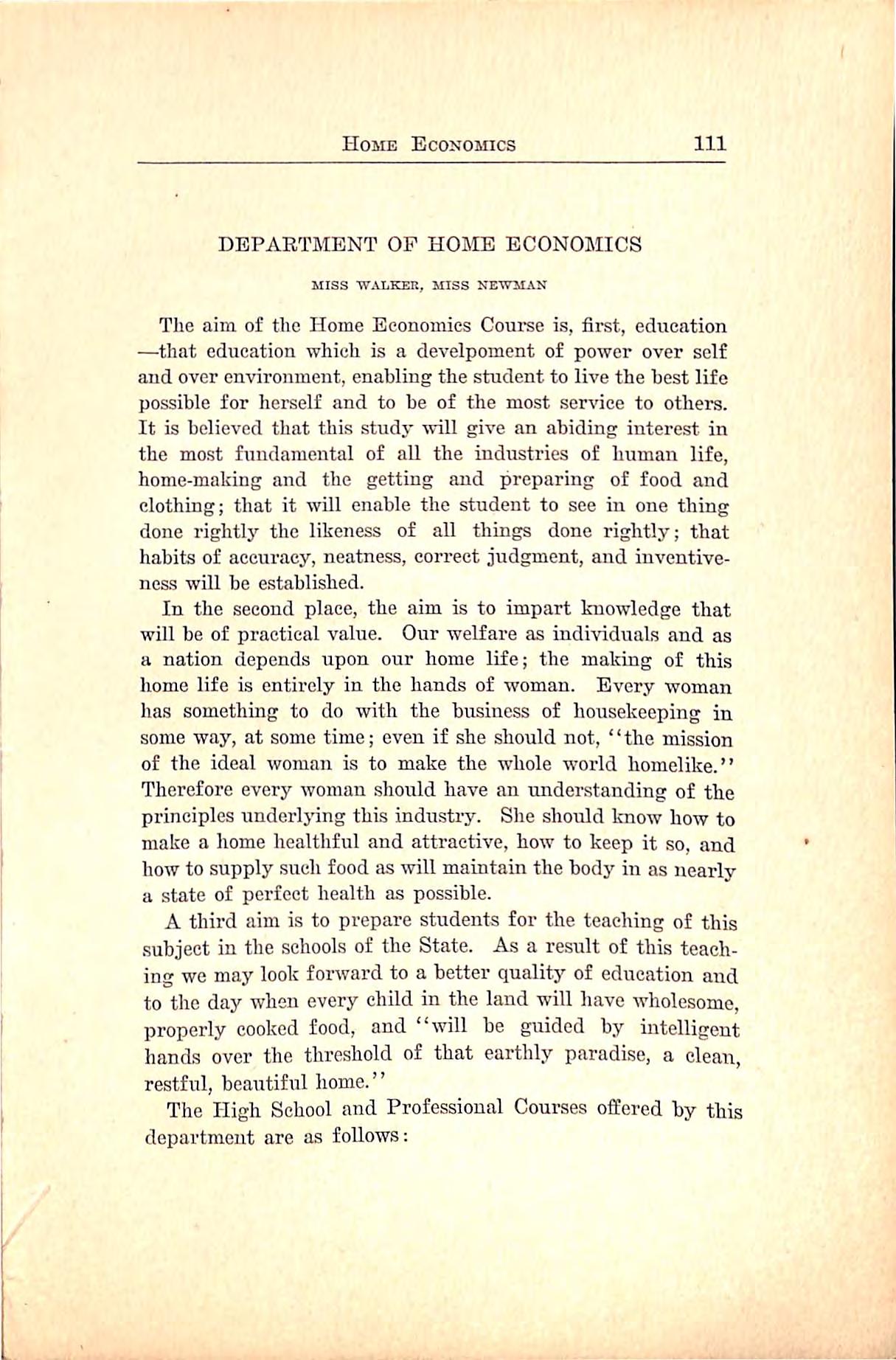
The aim of the Home Economies Course is,first, education —^that education which is a develpoment of power over self andoverenvironment,enablingthestudenttolivethe bestlife possible for herself and to be of the most serWce to others. It is believed that this study"will give an abiding interest in the most fundamental of all the industries of human life, home-making and the getting and preparing of food and clothing; that it will enable the student to see in one thing done rightly the likeness of all things done rightly; that habits of accuracy, neatness, correct judgment, and inventive nesswillbeestablished.
In the second place, the aim is to impart knowledge that will be of practical value. Our welfare as indmduals and as a nation depends upon our home life; the making of this home life is entirely in the hands of woman. Every woman has something to do with the business of housekeeping in some way,atsome time;even if she should not,"the mission of the ideal woman is to make the whole world homelike." Therefore every woman should have an undei-standing of the principles underlying this industry. Slie should Imow how to make a home healthful and attractive, how to keep it so, and how to supply such food as will maintain the body in as nearly a state of perfect health as possible.
A third aim is to prepare students for the teaching of this subject in the schools of the State. As a result of this teach ing we may look forward to a better quality of education and to the day when every child in the land will have wholesome, properly cooked food, and "will be guided by intelligent hands over the threshold of that earthly paradise, a clean, restful, beautiful home."
The High School and Professional Courses offered by this department are as foUows:

Home Economics (130 a, b) Third Year. Two double periods and one single period a week throughout the year. The work of this year comprises courses in Foods and Cook ery, and in Garment Making. The purpose of the work in Cookery is to give opportunity for practice in home cookery. The course includes a study of cereals, vegetables, fruits, soups,milk,eggs,meat,poultry,and candy;also the making of salads, desserts, and beverages.
The work in Garment Making includes a study of simple drafting, taking of measures, use and adaptation of com mercial patterns,use and purpose of clothing,selection of suitable materialsand designs,use ofsewing machine and its attachments. The laboratory work consists of the making of a suit of undergarments by hand and machine.
Laboratory fee for Cookery: Two dollars per term. Students supply their own materials for Sewing.
Home Economics (131 a, b) Fourth Year. Two double periods and one single period a week throughout the year. The work of this year comprises courses in Advanced Cookery and in Dressmaking.
The purpose of the course in Cookery is to place food prep aration on a scientific basis and to systematize methods of work. It includes the study of the making of batters and doughs, the care and preservation of foods, the selection and preparation of foods, the comparative costs of food materials, the planning and cooking and serving of meals.
The course in Dressmaking considers the identification and grading of materials, their economical purchase, and the drafting of patterns. It includes the making of a tailored skirt and shirtwaist, simple cotton dress and lingerie waist, mid lingerie dress, applying lace and hand embroidery.
Laboratoiy Fee for Cookery: Two dollars per term. Students furnish their own materialsfor Sewing.

Home Economics (132 b)First Year Group B of Courses II and III. One single and two double periods a week for term B. This course is planned for students who expect to teach in town and country schools. It deals with the sub jects of Food and Clothing,the aim being to give the student some technical Imowledge of and experience in the handling of the materials connected with these subjects as well as methods of adapting this knowledge to the needs of the locality,school,and home.
It aims to give the students an appreciative basis for help ing the pupils of their schools and the people of the commu nity to getthe greatest good from their environment,and so enrich their lives. Clubs for young people,school lunches, and meetings for farm women, are among the topics of the course.
Laboratory Fee for Coohery: One dollar per term. Students supply their own materials for Sewing.
Home Economics (420 b) Course IV and First Year of Course V. Two double periods a week for term B. Princi plesofSewing. Thiscourseincludesthefundamentalprinci ples of sewing, simple drafting, use and care of the sewing machine and its attachments. Articles of clothing are made to illustrate the sewing principles.
Students furnish their own materials for Sewing.
Home Economics (421 b) Course IV and First Year of Course V. Two double periods a week for term B. Principles of Cooking. The work of this course consists of an elementary study of foods, the process of cooking, and the principles underlying the process.
Laboratory Fee: Two dollars per term.
Home Economics (133 b) First Year of Course V. One double and one single period per week for term B. Care of ike House. This course consists of the study of the furnish ing and care of the house and its equipment. Appropriate

furnishingsfor the various roomsin referenceto their various uses are studied. Economic and decorative buying is empha sized. The care of the house; its constructive materials, as floorsand wallcoverings;household linens,etc.,will betaken up. The cleansing agents, their efficiency; the care of the labor-saving devices and cleaning equipment will be practi cally discussed. Emphasis will belaid upon practice and ex perience in handling these various materials.
Home Economics (421 b) Course IV and First Year of Course V. Two double periods a week for term B. Household Design and Decoration. This course aims to teach the funda mental principles in design and their application to the prob lems in the home. It includes designs required in the furnishing and decoration of the home. Such topics as the following will be discussed: appropriate floor and table cov erings,selection of pictures, hanging of draperies,the arrange ment of furniture, drawing of floor plans, sketching interiors, color harmony in furnishing, etc.
Home Economics (423 b) Course IV and First Year of Course V. Two double periods a week for term B. Millinery. The course in millinery includes practice in making and cov ering frames; making patterns of hats for children and adults suitablefor differentoccasions;the preparation oftrimmings, such as bows, flowers, etc., and the use of these in trimming hatsfordifferentseasons.Therenovationofmaterialsforms part of the course.
Studentsfurnishtheirownmaterials.
Home Economics (424 a) Course IV and Second Year of Course V. Two double periods a week for term A. House Management. This course will consist of a study of the posi tion of woman as an economic factor in the social world. The question of buying, service, division of labor, standards of living, budgets, systematic care of wastes, home ideals, divi sions of income, efficiency and economy are discussed.

Home Economics (425 a) Course IV and Second Year of Course V. Two double periods a week for term A. Home Cooking and Tahlc Service. The purpose of this course is to train the studentin the applications ofthe principles of cook ing, in the preparation and serving of meals for the familygroup. Itincludesthe planning,preparation,and serving of breakfasts, suppers, lunches, dinners, and various forms of homeentertainments.
Laboratoiy Pee: Two dollars per term.
Home Economics (426 a) Course IV and Second Year of Course V. Two double periods a week for term A. Clothing for Women and Children. This course includes the making of undergarments and dresses suitable for women and chil dren. Discussionsarecarriedoninreferencetosuitable materials, colors, and lines for each garment made. Emphasis is placed on the use of decorative stitches and trimming. Students supply their own materials for Sewing.
Home Economics (134 a) Second Year of Course V. Two double periods a week for term A. Care and Repair of Cloth ing. During this term the care of clothing will be discussed from the hygienic and economic standpoints. This will take in consideration the care of clothing required in different seasons of the year. In the repair of clothing the mending, renovation, cleaning and dying will be worked out with all kinds of clothing.
Students supply their own materials.
Home EcoNOiMics (135 b) Second Year of Course V. Two double periods and one single period a week for term B. Demonstration Cooking. The work of this course aims to give the student an appreciative basis for helping the pupils of their schools and the people of the community. School lunches clubs for young people, and meetings for women are among the topics of the course. Demonstrations of various cookery processes by the students are required.
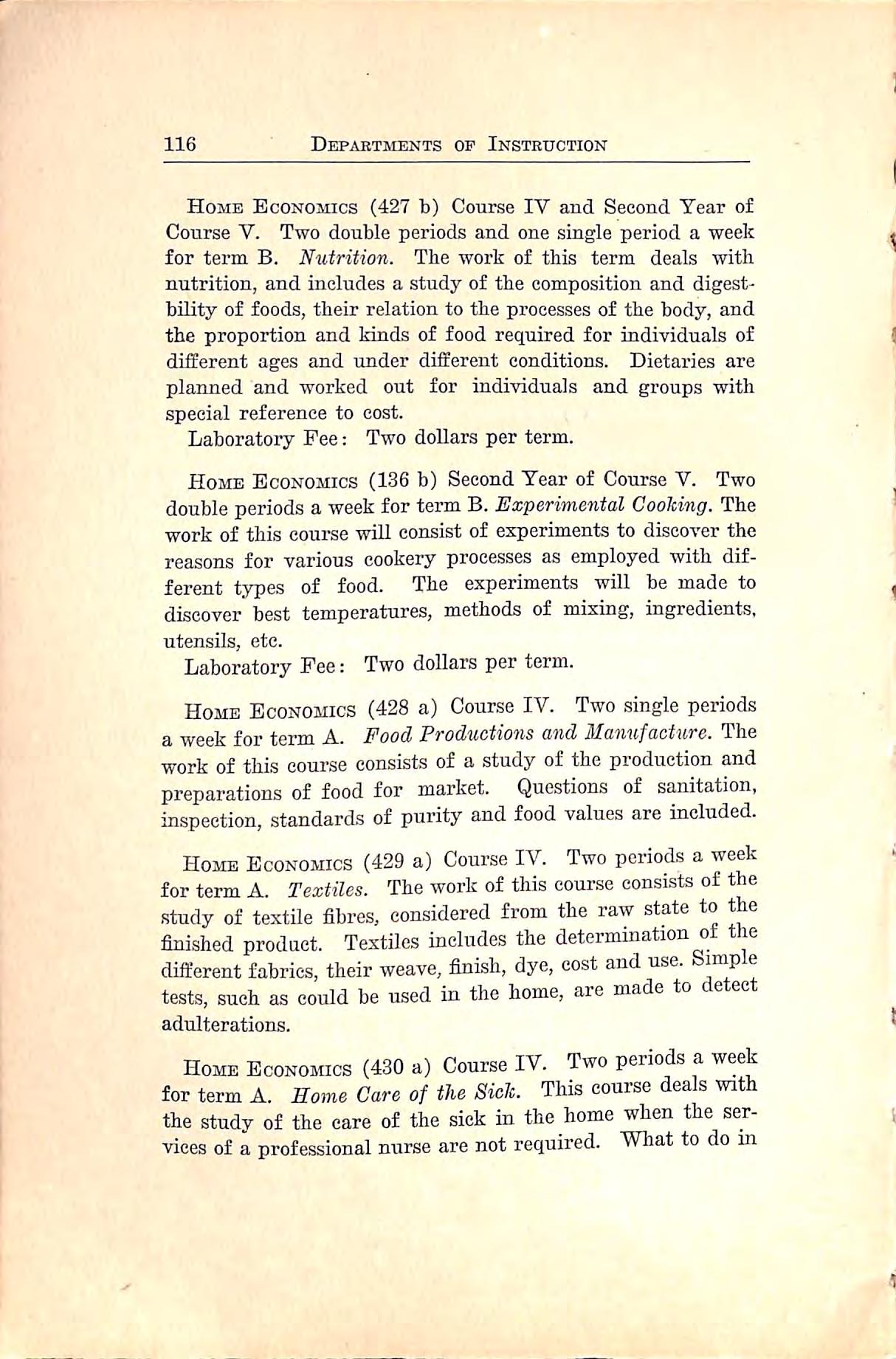
Home Economics (427 b) Course IV and Second Year of Course V. Two double periods and one single period a week fortermB. Nutrition. Theworkofthisterm deals with nutrition,and includes astudy of the composition and digestbility offoods,their relation tothe processes ofthe body,and the proportion and kinds of food required for individuals of different ages and under different conditions. Dietaries are planned and worked out for individuals and groups with special reference to cost.
LaboratoryFee: Two dollars per term.
Home Economics(136b)Second Yearof Course V. Two double periods a week for term B.Experimental Coolcing. The work ofthiscourse willconsist of experimentsto discoverthe reasons for various cookery processes as employed with dif ferent types of food. The experiments will be made to discover best temperatures, methods of mixing, ingredients, utensils, etc.
Laboratory Pee: Two dollars per term.
Home Economics (428 a) Course IV. Two single periods a week for term A. Food Productions and Manufacture. The work of this course consists of a study of the production and preparations of food for market. Questions of sanitation, inspection, standards of purity and food values are included.
Home Economics (429 a) Course IV. Two periods a week for term A. Textiles. The work of this course consists of the study of textile fibres, considered from the raw state to the finished product. Textiles includes the determination ot the different fabrics, their weave, finish, dye, cost and use. bimp e tests, such as could be used in the home, are made to detect adulterations.
Home Economics (430 a) Course IV. Two periods a week for term A. Some Care of the Sich. This course deals with the study of the care of the sick in the home when the ser vices of a professional nurse are not required. What to do in
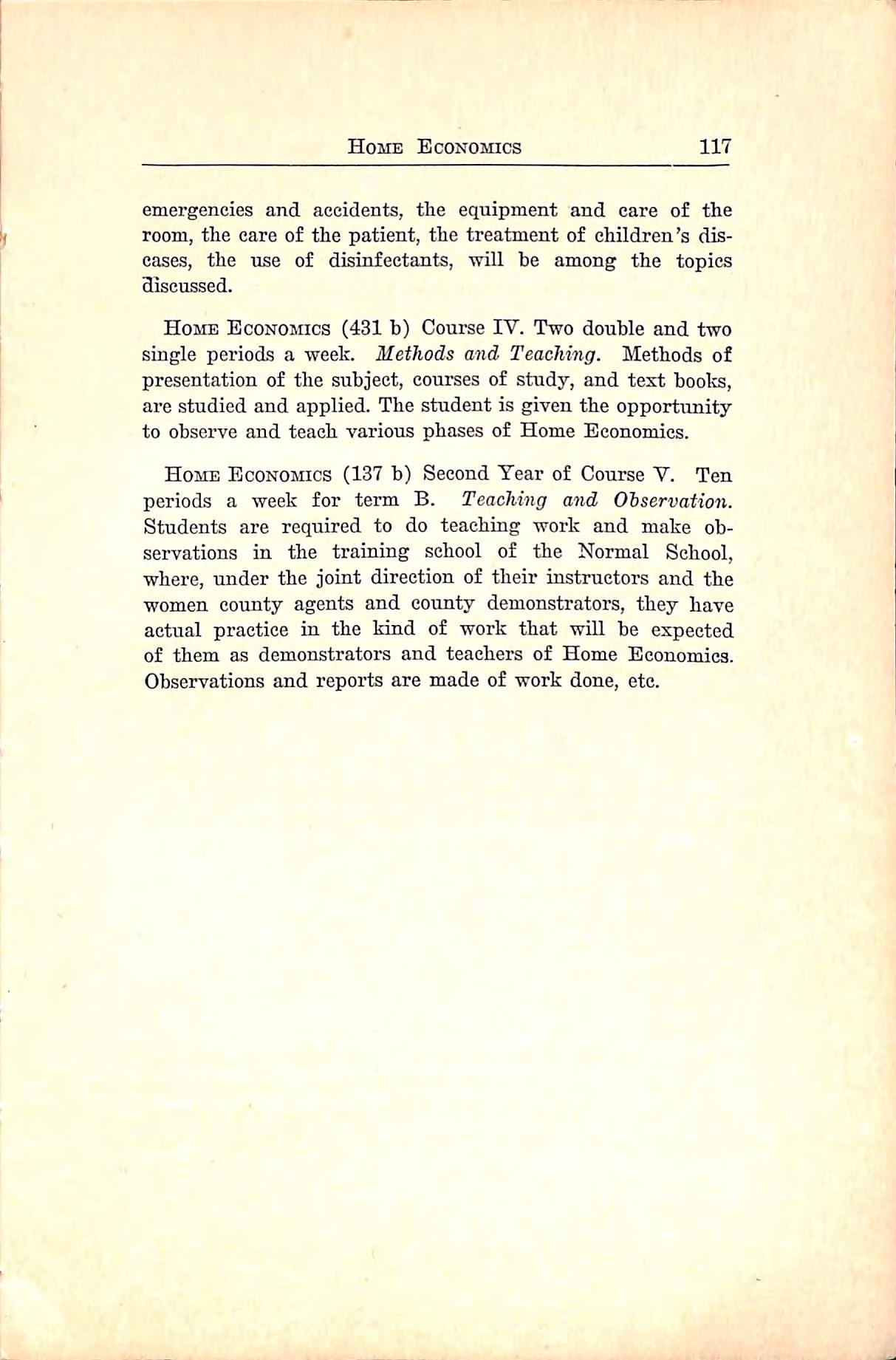
emergencies and accidents, tlie equipment and care of the room,the care of the patient,the treatment of children's dis eases, the use of disinfectants, "will be among the topics discussed.
Home Economics(431 b) Course IV.Two double and two single periods a week. Methods and Teaching. Methods of presentation of the subject,courses of study,and textbooks, arestudiedand applied.Thestudentisgiven theopportunity to observe and teach various phases of Home Economics.
Home Economics (137 b) Second Tear of Course V. Ten periods a week for term B. Teaching and Ohservation. Students are required to do teaching work and make ob servations in the training school of the Normal School, where,under the joint direction of their instructors and the women county agents and county demonstrators, they have actual practice in the kind of work that will be expected ofthemasdemonstratorsandteachersofHomeEconomics. Observations and reports are made of work done, etc.
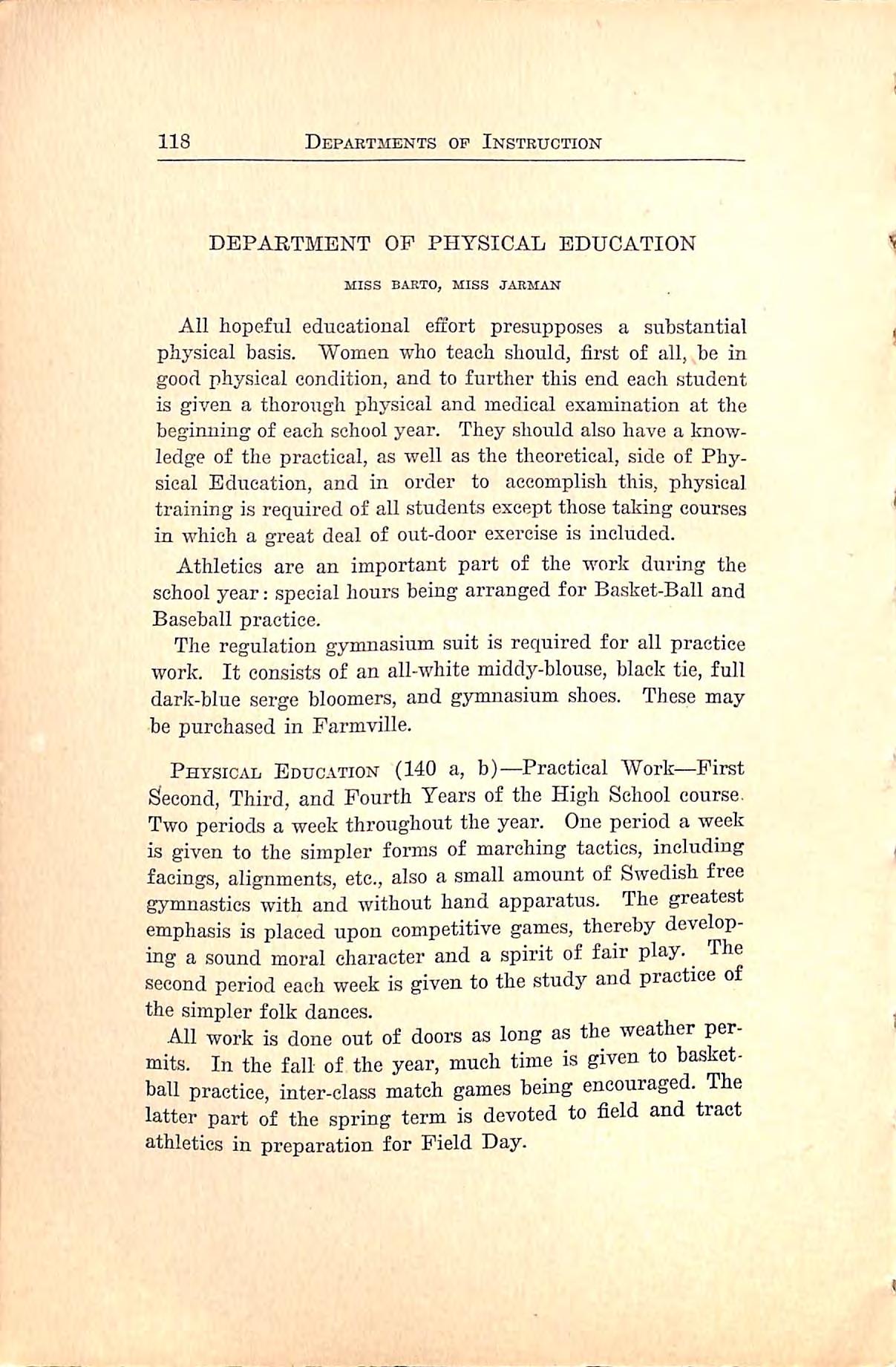
All hopeful educational effort presupposes a substantial physical basis. "Women who teach should, first of all, be in good physical condition,and to further this end each student is given a thorough physical and medical examination at the beginningofeach school year. Theyshould also have a know ledge of the practical, as well as the theoretical, side of Phy sical Education, and in order to accomplish this, physical trainingisrequired ofallstudentsexceptthosetakingcourses in which a great deal of out-door exercise is included.
Athletics are an important part of the work during the school year: special hours being arranged for Basket-Bail and Baseball practice.
The regulation gymnasium suit is required for all practice work. It consists of an all-white middy-blouse, black tie, full dark-blue serge bloomers, and gymnasium shoes. These may be purchased in Farmville.
Physical Education (140 a, b)-—Practical Work—First Second, Third, and Fourth Years of the High School course. Two periods a week throughout the year. One period a week is given to the simpler forms of marching tactics, including facings, alignments, etc., also a small amount of Swedish free gymnastics with and without hand apparatus. The greatest emphasis is placed upon competitive games,thereby develop ing a sound moral character and a spirit of fair play. ^ The second period each week is given to the study and practice of the simpler folk dances.
All work is done out of doors as long as the weather per mits. In the fall of the year, much time is given to basket ball practice, inter-class match games being encouraged. The latter part of the spring term is devoted to field and tract athletics in preparation for Field Day.

Physic.vl Education (141 a, b)—Practical "Work—Pii*st Tearofallprofessionalcourses. Twoperiodsa weekthrough outthe year.Duringthefallterm,one period is given to Folk and National dances,consisting of the analysis of the funda mental dance steps,and a variation of these steps in simple ring dances. Tlie second period is devoted to regular gj'mnastic work. Training is given in more advanced march tac tics,the United States Military Manual being followed asfar as practical. A small amountof drill work is also introduced, the emphasis being placed on practical work without appa ratus which may be applied in school having no gymnasium equipment.
Game work is given special attention, the purpose being to provide explanation and practice in a considerable number and variety of games suitable for school room and for play ground,for children of all ages.
During thelatter partofthe spring term both periods each week are devoted to Field and Track athletics in preparation for Field Day.
Physical Education (142)—Practical "Work—Second Year Professional. One period a week for student-teachers (Kindergarten students excepted). Two periods a week for Academicstudents.
Student Teachers. This course is a continuation of the work done in the First Year, more emphasis being placed upon the method of teaching. Most of the time is devoted to work in practice games for school room and playground. Some time is also given to Folk and Aesthetic dancing,includ ing as much and as difficult work in the latter as the ability of the class willpermit.
Academic Students. One period a week is devoted to Folk and Aesthetic dancing; the other is given to advanced march tactics, drill, and game work, with as much time as possible spent on the Athletic Field.
Physical Education (143 b)—Theory—First Year Group A of Course III. Two periods a week for term B. In this

course a study is made of the principal types of motor activity as to purposes and methods; of the relation of Physical Edu cation to Education in general; and of the application of psy chological, physiological and hygienic tests to all motor activity. Outlines of Festival and Pageant work are alsoin cluded.
Instruction is given in how to plan and conduct lessons, the latter part of the course being devoted to practice teaching by the class.
Education Games and Polk Dances (181 b)
First Year of Courses I and 11. Two periods a week for term B. This course is given jointly by the Kindergarten and Physical Education Departments.
Folk dances begin with the simplest forms, including imi tation of child play and industrial activities, dramatic dances, ring dances, and dances of simple technique to be used in ele mentary grades and High School, emphasis being placed on the method of presentation.
Kindergarten games include the organization of simple activities, interests, and experiences of the child into game form, together with sense games, trade games, traditional games, and games appropriate to different seasons of the year.

MISSWILKINSON
People in general, and the business world in particular, have been dissatisfied with the quality of the handwriting of the pupils who have gone outfrom our public schools. This inefficiency is due, in the main, to two causes, first, the fre quent changes in the style of handwriting taught, and second, the lack of specific preparation, on the part of the teacher, for teaching anysystem adequately.Itis difficultfor one toteach whathehimselfdoesnotknow.Itisalsotruethattheknowl edge of a subject does not guarantee the ability to teach it. The work in handwriting, therefore, aims, first, to make good writers, and second, to prepare students for efficient teaching of handwriting. While pupils are largely imitative and learn muchfrom copying theformulas given by the teacher and the ''copy book," yet the present condition of affairs justifies us in the belief that, as a method,it is a failure. Direct,specific, tested methods of teaching, coupled with the ability to write well, can alone produce the desired results. The follovdng courses then follow the two-fold aim of making good writers and preparing good teachers of writing. The muscular movement method,adopted by the State Board of Education for usein the schools of the State,istaughtin these courses.
Handwriting (150 a, b) First and Second Years—High School. Two periods per week throughout the year. All pupils enrolled in the first and second years of the high school course, who have not a well-developed, acceptable style of handwriting, are required to take this course. The quality of a pupil's handwriting is determined by the Locker Scale, combined with the personal opinion of the instructor. Those pupils who have reached a certain degree of proficiency in writing are permitted to electin the place of this course Draw ing in the first year and Industrial Arts in the second year.

This course consists of direct instruction in handling ma terials, posture, muscular movement, and such drill in the mechanicsof writing as may be necessarytotheformation of alegible,rapid,easystyle of writing.
Handwriting(151a)FirstYearProfessionalofallcourses. Two periods a week for term A, one period a week for term B. This course aims, first, to teacli students to write, and second,to teach them how to teach handwriting. Under the firstis given definite instruction and drills on handling mate rial,posture, movement,the mechanics of writing, etc., until thestudentwrites well with both pen and crayon. Under the second come such problems as the psychology of handwriting, adapting methods to the physical and mental development of the child, the place of formal di'ills, motivation of writing, standards of excellence in handwriting, the technique of class instruction, the physiology and hygiene of writing, measuring the results with the scales of Locker and Ayres, and the corre lation of hand^vriting instruction with other written work in thecurriculum.
Special Handwriting. Students in the third and fourth high school years, who are not able to measure up to the re quired standard of excellence in writing, are required to at tend a special writing class where they may receive more or less individual instruction until the quality of their writing reaches the standard set by the school. Sections are arranged to meet, as far as possible, the schedule requirements of both regular and irregular students.

MISS CARRINGTON
At the beginning of each year five periods of time sched uled for English is devoted to a study of Library Methods. The aim of this work is to aid the students in the intelligent Tise of the school library. The work is divided by years, £is follows:
The work of the First Year High School covers rules and regulations concerning the use of the school library, circula tion of books, and the general arrangement of books in the library. Dictionaries are studied with regard to their use, and the information to be found in an unabridged dictionary.
In the Second Year High School the card catalogue and how to use it is taken up,and encyclopedias and atlases are studied as dictionaries were the previous year.
The work of the Third Year High School includes bio graphical reference work, magazine and periodical indexes, special reference work, and a review of dictionaries and encyclopedias.
In the Fourth Year High School and the First Year Pro fessional Library Methods is required only of those students who have had no pervious training of this kind. In each of these classes the allotted time is given to astudy of the rules and regulations concerning the use of the library and the arrangement of books, use of the catalogue, and contents of the reference department.
LiBRiVRY Methods (155) Second Year of Course III. One period a week for one term. The aim of this course is to train students in the administration of a school library while teaching.
ME.

KCNDERGABTENEDUCATION
MISSMIX,MISSJOHNSON*
COUNTEY LIFE EDUCATION
MISS DUNN,* MISS PIERCE
Note.—Each head of department whoso subject is taught in the Training Schoolgivesacoarseintheteachingofthatsubject.Thesecourseswillbefound SBpartsofthestatement ofthe work ofeach respective department.
The understanding of the process of education and rWII in the art of teaching are the two main phases of the aim of professional work.
To understand the process of education, it is necessary to know how the mind grows and learns. This phase of pro fessional training is supplied by educational psychology and related subjects.
To understand what the teacher can do to facilitate the process of learning, it is necessary to know how to select, arrange,and relate subject matter so thatit will come to the child with the greatest degree of educative value. This phase is supplied by work in methods, both general and special.
The subject matter of our education and the teacher's at titude toward the learner and the present school system as an institution are the results of a long, slow growth. To com prehend fuUy a growing thing it is necessary to study the history of its growth. Such study is provided for in the his tory of education.
In order to meet the rapidly changing conditions of the present time every teacher needs a broad view of education as a whole. She needs to know something of the factors which
*PartworkinEducation. Mi88JobuaooalsoassistsinFirstGradeSupervision. "On leave of absence, 1916-*17.

arechieflyinstrumentalinmodifyingeducationaltheoriesand practices, and to have a rational basis for the interpretation and adaptation of new ideas.The principles of education aim to meetthis need. However unsettled manj'questions of edu cation may be,itis generally agreed that all education should strengthen and improve character. Special attention is there fore given in this course to the principles of moral education.
Finally,in order to possess skill in the art of teaching, practice in that ai-t is necessary. Teaching in the training school supplies this practice.
Thecoursesofferedinthisdepartmentareasfollows:
ElementaryEducationalPsychology.^n^^dObservation (160a)First Year of all courses. Three periods a week for term A. An Orienting Course. For the first few weeks of this course an intimate study is made of the capabilities of the prospective teachers represented by the students in this class, together with a study of the various types of public schools that the various courses prepare teachers for. These studies, reinforced by a study of the characteristics of pupils of the different school ages and qualities of teaching de manded by them,are supposed to afford an intelligent guide to the students who are to select their course at the end of the term. After this guidance has been provided, this course aims to equip the student with the elementary principles of teaching. Teaching is regarded as a means of facilitating learning. The elementary facts of educational psychology are studied with special reference to their significance for teach ing. Students illustrate these facts from their own past and present learning experience, and opportunity is given for each student to do some work in simple experimentation in the problems of learning.
In the observation part of the work the student advances one more step toward actual teaching, i. e., she sees and studies the principles as they are used to facilitate the learning pro cess. The observation of illustrative lessons is the main basis for this work. These lessons are taught by heads of depart-

ments or by supervisors, and arc so planned as to illustrate especially some particular principle of teaching. Thus the ele mentary facts of educational psychology are reviewed by using them to interpret the teaching observed.
An immediate aim is to increase the .student's knowledge of the varying natures of children of different ages, thus in creasing and improving the basis for intelligent choice of coursesattheendoftheAterm.
This work is prerequisite to all other classes in Education.
Educational Psychology (161 b) First Year of Course I, and First Year Group A of Course II. Child Study. Three periods a week for term B. The purpose of this work is to further the student's knowledge of the child as a developing being and to acquaint her with tlie more important facts and phenomena of child nature, with especial emphasis on the primary school period, their tendencies and the laws of de velopment and control. Among the topics stressed are: In stincts. their manifestation, order of appearance, essential characteristics, function and use, and place in the educative scheme; habits, formation, varieties, function and use; educa tion of the senses; association, memory, reasoning; individual differences and mental tests; in brief, the Learning Process. Text Book: Kirkpatrick's Fundamentals of Child Study.
Primary Methods (162) First and Second Years of Courses I and II. Four periods a week for one term. Four given in term B of the First Year, and repeated in term A of the Second Year. The course gives a general acquaintance ivith the work of the first three grades as regards aims, nature and scope of subject matter and methods of teaching. The subjects treated are reading and phonics, spelling, writing, language, arithmetic, and nature study. Questions relating to correlation and motivation are considered. Also the prob lem of seat work is taken up with each subject.
Text Books: Laing's Reading, A Manual for Teachers; State Normal School Bulletins on English and on Spelling;

Dunn's Educative Seat Worh; and The Training School Course of Study.
Other Beferences: Chubb's The Teaching of English, Hue3''s The Psychology and Pedagogy of Reading, Jenkins' Reading in the Primary Grades, Aldine's Language Method, Part I, Holtz's Nature Study, Hodge's Nature Study, "Waldo's First Journeys in Nuniberland, Smith's The Teaching of Arithmetic, and children's text book in reading with accom panying Manuals.
Grammar Grade Methods (163)
Second Year Group A of Course III. Three periods a week for one term. This course aims to stress the fundamental conceptions, aims, and methods of the branches of study usually undertaken by the grammar grades. Each subject is discussed separately, prac tical methods and devices receiving the major emphasis. Those subjects receive most attention that have least attention de voted to them in the special method courses. First come the instrumental subjects; .second, the informational subjects; third, the more or less formal subjects, and finally, the special subjects. All discussion is related specifically to the work in grades five, six, and seven.
Text Books: Charter's Teaching the Common Branches, Gilbert's What Children Study and Why, State Normal School Bulletins on Spelling and on Elementary English.
Methods and Management (164) Second Year Group A of Courses II and HI, and Second Year of Course "V. Three periods a week for one term. This course is taken parallel with practice teaching; and it is a continuation and an en largement of the First Year work in Educational Psychology, Special Methods, and Observation. Its aim is to enable student-teachers to study the problems of teaching from the standpoint of actual practice. Methods and management are treated as two inseparable phases of teaching. In developing methods of instruction, especial emphasis is pui. upon lesson types in order to develop method concepts

that secure variety in procedure as well as adaptability to the nature of the topic taught.
The various scientific scales of measurement are taken up in class where a study is made of their purpose and use and then each teacher is made familiar with the technique of measurement through the use of the scales in measuring the product of the grade she is teaching.
This course lays stress on the point of view that good teach ing isthat which enablesthe learner to reconstruct his experi ence, but at the same time it gives due attention to the drill phase of learning. Part of the term's work deals with the problem of vitalizing the course of study.
Separate sections are maintained for student-teachers of primary grades and grammar grades.
Text Books: Strayer's A Brief Course in the Teaching Trocess, Bagley's Classroom Management.
History of Element^iry Education (165) Second Year of Courses I,II,and Second Year Group A of Course III. Three periods a week. This course aims to give an understanding of modem public school work carried on in the grammar grades, the primary grades, the kindergarten, and the country school. The work of these divisions of the public school system is studied in the light of both their present tendencies and their historical development.
The work begins with a brief survey of present tendencies, after which these tendencies are studied as they originated in and developed from the conflict of Greek, Roman, and Chris tian influences during the Middle Ages, the Renaissance, the Reformation, and modem educational movements. The con tributions of Sturm, Comenius, Rousseau, Pestalozzi, Herbart, Froebel, Horace Mann, Henry Barnard, Harris, and Dewey are considered in their settings.
All the work has reference to the development of public education in Virginia, and the services of such men as RulEner havedueconsideration.
Text Book: Graves' A Student's History of Education.
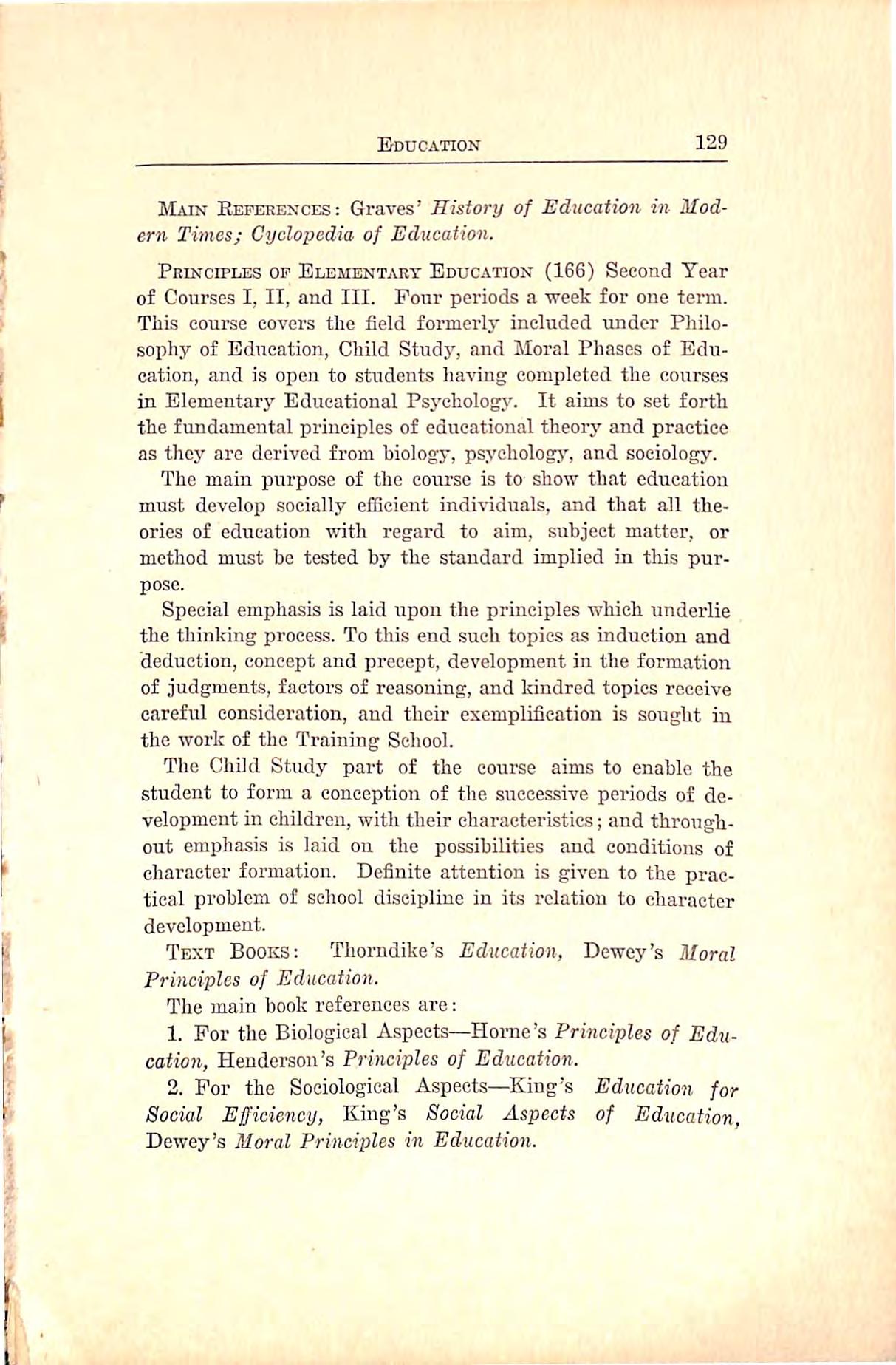
Main References: Graves'Sisiory of Education in Mod ern Times; Cyclopedia of Education.
Principles op Elementary Education (166) Second Year of Courses I, II, and III. Four periods a week for one term. This course covers the field formerly included under Pliilosophy of Education, Child Study,and Moral Phases of Edu cation, and is open to students having completed the courses in Elementary Educational PsyehologjL It aimsto set forth thefundamental principles ofeducationaltheory and practice as they are derived from biology, psychology', and sociology.
The main purpose of the course is to show that education must develop socially efficient indi\*iduals, and that all the ories of education with regard to aim, subject matter, or method must be tested by the standard implied in this pur pose.
Special emphasisislaid upon the principles which underlie thethinking process.Tothis end such topics asinduction and deduction,concept and precept,developmentin the formation of judgments, factors of reasoning, and kindred topics receive careful consideration, and their exemplification is sought in the workofthe Training School.
The Child Study part of the course aims to enable the student to form a conception of the successive periods of de velopment in children, with their characteristics; and through out emphasis is laid ou the possibilities and conditions of character formation. Definite attention is given to the prac tical problem of school discipline in its relation to character development.
Text Books: Thorndike's Education, Dewey's Moral principles of Education.
Themainbookreferencesare:
1. For the Biological Aspects—Home's Principles of Edu cation, Henderson's Principles of Education.
2. For the Sociological Aspects—King's Education for Social Efficiency, King's Social Aspects of Education, Dewey's Moral Principles in Education.

3. For the Psychological Aspects—^Dewey's Mow We Think, Miller's Psychology of Thinking, Thorndike's Principles of Teaching.
4. For the Child Study Part—Kirkpatrick'sFundamentals of Child Study,Kirkpatrick's The Individualin the Making, Barnes'sStudiesinEducation.
5. For Character Development—Sisson's The Essentials of Character, Gould's Moral Instruction, Holmes's Principles of Character Making,Cabot's Ethicsfor Children. General Reference—Cyclopedia of Education.
Current Problems (167) Second Tear of Courses I, II and III. One period a week for one term. It is the purpose of the course to enable thestudents to acquaintthemselves with the best current literature upon the subject of education. Worthy articles in the leading educational magazines are one largesourceforstudy and discussion. The course is asflexi ble as possible and open to the study of such educational prob lems as are chosen by the members.
As far as practicable sections are made on the basis of courses.
Practice Teaching (168) Senior Year of Courses I, II, andIII. In CourseIVtwotermsofteachingand observation are required in the Second Year and one term in the Fourth. The ability to teach is the ultimate test of students in the professional department. Skill in teaching is regarded as one of the essential requisites of the Normal School graduate, and unless sufiScieut ability is attained to teach and discipline a room properly,the student cannot be graduated. The teach ing is done in the Training School, under the special supervi sion and direction of the supervisors for the grades and the heads of departments. The effort is continually made^to in spire the young teacher with the true professional spirit, and to equip her with such methods and help as to make her efficient in her work. It is evident that this actual experience iu the schoolroom gives the student-teacher a power which
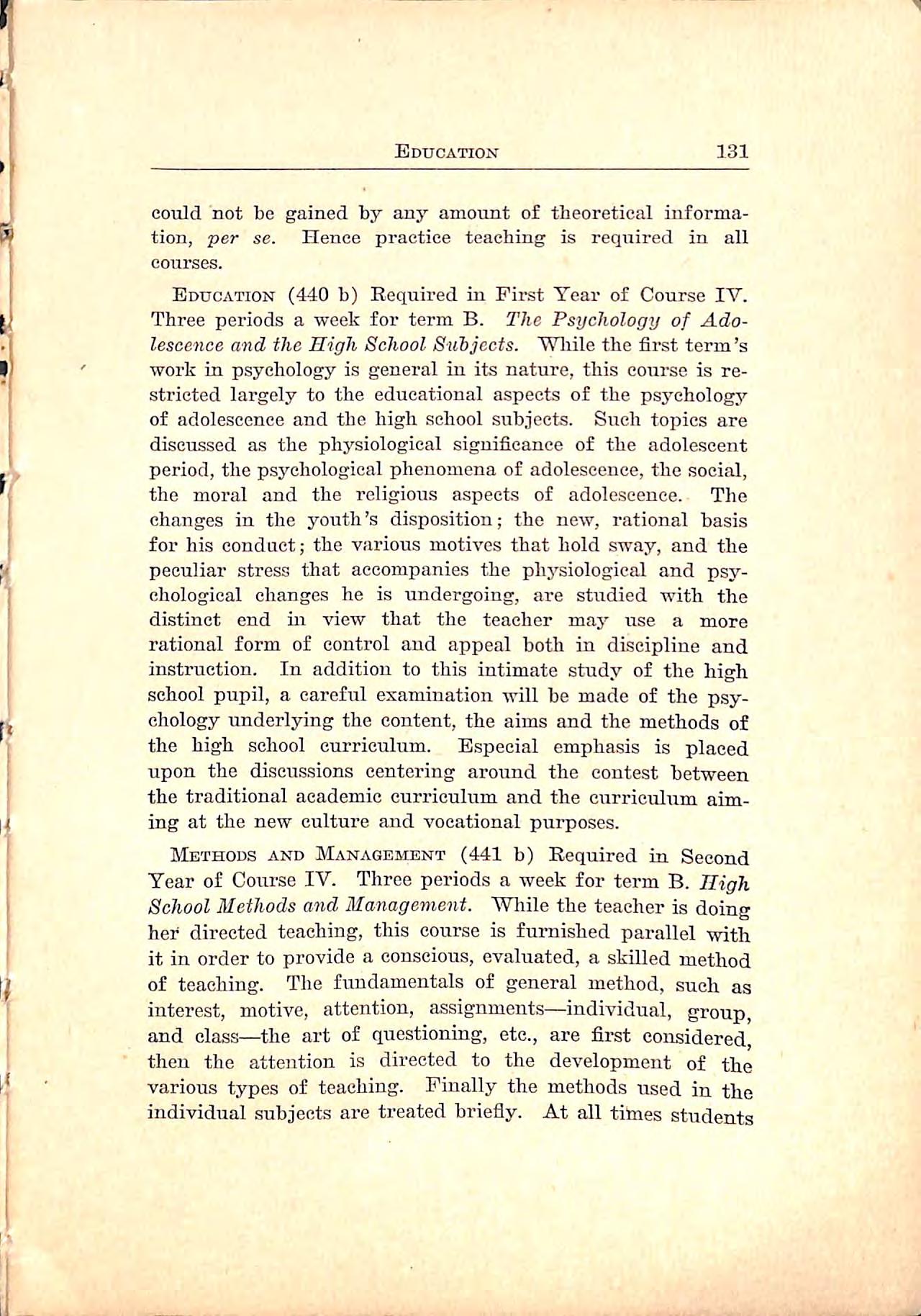
could not be gained by any amount of theoretical informa tion, per se. Hence practice teaching is required in all courses.
Education (440 b) Required in First Year of Course IV. Three periods a week for term B. The Psychology of Ado lescence and the High SchoolSuhjecfs. "WTiile the first term's work in psychology is general in its nature,this course is re stricted largely to the educational aspects of the psychology of adolescence and the high school subjects. Such topics are discussed as the physiological significance of the adolescent period,the psychological phenomena o£ adolescence,the social, the moral and the religious aspects of adolescence. The changes in the youth's disposition; the new, rational basis for his conduct; the various motives that hold sway, and the peculiar stress that accompanies the physiological and psy chological changes he is undergoing, are studied with the distinct end in view that the teacher may use a more rational form of control and appeal both in discipline and instruction. In addition to this intimate study of the high school pupil, a careful examination will be made of the psy chology underlying the content,the aims and the methods of the high school curriculum. Especial emphasis is placed upon the discussions centering around the contest between the traditional academic curriculum and the curriculum aim ing at the new culture and vocational purposes.
Methods and Management (441 b) Required in Second Year of Course IV. Three periods a week for term B. High School Methods and Management. While the teacher is doing her directed teaching, this course is furnished parallel with it in order to provide a conscious, evaluated, a skilled method of teaching. The fundamentals of general method, such as interest, motive, attention, assignments—individual, group, and class—the art of questioning, etc., are first considered, then the attention is directed to the development of the various types of teaching. Finally the methods used in the individual subjects are treated briefly. At all times students

are required to draw upon their directed teaching for illus trations, and the critic-teacher requires the student-teacher to put into practical operation in the class-room the ideas gained in the Methods and Management Course. The sig nificance phases of class-room management are treated from the standpoint of their values both as means and as ends.
Text: Parker's Methods of Teaching in High Schools.
History of High School Education (442 a) Required in Third Year of Course IV. Four periods per week for term A. The secondary schools of Greece, Rome, Central Europe duringtheMiddleAgesandthe Modern Period,and the early American Secondary Schools are studied in order to trace the development and to properly interpret the bearing and scope of the curriculum, organization and methods of teach ing prevailing in the present-day schools. Especial atten tion is devoted during the latter part of the course to the European Realistic Schools, and the American Latin Gram marSchoolandAcademy, Especial attention is given to the principles and tradi tions of education,in their historical development,that have dominated and controlled secondarj'- education for so long. "With these are contrasted the new ideals of tlie modern high school.
Principles of SECONDiVRY Education (443 b) Required in Third Tear of Course IV. Four periods a week for term BThis course is prefaced by a brief, historical survey of the field of Secondary Education, which is followed by a com parison of the American High School with the chief types of secondary schools of France, Germany and England. The psychological, social and physiological principles involved in the teaching of the various secondary subjects and the va rious conceptions and traditional doctrines that have long held sway over secondary education are examined in the light of recent scientific investigation. The controlling aims and purposes of school discipline, athletics and recrea tion, the social, moral and religious life of the high school
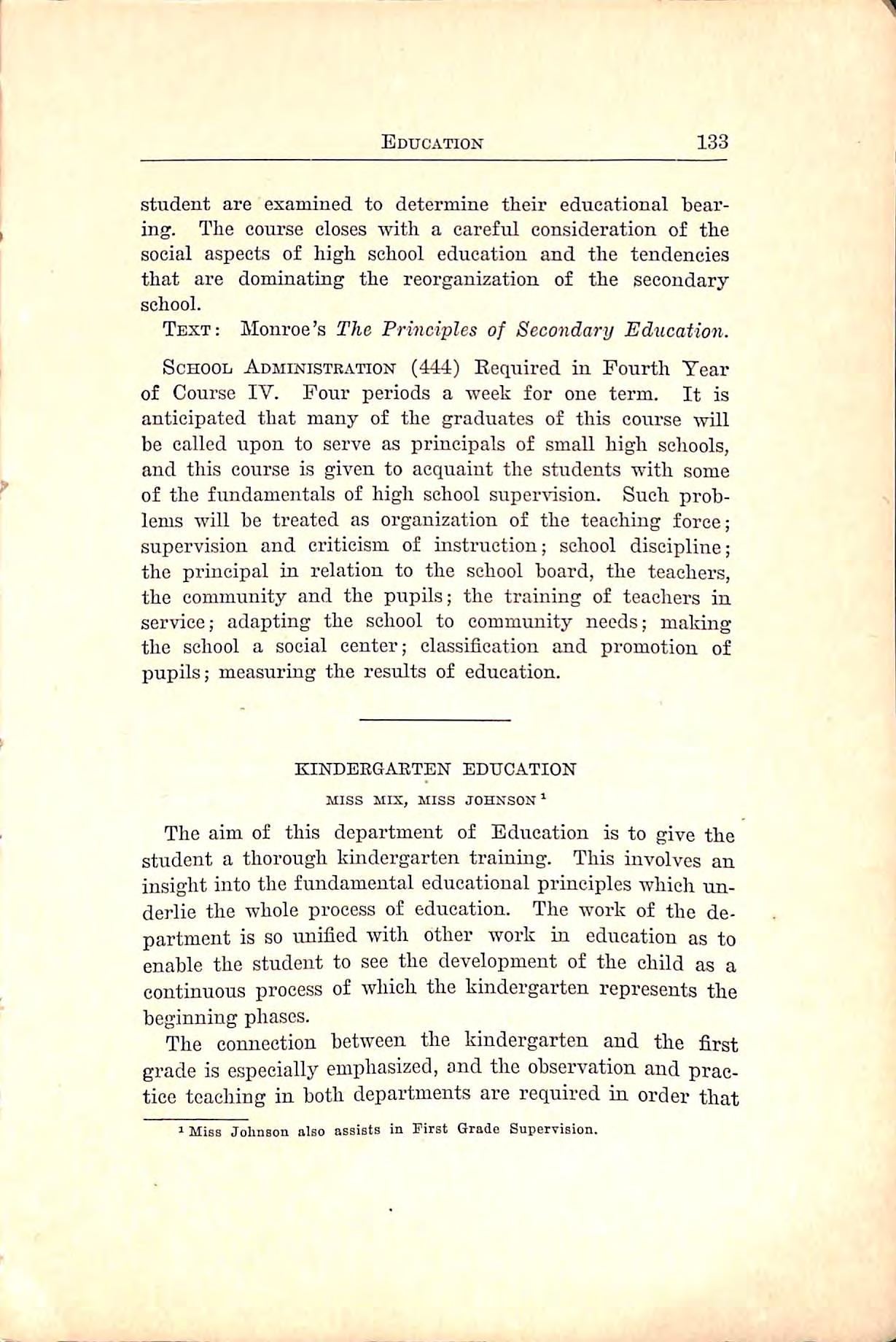
studentareexaminedtodeterminetheireducationalbear ing. The course closes with a careful consideration of the social aspects of high school education and the tendencies that are dominating the reorganization of the secondary school.
Text: Monroe's The Principles of Secondary Education.
School Administration (444) Required in Fourth Tear of Course IV. Pour periods a week for one term. It is anticipated that many of the graduates of this course will be called upon to serve as principals of small high schools, and this course is given to acquaint the students with some of the fundamentals of high school supervision. Such prob lems will be treated as organization of the teaching force; supervision and criticism of instruction; school discipline; the principal in relation to the school board, the teachers, the community and the pupils; the training of teachers in service; adapting the school to community needs; making the school a social center; classification and promotion of pupils; measuring the results of education.
The aim of this department of Education is to give the student a thorough kindergarten training. This involves an insight into the fundamental educational principles which un derlie the whole process of education. The work of the de partment is so unified with other work in education as to enable the student to see the development of the child as a continuous process of which the kindergarten represents the beginning phases.
The connection between the kindergarten and the first gi'ade is especially emphasized, and the observation and prac tice teaching in both departments are required in order that 1MissJolinsonalso assistsinFirstGrade Supervision.

the student may comprehend how the work done in one de partment may he carried over, utilized, and extended in the next.
In addition to the kindergarten work this course includes other courses in the Department of Education,and also sev eralrelated coursesin other departments. (See page 41.)
The courses offered by the Kindergarten Department are asfollows:
Constructive Activities in the Kindergarten (180) First Year of Course I. Pour periods a week for term B. The purpose of this course is to give a mastery of the con structive materials of the kindergarten, and an insight into their use as a medium of expression for children's experiences and as a means of developing thought.
Child Literature (18) First Tear, term B, or Second Year,term A of CoursesI and II.
For detailed statement,see Department of English, page 57.
Games and Polk Dances (181 b)First Year of CoursesI and II. Two periods a week for term B. This course is given jointly by the Kindergarten Department and the Department of Physical Education. The kindergarten games include or ganization of simple activities, interests, and experiences of the child into game forms. Sense games, trade games, tra ditional games, and games appropriate to different seasons of the year are developed. Such subjects are discussed as the meaning of play, possible aims and problems connected %vith plays and games, the relationship between activity and mental development, and the value and need of sense training. Polk dances include imitations of the child's play as well as industrial activities set to music and performed in definite form with song, dramatic dances, and dances of simple tech nique in step and gesture. These dances are planned especially to allow the child free physical activity expressed through rhythmic movements in definite form.
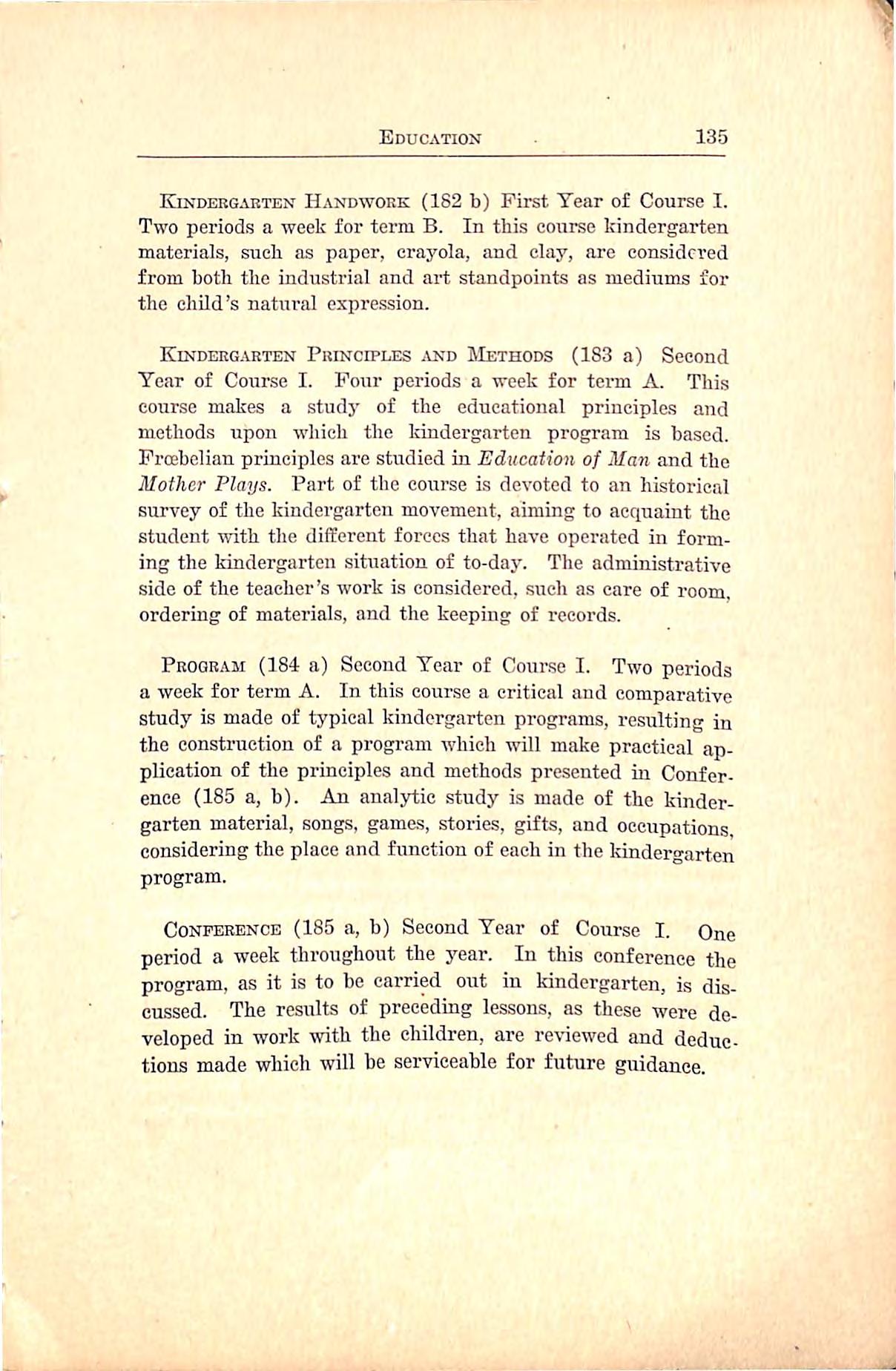
Kindergarten Handwork (182b) First Year of Course I. Two periods a week for term B. In this course kindergarten materials, such as paper, erayola, and clay, are considered from both the industrial and art standpoints as mediums for the child's natural expression.
Kindergarten Principles ^and LIethods (183 a) Second Year of Course I. Four periods a week for term A. This course makes a study of the educational principles and methods upon which the kindergarten program is based. Froebelian principles are studied in Education of Man and the Mother Plays. Part of the course is devoted to an historical survey of the kindergarten movement, aiming to acquaint the student with the diifcrent forces that have operated in form ing the kindergarten situation of to-day. The administrative side of the teacher's work is considered,such as care of room, ordering of materials, and the keeping of records.
Program (184 a) Second Year of Course I. Two periods a week for term A. In this course a critical and comparative study is made of typical kindergarten programs, resulting in the construction of a program which will make practical ap plication of the principles and methods presented in Confer ence (185 a, b). An analytic study is made of the kinder garten material, songs, games, stories, gifts, and occupations considering the place and function of each in the kindergarten program.
Conference (185 a, b) Second Year of Course I. One period a week throughout the year. In this conference the program, as it is to be carried out in kindergarten, is dis cussed. The results of preceding lessons, as these were de veloped in work with the children, are reviewed and deduc tions made which will be serviceable for future guidance.

MISSDUNN/MISSPIERCE
This work is undertaken in response to tlie increasing de mand for teachers and supervisors who are definitely trained to do the same high-class work in country schools as has heen done for some time in city schools. The aim of the course is to give special preparation for teaching and supervising graded country schools.
The improvement of country life and education is one of the largest problems of our century. It is important that its solution should he undertaken by those whose interests and native capacities are bestsuited toits characteristic needs and opportunities. To this end, the student does not definitely elect the work of the Country Life Department of Education until the middle of her First Tear. The work of the first term is uniform with that of the other professional courses. Through her contact with professional work, the student is enabled to make an intelligent choice of courses, and throxigh their knowledge of her, instructors are enabled to advise the student of her special qualifications and abilities. The work of the First term, therefore, aims to give that knowledge of child nature and professional acquaintance with the subject matter of the elementary school which is an essential part of theequipmentoftheteacher ofanyschoolorgrade.Fora de scription of these courses, see the A term of the First Year of the various departments. For the remaining terms of the pro fessional yearsthe aim isnotonlyto acquaintthe studentwith methods and principles of teaching, but also to give her some knowledge of country life conditions and the interrelation between them and the work of the country school, and to aid her to adapt general principles and methods to the needs and resources of various types of rural schools,from the one-room school to the consolidated high school.
Country School Management (200 b) First Year, Group B of Courses II and III. Three periods a week for term B. In ^Onleaveofabsence.1910-'17.

addition to the usual phases of class and school management this course aims to present the practical problems found in country schools of various types, and to show how they may be handledtoeconomizetimeandeffort,andtoconducetothede velopment and progress of the pupils. The possibility of developing self-reliance and initiative, and of providing for individualdifferencesto an extentimpossiblein acityschool, ispointedout.Schedulesofdailyrecitation and seatworkfor one-, two-, and three-teacher schools are planned. Especial attention is given to study and seat-work periods, and to sanitary conditions of school and grounds as related to the physical, mental, and moral life of the pupils. The use of the recess periods, with consideration of practicable and de sirable games and game equipment; provision for indoor play in inclement weather; and the relation of the school to the recreation as well as to the industrial life of the community, are considered as a legitimate phase of the question of country school management.
Text Books: Culter and Stone's The Rural School, Its Methods and Management, Dunn's Educative Seat-Work.
Main References: Bagley's Classroom Management, Carney's Country Life and the Country School, The State CourseofStudy,TheSanitarySchool.
Methods and Management (201 b) Second Year Group B of Courses II and III. Three periods a week for term B. This course is a continuation and enlargement of the First Year work in Educational Psychology, Special Methods, Ohservation,and Country School Management.It is given in the teach ing term, and aims to enable student-teachers to study the problems of teaching from the standpoint of actual practice. Part of the term's work deals with the problem of vitalizing the course of study,through utilization of the child's interests and tendencies, and relation to the community life of which he is a part. Types of lessons are considered, with especial attention to their practicability and adaptation to the condi tions of country schools.
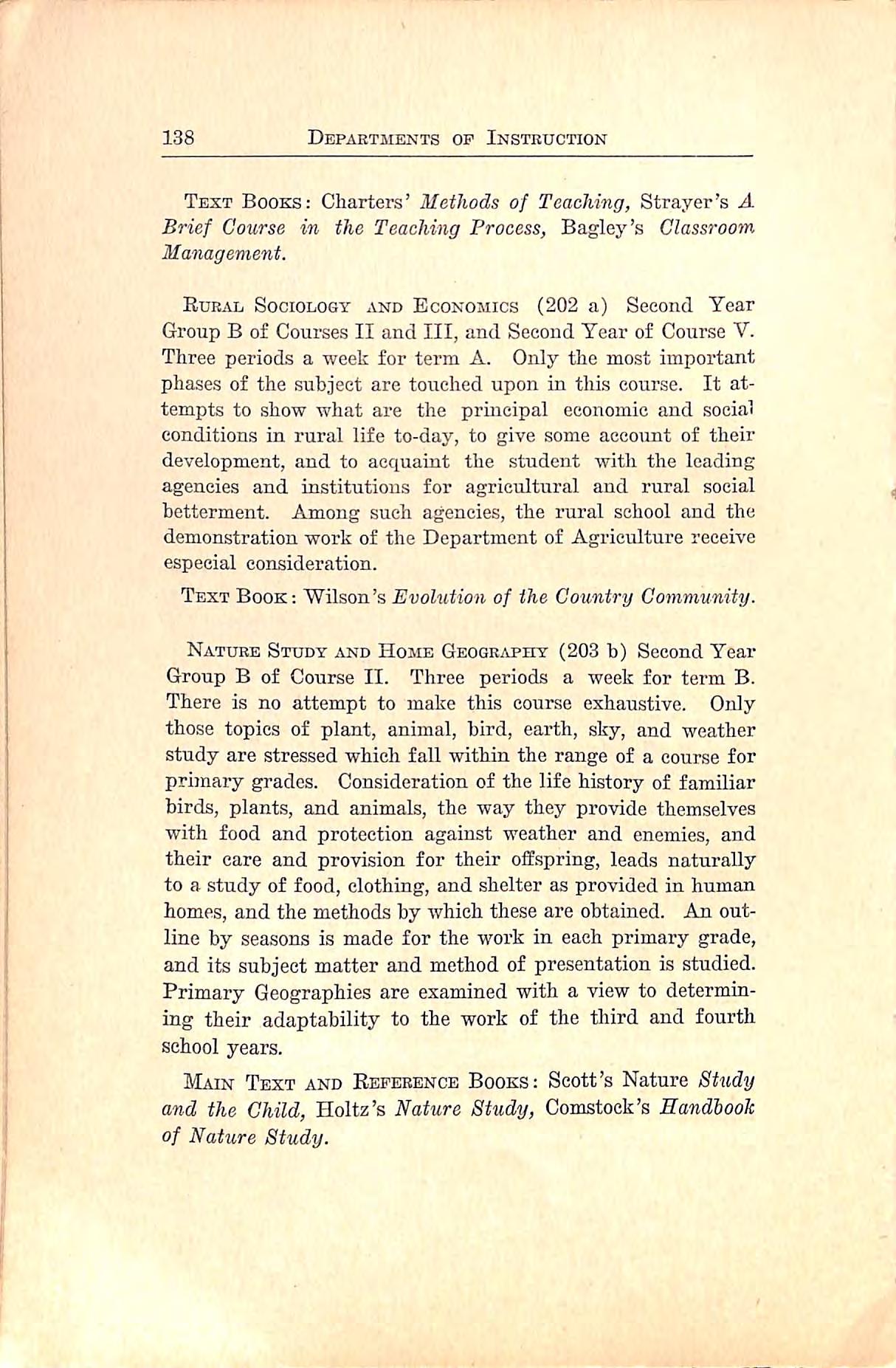
Text Books; Charters' Methods of Teaching, Strayer's A Brief Course in the Teaching Process, Bagley's Classroom Management.
Rural Sociology Economics (202 a) Second Year Group B o£ Courses II and III, and Second Year of Course V. Three periods a week for term A. Only the most important phases of the subject are touched upon in this course. It at tempts to show what are the prmeipal economic and social conditions in rural life to-day, to give some account of their development,and to acquaint the student with the leading agencies and institutions for agricultural and rural social betterment. Among such agencies,the rural school and the demonstration work of the Department of Agriculture receive especial consideration.
Text Book:"Wilson's Evolution of the Country Community.
Nature Study and Home Geograpet?(203b)Second Year Group B of Course II. Three periods a week for term B. There is no attempt to make this course exhaustive. Only those topics of plant, animal, bird, earth,sky, and weather study are stressed which fall within the range of a course for primaiy grades. Consideration of the life history of familiar birds, plants, and animals,the way they provide themselves with food and protection against weather and enemies, and their care and provision for their offspring,leads naturally to astudy offood,clothing,and shelter as provided in human homes, and the methods by which these are obtained. An out line by seasons is made for the work in each primary grade, and its subject matter and method of presentation is studied.
Primary Geographies are examined with a view to determin ing their adaptability to the work of the third and fourth school years.
Main Text and Reference Books: Scott's Nature Study and the Child, Holtz's Nature Study, Comstoek's Handbook of Nature Study.

CuERENT Problems (204 a) Second Year Group B of Courses II and III. One period a week for term A. This course affords an opportunity for acquaintance with current literature dealing with educational problemsselected for their special interest to its students. The Country Life Movement in particular is still so new that the most valuable sources of information regarding it arelikely to befound in magazines, bulletins, and reports, and it naturally receives especial at tention. Itis not,however,the exclusive topic ofthe course, other subjects, of general educational import, being also con sidered.
Teaching and Observation (205 b) Second Year Group B of Courses II and III. Fifteen periods a week for term B. The ability to teach is the ultimate test of students in the pro fessional department. Skill in teaching is regarded as one of the essential requisites of the Normal School graduate, and unless sufficient ability is attained to teach and discipline a room properly, the student cannot be graduated. The work is done in the Training School and in rural schools, under the special super\'ision and direction of grade supervisors and heads of departments. The effort is continually made to in spire the yoimg teacher with the true professional spirit, and to equip her with such methods and help as to make her effi cient in her work. Especial effort is made to acquaint the student, by actual contact, with rural school conditions and necessarj'- adaptations of practice.
Jos.L.Jabman president
S. P. Duke Director and Principal
Fronde Kennedy*
Ellen J. Murphy
Mart E. Peck
'Mamie E.Eohr
Florence M. Rohr
Pauline Williamson
'Eleanor B.Fobman
Edith Johnston
Eliz.\,L.Emery
Bebth^v Wells

Supervisor of Ninth Grade
Supervisor of Eighth Grade
Supervisor of Seventh Grade
Supervisor of Sixth Grade
Acting Supervisor of Sixth Grade
Supervisor of Fifth Grade
Supervisor of Fourth Grade
Acting Supervisor of Fourth Grade
Supervisor of Third Grade
Supervisor of Second Grade, and of Industrial Worlc in Primary Grades
Mary Philippa Jones Supervisor of First Grade
Grace E.Mix Supervisor of Kindergarten
JuliaJohnson AssistantinKindergartenandFirstGrade ThelmaBlanton..SecretarytoDirector,andAssistantinSecondGrade
The Training School, which consists of a kindergarten and nine grades, is in charge of a Director who is also Principal of the Training School, Heads of Departments, Supervisors, and Assistant Supervisors. As student-teachers certain respon sibilities are delegated to members of the Senior Class. The Director is also Head of the Department of Education, hence the work of the Training School is in close touch with the best educational thought. The purpose of this school is to give to the student-teacher actual experience in solving the various problems which confronttheteacher. Sheisplaced in charge of part or all of a room, and as soon as practicable is held responsible for the discipline as well as the teaching. All prac tice teaching is carefully supervised.
The Director of the Training School divides the Second
Q ochool,^HeadsofDepartmentswhosesubjoctsarerepresentedintheTraining arealsomembersofthoTrainingSchoolFaculty. Onle&veofdbsenco* •i.detailedphasesororganizationarecoveredintho"ReportoftheOozzi* tteoonRelationshipsintheTrainingSchool."

YearProfessionalClassintotwoscetions. Themembersof cue section are engaged in class work,while the members of the other devote most of their time to teaching. In the spring termthesectionsreverse. Thisdivisionismadeinorderthat the students who are teaching in the Training School may be practicallyfreefor this work.
No student is allowed to graduate, however proficient she may be in the academic branches, until she has satisfied the Training School Faculty that she is qualified to teach.
For the use of the Training School there is a small library consisting of 580 juvenile books and half a dozen magazines. Oncea week,underthe guidance of astudent-teacher and the supervision of the Librarian, each grade comes separately to the Training School Library to exchange books and to read. From this Juvenile Library each grade has the privilege of drawing a supply of books for reading with the children, therebyforming a small class-room or grade library.
To promote a love of good books, especially of the mythms, legends, and fairy stories, a story-hour is held for four periods a week for the First, Second, Third, and Fourth Grades. First Year Professional students of Courses I and II conduct the story-hour under supervision.
Special attention is given to the Training School Course of Study. The aim is to make it more than a mere listing of the subject matter adapted to each particular grade. In addition to this arrangement of subject matter the course of study attempts to show the relation of formal subject matter to the life interests of the learners.
The course of study is printed as a separate bulletin.
Name

Address
Abrahams,MattieLouise(Jr) KingWilliam Enfield Adaais,DobothtAloise(S) Norfolk 818EedgatoAve. Addington,MartA.(Jr) Norfolk 513BoissevaiuAve. Alexander,Annette(Jr) Blakely,Ga. Alexander,Elise(Jr) Henrico Elko Alexander,MargaretD.(Jr) Highland McDowoU Allen,Lovelene(FY) PrinceEdward Proapoct Ames,GladysAmes(Jr) Portgraouth Portsmouth Anderson,KatherineM.(Jr) Lynchburg 1514EarlySt. Anderson,LauraMarks(T) Farmville 510BuffaloSt. Anderson,VirginiaVenablb(F)..Farmville 510BuffaloSt. Anglea,Celesta(F) Farmville 521MainSt. Armstrong,Catherine(FT) Farmville FirstAve. Armstrong,Marth^iBlair(FT)..Farmville FirstAve. Arthur,EllenDouglas(Jr) Greenville,N.C. Arthur,HelenGould(Jr) Campbell Lcesvillo Atre,AnnieLucille(Sr) .Loudoun PaeonianSprings Ayre,Irene(Sr) Loudoun PaeonianSprings Ayres,SueFrances(Sr) Accomao LeeMont
Babb,MinnieElizabeth(SP) Southampton Sebrell Bagby,Elsie(Sr) Portsmouth 302MiddleSt. Bain,VmoiNiAGriffin(Jr) Portsmouth 326NorthSt. Barclift,Sethelle(S) PrinceGeorge Hopewell Baird,ElizabethBrooks(Jr) Norfolk 43030thSt. Barker,MaggieBelle(Jr) Brunswick Nipper Barksdale,Josephine(Jr) Petersburg 212FranklinSt. Barnes,M,vbel Anne(Sr) Amelia Amelia C. H. Barnes,Mary Elizabeth (Jr) Accomac Gargatha Barnes, Willie Josephine (Jr)....Portsmouth ....307 Dinwiddie St. Barrett, Susie Matilda (Jr) Southampton Newsoms Barrow, Evelyn Calvert (J6)....Warwick Mopison Barrow, Euth (FT) Farmville 512 S. Main St. Bass, Martha S. (Jr) Prince Edward Batten, Ida Lucille (Jr) Isle of Wight Smithfield Batten, M^vrgaret Lee (Jr) Isle of Wight ^ Beale, Marion Norfleet (Jr) Nansemond '••••.Holland Beauchamp, Mary Susan (T) Richmond Eainswood Bell,Lessie Latelle(FT) Lunonburg ...Gary Belote, Alice Lee (Jr) Accomac ^ Bennett, Kate Stuart(FT) Bristol 21 Bi^ord St. Berqer, Nilla Luck (Jr) Pittaylvania . o? Berlin, Anna Helen (Sr) Norfolk 312 Liberty St. Blankinship, May Estellb (Sr)...CampbeU Naruna Blanks,Mary Lily(F) Halifax Nathalie Blanton, Nellie Irving (Jr) Farmville 207 Second Ave.
Name CountyorCity
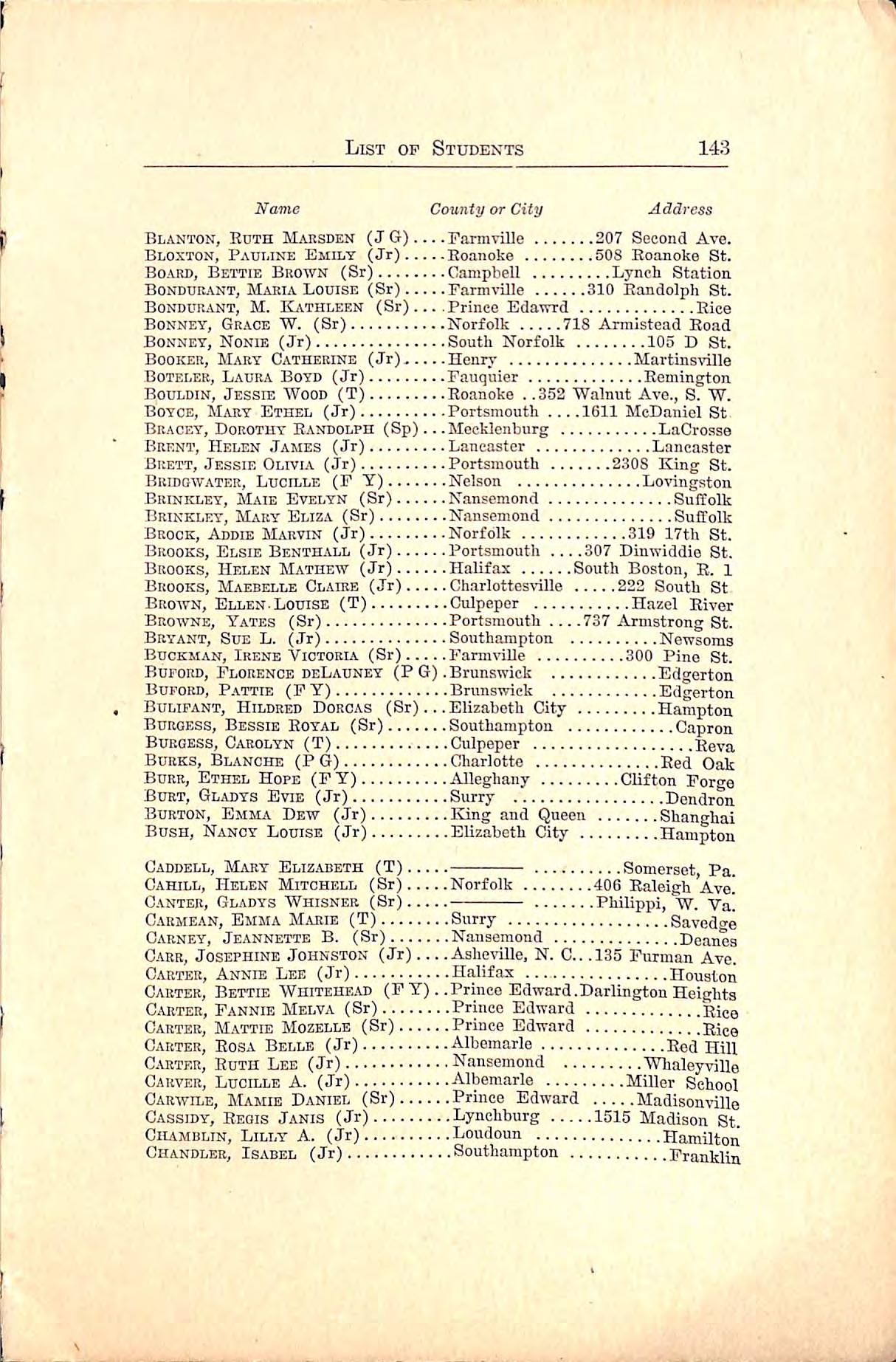
Address
Blanton,EuthMarsden(JG) .Farmville 207SecondAve. Bloxton,Pauune Emily (Jr) Eoanoke 508 Roanoke St. Board,BettieBrown(Sr) Campbell LyncbStation BonduPwVNT,MariaLouise(Sr) Farmville 310RandolphSt. Bondurant,M.KiS.THLEEN(Sr)....princeEdawrd Rice Bonney,GraceW.(Sr) Korfolk 718ArraisteadRoad BONNEY,Nonie(Jr) SouthNorfolk 105DSt. Booker,MaryCatherine(Jr)<....Henry Mavtinsidlle Boteler,LauraBoyd(Jr) Fauquier Remington Bouldin,JessieWood(T) Roanoke..352WalnutAve.,S.W. Boyce,MaryEthel(Jr) Portsmouth....1611McDaniclSt Bkacey,DorothyRandolph(Sp)...Mecklenburg LaOrosse Brent,HelenJames(Jr) Lancaster Lancaster Brett,JessieOlivia(Jr) Portsmouth 230SKingSt. Bridgwater,Lucille(FT) Nelson Lovingston Brinilley,MiMEEvelyn(Sr) Nanscmond Suffolk IlRiNKLEY,MaryEliza(Sr) Nanscmond Suffolk Brock,AddieMarvin(Jr) Norfolk 31917thSt. Brooks,ElsieBenthall(Jr) Portsmouth....307DinwiddieSt. Brooks,HelenMathew(Jr) Halifax SouthBoston,R.l Brooks,MaebelleClaire(Jr) Charlottesville 222SouthSt Brown,Ellen.Louise(T) Culpeper HazelRiver Browne,Yates(Sr) Portsmouth....737ArmstrongSt. Bryant,SueL.(Jr) Southampton Newsorag Buckman,Irene Victoria(Sr) Fann%'iUe 300 Pine St. Buford,Florence deLauney(PG).Brunswick Edgerton BuPORD,Pattie(FT) Brunswick Edgerton
Bulipant, Hildred Dorcas (Sr)...Elizabeth City Hampton Burgess,Bessie Royal (Sr) Southampton Capron Burgess,Carolyn(T) Culpeper Reva Burks,Blanche(PG) Charlotte RedOak Burr, Ethel Hope (FY) Alleghany Clifton Forge Burt,GladysEvie(Jr) Surry Dendron Burton, Emma Dew (Jr) King and Queen Shanghai Bush, Nancy Louise (Jr) Elizabeth City Hampton
Caddell, Mary Eliz^ujeth (T) Somerset,Pa. Cahill, Helen Mitchell (Sr) Norfolk 406 Raleigh Ave! Canter,Gladys Whisker(Sr) Philippi,W.Va! Carmean,Emma Marie(T) Surry Savedge Carney,JeannetteB.(Sr) Nansemond Deanea Carr,Josephine Johnston (Jr) Ashemlle,N.C...135 Furman Ave. Carter,AnnieLee(Jr) Halifax Houston Carter, Bettie Whitehe.\d (F Y)..Prince Edward.Darlington Heights Carter,Fannib Melva (Sr) Prince Edward Rice Carter, Mattie Mozelle (Sr) Priuce Edward Rice Carter, Rosa Belle (Jr) Albemarle Bed Hill Carter,Ruth Lee(Jr) Nansemond Whaleyville Carvf-r, Lucille A.(Jr) Albemarle Miller School Carwile, Mamie Daniel (Sr) Prince Edward Madisonville Cassidy, Regis Janis (Jr) Lynchburg 1515 Madison St. CiUMBLiN, Lilly A. (Jr) Loudoun Hamilton Chandler,Isabel (Jr) Southampton Franklin
Name
CountyorCity
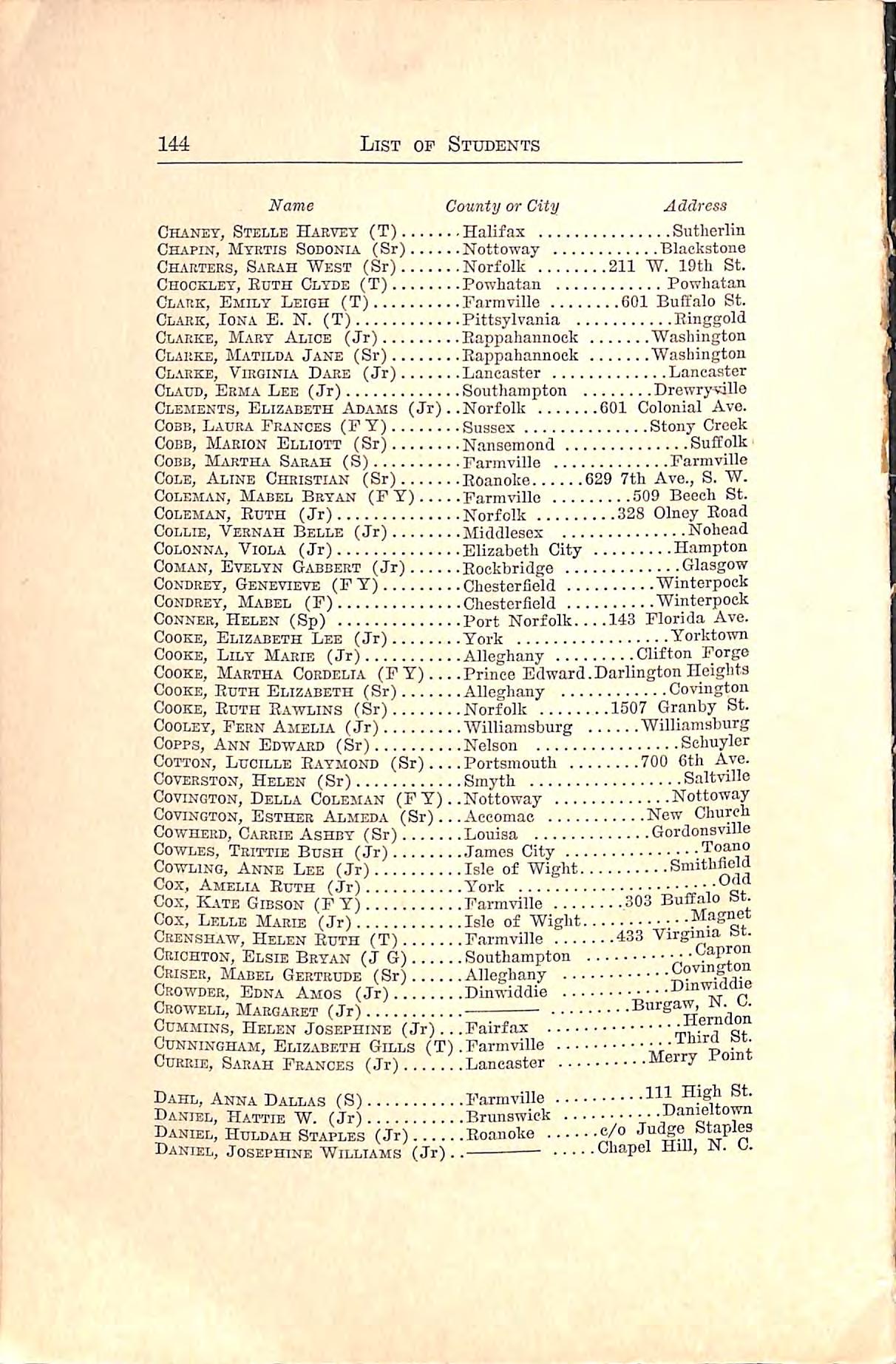
Address
ChaneTjStelleHarvey(T) Halifax Siitherlin Chapin,MyrtisSodonia(Sr) Nottoway Blackstone CHiVRTERS,SarahWest(Sr) ..Norfolk 211W.19thSt. Chocklet,RuthClyde(T) Powliatan Powhatan Clark,EmilyLeigh(T) Farmville 601BuffaloSt. CL.VRK,loNAE.N.(T) Pittsylvania Ringgold Clarke,Mary.i^iicE(Jr) Eappahannock Washington Clarke,MatildaJane(Sr) Bappahannock Washington Clarke,VirginiaDare(Jr) Lancaster Lancaster Claud,EemaLee(Jr) Southampton Drewry^lle Clements,ElizabethAdams(Jr)..Norfolk 601ColonialAve. CoBB,LauraFrances(FT) Sussex StonyCreek CoBB,MarionElliott(Sr) Nansemond Suffolk CoBB,Marth.^Sarah(S) Farmville Farmville Cole,AlineChristian(Sr) Eoanoke 6297thAvo.,S.W. Coleman,MabelBryan(FT) Farmville 509BeechSt. CoLEMAN, Ruth (Jr) Norfolk 328 Olney Road Collie, Vernah Belle (Jr) Middlesex Nohead CoLONNA,Viola(Jr) ElizabethCity Hampton CoMAN,Evelyn Gabbert (Jr) Rockbridge Glasgow Condrey,Genevieve(FT) Cbesterdeld Winterpock CoNDREY, Mabel (F) Chesterfield Winterpock Conner,Helen(Sp) Port Norfolk 143 Florida Ave. CooKE,Elizabeth Lee (Jr) York Yorktown COOKE,Lily Marie (Jr) Alleghany Clifton Forge CooKE, Martha Cordelia (FT) Prince Edward.Darlington Heights CooKE,Ruth Elizabeth(Sr) Alleghany Covington CooKE,Ruth Rawlins(Sr) Norfolk 1507 Granby St. CooLEY,Fern Amelia (Jr) Williamsburg Williamsburg Copps, Ann Edward (Sr) Nelson Scbuylcr Cotton, Lucille Raymond (Sr) Portsmouth 700 6th Ave. CovERSTON,Helen (Sr) Smyth Saltvillc Covington,Bella Coleman (FY)..Nottoway Nottoway Covington, Esther Almeda (Sr)...Aceomac New Church Cowherd,CarrieAshby(Sr) Louisa Gordonsville Cowles, Trittie Bush (Jr) James City Cowling, Anne Lee (Jr) Isle of Wight Smithficlu Cox, Amelia Ruth (Jr) York Cox,K-vte Gibson(FT) Farmville 303 Bulialo o ■ Cox,Lellb Marie (Jr) Isle of Wight Crenshaw,Helen Ruth(T) Farmville 433 Virginia Crichton, Elsie Bryan (J G) Southampton Criser, Mabel Gertrude (Sr) Alleghany Crowder,EdnaAmos(Jr) Dinviddie n Crowell,Margaret(Jr) Cummins,Helen Josephine (Jr)...Fairfax Cunningham, Elizabeth Gills (T).Farmville CuRRiE, Sarah Frances (Jr) Lancaster Merry Point
Dahl, Anna Dallas (S) Farmville fl' Daniel,Hattie W.(Jr) Brunswick V*'V Daniel,Huldah Staples (Jr) Eoanoke e/o Daniel,Josephine Williams (Jr).. Chapel BUi,in. Kj.
Name

CountyorCity
Address
Darden,RebeccaMoore(Jr) Southampton Franklin Dahden,VikginiaBruce(Sr) Nanseraond Driver Davis,LoisWinifred(Jr) Accomae "Wachaprcaguo Davis,LucyAlice(Sr) Middlesex Regent Davis,NevaEstelle(Sp) Apponiattox Pauiplin Deatherage,MargaretA.(T) Hcnrico Elko Derr,AnnaLawence(Sr) Roanoke 535CampbellAvc. Dickinson,MildredW.(T) PrineeEdward..Hampdcn-Sidney DiEiiL,DorothyNevin(F) Farmville 401HighSt. DiGGS,CordeliaSarah(Jr) ElizabethCity Hampton DixoN,AnnieGill(S) Farmville 309BeeehSt. Dodson,SudieElizabeth(Jr) Pittsylvania Dannillc,R.2 Dolen,BerthaGladys(Sr) Nelson Wingina Doll,Virginia(F) Fannville SerpcllHeights Dkumeller,Lee(Sr) Farmville 408SecondSt. Drumeller,Louis(Sr) Farmville 408'SecondSt. Dugger,GraceLovelyn(Sr) Farmville 206SecondAvo. Duncan,GladysPearl(Sr) Giles Ripplemeacl Duncan,Naomi(Sr) Ljmchburg 606ChurchSt. Dunton,Hope(Sr) Northampton Nassawaddox Dunton.VedraOnslow(Jr) Northampton Wicrwoorl Dyer,EstherChism(Jr) Danville 839StokesSt.
Eakin,BeatriceMarguerite(Jr)..Roanoke 617RoanokeSt. Early,Ethel(Jr) Norfolk Portsmouth,R.2 Easterday,ArahGay(Jr) PrinceEdward...Farmville,B.D. Eberwf.in,BessieTalmace(Jr)...Portsmouth Portsmouth Edmunds,IndiaP.(Jr) Farmnllc 201HighSt. Edmunds,KatieFleming(Sr) Lynehlnirg IllMadisonSt. Edmunds,Nora C.(Jr) Dinwiddio Champe Edwards,ElsieIrvin(FY) HingWilliam Palis Ellis,KatherineBlack(Jr) Hanover Ashlan<] Elmore,MaggieVirginia(FY) .Brunswick Alberta Elswick,ClotuildeH.(Jr) 'WUliamson.W.Va. Embrey,SadieOlen.v(Jr) Fauquior Morrisville Emory, Annie M.vrie (Jr) Hceklenhurg Chase City EUBANK,Alice(Jr) Bedford BedfordCitv Eutsler,Isabel(Jr) University ParkPlace Eustler,LoisElizabeth(Sr) University ParkPlace Everett,Alice Elizabeth(Jr) Southampton Newsonia Ewell,LaureSusanL.winia(Jr).Greene Buckersville
Fagg, Melville M.vrie (Jr) Montgomery Cambria Fannin, Maria Louise (Jr) Sussex Stony Creek Fereuee,Marguerite LeClere(Jr).Norfolk Gilmcrton Ferguson,Clara Maye(T) Farmville 213 Vcnable St. Fergu.son, Lillian Tena (Sr) Southampton Boykiim Field, Katherine (Jr) Norfolk 219 39th St. Finoii, Helen Pretlow (Jr) Nanseinond SufTolk Fitzgeilvld. Martha (FY) Richmond 114 E. Gary St Fitzp.vtrick, Lona Mittie (SP) Buckingham Diilwyii Forbes, Elizabeth Venable (T) Buckingham Andersonvillo Forbes, Nannie Lucille (Jr) Norfolk 43Second St
Name
CountyorCity
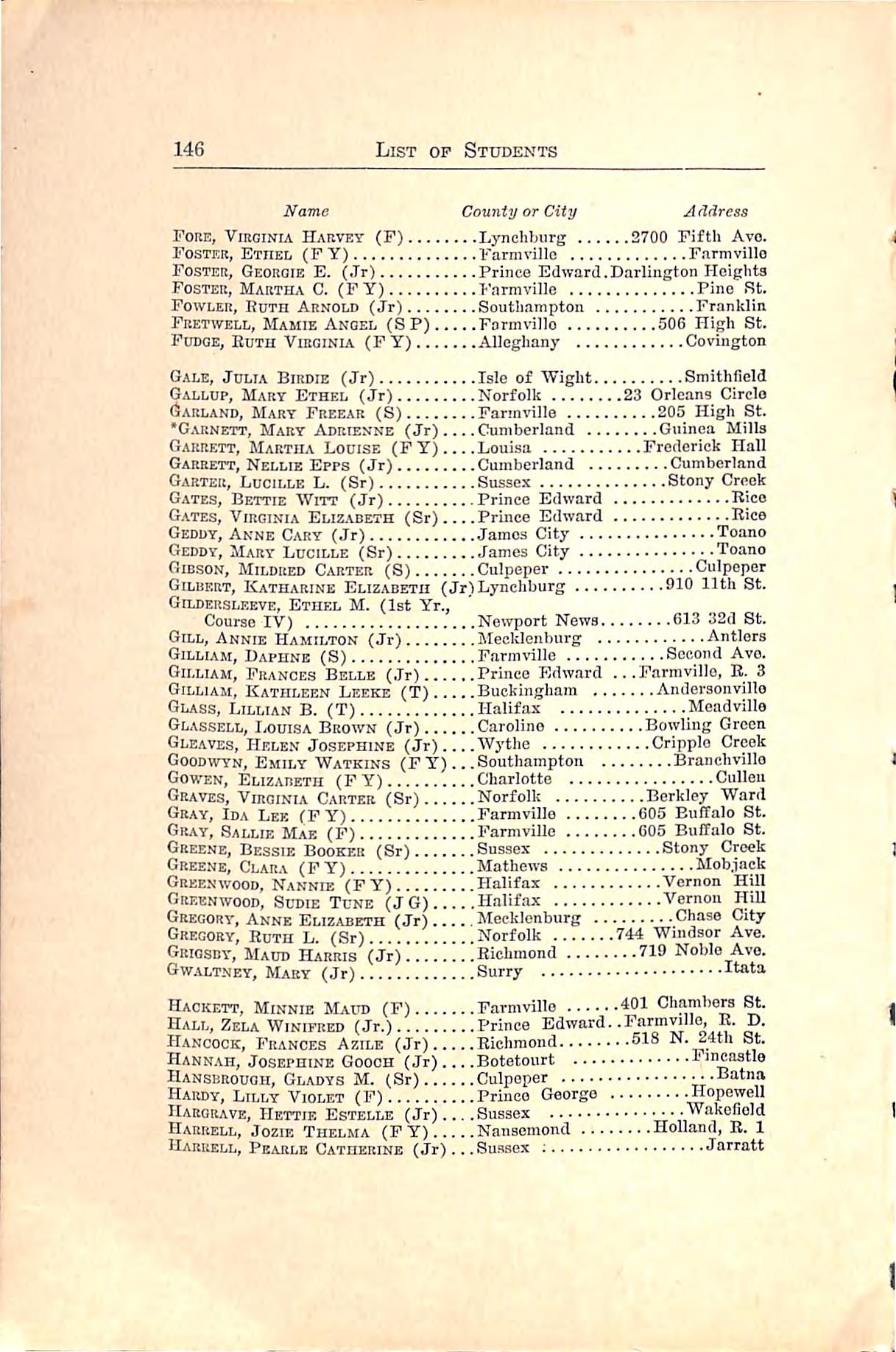
Address
Foue,ViRGiNrAHarvey(F) Lynchbiirg 2700FifthAvo.
Foster,Ethel(FY) Farm%'illc Farmvillo
Foster,GeoroieE.(Jr)
PrinceEdward.DarlingtonHeigbta
Foster,MarthaC.(FY) FarmvIHe PineRt. Fowler,RuthArnold(Jr) Southampton Franklin Fretwell,MamieAngel(SP) Farmvillo 506HighSt. Fudge,RuthVirginia(FY) Alleghany Covington
Gale,JultaBirdie(Jr) IsleofWight Smithfield
Gallup,MaryEthel(Jr) Norfolk 23OrleansCircle
Garland,MaryFreear(S) Farmville 205HighSt. 'Garnett,MaryAdrienne(Jr)....Cumberland GuineaMills
Garrett, Martha Louise(FY)....Louisa Frederick Hall
Gareett,NellieEpps(Jr) Cumberland Cumberland
Garter,Lucille L.(Sr) Sussex Stony Creek
Gates,BettieWitt(Jr)
PrinceEdward Rico
G.ates, Virginia Elizabeth (Sr)....Prince Edward Rice
Geddy,Anne Gary(Jr) James City Toano
Geddy,Mary Lucille (Sr) James City Toano
Gibson, Mildred Carter (S) Culpeper Culpoper
Gilbert,Katharine Elizabeth (Jr)Lynchburg 910 11th St.
Gildersleeve,Ethel M.(1st Yr., Course IV)
Ne\vport News 613 32d St.
Gill,Annie Hamilton(Jr) Mecklenburg Antlers
Gilliam,Daphne(S) Farmville Second Avo.
Gilliam,Frances Belle (Jr)
Prince Edw.ard ...Farmvillo,R.3
Gilliam, Kathleen Leeke (T) Buckingham Aiulersonvillo
Glass, Lillian B.(T)
Glassell, liOUisA Brown (Jr)
Halifax Meadvillo
Caroline Bowling Green
Gle.\ves, Helen Josephine (Jr)....Wythe Cripple Creek
Goodwyn, Emily Watkins (P Y)...Southampton Branehvillo
Gowen, Elizabeth (FY)
Graves,Virginia Carter(Sr)
Gray,Ida Lee(FY)
Gray,Sallie Mae(F)
Greene,Bessie Booker (Sr)
Charlotte Cullen
Norfolk Berkley Ward
Farmville 605 Buffalo St.
Farmville 605 Buffalo St.
Sussex Stony Creek Greene, Clara (FY) Mathews Mobjack Greenwood, Nannie (FY)
Halifax Vernon Hill
Halifax Vcrnon Hill Greenwood,Sltjie Tune(JG)
Gregory,AnneElizabeth(Jr) Mecklenburg Chase City Gregory, Ruth L. (Sr)
Norfolk 744 Windsor Ave. Grigsby, Maud Harris (Jr) Richmond 719 Noble Ave. Gwaltney, Mary (Jr)
Surry Itata
Hackett, Minnie Maitd (F) Farmville 401 Chambers St. Hall, Zela Winifred (Jr.)
Prince Edward..Farm^llc. R. D. Hancock,Frances Azile (Jr) Richmond 518 N.24th St. Hannah,Josephine Gooch (Jr)....Botetourt Tincastle IIansbrouoh,Gladys M.(Sr) Culpeper Hardy,Lilly Violet(F)
Prince George .Hopewell Hargrave, Hettik Estelle (Jr)....Sussex .Wakefiold Harrell, JoziE Thelma (FY) Nanaemond Holland, R. 1 Uaruell, Pearle Catherine (Jr)...Sussex Jarratt
Name

CountyorCity
Address
HAiiiwa,AnneElizabeth(Jr) PrinceEdward Pamplin,R.2 Habrib,HelenSweeten(Sr) Staunton 312BerkeleyPlace Harris,Pili.e(Jr) Farm%ille 510S.MainSt. Harris,RuthWalker(Jr) PrinceEdward....Pamplin,R.2 Harris,SophieH.(Jr) Brunswick Nipper Hart,Martha Jane(S) Faniivillo Main St. Harvey,IdaAllen(Jr) Charlotte DrakesBranch Hatch,Ruth Rimer (Jr) Charlotte Drakes Branch Hawkes,EssieMarie(S) Nottoway Wilson Haves,AileenFrances(Sr) Gloucester Bona Henderson, Josie (Jr) Halifax Paces Hendricks,LouiseVirginia(JG).Surry Dendron Hester,MaryLeCompte(Sr) Lynchburg 1415FilmoroSt. Hiaii,MargaretPinder(Sr) Whitoville,N.C. JIiner,Jonnie J.(Sr) Staunton 21 W.Main St. Hours, Essie Marie Greenville Brink Hodges,LillianGrace(Jr) Norfolk Hickory Hoge,MaryKatherine(FY) Giles Hoge'sStore Holloway,AgnesViZELLA(FY)...York Mcsaick Hollowell,BirdieElizabeth(Jr).Norfolk Portsmouth,R.3 Holt,HallieMiller(FY) PrinceEdward GreenBay IIOLT,JuliaS.T.(Sr) ElizabethCity Hampton Horton,HelenWilson(Sr) Southampton Whaloyville Howard,Letitia Conway (Sr) Pnlaski Dolton Howard,RuthCatherine(Sr) ElizabethCity Hampton Howl,Hattie(S) Amherst Staplcton Hudgins,RuthDiggs(Sr) Mathows PortHaywood Hunt,FlorenceVirginia(Jr) Farmville 308VirginiaSt. Hutchins,Mary Rouse(Sr) Portsmouth ..906 Washington St.
Inman, Nolia Travis (Jr) Williamsburg "Williamsburg Irving, Lucy Taylor (S) Farravdlle 1001 High St.
Jackson,Gwendolyn(Sr) Lynchburg 1119FilmoroSt. James,IrmaIngliss(Jr) Petersburg Box184 Jenkins,MyrtieOdellb(T) IsleofWight Carrsville Jesser, Margaret (Sr) Alleghany Covington Johnson,GraceE.(Sr) Bedford StowartsWllo Johnson, Gypsie (Sr) Wythe Wytheville Johnson,LottieM.(Sr) Accomac NewChurch .louNSON,NolaElizabeth(Jr) Norfolk Churchland Johnson, Virgie Marie (Sr) Princess Anne ....Norfolk, R. 4 Jones,Blanche Katherine(FY)..Lunenburg Tree Jones, Eva Addison (Sr) Craig New Castle Jones,Janik Elizabeth (F) Farmville Second St. Jones,Rosa Mae (Jr) Farmville Second St JoYNER,Gladys E.(FY) Isle of Wight Windsor
Kayton,Agatha Lee(F) Farmville 110 High St Kellam,Jessie Marie(Sr) Warwick Morrison Kellam, Mary Garland (Sr) Princess Anne ....Princess Anne Kent, Edna Withers (Jr) Fluvanna Kents Store •Kbrnan,Mary Kremer(Sr) Wythe Rural Retreat
Name
CountyorCity

Address
Key,JuliaGraham(Sr) Alleghany CliftonForge KicE, Laura Cottrell (Sr) Stauntoii ....115 Thomroso Avo. Kirkpatrick,Margaret(Sr) Mathews Mathews Knightley,NoraAgnes
Frances(Sr) AUoghany LowMoor Koiner,FrancesGivens(T) Bedford ForestDepot Kootz,Rachel(Jr) Portsmouth...601WashingtonSt.
L.VKE,Elizabeth(Sr) ElizabethCity Hampton Lambert,IvEYMaud(FY) Dinwiddie Blackstone Lancaster, Mary (1st Tr., Cour.seIV) Farmvillo Oak St. •Lane,MarthaElma(Jr) Surry Elberon Langlieb,Bertha(Sr) Richmond 1812E.MainSt. Lawson,FloraE.(T) Campbell Brookneal Layne,NellieReynolds(FY)....Goochland Cardwell Lea,MargaretInza(Jr) Danville Danville Leach,Ella(Jr) ...Sink'sGrove,W.Va. Leary,IrmaS.(Sr) Norfolk Gilmcrton Lee,FrancesGertrude(Jr) ElizabethCity Hampton Lee,Mildred(Jr)
ElizabethCity Hampton Leech,EvaWhitcomb(Jr) Alleghany CliftonForge Leech,Margaret(Jr) Rockbridge Murat Lefflek,EstherDorsey(Jr) Mathews WilliamsWharf Lewis,Elizabeth(1stYrCourserV)FarniviIIe 503BuffaloSt
Lewis, Mary Bernard(T) Farmville 503 Buffalo St.
Lewis, Mary Bolling Gantt(Jr)..Albemarle Howardsville Ligon,Imogen G.(Jr) Cumberland ....Farmville. R. D. Lindsey, Mary E. (T) Farmville Bridge St. Linton,MarianRobeson(Sr) Monesscn,Pa. Lipscomb, Frances Louise(F Y)..Naiisemond Suffolk Lipscomb, Eebekah Banks (F) .Farmville Bridge St. Lloyd, Evelyn Causey (Jr) Nansemoiid Suffolk LocKi\RD, Annie Belle (Jr) Alleghany Covingtoii Locke, Louie Davis (Jr) Portsmouth 422 Gladow St. Lovelace,Evelyn Hurt(Jr) Halifax Vcrnon Hill Loving, Annie Hartwell (Sr) Nelson Lovingston Lowe,Laura Jeane(F Y) Fairfax Falls Church Lundie, Eugenia (Sr) Danville 519 Jefferson Ave.
McBurney, Ceola Beverlet (Sp). Edward...Farmville, E. D. McCalmont, Aldona (T) Cumberland Farmville, R. 1 McClung, J. Ernestine (Jr) Allegliany Covington McConkey, Mattie Lee (Jr) Montgomery Blacksburg McCorkle. Susie Y.(T) Lynchburg..The Courtland No. 30 McCraw,Dorothy Burwell(F Y) Halifax Nathalie MgCraw,Elizabeth Sydnor (Jr)..Halifax Nathalie McCue, Margaret Shirley (F Y)..Albemarle ...........Greenwood Maclin, Elvira (Sr) Norfolk 1015 Colonial Avo. Main, L. Rosalie (Sr)!.! Norfolk ..735 37th St. Makeley, Elsie Adams (F Y) Henrico Richmond, R. 3 Malcolm, Elizabeth C. F.(2d Yr, Course IV) Lynchburg 1715 Grace St.
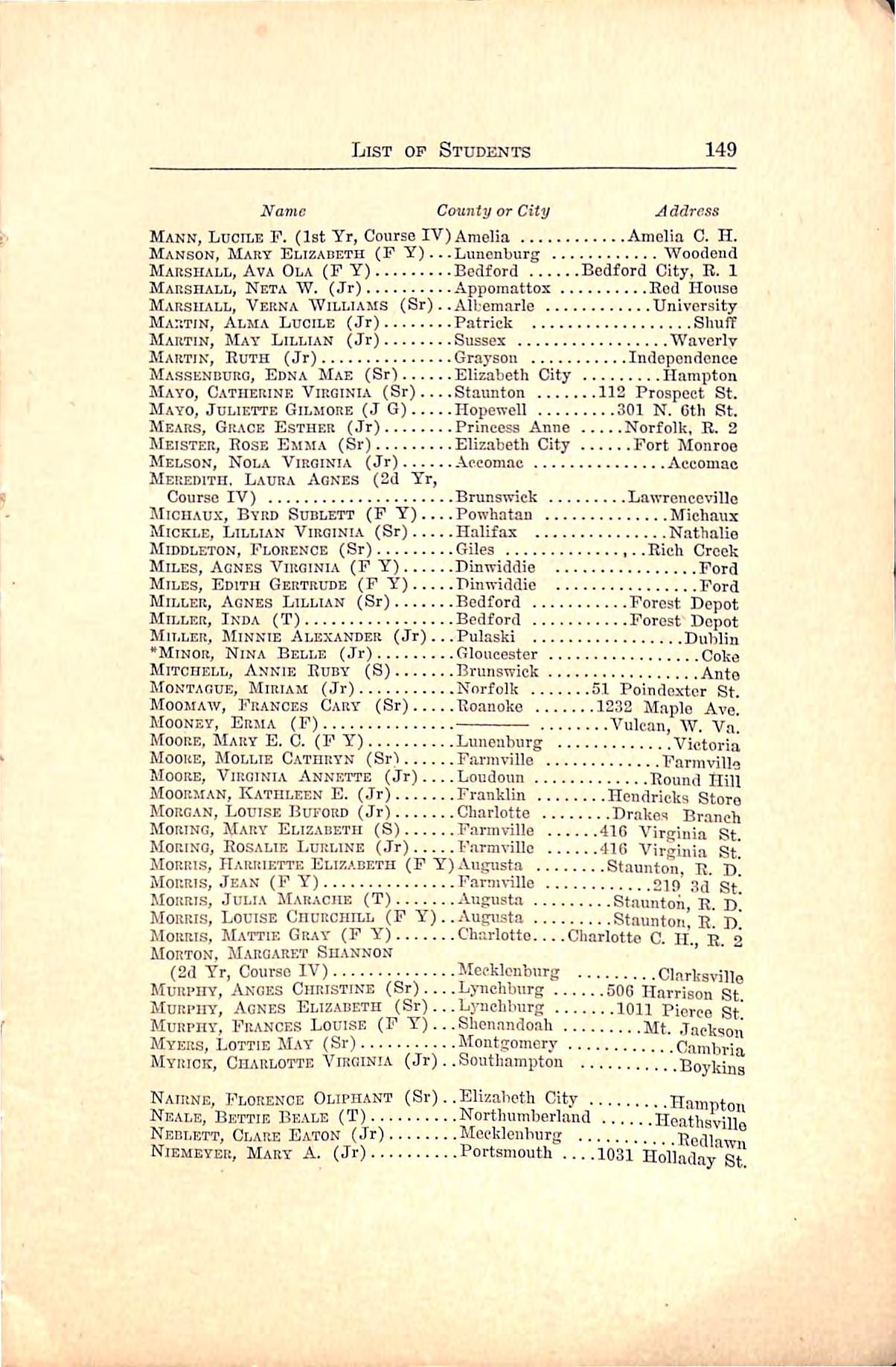
Navic CmintyorCity Address
Mann,LucileF.(IstYr,CourseIV)Amelia AmeliaC.H. Manson,MartElizaueth(FY).Lunenburg WooclGiid Marshall,AvaOla(FY) Bedford BedfordCity,B.1 Marshall,NetaW.(Jr) Appomattox BodHouse Marshall,VernaWilliams(Sr)..AlLemarle University Martin, Alma Lucile (Jr) Patrick ShufF Martin,MayLillian(Jr) Sussex Waverlv Martin,Buth(Jr) Grayson Independence Massenburg,EdnaMae(Sr) ElizabethCity Hampton Mayo,CatherineVirginia(Sr)....Staunton 112ProspectSt. Mayo,JulietteGilmore(J6) Hopewell 301N.GthSt. Mears, Grace Esther (Jr) Princess Anne Norfolk, B.2 Meister,BoseEmma(Sr) ElizabethCity FortMonroe Melson, Nola Virginia (Jr) Accomac Accomac Meredith.LauraAgnes(2dYr, CourseIV) BrunsTvick La^vTenceville Micuaux,ByrdSublett(FY)....Powhatan Michaux Mickle,LillianVirginia(Sr) Halifax Nathalie Middleton,Florence(Sr) Giles BichCreek Miles,AgnesVirginia(FY) Dinwiddie Ford Miles,EdithGertrote(FY) Pinwiddie Ford Miller, Agnes Lillian (Sr) Bedford Forest Depot Miller,Inda(T) Bedford ForestDepot Miller, JIinnie Alexander (Jr)...Pulaski Dublin "Minor,NinaBelle(Jr) Gloucester Coke Mitchell,AnnieBuby(S) Brunswick Ante Montague,Miriam(Jr) Norfolk 51PoindextcrSt.
Moomaw, Frances Gary (Sr) Boanoke 1232 Maple Ave. Mooney, Erma (F) Vulcan, W. Va
Moore,MaryE.C.(FY) Lunenburg Victoria Moore,MollteCathryn(Sr) Fannville Farmville
Moore, Virginia Annette (Jr) Loudoun Bound Hill
Moorman,Kathleen E.(Jr) Franklin Hendrieks Store
Morg.\n,LouiseBukord(Jr) Charlotte DrakesBranch
Moring, Mary Elizabeth (S) Fannville 416 Virginia St
Moring, Kosalie Lurline (Jr) Farmville 416 Virginia St' Morris, Harriette Elizabeth (PY)Augusta Staunto7i, B. d' Morris, Jean (F Y) Farnn-ille 219'3d St
Morri.s, Julia Mauache(T) Augusta Staunton B.D* Morris, Louise Churchill (F Y)...Vugusta Stauntoiu e! D* Morris, Mattie Gray (F Y) Charlotte Charlotte C. if. E 2 Morton,MargaretShannon (2d Yr, Course IV) Mecklenburg Clarkaville
Murphy, Anges Christine (Sr) Lynchburg 506 Harrison St Murphy, Agnes Elizabeth (Sr)...Lynchburg loii Pierce St' Murphy, Frances Louise (F Y)...Sbennndoah jjt. Jaeksoti Myers, Lottie May (Sr) Montgomery Cambria Myrick, Charlotte Virginia (Jr)..Southampton Boykins
Naiune, Florence Oliphant (Sr)..Elizabeth City Hampton Neale, Bettie Beale (T) Northumberland Eoathsville Nebi.ett, Clare Eaton (Jr) Mecklenburg Bedlawn Nibmeyer, Mary A. (Jr) Portsmouth 1031 Holladay St
Name

CountyorCity
Address
Nobl,MaryMilton(Sr) Alleghaiiy Covington NovECK,Ida(Jr) PrinceGeorge Hopcwell Nucnols,AudreyAdline(Sp) Goochlaud JohnsonSprings NucKOLS,Bernicb (Jr) Heiirico Glen Allen Nuckols,GdeldaClarke(Jr)....Henrico RioVista
Oakes,Irene(Jr) Campbell Gladys Obenschain,AnneLillun(Sr)...Roanoke 40714tliAve.,S.W. Olgers,FarrallBurnell(Sp) Dinwiddle Sutherland Oliver,CallieFrances(Jr) Montgomery Elliston Oliver,GladysEureka(FY) Nansemond Suffolk,B.4 Omoeundro,MargaretVanLew (Jr) Richmond 3003FloydAve. O'Neal,LelaBanner(IstTr, CourseIV) Amelia Chula OsBORNE,MartRedd(T) Halifax Paces Overton,JessieBlair(Sr) PrincessAnno Norfolk,R.2 Owen,FannieElizabeth(Jr) Sussex StonyCreek Owen,Louise(Sr) ElizabethCity Hampton Owen,Selma(Sr) Lynchburg....860VictoriaAve.
Page,LillianElizabeth(Jr) York Messick Painter, Mary Gertrude (Jr) Smyth Marion Pannill,KatherineL.(Sr) Henry Martinsville Parker,Cornelia Coleman (Jr)....Nansemond Cypress Cliapol Parker,MyrtleCarey(Sr) Portsmouth...642RivorviewAve. Parsons, Dorris Mae (F Y) Sussex Upson Paulette, Viva Etta (Sr) Farmville 610 Oak St. Payne,Pearl Alma (Sr) Mecklenburg Marengo Pearson,Clara Geneva(Sr) Loudoun Hamilton Peck, Jessie Jerome (Jr) Alleghany Covington Peek, Janet Hope (Sr) Elizabeth City Hampton Peele, Mary Emily (Sr) Portsmouth 528 Glasgow St. Pettit,CarrieB.(S) Fluvanna BremoBluff Pettit,MaryGoodwin(Sr) Nelson Roseland Pharr, Mary Lillian (F Y) Gap Mills, W.Va, Phillips,Helen(Jr) Aeeomac Wachapreagua Pickett, Bessie Frances (F Y)...Prince Edward Worsliam Ponton,Mart Annie(Jr) Charlotte Ontario Powers,Blanche (Jr) Norfolk Northwest Preston, Mary (Jr) Botetourt Amsterdam Price,Marie Willis (Jr) Pittsylvania Prillaman,NaomiEsther(Sr)....Franklin PitivoTT, Carrie Pansy(Jr) Nansemond PROSISE, Laura Louise (S) Dinwiddie Wilson Puckett,Rosa E.(Jr) Russell •-Llway Puckett, Sue Virginia (F) Chesterfield Winterpock PuGH, Elizabeth Howlette (Sr)...Mathews .Mathewa PuGu,Irene Marshall (Sr) Charlotte .Madisonville PuRDY, Harriett Cazenove (P Y)..Brunswick Lawrencovillo
Putney, Alice Elia (Jr) Farmville 520 Main St. Putney,Edna Elizabeth(F Y)...Farmville 520 Mam St.
Name

CountyorCity
Address
Eaiks,BESsm Lee(Jr) Mathcws Bolumnon Ramsey,VelmaCaldwell(Jr) Franklin Henry Eanson,RothHendricks(Jr)....Farmville SerpellHeights Rawles,DaphneViola(FT) Nansemond Holland Rawlings,SalliePalmer(Sr) Norfolk 430RedgateAve. Ray,EvelynJones(FY) Amherst PedlarMills Read,LucileCaPvRINGTON(Jr) Henry Spencer Reese,DorothyAdele(Jr) Southanipton Caproii Reynolds,MaryL.K.(Jr) Montgomery Elacksburg Reynolds,RuthAnne(Sr) Montgomery Elacksburg Rice,IrmaMcNair(Jr) Farmville 211VenableSt. Rice,MaryRitchie(S) Farmville 211VenableSt. RtCHAiujsoN,EllaSmith(T) Buckingham DianaMills Richardson,Hettie(T) Farmville HighSt. Richahdson,MaryRives(T) Farmville 307BuffaloSt. Richardson,VirginiaS.(Jr) Farmville 307BuffaloSt. RiDDiCK,SelmaElberta(Jr) Nansemond 'Whaleyvjlle Riddle,Catharine(2dYr, CourseIV) Norfolk D.RaleighSquare Risque,NormaWinifred(Jr) BuenaVista BuenaVista Rives,MaryEthel(Sr) Norfolk 819RedgateAve. Roberson,WinifredWills(S) Norfolk VirginiaBeach Roberts,CarrieLove(Jr) Nansemond Whaleyville Roberts,SarahElizabeth(FT)..Charlotte Madisouvillc Robertson,AlmaLeoline(Sr) Norfolk 52436thSt. Robertson,EurithE.(Jr) Northumberland Sunnybank Robertson,FrancesBland(Jr)..Nottoway Blackstone Robertson,HattieF.(Sr) Appomattox SpoutSpring •Robins,LucyGertrude(Jr) Gloucester GloucesterPoint Robinson, Eva Estelle (T) Brunswick Dolphin Robinson,MarianPearl(IstYr, CourseIV) NewportNews....NewportNews Robinson,RuthBland(Sr) Wise Appalachia Rogers, Elsie May (Jr) Nansemond Whaleyville Rollins, Josephine (Jr) AJleghany Covington RowLETT,MaryLouise(Jr) Amelia Clmla RuDD, Evelyn Me.vde (S) Pittsylvania Danville, R. *3 Rust,Julia Elizabeth (Jr) Warren Front Royal Sandidge,MarySnead(Sr) Lynchburg 2613FifthSt. Sargent,Endia Moss(T) Buckingham Warren Scheie. Inger Sophia (Jr) Williamsburg Williamsburg SCHMITZ,Etta M,\rgarette(F T)..Louisa Mineral Serpell, Ruth (Sr) Belington, W. Va. Seward, Geobgie Mae (Jr)^ Surry Elberoii. SiiEAN, L.avonia Eunice (Sp) Luncuburg Gary Sheild,CatherineHoward(FY)..York Yorktown Shepherd, Helen (Jr) Pittsylvania Chatham Sheppard, Cora Lee (Jr) Goochlaiid Cardwell Shield, Alma Lee (Jr) Elizabeth City Hampton Short, M.\ry Blanche (Jr) Greenville Purdv Shorter,Alma Edith (Sr) Charlotte Charlotte C.H R o Shumate, Elizabeth Garrett (Jr).Henry Bass'ett
Name
CountyorCity
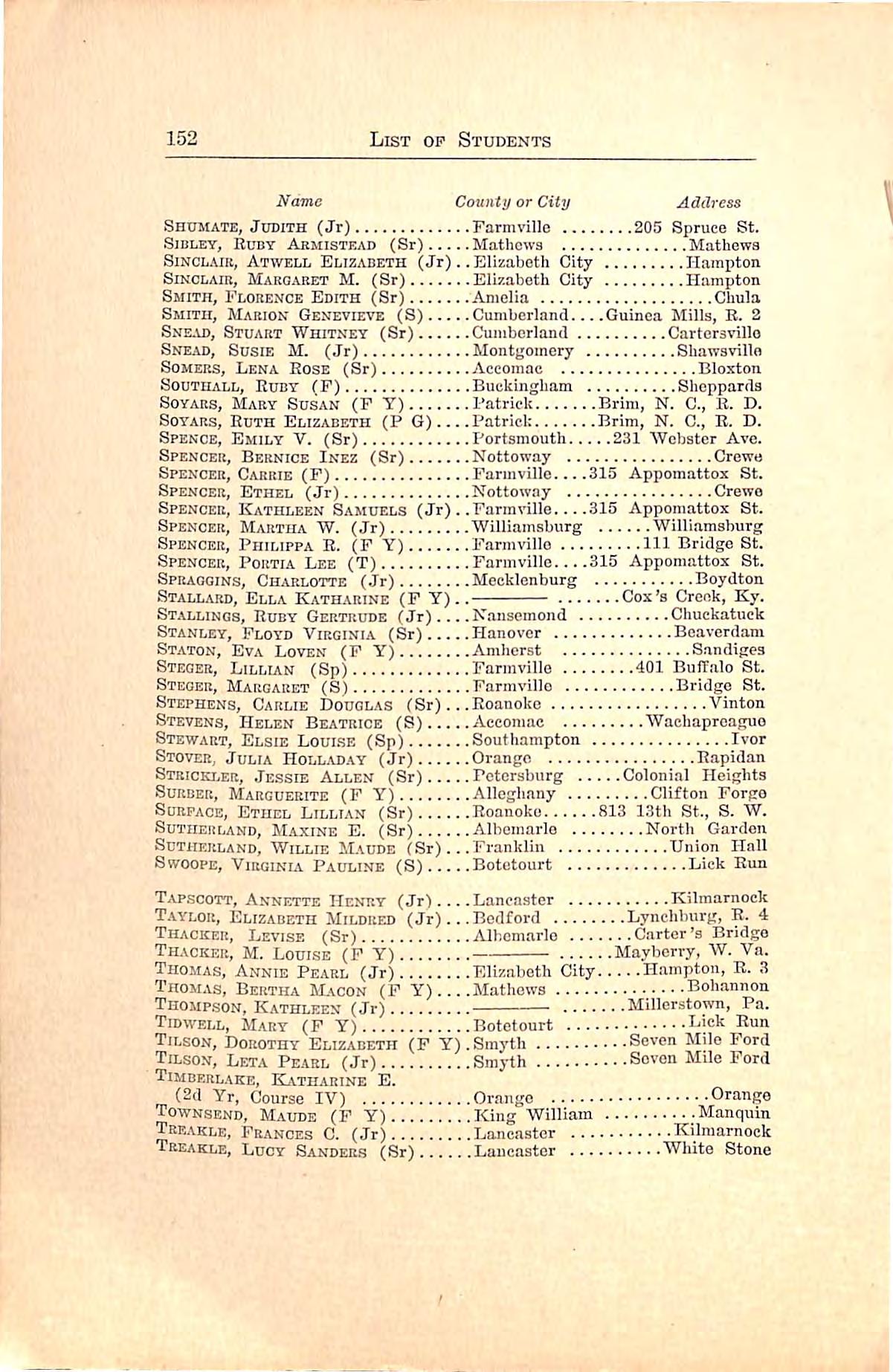
Address
Shumate,Judith(Jr) Farmville 205SpruceSt. Sjbley,RubyArmistead(Sr) Mathcws Matliewa Sinclair,AtwellElizabeth(Jr)..ElizabethCity Hampton Sinclair,MargaretM.(Sr) ElizabethCity Hampton
Smith,FlorenceEdith(Sr) Amelia Cliula Smith,MarionGenevieve(S) Cumberland GuineaMills,E.2 Sne.\d,StuartWhitney(Sr) Cumberland Cartersvillo Snead,SusieM.(Jr) Montgomery Shawsvillo SoMERS,LenaRose(Sr) Aceoinac Bloxton SouTHALL,Ruby(F) Buckingham Siicppards SoYARS,MarySusan(FY) Patrick Brim,N.C.,R.D. SoYARS,RuthElizabeth(PG)....Patrick Brim,N.C.,R.D. Spence,EmilyV.(Sr) Portsmouth 231WebsterAve. Spencer,BerniceInez(Sr) Nottoway Crewo Spencer,Carrie(F) Farmville....315AppomattosSt. Spencer,Ethel(Jr) Nottoway Crewo Spencer,KathleenSamuels(Jr)..Farmville....315AppomattoxSt. Spencer,MarthaW.(Jr) Williamsburg Willlamsburg Spencer,PhilippaE.(FY) Farmville IllBridgeSt. Spencer,Portia Lee (T) Farmville 315 Appomattox St. Spraggins,Charlotte(Jr) Mecklenburg Boydton Stallard,EllaKatharine(FY).. Cox'sCrcnk,Ky. Stallings,RubyGertrude(Jr)....Nansemond Chuckatuck Stanley,FloydVirginia(Sr) Hanover Beaverdam Staton,EvaLoven(FY) Amherst Sandiges
Steger, Lillian (Sp) Farmville 401 BufTalo St.
Steger,Margaret(S) Farmville BridgeSt. Stephens, Carlie Douglas (Sr)...Eoanokc Vinton Stevens,HelenBeatrice(S) Accomac Wachaproaguo Stewart,Elsie Louise (Sp) Southampton Ivor Stover,JuliaHoll.\j)ay(Jr) Orange Rapidan Stricki.er, Jessie Allen (Sr) Petersburg Colonial Heights SuRBER, Marguerite (F Y) Alleghany Clifton Forge Surface, Ethel Lillian (Sr) Roanoko 813 13th St., S. W. Sutherland, Maxine E.(Sr) Albomarle North Garden Sutherland, Willie Maude (Sr)...Franklin Union Hall Swoope, Virginia Pauline(S) Bototourt Lick Run
Tapscott,Annette Henry (Jr)....Lancaster Kilmarnock Taylor, Elizabeth Mildred (Jr)...Bedford Lynchburg, R. 4 Thacker, Levise (Sr) Alhcmarlo Carter's Bridge Thacker,M.Louise(P Y) Mayberry,W.Va. Thomas,Annie Pearl(Jr) Elizabeth City Hampton,R.3 Thomas,Bertha Macon (F Y)....Mathows ,...Bohannon Thompson,Kathleen(Jr) Mlllorstown, Pa. Tidwell, Mart (F Y) Botetourt Lick Run Tilson,Dorothy Elizabeth(F Y).Smyth Seven klile Ford Tilson,Leta Pearl(Jr) Smyth Seven MileFord Timberlake, K^vtharinb E. (2d Yr,(Jourse IV) Orange Orange Townsend, Maude (F Y) King William Manquin Treakle, Frances C. (Jr) Lancaster Kilmarnock Treakle, Lucy Sanders (Sr) Laucaster White Stone
Name CountyorCity

Address
Tucitt,DorothyHAZEiiEiTE(Sr) .Nansemond Suffolk Tuck,GladysGrant(Jr) Durham,N.C...411ClevelandSt. Tucker,AlmaDuane(T) Dinn-iddie ChurchRoad Tucker,BessieEdrington(Jr)....Alleghany Covington Tucker,GladysThornton(Sr)...Alleghany CliftonForge Tucker,MargaretJ.(Jr) Brunsnvick Warficld Tudor,MarelIrene(T) Patrick Critz Turner,AltaVashti(Sr) Southampton Drewryvlllo Turpin,AnnieFord(Sr) Mecklenburg *....Boydton Tdtwiler, Olivia Camm (Jr) Montgomery Blacksburg
Upson,MaryEmily(Sr) Roanoko Vinton
Vaden,CarrieLouise(Sr) Pittsylvania Gretna Vaiden,Victoria(T) Famivillo 401VirginiaSt. Vaughan,MargaretS.(Jr) Goochland Cardwell Venable,Jacqueline(S) Fannvillo pineSt. Vest,RuthJ.W.(Jr) Mecklenburg Clarksvillo Via, Annie Louise (P T) Henry Philpott
Wade,Elizabeth (P T) Montgomery Elliston Wainwright, Margaret L.(Jr) York Daj.Q Walker, Addie Cato (Jr) Greens\'iUe Emporia Walker, Grace Sale (Sr) Bedford Bedford City Walker, Mary Linda (Jr) Mecklenburg Skipwith Walker,Margaret (Jr) Nottoway Blackstono Wall,Virginia Langhorne(P)....Parraville 403 High St.
Ward, Grace Lee(T) Princess Anno Pontrcas Warrtner, Helen Worsham (Jr)..Amelia Jetersvillo Watkins,Katiierine (Jr) Pannville 703 High St
Watkins,Nancy(F) Farmville 214 First Ave
Watkins,Princess E.(Jr) Farmville Sorpoll Heights
Watkins,Rozema F.(F Y) Prince Edward..Hampden-Sidnoy
Watt, Ellen F. (Jr) Norfolk 205 Pine St
Webb, Gussie (F Y) Sussex Stony Creek
Welciions. Elsie JIaude (F Y) Charlotte Formosa
Wells,Agnes Eliz.abeth(F Y) Farmville 401 Chambers St
Wells, Dorothy Chatman (S) Farmville 40l Chambers St'
Wells, Grace Estelle (Jr) Prince Edward Worsham Wkssells, Ida Gill (Jr) .\ccomac Parkslcy Witaley, Julia Gladys (Jr) Northumberland.Wicomico Church
White, Bernice Elizabeth (Jr)...Mathews Bolmnnon
White, Edna Elise (Jr) Albemarle jj-j.
White,Fi.orabel D.(F Y) Charlotte Ontario
White, Mary Ellen (Sr) Portsmouth 424 North St
White, Mary Susie (Jr) Buckingham Oro Bank
White, Zerei.da (T) Bedford Stcwavtsvillo
Whitehrad, Miriam (Sr) Princess Anne Norfolk, R. 2
WiiiTEHORN, Annie V. (Jr) Southampton Adams Grove
WniTLocK, Alma R. (T) Farmville
WiiiTLocK, Annie Scott (T) Powhatan Tohaccovllle
Wiatt, Marguerite M. (Sr) Gloucester Gloucester
WiATT, Mary Sinclair (Jr) Gloucester Signpine
Name
CountyorCity
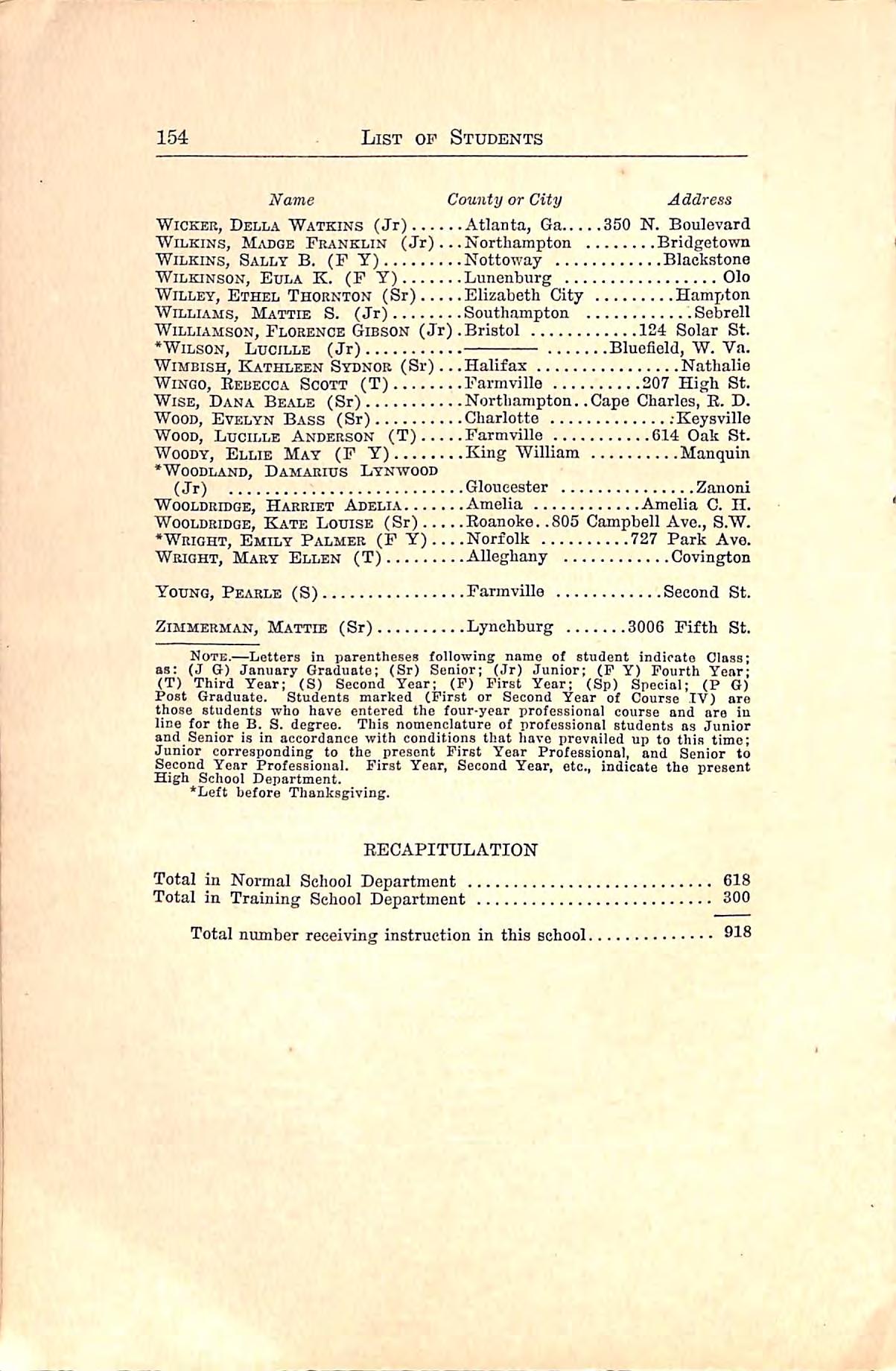
Address
Wicker,DellaWatkins(Jr) Atlanta,6a 350N.Boulevard WiUKiNS,M^vdgeFranklin(Jr)...Northampton Bridgetown WiLKiNS,SallyB.(FT) Nottoway Blackstone Wilkinson,EulaK.(PY) Lunenburg Olo WiLLEY,EthelThornton(Sr) ElizabethCity Hamjiton Williams,MattieS.(Jr) Southampton .Sebrell Williamson,FlorenceGibson(Jr).Bristol 124SolarSt. •Wilson,Lucille(Jr) Bluefield,W.Vn. WiMBisH,KathleenSydnor(Sr)...Halifax Nathalie WiNGO,EebeccaScott(T) Farmville 207HighSt. Wise,DanaBeale(Sr) Northampton..CapeCharles,E.D. Wood,EvelynBass(Sr) Charlotte .-Keysville Wood,LucilleAnderson(T) Farmville 614OakSt. Woody,EllieMay(FY) KingWilliam Manquin •Woodland, Damarius Lyntvood (Jr) Gloucester Zanoni Wooldridge,HarrietAdblia Amelia AmeliaC.H. Wooldridge,KateLouise(Sr) Eoanoke..805CampbellAve.,S.W. •Wright,EmilyPalmer(FY)....Norfolk 727ParkAve. Wright,MaryEllen(T) Alleghany Covington
Young,Pearle(S) Farmville SecondSt. Zimmerman,Matttb(Sr) Lynchburg 3006FifthSt.
Note.—Lettersin parenthesesfollowingnameofstudentindicate Glass; as:(JG)JanuaryGraduate;(Sr)Senior;(Jr)Junior;(FY)FourthYear; (T)Third Year;(S)Second Year;(P)FirstYear;(Sp)Special;(P G) PostGraduate. Studentsmarked(FirstorSecondYearofCourseIV)ore those students who have entered the four-year professional course and ore in linefortheB.3.degree. ThisnomenclatureofprofessionalstudentsasJunior and Senior is in accordance with conditions that have provniled up to this time; Junior corresponding to the present First Year Professional, and Senior to SecondYearProfessional. FirstYear,SecondYear,etc.,indicatethepresent High SchoolDepartment.
•LeftbeforeThanksgiving.
Total in Normal School Department 618
Total in Training School Department 300
Totalnumberreceivinginstructioninthisschool
Any one discovoringany mistake or emission in the alumnro register is earnestlyrequestedtosendthecorrectiontothePresidentoftheSchool

Abbitt,AutiiueMerle(Prof.1906),Mrs.PussellKirk...PortNorfolk Abditt,ChassisEleianob(Prof.1905),Mrs.Loni-isThomas, CrawfordSt.,Portsmouth
Abditt,EdithFrances(Full1915) Teaching,Covington Abbitt,Eleanor (Full 1916) Teaching, Waverly Abbitt, Ethel Frances (Full 1913), Mrs. J. A. Burke Appomattox Abbitt,Ola (Full 1910) Teaching,103 E.Grace St.,Eichmond Agree,FlorenceDunbeath(Full1910), Teaching, 1510 Rivermont Ave., Lynchburg Adair,Jane (Prof. 1903) Teaching,Bluefield. W.Vn Adams,Blanche Howard (Full 1915) Teaching, Smithfield Adams,Grace(Prof.1903),Teaching,112E.Green Ave.,Connellsnlle,Pa Adams,Louise(Full 1906),Mrs.Armstrong Abilene Adams,SueDuval(Full1912) lOOS WiseSt.,Lynchburn •Agnew, Mary C. (Full 1888) !...... Allen, Annie B.(Full 1916) Teaching,Richmond Allen, Lucy Daniel (Full 1915) Teaching, Lynchburg Allen, Mary Avice (Prof. 1905), Mrs. Garnet Acree Sharps Allen, Roberta (Prof. 1907), Mrs. Geo. C. Wingo Jetersvillo Allen, Rosa Linda (Prof. 1915) Teaching, Turbeville Allison,JosephineCrockett(Prof.1913), ^ r, ,-r, Ri<^hmond Ambler,FrankiePreston (Full 1913) Teaching,Roseland Amos, Martha Kate (Full 1898) Teaching, RoanSe Anderson, Carrie Burke (Full 1911) Teaching, Scarbro W Va Anderson, Catherine Elizabeth (Full 1909), Mrs. B. C. Sharpe, Jr. ' Greensboro, N.'c Anderson,Catherine M.(Full 1886) Teaching, Lyncliburc Anderson,EvaE.(Prof.1913),Mrs.J T.Grimes Smithfield Anderson,Lucy B.(Prof.1905),Mrs.B.E.Ward Pocahontas Anderson, Mary Alice (Full 1911) Stenographer, Norfolk Anderson, Mary W. D. (Prof. 1912) Ben Venue Anderson, MiVUD M. (Full 1905), Mrs. F. L. Soyars, 146 South Converse St., Spartanburg S. C. Andrews,Eugenia Beverly (Full 1908), Mrs. Tom Haskins..Altavista Andrews, Frances (Kind. 1913) ...Teaching, Empcria Anglea, Pearl Lennis (Prof. 1913) Teaching, Bristol Aroiiambault, Marguerite Lake (Full 1914) Teaching, Ashland
•Deceased.

Aemistead,Ellen(Full1895),Mrs.Giierraut..RandolphSt.,Farmville Aemistead,JuliaTravis(Full1910),Mrs.BeverlyLee, EllennoreApartments,Detroit,Mich. Armistead,Martha(Full3894),Mrs.0.E.Morton Crewo Ariiistead,MartP.(Prof.1912) Lennig Armstrong,AliceM.(Kind.1916) Teaching,Norfolk Armstrong,Elizabeth(Full1915) R.F.D.1,GlenAllen Armstrong,Ellen(Full1899) Decatiir,Ga. Armstrong,GraceB.(Full1916) Teaching,Meherrin Armstrong,Sadie(Full1900)..Teaching,320E.FranklinSt.,Richmond Arvin,Ethel(Prof.1903),Mrs.WaltonE.Bell Wilhurn Ashdy,Florida(Full1906) Teaching,Lovingston Ashley,Daisy(Full1896) Teaching,RedgateAve.,Norfolk Askew,B.Madeline(Full1913) Teaching,Radford Atkinson,Alice(Full1901) Teaching,Richmond Atkinson,Margery(Prof.3905) Teaching,Emporia Atkinson,VirginiaW.(Kind.1914) Teaching,CliftonForgo Auerbach,hlAMiEL.(Full3912), Teaching,JohnMarshallH.S.,Richmond Avery,DorothyLengan (Full1914). Teaching,Virginia Beach
Babb,AnnieMary(Prof.1910)
Teaching,Corinth Badger,Helen(Full1895) 1910N.22dSt.,Philadelphia,Pa. Baccy,Gillette Fleet (Full1931),Mrs.Fleet,King and Queen C.H. Bailey,EttaRose(Prof.1913) Teaching,Richmond Bailey,FletcherE.(Kind.1913) Teaching,Richmond Bailey,GeorgeBarham(Prof.1914) Teaching,SouthRichmond Bailey,VarinaElizabeth(Prof.1913) Teaching,Wakcfield Bain,Amelia(Full1916) Teaching,Portsmouth Baker,JosephineInez(Full1907), GovernmentClerk,Washington,D.C. Baker, Nellie (Full 1906) Teaching, Pulaski Baldwin,Blanche V.(Full 1893),Mrs.E. T. nines, 11StratfordApartments,Norfolk Baldwin,Kathleen (Full 1911), Mrs. W.E.D. McDonald..Rustburg Baldwin,Laura A.(Full 189S) High Street, Farmville Baldwin,Lucile Elliott (Full 1914), Teaching,804 Vickers Ave.,Durham, N. C. Baldwin, Mary Cecil (Full 1904) Farmville Ball,Lula(Full1S88) New KentC.H. Ballou, Annie (Full 1897), Mrs. Ballou Houston Balthis, Louise de Segur (Full 1912), Mrs. Carlos Keister, Strasburg Banks, Annie (Pull 1914) Teaching, Empona BiiNKs,Mary Moylan (Full 3914) Teaching,Petersburg Banks, Rebecca Leah (Full 1914) Teaching, Norfolk Barham, Elizabeth R. (Full 1915) Teaching, Sussex Barnard, Margaret (Full 1916) Teaching, Norfolk Barnes, Emma J. (Full 1901) Teaching, Hampton B^uines, Marcella (Kind. 1916) Music Supervisor, Richmond Barnett,ICathleen Armstrong (Prof. 1913)..-.Teaching, Blacksburg Barnhart,Ida (Full 1916) Teaching, Hopewell Bare, Florence Ray (Prof. 1907) Teaching, Lynehburg Barton, Clara (Full 3910) Teaching, Salem
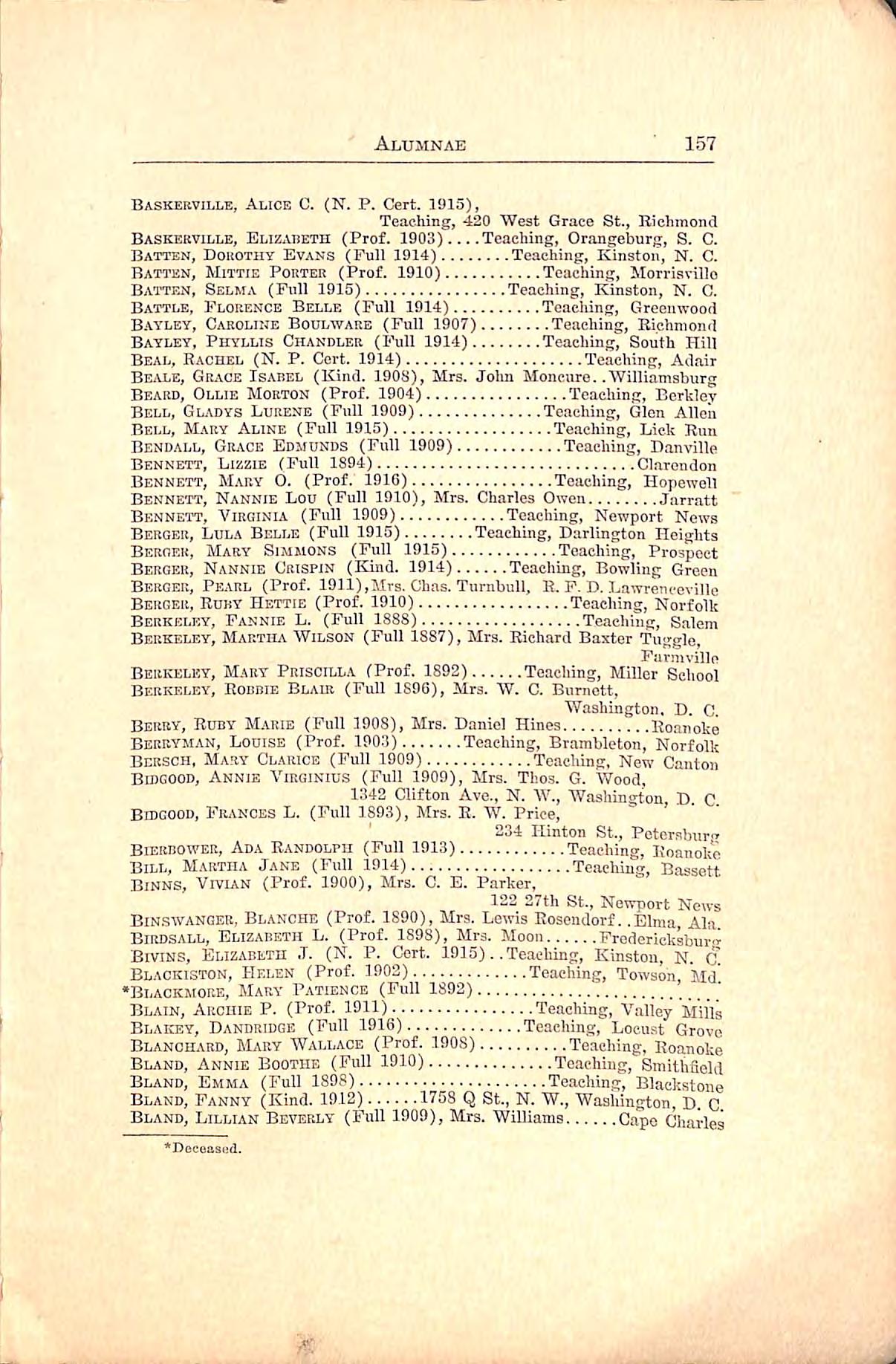
Baskerville,Alice C.(N.P.Cert,1915), Teaching,420 West Grace St., Richmond Baskerville,Elizabeth(Prof.1903)...-Teaching,Orangeburg,S.C. Batten,DorothyEvans(Full1914) Teaching,Kinston,N.C. Ratten,MittiePorter(Prof.1910) Teaching,Slorriavillo Batten,Selma(Full1915) Teaching,Kinston,N.C. Battle,FlorenceBelle(Full1914) Teacliing,Greenwood B.ayley,CarolineBoulwarb(Full1907) Teaching,Richmond Bayley,PhyllisChandler(I-hill1914) Teaching,SouthHill Beal,Rachel(N.P.Cert.1914) Teaching,Adair BEiVLE,GraceIsabel(Kind.1908),Mrs.JohnMoncure.."Williamsburg Beard,OllieMorton(Prof.1904) Teacliing,Berkley Bell,GladysLurene(Full1909) Teaching,GlenAllen Bell,MaryAline(Full1915) Teaching,LickRun Bendall,GraceEdmunds(Full1909) Teaching,Danville Bennett, Lizzie (Full 1894) Clarendon Bennett,Mary0.(Prof.1916) Teaching,Hopewoll Bennett,NannieLou(Full1910),Mrs.CharlesOwen Jarratt Bennett,Virginia(Full1909) Teaching,NewportNews Berger,LulaBelle(Full1915) Teaching,DarlingtonHeights Bergrk, Mary Simmons (Full 1915) Teaching, Prospect Berger, Nannie Crispin (Kind. 1914) Teaching, Bowling Green Berger,Pearl(Prof.19]l),Mrs.Chas.Turnbull,R.F.D.Lawrenceville Berger,RubyHettie(Prof.1910) Teaching,Norfolk Berkeley,FannieL.(Full1888) Teaching,Salem Berkeley,Martha Wilson(Full1887),Mrs.Richard Baxter Tuggle, Furinvillo Berkeley,MartPriscilla(Prof.1892) Teaching,MillerSchool Berkeley,RobbieBlair(Full1896),Mrs.W.C.Burnett, Washington.D.C. Berry,RubyMarie(Pull1908),Mrs.DanielHines Roanoke Berryman,Louise(Prof.1903) Teaching,Brambleton,Norfolk Bersch.MaryClarice(Full1909) Teacliing,NewCanton BroGOOD,AnnieVirgjnius(Full1909),Mrs.Thos.G.Wood, 1342 Clifton Ave.,N.W.,Washington,D.C Bedgood,FRiVNCESL.(Full1893),Mrs.E.W.Price, 234IlintonSt.,Peterabur" BiERBOWER,Ada Randolph (Full 1913) Teaching,Roanoke Bill,MarthaJane(Full1914) Teaching,Bassott BxNNS,Vivian(Prof.1900),Mrs.C.E.Parker, 12227thSt.,NewportNews Bin.swanger,Blanche(Prof.1890),Mrs.LewisRosendorf..Elma,Ala Birdsall,ElizabethL.(Prof.1898),Mrs.Moon Predericksbur-r BiviNS, Elizabeth J.(N. P. Cert. 1915)..Teaching, Kinston, N. Q. Blackiston,Helen (Prof.1902) Teaching,Towson,Md •Blackmore,Mary P.\tience (Full 1892) ' Blain, Archie P. (Prof. 1911) Teaching, Valley Mills Blakey, Dandridge (Full 1916) Teaching, Locimt Grove Blancuard, Mary Wallace (Prof. 1908) Teaching, Roanoke Bland,Annie Bcothe (Full 1910) Teaching,Smitbfielil Bland, Emma (Full 1898) Teaching, Blackstone Bland,Fanny(Kind.1912) 1758QSt.,N.W.,Waahington,D.C Bland,Lillian Beverly (Full 1909),Mrs. Williams Cape Charles
•Decoasiid.

Bland,Lola(Full1894) Teaching,Pinetta Bland,MakiaLilbourne(Full1898),Mrs.W.F.D.Williams, CapeCharles Bland,MaryAlma(Full1893) Shackelfords Bland,PattieL.(Full1896),Mrs.Birdsall, 426GreeneAve.,Brooklvn,N.Y. Bland,Rosalie(Full1896) Shackelfords Blankinship,SallieW.(Full1912) Teaching,SouthRichmond Blankinship,VeknieVaseti(Full1908),Mrs.C.W.Hoge, Teaching,GateCity
•Blanton,AnnieL.(Full1885),Mrs.FirmerBarrett Blanton,BessieH.(Full1886),Mrs.EgbertE.Jones, HollySprings,Miss. Blanton,Emma E.(Prof.1908),Mrs.Nelson Vaughan Richmond Blanton,MarthaKing(Full1909) Teaching,Farmvillo Blanton,M.Virginia(Prof.1908),Mrs.FredHanbury..Farmville Blanton,MildredElizabeth(hhill1909) Teaching,Farmville Blanton,Thelma Wiltse (Full 1913)..Assistant,S. N.S., Farmville Bliss,CarolineHelen(Full1909) Teaching,Farmville Boatwright,MargaretGash(Full1913) Teaching,Covington Boatwright,NellieTyler(Full1909),Mrs.G.A.Scott, CharlesSt.,Fredericksburg
Boatwright, Sally Jean (Full 1912) Teaching, Lynchburg B0G0.S,Elizabeth Rogers (Full 1915) Teaching, Onancock Boisseau, Vivian Temperance (Prof.1907), Mrs. D.P. Wright, Clarksvillo
Bolton, Callie Quinton (N. p. Cert. 1915) Teaching, Yorktown Bondurant,Georgia(Full1895)
*Bondurant,Myrtle(Full1892),Mrs.Corley Booker,Mildred Ann (Kind.1915) Teaching,Roanoke Boomer,Addie Lee (Full 1911) Teaching,Suffolk Boothe, Annie L. (Full 1898) Teaching, Drake's Branch Boston,FlorenceFrazer(Prof.1913), Student, Westbampton College, Richmond Boswell,LucyF.(Full1889),Mrs.A.P.Montague, 2482EiverinontAve.,Lynchburg Boswell,MayI.(Full1892),Mrs.Chas.Gordon, 1427NinthAve.,Greely,Colo. Bottingheimer,Hortense (Prof. 1890), Mrs. J. H. Jonesoff, 2517 Kensington Ave.,Richmond Bouldin, Claiborne (FuU 1914) Teaching, HopowoU Bowden, Maude Lucille (Full 1912) Teaching, Nortouc •Bowers,GertrltieI.(Prof. Bowles, Esther (Full 1916) Teaching, Hopewell Bowles, Ida Helen (Full 1914) Teaching, View Bowyer,Ida Pearl (June, 1911) r Boyd,Carrie Y.(Full Boyd,Mary(Full1898),Mrs.SamuelScott Boyd, Mary Hannah (Full 1893), Mrs. N. C. Flourooy....Bay View Boyd, Susan (Full 1898), Mrs. Alexander Hallowell.Bracey, Jennie E.(Full 1902) W. V^ Braden, Mozelle (Full 1916) Teachmg, Round HiU •Bradshaw,Bernice (Prof. 1903)
•Deceased.

159
•Bradshaw,Cornelia F.(Full 1895),Mrs.Bassett"Watts Branch,J.Mabin(Full1S94),Mrs.Jno.C.Simpson Norfolk Branch,Olive(N.P. Cert. 19i6) Teaching, Carrollton Brandis,Florence(Full1S9S),Mrs.GeorgeDavidson.SouthEichmond Bratten,Dorothy0.(Full1915) Teaching,SouthNorfolk Breckenridoe,NinaB.(Full1912) Teaching,Fineastla Briggs,AnnaA.(Full1911) SussesC.D. Briggs,IreneB.(Prof.1912) Teaching,Eichmond Briggs,MayE.(Prof.1912) Teaching,Eichmond Biughtwell,CarrieB.(Full1886),Mrs.Hopkins....BedfordCity Brimmer,Kose(Full1895) Teaching,166GraySt.,Danville Brinkley,FrancesThompson(Full1908),Mrs."W."W.Perkinson, Greenwood,Miss. Brinson,MaryEley(Prof.1S97),Mrs.J.E.Elliott Hampton Bristow,MariaAdams(Full1914) Teaching,HighlandPark,E'd Bristow,NellieT.(Full1912)Mrs.H.H.Sandidge Amherst Brittingham,AudreyEstelle(Prof.1904) ;Teaching,Hampton Brittinqham,Julia(Kind.1916) Teaching,Hampton Britton, Katherine Stockdell (Prof. 1908), 2834ParkwoodAve.,Baltimore,Md. Broadwater,Corrie (Prof.1898) Bookkeeper, Norton Brock, Lynette Martha (Full 1914) Teaching, Crittenden Broocks, Annie Louise (Kind. 1915) Teaching, Matoaca Broocks,Euby Aurella (Full 1915) Teaching, Partlow Brooke, Elizabeth Bruce (Prof. 1910) (Married) Culpeper Brooke,Lucy Morton (FuU 1905),Mrs.L."W.L.Jennings, Tutuila,Samoa
Brooke, Milltan Carter (Kind. 1910), Mrs. Henry Somervillo, Covington Brooking,Cora Rogers (Full 1910), Mrs."W. T.Parker....Homeville Brooking,Mary"Vivian(Full1910) Teaching,Orange Brooks,AnnieLee(Prof.1914) Teaching,Broadford Brooks,Evelyn (Full 1916) Teaching,Portsmouth Brooks,Olive B.(Prof.1903) ..Teacliing,Crittenden Brosius,BelleBeryl(Full1907),Mrs.P.H."Wlsman.Teaching,Salem Brown,Ethel Louise (Full 1909)..Missionary,Eeheirao Preto,Brazil Brown,Marg.vretW.(FuU1911),Teaching,303Folger St.,Carrollton,Mo.
Brown, Maria "Virginia (Full 1914) Teaching, Roanoke Brown Myrtle(Full1896) 878 Green St.,D.anville Browning, Kathleen Steele (Full 1914) Teaching, Hampton Bruce, Flora Anne (Prof. 1907) Teacliing, Coeburn Bruce Mart Frances (Full 1914) Teaching, St. Brides
Bryan, Georgia M. (Prof. 1902), Mrs. Arthur Hutt Norfolk Erydon Margaret P. (Kind. 1906)..Teaching, College Ave., Danville Buchanan, Mattie (Prof. 1894)..Trained Nurse, Clay Center, Kan. Bucher, Bessie Bond (Full 1914) Teaching, Staunton, "Va. Buford Florence db Launay (Prof. 1913).Student, S. N. S., Farmvill© Bugg, Fanny (FuU 1886), Mrs. D. Burton Blanton, 2118 Albemarle Road,Brooklyn N.T Bugq, Hattie King (Pull 1906), Mrs. "W. C. Duvall Pamiville Bugo, Lillian Paulett (Kind. 1914) Teaching, Richmond •Doconscd.
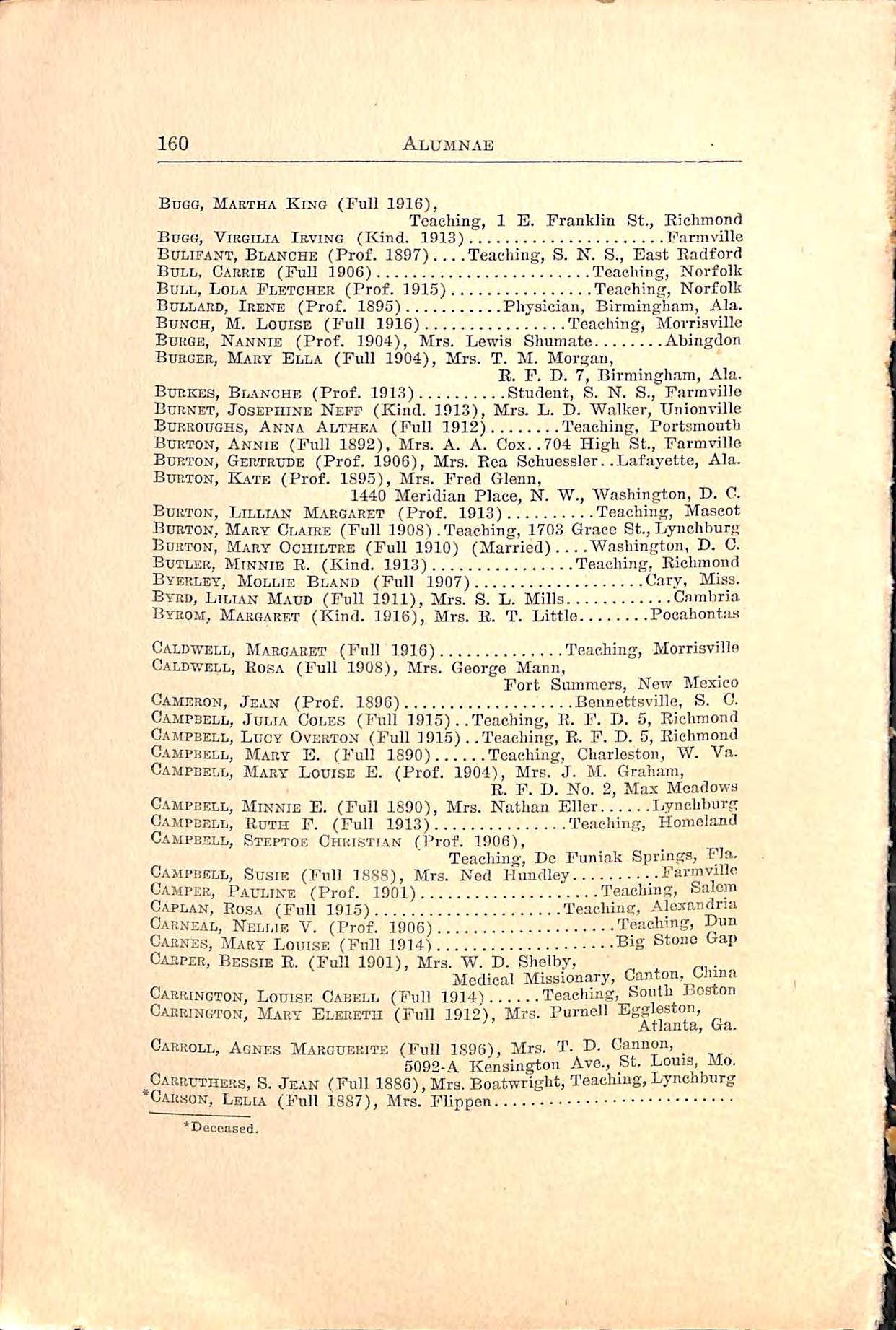 Alumnae
Alumnae
Bugo,MarthaKino(Full1916), Teaching,1B.FranklinSt.,Richmond Bugq,ViRon^iAIrving(Kind.1913) Farmville Bulifant,Blanche(Prof.1897) Teaching,S.N.S.,EastRadford Bull.Carrie(Full1906) Teaching,Norfolk Bull,LolaFletcher(Prof.1915) Teaching,Norfolk Bullard,Irene(Prof.1895) Physician,Birmingham,Ala. Bunch,M.Louise(Full1916) Teaching,Movrisville Buhge,Nannie(Prof.1904),Mrs.LewisShumate Abingdon Burger,MaryElla(Full1904),Mrs.T.M.Morgan, R.F.D.7,Birmingham,Ala. Burkes,Blanche(Prof.1913) Student,S.N.S.,Farmvillo Burnet,JosephineNefp(Kind.1913),Mrs.L.D.Walker,Unionvillc Burroughs,AnnaAlthea(Full1912) Teaching,Portsmouth Burton,Annie(Full1892),Mrs.A.A.Cox..704HighSt.,Farmville Burton,Gertrude(Prof.1906),Mrs.ReaSchuessler..Lafayette,Ala. Burton,Kate(Prof.1895),Mrs.FredGlenn, 1440 Meridian Place,N.W.,Washington,H.0. Burton,LillianMargaret(Prof.1913) Teaching,Mascot Burton,Mary Claire(Full 1908).Teaching,1703 Grace St.,Lynchburg Burton,Mary Ocuiltre (Full 1910) (Married)....Washington, D. C. Butler, Minnie R.(Kind. 1913) Teaching, Richmond Byerlet, Mollie Bland (Full 1907) Cary, Miss. Byrd,Lilian Maud (Full 1911),Mrs. S. L. Mills Cambria Byrom, Margaret (Kind. 3916), Mrs. R. T. Littlo Pocahontaa
Caldwell, Margaret (Full 3916) Teaching, Morrisvillo Caldwell,Rosa (Full 1908), Mrs. George Mann, FortSummers,NewMexico Cameron, Jean (Prof. 1896) .Bcnncttsvillo, S. C. Campbell,Julia Coles (Full 3915)..Teaching,R.F. D. 5, Richmond Campbell,Lucy Overton (Full 3915)..Teaching,R.F.D.5,Richmoud Campbell, Mary E. (Full 1890) Teaching, Charleston, W. Va. Campbell, Mary Louise E. (Prof. 1904), Mrs. J. M. Graham, R.F.D.No.2,MaxMeadows Campbell,Minnie E.(Full 1890), Mrs. Nathan Eller Lynchburg Campbell, Ruth F. (Full 1913) Teaching, Homeland Campbell, Steptoe Christian (Prof. 1906), Teaching, De Funiak Springs, Fla. Campbell, Susie (Full 1888), Mrs. Nod Hundley Farmvillo Camper, Pauline (Prof. 1901) Teaching, Salem Caplan, Rosa (Full 1915) Teaching, Alexandria CaRxNeal, Nellie V. (Prof. 1906) Teaching, Hun Carnes,Mary Louise(Full 1914) Big Stone Gap Carper,Bessie R.(Full 1901), Mrs. W.D.Shelby, . MedicalMissionary,Canton,GJuna Carrtngton, Louise Cabell (Full 1914> Teacldng, South 3>oston Carrington, Mary Elereth (Full 1912), Mrs. Purnell Eggleston, ^ Atlanta,Ga.
Carroll, Agnes Marcuep.ite (Full 1896), Mrs. T. I>. Cannon, 5092-A Kensington Ave.,St. Louis, Mo. Oarruthers,S. Jean (Full 1886),Mrs.Boatwright,Teaching,Lynchburg Carson, Lelia (Full 1887), Mrs.
*Decease<l.

Carter,AdelbV.(Full1911),Mrs.J.G.Brown Poquoson Carter,AliceElizabeth(Full1909) Teaching,Lexington Carter,BessieWhitwouth(Prof.1904),Mrs.B.T.Taylor,Prospect Carter,Katherine0.(Prof.1914) Houston Carter,LauraLee(Prof.190.1),Mrs.HarryHundley Norfolk Carter,Lelta(Full1916) Teaching,Crowe Carter,Lily(Full1S99),Mrs.Vaughan .\inclia Caruthers,CarrieNinde(Full1909),Mrs.G.F.Johnson Fcrrcll Carver,AlmaO.(Full1914) Teaching,Pocahontas Cassidy,Salliep.(Full1915) Teaching,Hopewell Castle,AliceI,ee(Prof.1907) Teaching,Bristol Castleman,LauRiV Lee(Full 1913) Teaching, Stanardsvlllc Chambers,Dreaua(Full1916) Teaching,Cismont Chamrlin',Julia(Full1916) Teaching,Greenwood Chandler,Jennie(Full1895),Mrs.Carpenter Massaponax Chapman,Daisy(Full1907) Teaching,Tazewell Charlton,FannieH.(Prof.1911) Dillwyu Charlton,SarahGertrude(Prof.1914) Teaching,Carson Che,\dle,Annie(Full1916) Teaching,ChurchView Cheatuam,An.n'ieB.(Prof.1913) Teaching,GladeHill Cheatham,EthelM.(Full1915) Teaching,B.F.D.,Lynchburg Cheatham,Lillian(Prof.1901)....Teaching,R.F.D.4,Richmond Chenault,Hessie(Prof.1901),Teaching,SOlW.MainSt.,Richmond Chenault,Maude(Full1905) Teaching,PrinceEdwardCounty Chewnino,AnneC.(Prof.1912) Teaching,Partlow Ouewning,LouM.(Full1894),Mrs.L.F.Harper Urbanna Childrey,HelenAgnew(Full1906),Mrs.CorlissBlanton, Winston-Salem,N.C. Chiles,Ida Louise (Full 1916) Tcacbing, Strasburg CniLTON,JuliaG.(Full1900),Mrs.C.H.Dunaway Richmond Chilton,Laura(Full1900),Mrs.Harrj'Nichols St.Joseph,Mo. Chilton,SusanKatherine(Full1905) Teaching,Reedvillc •Chisman,Lila(Full1896)
CmsMAN,Mary Whiting (Full 1S9S), Mrs. Harry Holt Hampton Chisman,Rosa(Full1889)..Teaching,2042Fifth Ave.,Now York City Chiiisman,HallieBryarly(Full1909) Teaching,Midlothian Chrisman,LucyCarter(Prof.1904) Teaching,Richmond Christian,FannieL.(Full1908)Mrs.G.P.Jennings Richmond Christian,Leta R.(Prof. 1912) Teaching, Covington Christian, Martha S.(N.P. Cert. 1915) Teaching, Mint Springs Chumbley,Leliaa.(Prof.1902),Mrs.W.T.Gibbs Lawrenceville Clark,AnneP.(Prof.1912) Teaching,Matoaka,W.Va. Clahk,Lucretia V.(Prof. 1907),Mrs. Harvey Laurel Clark, Maebelle K. (Full 1912) Teaching, Phoebus Clark,M.miy (Prof.1903),Mrs.R.R.Claiborne Georgia Clark, Mary E. (Prof. 1902) Teaching, Jotcrsville Clarke,Elizabeth R.(Full 1916) Teacliing, Dendron Clarke,M.Alice(Prof.1914),Mrs.Jas.R.Orgain McKennev Cl.\ry,Inez(Prof.1904),Teaching,111E.Eighth St.,South Richmond Clay,Margaret(Prof.1909),Mrs.R.R.Kyle, King and Ronmey Sts., Charleston, S. C. Clayton, Florence Mekritt (Full 1909), Mrs. A. M. Pcrkinson, ChurchRoad
*Docea8cd.
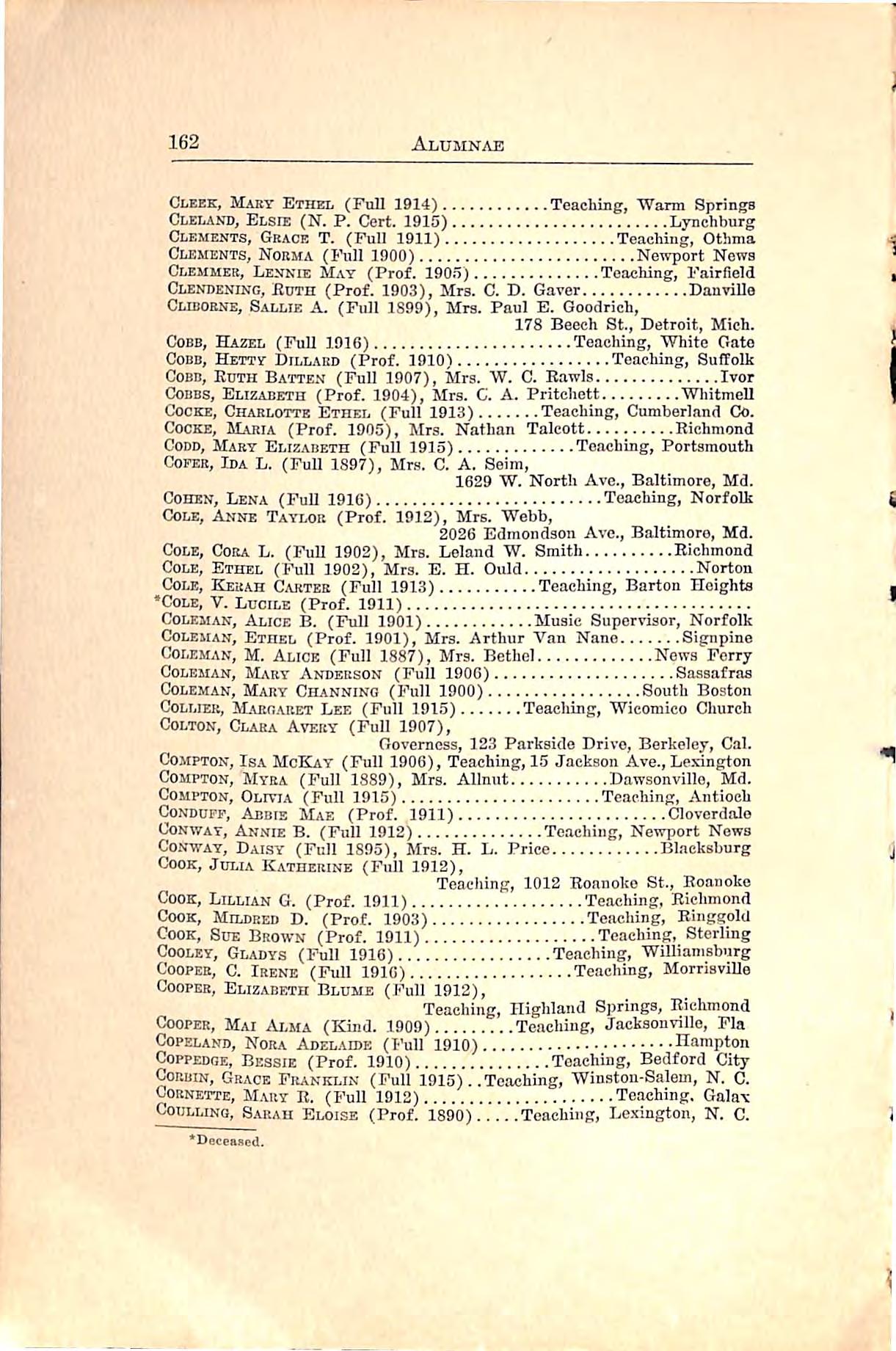 Alumnae
Alumnae
CijZZK,MartEtri^(Full1914) Teaching,WarmSprings Cleland,Eisra(N.P.Cert.1915) Lynchburg Clements,GraceT.(Full1911) Teaching,Othma Clements,Norma(Full1900) NewportNews Clemmer,LenkieMay(Prof.190.5) Teaching,Fairfield Clendening,Edth (Prof.1903),Mrs.C.D.Gaver Danville Cuborne,Salliea.(Full1899),Mrs.PaulE.Goodrich, 178BeechSt.,Detroit,Mich. CoBB,Hazel(Full1916) Teaching,WhiteGate CoBB,HettyDillakd(Prof.1910) Teaching,Suffolk CoBB,RuthBatten(Full1907),Mrs.W.C.Rawls Ivor CoBBS,Elizabeth(Prof.1904),Mrs.C.A.Pritcliett Wliitmell Gocke,CharlotteEthel(Full1913) Teaching,CumberlandCo. Cocke,Maria(Prof.1905),Mrs.NathanTalcott Richmond CoDD,MaryElizabeth(Full1915) Teaching,Portamoutb CoFER,IdaL.(Full1897),Mrs.C.A.Seim, 1629W.NorthAve.,Baltimore,Md. Cohen,Lena(Full1916) Teaching,Norfolk Cole,AnneTaylor(Prof.1912),Mrs.Webb, 2026EdmondsonAve.,Baltimore,Md. Cole,Cora L.(Full 1902),Mrs.Leland W.Smith Richmond Cole,Ethel (Full 1902), Mrs. E.H.Ould Norton Cole,Kerah Carter (Full 1913) Teaching,Barton Heights •Cole,V.Lucile(Prof.1911)
Coleman,Alice B.(Full 1901)
Music Supervisor, Norfolk Coleman,Ethel(Prof. 1901), Mrs. Arthur Van Nane Signpine Coleman,M.Alice (Full 1887), Mrs. Bethel News Ferry Coleman,M\ryAnderson(Full1906) Sassafras Coleman,MaryChanning(Full1900) SouthBoston Collier,Margaret Lee (Full 1915) Teacliing, Wicomico Church Colton,Clara Avery (Full 1907), Governess,123ParksideDrive,Berkeley,Cal. COMPTON,IsA McKay(Full1906),Teaching,15Jackson Ave.,Lexington CoMPTON, Myra (Full 1889), Mrs. Allnut Dawsonvillo, Md. CoMPTON,Olivia (Full 1915) Teaching, Antioch CoNDUFF, AjjBfs Mae (Prof. 1911) Cloverdalo Oonway,Annie B.(Full 1912) Teaching,Newport News CONWAY,Daisy (Full 1895), Mrs. H. L.Price Blacksburg Cook,Julia Katherine(Full 1912), Teaching,1012RoanokeSt.,Roaiiokc Cook, Lillian G. (Prof. 1911) Teaching, Richmond Cook, Mildp.ed D. (Prof. 1903) Teaching, Riuggold Cook, Sue Brown (Prof. 1911) Teaching, Sterling CooLEY, Gladys (Full 1916) Teaching, Williamsburg CooPEa, C. Irene (Full 1910) Teaching, MorrisviUe Cooper, Elizabeth Blume (Full 1912), Teaching, Highland Springs, Richmond Cooper, Mai Alma (Kind. 1909) Teaching, Jacksonville, Fla COPELAND, Nora Adelaide (Full 1910) Hampton Coppedge, Bessie (Prof. 1910) Teacliing, Bedford City C0P.BIN, Grace Franklin (Full 1915)..Teaching, Wiustou-Salein, N. C. CoRNETTE, M.vuy R, (Full 1912) Teaching. Galav CouLLiNG, Sarah Eloise (Prof. 1890) Teaching, Lexington, N. C. •Decea.sed.
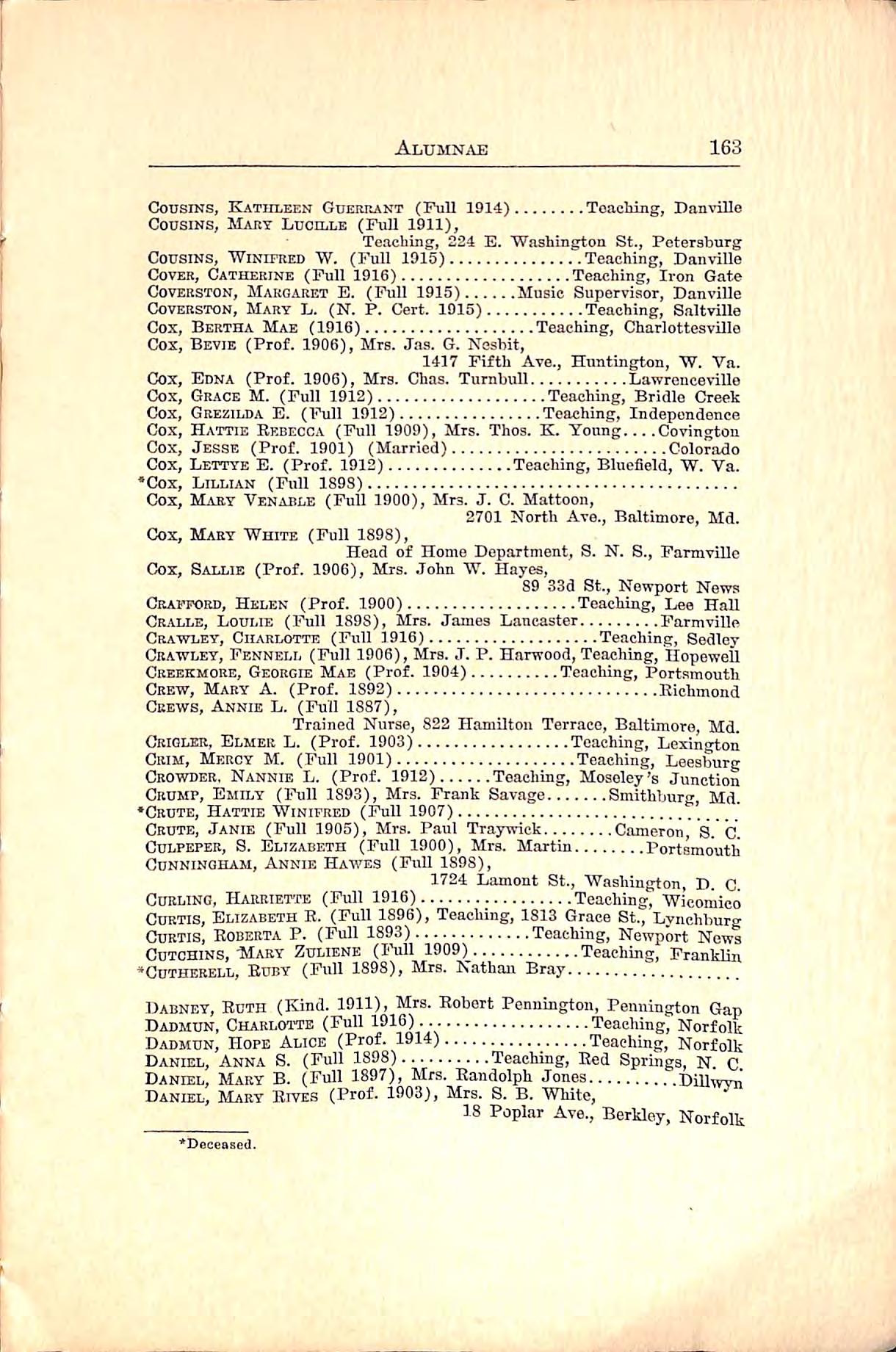
Cousins,KathleenGuebrant(Full1914) Teaching,Danville Cousins,MaryLucille(Full1911), Teaelung,224 E."Washington St.,Petersburg Cousins,WinifredW.(Full1915) Teaching,Danville Cover,Catherine(Full1916) Teaching,IronGate CovEBSTON,MargaretE.(Full1915) MusicSupervisor,Danville Coverston,MaryL.(N.P.Cert.1915) Teaching,Saltville Cox,BerthaMae(1916) Teaching,Charlottesvillo Cox,Bevie(Prof.1906),Mrs.Jas.G.Nesbit, 1417FifthAve.,Huntington,W.Va. Cox,Edna(Prof.1906),Mrs.Chas.TumbuU Lawrenceville Cox,GraceM.(Pull1912) Teaching,BridleCreek Cox,GrezildaE.(Full1912) Teaching,Independence Cox,HattieRebecca(Full1909),Mrs.Thos.K.Young Covington Cox,Jesse(Prof.1901)(Married) Colorado Cox,LettyeE.(Prof.1912) Teaching,Bluefield,W."Va. •Cox,Lillian(Full1898) Cox,MaryVenable(Full1900),Mrs.J.C.Mattoon, 2701NorthAve.,Baltimore,Md. Cox,MaryWhite(Full1898), HeadofHomeDepartment,S.N.8.,Farmville Cox,Sallie(Prof.1906),Mrs.JohnW.Hayes, 8933dSt.,NewportNews Crai'pord,Helen(Prof.1900) Teaching,LeeHall Cr.\lle,Loulie(Full1898),Mrs.JamesLancaster Farmville Crawley,Charlotte(Full1916) Teaching,Sodley CIbawley,Fennell(Full1906),Mrs.J.P.Harwood,Teaching,Ilopowell Creekmore,GeorgieMae(Prof.1904) Teaching,PortRmouth Crew,MaryA.(Prof.1892) Richmond Crews,AnnieL.(Full1887), TrainedNurse,822HamiltonTerrace,Baltimore,Md. GbiQlsr,Elmer L.(Prof. 1903) Teaching, Lexington Crim, Mercy M. (Full 1901) Teaching, Leesburg Cbowder.NannieL.(Prof.1912) Teaching,Mosoley'sJunction Crump,Emily (Full 1893),Mrs. Frank Savage Smithburg, Md. •Cbute,HattieWinifred(Full1907)
Crute, Janie (Fun 1905), Mrs. Paul Traywick Cameron S. *C, Culpeper,S.Elizabeth(Full1900),Mrs.Martin Portsmouth Cunningham,AnnieHawes(Full1898), 1724 Lament St., Washington, D. C. Curling, Harrtette (Full 1916) Teaching, Wicoraico Curtis,Elizabeth R.(Full 1896), Teaching,1813 Grace St., Lvnchburg Curtis, Roberta P. (Full 1893) Teaching, Newport News CuTCHiNS,"Mary Zuliene (I'bill 1909) Teaching, Franklin •Cutherell, Ruby (Full 1898), Mrs. Nathan Bray
Dabney,Ruth (Kind.1911), Mrs. Robert Penningtou,Pennington Gap Dadmun, Charlotte (Full 1916) Teaching, Norfolk Dadmun,Hope Alice (Prof.1914) Teaching,Norfolk
Daniel,Anna S.(Full 1898) Teaching,Red Springs, N.C
Daniel,Mary B.(Full 1897),Mrs.Randolph Jones DiUwvii Daniel, Mart Rives (Prof. 1903), Mrs. S. B. White, 18 Ave., Berkley, Norfolk
•Deceased.

Darby,Mary(1916)
Teaching,ChurchEoad DAtiDEN,Lalla B.(Prof. 1898) Toiiching, Hampton Daugutrey,Ballie Wilson (Prof.1913) Teaching,Portsmouth Dauohtret, Eleanor (Full 1910) Teaching, Drewryvillo •Davenport,EmmaB.(Full1887)
Davidson,JuliaC.(Full1892) Farmville •Davidson,LottieM.(Full1895),Mrs.MarionK.Humphreys Davidson,MaroaretGertrude(Full1907),Mrs.B.M.Higginbotham, Eupert,W.Va. DAvrosoN,MattieW.(Full1893) Farmville Davidson,Wirt(Full1908),Mrs.J.LeeCox....Teaching,Woodl.awn Davis,AliceEvelyn(Full1909) Teaching,NewportNews Davis,Azile (Full 1896),Mrs.B.B.Ford Macon,Ga. Davis,ElizabethGertrude(Prof.1907),Mrs.W.H.Ferguson,Farmville Davis,EthelLouise(Prof.1911) Stoddert Davis,Eulalie(Full1895),Mrs.Woodson Richmond Davis,Frances(Kind.1915) Teaching,Middletown,Dol. DaTis,FrancesMarrow(Full1914) Teaching,Hampton Davis,Isabelle(Prof.1910^ Teachiug,CliftonForge Davis,Louise (Full 1900), Mrs.S. R.Hall Scranton,Pa. Davis,Louise S.(Prof.1912),Mrs. C.M.Thaekcr..Mayberry, W.Va. Davis,MargaretMorton(Full1909),AssemblyTrainingSchool forLayWorkers,Richmond Davis,MaryE.(Prof.1895) Madcnburg Davis,MaryEmily(h'ull1914) Teaching,Opic Davis,MildredMay(Full1909),Mrs.Wm.Phelps Danville Davis,Myrtis E.(Full 1893), Mrs. H.N.Phillips Crewo Davis,RosalieAntoinette(N.P.Cert.1913)....Teaching,Lyncliburg Davis,Sally Guy (Prof.1905) Meadowvillo Davis, Sarah A. (Full 1916) Teaching, Church View Davis,Sudie Pate (Full 1909) Teaching,Louisa Davis, Virgtnu Lee (Full 1914) Teaching, Hampton Day, Mary French (Full 1905) Teaching, 521 34th St., Norfolk DeBaun,Theodosia Elizabeth (Prof.1907),Mrs.A.T.Hamner, R.F.D.,Norfolk Delp,Lilll\n Virginia(Full19091,Mrs.Marvin Perkins,Bristol,Tenn. Delp,Lockey Emily(Full1914),Mrs.Wm.A.Rector, Teaching,Moccasin,Mont. Dexter, Rose (Prof. 1902) Teaching, Hampton Dey,Jessie(Prof.1904) Teaching,Norfolk Dickenson, Grace (Prof. 1914) Teaching, Bonsack Dickey, Edith Leigh (Full 1905), Mrs. J. R. Morris, R.F.D.,Charlottosville Dickey, Hattie Virginia (Pull 1914) Teaching, Charlottesvillo
Diehl, Annie Lois (Prof. 1905), Mrs. John Fraser Olden Place Diggs, Katheuihe Garland (Prof. 11'13) Teaching, I^nchburg Dinwiddie, Evelyn (Full 1915) Teaching, Richmond Divine, M. Lillian (Full 1897), Mrs. Harry C. Birch Falls Church Dixon,Zozo (N. P. Cert. 1916) Teaching, Mecbanicsburg Dobie, Annie Belle (Prof. 1906), Teaching, 420 Raleigh Ave., Norfolk
Dornin, Mary Rosalie (Prof. 1914), Mrs. D. T. Stant Bristol ^ouqhty Anne S. (Full 1903), Mrs. Win. E. Baylor Indian D^ohty, Grace L.(Full 1897), Mrs. E. W. Gladstone Exmore 'Deceased.
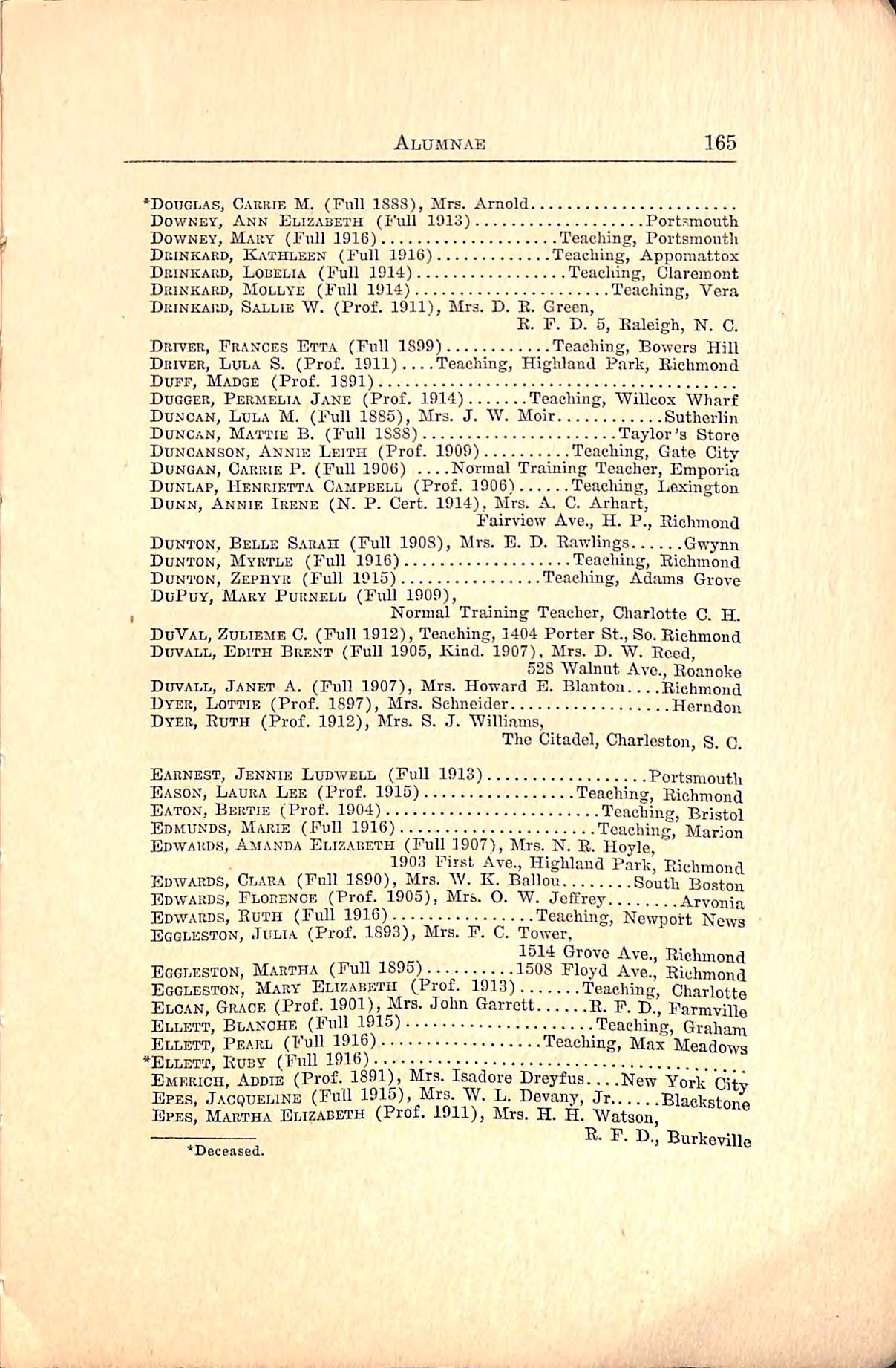
•Douglas,CarrieM.(Full1888),Mrs.Arnold Downet,AnnElizabeth(Full1913) Portsmouth Downey,Mary(Full1916) Teaching,Portsmouth Drinkard,Kathleen(Full1916) Teaching,Appomattox Drinkard,Lobelia(Full1914) Teaching,Clareinont Drinkard,Mollye(Full1914) Teaching,Vera Drinkard,SallieW.(Prof.1911),Mrs.D.E.Green, K.F.D.5,Raleigh,N.0.
Driver,FrancesEtta(Full1899) Teaching,BowersHill Driver,LulaS.(Prof.1911) Teaching,HighlandPark,Richmond Duff,Madge(Prof.1891)
Dugger,PermeliaJane(Prof.1914) Teaching,"Willco.xWharf Duncan,LulaM.(Full1885),Mrs.J.W.Moir Suthcrlin Duncan,MattieB.(Full1S88) Taylor'sStoro Duncanson,AnnieLeith(Prof.1909) Teaching,GateCity Dungan,CarrieP.(Full1906) NormalTrainingTeacher,Emporla Dunlap,HenriettaCampbell(Prof.1906) Teaching,Lexington Dunn,AnnieIrene(N.P.Cert.1914),Mrs.A.C.Arhart, FairviewAve.,H.P.,Richmond Dunton,BelleS.arah(Full1908),Mrs.E.D.Rawlings Gwynn Dunton,Myrtle(Full1916) Teaching,Richmond Dunton,Zephyr(Full1915) Teaching,AdamsGrove DdPuy,MaryPurnell(Full1909), NormalTrainingTeacher,Cliarlotte0.TT, DuVal,ZuliemeC.(Full1912),Teaching,1404PorterSt.,So.Richmond Duvall,EdithBrent(Full1905,Kind.1907).Mrs.D.W.Reed, 528WalnutAve.,Roanoke Duvall,JanetA.(Full1907),Mrs.HowardE.Blanton....Richmond Dyer,Lottie(Prof.1897),Mrs.Schneider Herndon Dyer,Ruth(Prof.1912),Mrs.S.J.Williams, The Citadel,Charleston,S.C.
Earnest,JennieLudwell(Full1913) Portsmouth Eason,LauraLee(Prof.1915) Teaching,Richmond Eaton,Bertie (Prof. 1904) Teaching,Bristol Edmunds,Marie (Full 1916) Teaching, Marion Edwards,Amanda Elizabeth(Full1907),Mrs.N.R.Hoyle, 1903 First Ave.,Highland Park,Richmond Edwards,Clara (Full 1890),Mrs. W.K.Ballou South Boston Edwards,Florence (Prof. 1905), Mrs.0. W.Jeffrey Arvonia Edwards,Ruth (Full 1916) Teaching, Newport News Eggleston,Julia(Prof.1893),Mrs.F.C.Tower,
„ Grove Ave., Richmond
Eggleston, Martha (Full 1895) 1508 Floyd Ave., Richmond
Eggleston, Mary Elizabeth (Prof. 1913) Teaching, Charlotte Eloan, Grace (Prof. 1901), Mrs. John Garrett R. p. H., Farmville Ellett, Blanche (Full 1915) Teaching, Graham Ellett,Pearl(Full 1916) Teaching,Max Meadows •Ellett, ItuBY (Full 1916)
Emf-rich, Addie (Prof. 1891), Mrs. Isadore Dreyfus New York CJity Epes, Jacqueline (Full 1915), Mrs. W. L. Devany, Jr Blackstone Epes, Martha Elizabeth (Prof. 1911), Mrs. H. H. Watson, E. F. D., Burkeville 'Deceased.

Epps,MartV.CProf.1903),Mrs.JohnF.Maclin Norfolk Etheridge,MajrieHinman(Prof.1904),Mrs.Geo.W.Bratten, Princess Anno C. H. Eubank,HonoraLouise(Prof.1911),Mrs.Thoa.N.Broaddus, Richmond
Eubank,Mamie(Full1890),Mrs.Sinclair Hampton Evans,MaryMalin(Full1914) Teaching,SouthBoston Evans,Mildred(Full1904),Mrs."W.H.Moseley SouthBoston Evans,NitaT.(Full1911) Teaching,SouthBoston Everett,FlorenceF.(Full1911) Teaching,CiiarlottoC.H. Ewald,Elizabeth(Full1915) Teaching,Portsmouth Ewart,EdnaV.(Prof.1912) Teaching,Turbeville Ewell,Jennie(Prof.1897) Teaching,Hnymarkct Ewell,MaryIsh(Prof.1905),Mrs.WallerHundley Ruckersvillc Ewing,Loveline(Full1892),Mrs.C.C.Wall, 420N.TenthSt.,Richmond
Fallwell,Clara (Prof.1907),Mrs.W.C. Vaughn....Ashevillo,N.G. Pallwell,Eugenia(Prof.1910)
Farinholt,Louise Allen (Full 1907) Teaching, Bluefield, W.Va. Fakrish, Emma Stockton (Full 1909) Teaching, Charlottesville Farbish, Margaret (Full 1906), Mrs. J. G. Thomas Atleo Farley, Elizabeth (Full 1892) Roanoko Farley,Mamie (Full 1892),Mrs.E.H.Whitten Bnimwell,W.Va. Farthing, Mary (Full 1902) Teaching, Charlotte Fearing,Ettib (Full 1916) Teaching, Norfolk Featherstone,Martha(Prof.1899),Teaching,616 Church St.,Roanokc Feild,Virginia Riche(Full 1914) Teaching, Montross Heights Fentriss,MaudeE.(Prof.1912) FentresB *Ferebee, Mary (Full 1895),Mrs. OldFerguson,M.Kate(Full 1888),Mrs.Morehead Salcin Fergusson, Louise R.(Full 1911), Mrs.Ben I. Hurt Hampton Ferousson,Marie (Prof. 1910) Teaching, Woodbine, N.J. Feerebee, Annie (Full 1897) Bookkeeper, Norfolk Finke,Beul.\h E.(Prof.1901) 132 Union St., Saleiii Finkb,JessieVirginia(Prof.1904) Salem Fisher, Ola (Prof. 1910) Teaching, Petersburg Fitzgerald, Geraldine (Prof. 1908), Teaching, Aberdeen, So. Dakota Fitzgerald,MaryElizabeth(Prof.1911) NelsonCounty Fitzgerald,SallieTazewell(Full1909),Dlustrator, 114E.GarySt.,Richmond Fitzhugh, Mary F.(FuU 1894), Mrs. Eggleston Portsmouth Fitzpatrick, Nellie M. (Prof. 1911) Teaching, Bedford City Fletcher,Kate (Full 1896) Stenographer,Welsh,W.Va. Fletcher,L.Louise(Full 1916) Teaching,McComas,W.Va. Fletcher, Mamie Edna (Prof. 1905) Teaching, Fletcher Flournoy, Isabelle Cabell (Full 1909), Mrs. Jesse F. We.st, Jr., Waverly Flournoy,Mildred C.(Full1912) Morganfield,Ky. Floyd,Sallie Dix (Full 1897),Mrs. A.T.BeU Manonville Forbes, Marion (Full 1888) Normal School, Fredoricksburg Ford, Anne Louise (Full 1911) Teaching, Rice Ford, Ella May (Prof. 1895) New York City
*Doccaacd.

Ford,Esther Brooke(Full 1914), AssistantinHomeDeportment,S.N.S.,Farniville Ford,.Xante H.(Prof. 1903) Teaching:, Martinsville Ford,Juliette(Full1892) "Washington,D.C. Ford,MarySherman(Full190G),Mrs.A.B.Gatbright...Dumbarton Ford,SusanEmily(Full1906),Mrs.J.L.Dickinson Marion Fore, KIathleen Elizabeth (Prof.1913),Mrs.J. A.Lyle..Richmond Foster,Daisy (Prof. 1903) Old Point Foster,OliveEarle(Prof.1913) Teaching,HenricoCountA'Fowlkes,Mary(Full1898),Mrs."Wall *. Fox,K.Ethel(Full1914) Teaching,Purcellville Fox,IjILy(Full1892) Teaching,Beaulahvillc Fr.\.nke,Florence(Full1899) Teaching,CharlotteC.H. Frayser,Mary0.(Prof.1903),Mrs.J."W.McGehee..Reidsvillc,N.C. Freeman,GraceS.(Full1913) Teaching,Culpoper FretWELL,MattieBelle(Full1909), Teaching,Eiehmond Fulk.s,Susie(Prof.1895),Mrs.EdwinWilliams St.Louis,Mo. Fuller,"FmaiELee(Full1914) Teaching,Rico Fulton,Annie(Full1916) Teaching,Critz Fulton,Louise(Full1916) Teaching,Critz Fulton,RuthKyle(Prof.1913) Teaching,CrippleCreek Fuqua,Louise(Fnll1888),Mrs.W.B.Strother Chester
G.UNES,JanieE.(Prof.1911)
Teaching,HighlandPark Galloway,Lizzie(Full1895)...Teaching,614SeventhSt.,Lynchhurg Galusha,CarrieMason(Full1914) Teaching,Dini\iddie Gannaway,Sue(Prof.1903),Mrs.ThomasPierce Roanokc Garbee,FlorenceEsther(Full1913), Teacliing,1011E.MarshallSt.,Ricfimond Garnet,MiVROARETTB.(Prof.1913), SecretarytoDivisionSuperintendent,Franklin Garnett,Nannie(Prof.1916) Teaching,Baskerville Garnett,Roma(N.P.Cert.1915) Buckingham Garnett,Ruth'\''ernon(Kind.1913), Teaching,1 E.Franklin St., Richmond Garbett,AnnieLeonora(Full1908),Mrs.JohnA.Lancaster Teaching,FarmviUe Garrett, Lemma (Prof. 1915) Teaching, Franklin Garrison,VirginiaMcBlair(Full1908), Teaching,421 Westover Ave., Norfolk Garbow, Nancy Gray (Full 1910) Teaching, Franklin Gassman,Eloise(Prof.1911),Teaching, Cathedral School,Orlando,Fla. Gates, Nellie C. (Full 1912) Teaching, Ararat Gathing, Annie (Prof. 1916) Teaching, Hopewell Gay, Elsie Lee (Prof. 1913) ^. Teaching, Portsmouth Gayle,M.Loulie (Full 1894),Mrs.Bland.. Shaekelfords Geddy, M. Louise (Prof. 1912) Teaching, Winstou-Salem, N. C. Gettel,Winifred (Full1916). Teaching,Virginia Beach Gilbert, Mary Blanche (Prof. 1904) Teaching, Cluirchv'llle Gildea, Eliz.ujeth S. (Full 1914). Teaching, Norfolk Gillespie, Kvthi.een (Prof. 1913) Teaching, Sehuvler Gillespie, Lois VmomiA (Full 1907), Mrs. Aaron Russ Honakpr Gilliam, Blanche (Full 1891), Mrs. Putney Farmvillo
'Deceased.

criLLiAM,Cr.AiKEE.(Prof.1911)
Teaching,Covington Gilliam,GertrudeWilson(Prof.1914) Teaching,Norfolk Gilliam,HattieBelle(Full1907) Teaching,Richmond GiLLLVif,LenaM.(Full1911) Teaching,HighlandSprings GiLLiAM,Lillian(Full1897),Teaching,2605E.FranklinSt.,Richmond Gilliam,Sallte(Full1893),Mrs.Gilliam DarlingtonHeights Gills,N.Isadore(Full1016) Teacliing,Ivor Glasgow,MaryThompson(Full1907) Teaching,Richmond Glass,Laurice^N.P.Cert.1915) Teaching,Norfolk Gleaves,Ruth(N.P.Cert.1914) Teaching,Richmond Godbey,MaryMargaret(Full1913) Student,ClarkUniversity Godwin,Ella(Full1899),Mrs.JamesRidout, 375Eleventh Ave.,Roanoke Godwin,Louise(Prof.1904),Mrs.EdmundFloyd Marionvillo 'Godwin,MaryH.(Full1895) Goggin,Martha(Prof.1903),Mrs.0.W.Woodson Rustburg Goggin,Mary(Prof.1903),Mrs.PagoD.Nelson Lynchburg Goggin, Sallie S.(Prof. 1911) Teaching, Rustburg Goldman,Frances (Full 1915) Teaching,R.F.D.,Richmond Goode,Carrie S.(Prof. 1902), Mrs. John Bugg Chase City Goode,Margaret W.(Full 1900),Mrs. Wm.C.Moore,LakeWood,Ohio Goode,Sarah Massie (Prof. 1904), Mrs. C. C. Branch,Burgaw,N. C. Goodwin, Ellen (Full 1916) Biickner Goodwin,Josephine N.(Full 1901),Mrs.E.P.Parsons,Massie's Mills Gordy, Hazel Virginia (Full 1914) Teaching, Ashland Goxh,ding,Ethel F.(Prof. 1905), Mrs. C. A. Sale Moss N^k Graham,Frances Magill(Prof. 1913) Teaching,China Graham,Geraldine(Full1909),Teaching,Model School,Williamsburg Gr.\ham, Gr.vce Nova (Prof. 1908) Teaching, Appalachia Graham,Lucy (Prof. 1915) Teaching, McCrody Geandy,Alice Hinton (Prof.1910),Mrs. Archer Applewhite, New])ortNews
Gravely, Georgia (Prof. 1905) Teaching, Clintwood Gray,Ella (Prof. 1903) Teaching, Newport News Gray, Katie Walker (Prof. 1911) Teaching, Signpino Gray, Mary F.(Full 1904), Mrs. M.W. Munroe Quincy, Fla. Gray, Mary Helen (Full 1916) Teaching, Jewell Ridge Gray, Mary Jane (Full 1893) Teaching, Winchester Gray,Maud E.(Full 1893), Mrs. O'Neal Chapel Hill, N.C. Gray, Nan Elam (Full 1914) Teaching, Ashland Greever, Ida (Prof. 1898) Burk's Garden Greever, Virginia (Full 1894), Mrs. Edgar Greever Tazewell Gregory, Maria L. (Prof. 1913) Teaching, Florida Crenels,Eefib Myrtle (Full 19081, Normal Training Teacher, Manassas Gresham,Annie(Prof.1903),Mrs.L.F.Orrison, Mt. Vemon Apartment,Washmgton,D.C. Gresham, Genevieve (Full 1915) Teaching, Port^outh Grippin, a. Gertrude (Prof. 1904), Mrs. J. A. Billingaley, King George Grippin, Brenda (Full 1916) Teaching, Wakeaeld Grigg, Mattir Lee (Full 1912) Petersburg Groves, Grace (Full 1916) Toachmg, Remington Grubbs,Alice Louise(Prof.1910) Teachmg,Newport
"Doceaeed.
Gurley,Annie(Full1888),Mrs.Chaa.Carroll Baltimore,Md. Guthkie,FrancesAgree(Full1914) Teaching,Strasburg Guthrie,Wielie(Full191.1) Teaching,BeaverDam Guy,Josie(Full191G),Mrs.G.VictorYonce Salem Gut,MarySidney(Full1907),Mrs.Geo.W.Cabell Sliipman Gwaltney,MadgeH.(Prof.1913),Mrs.J.S.Norman....Drewryville
Hahn,EllaClara(Prof.1904) Teaching,NewportNews Haislip,Theresa(Full1896),Mrs.Wm.C."Williams..Pittsburg,Pa. •Hale,Kathleen(N.P.Cert.1915) Hale,MargaretS.(Prof.1900),MrsGeo.M.Noell, Eoncoverte,W.Va.
•Hall,C.Elizareth(Prof.1902) Hall,EvaC.(Prof.1902),Mrs.J.A.Eoberts Hickory HaIiL,Florence(Full191G) Teaching,Portsmouth Hall, Hattie Stuart (Full 1914) Teaching, Lynchburg Hall,HenriettaEstelle(Full1910), Teaching,402N.23aSt.,Eichmond IlALLER,IjEahC.(Full1913) Teachins,Norfolk Hamilton,Cornelia(Full1915) Teaching,ThePlains Hamlett,Sue Elizabeth(Prof.1907),Mrs.G.L.Bremncr.Chicago,111. Hammock.Ella(Full191.5) Teaching,Cartersville Hamner,EvelynEead(Full1909).303SouthIrbySt.,Florence,S.C. Hancock,Elizabeth (Full 191.5) Teaching, Gratton •Hancock,GraceLeGrand(Full1913) •Hancock,Susie(Full1915)
Hankins,HarrietParker (Full 1903),Trained Nurse,Baltimore,Md. Hankins,Ruth (Full 1916) Teaching,Eagle Eock Hannabass, Henrie Maude (Prof. 1909) Teaching, Eocky Mount Hardbarger, Margaret Chesley (Prof. 1909) Teaching, Covington Harding, A. Euth (Full 1913) Teaching, Emporia Hardy,Ellen Irby (Full 1910) Teaching,Prince George Hardy,JaneP.(Full1894),Mrs.Long JohnsonCityTenn Hardy, Pearl (Prof. 1895) Teaching, Blackstone Hardy,Mrs.SadieTurnbull(Full1891),Mrs.LewisClaiborno HotelDixie,Petersburg Hardy,Sallie (Full 1889),Mrs. McElveen Workman S C Hardy, Zou (Full 1896), Mrs. Duerson Eoanoke Hargrave,Elizabeth (Full 1898), Mrs.E. V. Clements Manquiu IlAROR-WE,Sallie Epps (Full 1913) Teaching,Cumberland C H Hargroves, Alice (Full 1893) Portsmouth Hargroves,MargaretVirginia(Full1911),
^

St.,Norfolk
Harkrader,Wanda Leah(Prof.1913) Teaching,Sebrell Harmon, Lilly Temple (N. P. Cert. 1914) Lexington Harris, Alma (Full 1894), Mrs. T. M. Netherland Dinwiddi© Harris,Bertha (Prof. 1904), Mrs.Eoland Woodson,
. St., Eichmond Hakrls,Eugeni.v (I'rof. 1915) Teaching, Eichmond Harris, Eunice (Prof. 1915)......... Teaching,Eichmond Harris, Laura (Full 1898), Mrs. W. H. Lippitt...Teaching, DinwiddiA •Harris; Minnie (Full 1889), Mrs. AtweU Harris, Olive (Prof. 1915) Teaching, "WaveVly
•Deceased.
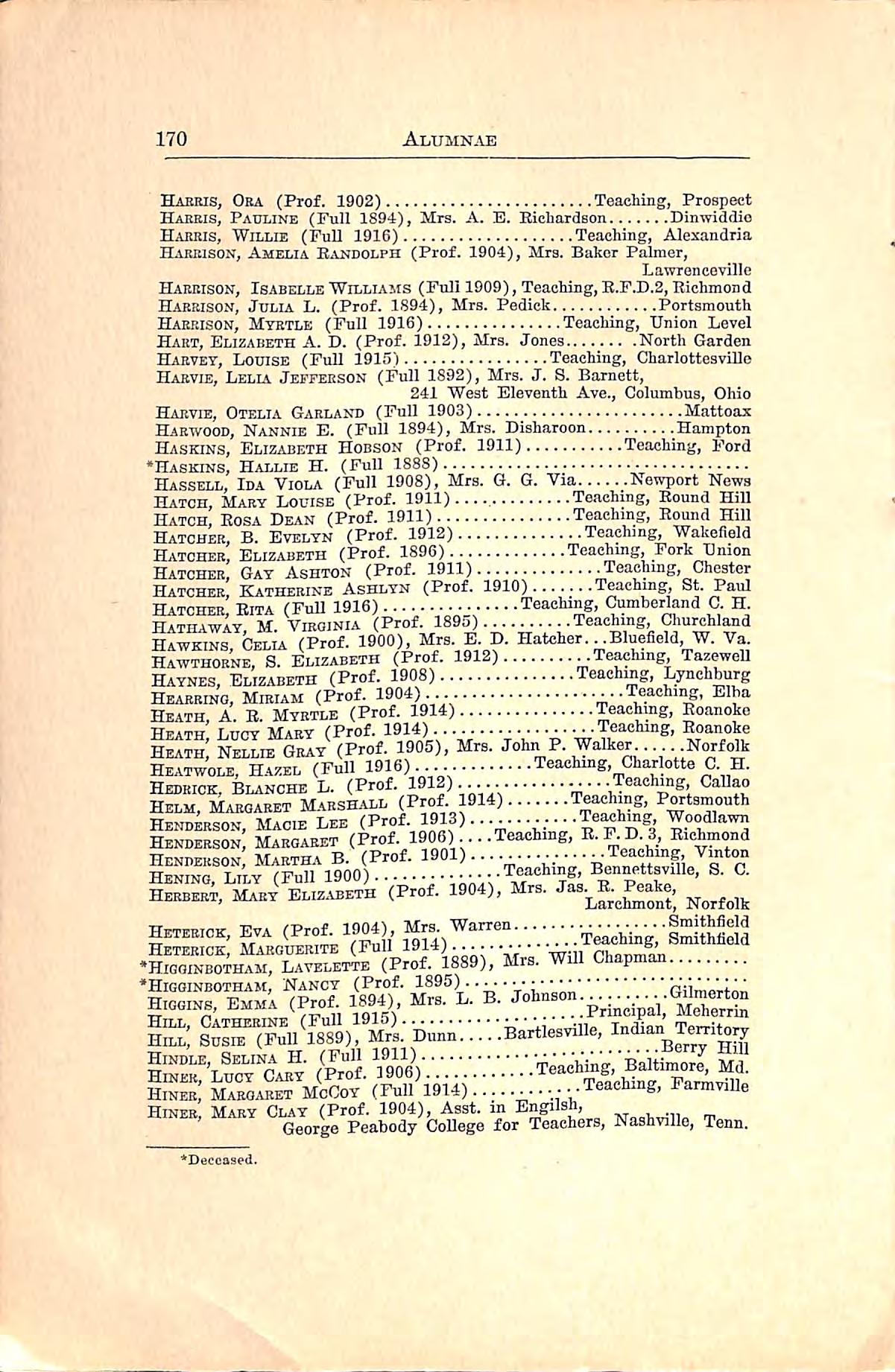
Haebis,Oea(Prof.1902)
Teaching,Prospect Haeeis,Pacline(Full1894),Mrs.A.B.Eichardson Dinwiddio Harris,Willie(Full1916) Teaching,Alexandria Harrison,AmeliaEandolph(Prof.1904),Mrs.BakorPalmer, Lawronceville Harrison,IsabelleWilliams(Full1909),Teaching,R.F.D.2,Richmond Harrison,JuliaL.(Prof.1894),Mrs.Pedick Portsmouth Harrison,Myrtle(Full1916) Teaching,UnionLevel Hart,ElizabethA.D.(Prof.1912),Mrs.Jones NorthGarden Harvey, Louise (Full 1915) Teaching, Cbarlottesville Harvie,LeliaJefferson(Full1892),Mrs.J.8.Bamett, 241WestEleventhAve.,Columbus,Ohio Harvie,OteliaGarland(Full1903) Mattoax Harwood,NannieE.(Full1894),Mrs.Disharoon .Hampton Haskins, Elizabeth Hobson (Prof. 1911) Teaching, Ford •Haskins, Hallie H.(Full 1888) Hassell,Ida Viola (Full 1908),Mrs.G. G.Via Newport News Hatch, Mary Louise (Prof. 1911)...., Te<aching, Round Hill Hatch,Rosa Dean (Prof.1911) Teaching,Round Hill Hatcher,B.Evelyn (Prof. 1912) Teaching, Wakefield Hatcher,Elizabeth (Prof.1896) Teaching,Fork Union Hatcher, Gat Ashton (Prof. 1911) Teaching, Chester Hatcher, EIatherine Ashlyn (Prof. 1910) Teaching, St. Paul Hatcher, Rita (Full 1916)............••.Teachin^g, Cumberland C H. Hathaway, M. Virginia (P"f. 1895). .......Teaching Chu^hlw^ Hawkins, Celia (Prof. 1900), Mrs. E D. Hatcher...Bluefield, W. Va. Hawthorne, S. Elizabeth (Prof. 1912) ..Te^hmg Tazewell Haynes, Elizabeth (Prof. 1908) Teaching, Lynchburg Hbarring, Miriam (Prof. 1904) ...Teaching, Elba Heath, A. B. Myrtle (Prof. 1914) Teaching, Roanoke Heath, Lucy Mary (Prof. 1914)..................Teaching, Roanoke Heath, Nellie Gray (Prof. 1905), Mrs. John P. Walker .. ••Norfolk Heatwole, Hazel (Full 1916).... Teaching, Charlotte C. H. Hedrick, Blanche L. (Prof. 1912)•••• Helm, Margaret Marsh.vll (Pro! 1914) Portsmouth Henderson, Macie Lee (Prof. 1913)............Teaching Wpodlawn Henderson Margaret (Prof. 1906)....Teaching, R.P.D.3, Richmond Henderson; Martha B. (Prof. 1901)...............Teaching Vmton Hening, Lily (Full 1900) ; ^ Hehbi^rt, Mary Eliz.vbeth (Prof. 1904), Mrs. Heterioe:, Eva (Prof. 19M), Mrs.^arren . .... .SjmM L^rEiMProTlsS^ Mrs. WiU Chapmsr. *Higginbotham, Nancy (Prof. 1S95) aiimArfAJ. H.ggins, Emma (Prof 1894) Mrs. L. B. hSl! 8™('fui/i8"89), Mrl'iiann Bartlesville, Inaian^Temto^ Hindee, Seeina H. /J"" Md.
HraS,' Makqaret McOoy (Full iguj ......Teaching, FarmviUe Hieer, Mary 'for^T^^^^^^ Nashville, Tenn.
♦Deceased.

Hiner,Winnie V.(Pull 1913)..Assistant in Business Office, Farnmllo Hinman,Olive M.\y (Prof.1905), TeacherofDrawing,NormalSchool,Frocloricksburg Hix,Annie(Full1SS8),Mrs.EdwardEarle Waco,Texas Hix,Cakrie(Prof.1902) Teaching,Richmond
Hodges,WillieKate(Prof.1905),Mrs.M.T.Booth Brookncal HoDNETT,Fanny (Prof.1904),Mrs.Thomas Moses Norfolk Hogg,Sarah(Full1901) Teaching,2205HanoverAve.,Richmond HOGWOOD,Louise(Full1901),Mrs.HarryRussel CapoCharles Holden,Minnie(Prof.1S97),Mrs.Thos.J.Davis..Summerton,S.C. Holland,Elise(Prof.1906) Teaching,Bcnyvillo Holland,Kellogo(Full1900) Teaching,Martinsviile Holland,Mell(Full1896),Mrs.RobertJones..Wiuston-Salem,N.C. Holman,Martha(Prof.1904),Mrs.J.D.Rand Morven Holue-s,Grace(Prof.1903)
Teaching,TacomaPark,D.C. Holt,M,\ryArmiste.ad(Full1912)
Teaching,Phoebus Holt,MartSills(Kind.1907)
Teaching,Norfolk Holt,Susie M.(Full1912)....Teaching,1413 Fillmorc St.,Lynchburg Homes,Laur.\.CIogbill(Prof.1911) Teaching,Portsmouth Homes,MaryVirginia(Prof.1905),Mre.C.WallaceColeinan, Boydton Hood, M.adoe (Full 1915)
Teaching, Petersburg Hood,Nellie(Full1915)
Teaching,Wholey\nllo Hook,Lillian(Full1901),Teaching,602SeventhAve.,S.W.,Roanoke Hooper, Lklia Mae (Full 1912), Teaching,805PorterSt.,SouthRichmond Hooper,Mary (Prof.1895),Mrs.Bernard McClaugherty, Bluefield,W.Va. Hope,Etta Virginia (Full 1911),Frs.Prank Owen Hampton Hopkins,Genevieve(Full1912),Mrs.W.E.McCollum,Roidsville,N.C. Horner,MaryPickett(Full1908),Teaching, 919 Harrison St., Lynchburg HouPT,Ella (Prof.1900) I^eesburg
•HOUPT,Myrtle Ferne (Prof.1907),Mrs.Wm.C. Trueheart HousER,Nannie(Prof.1901) Teaching,Grccnvillo HOUSTON,Bruce(Prof.1900),Mrs.W.E.Davis Hazard,Kv. Howard,Clara Bernice(Full 1908),Mrs.Ernest L.Garrett, Bluefield,W.Va. Howard, Elizabeth (Prof. 1906), Mrs. N. P. Jenrette Tahore, N. C. Howard,Ida (Prof. 1900), Mrs. J. H. Chiles Clearmont, Fla! Howard, Myra (Prof. 1905).......... Teaching, Pulaski Howard, Pauline Whitney (Prof. 1911), Teaching, Williamson, W. Va Howell,Esme(Full1912),Mrs.ThomasSmith... Bristoi Howert'ON, Anna James (Prof. 1911) Teaching, Honrico County Howison,Alice Marshall(Kind.1914)..Teaching,Greenville, N.C. Hoy, Helen Louise (Full 1910).. Teaching, Bristoi Hoy, Martha Albinb (Full 1909)... Hubbard,Ethel Bilvdley (Full 1910) Teaching,Wilcox Wharf •Hubbard, Ida (Full 1888), Mrs. Giles. Huddle, Mary Margaret (Prof.1914) Teaching,Ivanhoo Huddle,Myrtle E. ^ AvA Teaching, Adkina Hudgins,Carrie Irene (Kind.1914) Teaching,Richmond
'Doccasod.

Hudgins,MaryEllen (Prof.1892),Mr.-.Oscar Hudgins, 610HawthorneAve.,GintcrPark,Biehmond Hudgins,Ruby(Full1894),Mrs.Chap Diggs Hampton Hudson,Mary Margaret(Full 1909), Mrs. John A.Grosecloso, Teaching,Marion Hughe.s,Lillie (Prof. 1915) Teaching, Marion Hughes,Nannie(N.P.Cert.1915) Teaching,Marion Humphries,Madge(Prof.1897) Teaching,Lignum Hundley,Alice(Full1892) Teaclmig,Danville Hundley,JulietteJefferson(Prof.1907), Teaching,.>20EastFranklinSt.,Richmond Hundley,M.Louise(Full1916) Teaching,Beulahville Hunt,Bep.thaM.ay(Full1913) Teaching,Poquoson Hunt,Flokine(Full1894),Mrs.A.MFowler, 34GroveAve.,Eidgewood,N.J. Hunt,Kate(Full1888) Bristol Hunter,CarrieOlivia(Prof.1911),Mrs.MarionWillis,Frederickshurg Hunter,Irene(Full1916) Teaching,Pulaski Kurd,WillieAyres(Prof.1909) Teaching,DarlingtonHeights Hurdle,SallieBlanchard(Full1914) Teaching,DeepCreek Hurpp,EvelynMay(Full1913),Mrs.MacCross Suffolk Hurst,Grace(Prof.1905) Teaching,Norfolk Hurt,Jemima(Prof.1904) ....Salem HuTCHESON,HallieM.(Prof.1912) Teaching,Aldia •Hutter,ImogenGordon(Full1908)
Inouam,FlorenceLintvood(Full1906^, Teaching,JohnMarshallSchool,Richmond Ingram,NellDouglvs(Full1906), Teaching,214-AJeffersonSt.,Danville Irvine,Lucy(Prof.1891),Mrs.J.Irvine Clare Irvike,Anne(Full1897),Mrs.A.M.Evans Amelia IVES,Maud(Prof.1905) Teaching,LandofPromise Ivy,Elizabeth (Prof.1897),Teacher of Drawing, 134622dSt.,NewportNews Ivy,Mrs.SallieB.(Full1895) Box426,Ashland
Jackson, Jennie (Full 1901), Mrs. Edward Roberts Arvonia Jackson, Lelia (Full 1906) Teaching, Thomasville, Ga. Jackson, Margaret (Kind. 1915) Teaching, Richmond Jackson, Mary (Full 1898) Teaching, Farmvillo Jackson,Sallie T.(Full 1912) Kcnbridge J.AMRS, Georgia (Prof. 190.3) Teaching, Mathews James, Elizabeth F.(Prof. 1905), Mrs. J. Kent Dickinson, Scottsburg James,Martha(Kind.1913) Teaching,Rocky Mount,N.C. Jamison, Eleanor,(Full 1908)..Teaching,903 W. Grace St., Richmond Jamison,Ruth,(Full 1916) Teaching,Blackstone, R.D. Janney, Alice McA. (Full 1912) Teaching, Waterford Jarman, Elizabeth (Kind. 1916) Teaching, S. N. S., Farmville Jarratt, Elizabeth (Kind. 1915) Teaching, Petersburg Jayne, Florence M. (Full 1911) Teaching, Surry Jayne, M.VTTIE (Full 1895) Washington, D. C. Jepprtes, Mary (Full 1905), Mrs. Gilliam Culpeper 'Deceased.
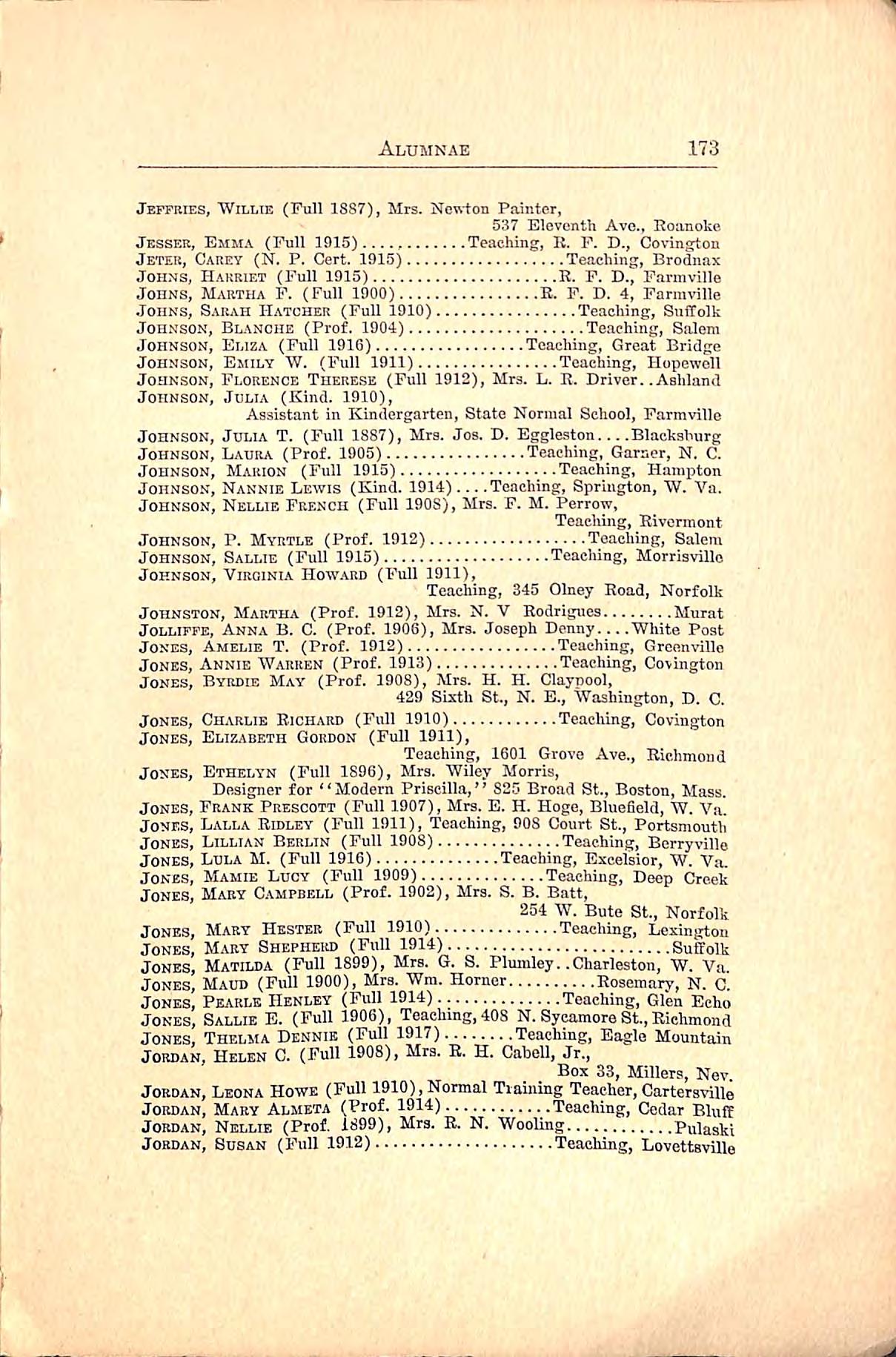
Jefpries,"Willie(Full 1887),Mrs.Nevston Painter, 537EleventhAvc.,Eounoke Jesser,EiiMA(Full1915)...., Teaching,R.F.D.,Covington Jeter,Carey(N.P.Cert.1915) Teaching,Brodnax Johns,Harriet (Full 1915)
R.F.D., Farmville Johns,Martha F.(Full 1900)
R.F.D.4,Farmville Johns,SarahHatcher(Full1910) Teaching,SufTolk Johnson,Blanche(Prof.1904) Teaching,Salem Johnson,Eliza(Full1916) Teaching,GreatBridge Johnson,EmilyW.(Full1911) Teaching,Hopewell Johnson,FlorenceTherese(Full1912),Mrs.L.R.Driver..Aahland Johnson,Jolia(Kind.1910), AssistantinKindergarten,StateNormalSchool,Farmville Johnson,JuliaT.(Full1887),Mrs.Jos.D.Eggleston....Blackshurg Johnson,Laura(Prof.1905) Teaching,Garner,N.C. Johnson,Marion(Full1915) ...Teaching,Hampton JoHNSo.s*,NannieLewis(Kind.1914)....Teaching,Sprlngton,\V."Va. Johnson,NellieFrench(Full1908),Mrs.F.M.Perrow, Teaching,Rivcrmont Johnson,P.Myrtle(Prof.1912) Teaching,Salem Johnson,Sallie(Full1915) Teaching,Morrisvillo Johnson,"VirginiaHoward(Full1911), Teaching,345OlneyRoad,Norfolk Johnston,Martha(Prof.1912),Mrs.N."VRodrigucs Murat JoLLiFFE,AnnaB.C.(Prof.1906),Mrs.JosephDenny...."WliitePost Jones,AmelieT.(Prof.1912) Teaching,Greenville Jones,AnnieWarren(Prof.1913) Teaching,Covington Jones,ByrdieMay(Prof.1908),Mrs.H.H.Claypool, 429SixthSt.,N.B.,Washington,D.0. Jones,CharlieRichard(Full1910) Teaching,Covington Jones,ElizabethGordon(Full1911), Teaching,1601GroveAve.,Richmond Jones,Ethelyn(Full1896),Mrs.WileyMorris, Designerfor"ModernPriscilla,"825BroadSt.,Boston,Mass. Jones,FrankPrescott(Full1907),Mrs.E.H.Hoge,Bluefield,W.Va. Jones,LallaRidley(Full1911),Teaching,908CourtSt.,Portsmouth Jones,Lillian Berlin (Full 1908) Teaching, Bcrryville Jones,LulaM.(Full1916) Teaching,Excelsior,W.Va. Jones,MamieLucy(Full1909) Teaching,DeepCreek Jones,Mary Campbell(Prof.1902),Mrs.S.B.Batt, 254W.ButeSt.,Norfolk Jones, Mart Hester (Full 1910) Teaching, Lexington Jones,M.\ry Shepherd (Full 1914) Suffolk Jones,Matilda (Full 1899),Mrs.G.S. Pluiuley..Charleston, W.Va Jones, Maud (Full 1900), Mrs. Wra. Homer Rosemary, N. C. Jones,Pearle Henley(Full1914) Teaching,Glen Echo Jones,SallieE.(Full1906),Teaching,408 N.SycamoreSt.,Richmond Jones,Thelma Dennie(Full 1917) Teaching,Eagle Mountain Jordan, Helen C.(Full 1908), Mrs. R. H. Cabell, Jr., Box 33,Millers, Nev Jordan,LeonaHowe(Pull1910),NormalTiainingTeacher,Cartersville Jordan, Mary Almeta (Prof. 1914) Teaching, Cedar Bluff Jordan, Nellie (Prof. Iil99), Mrs. R. N. Wooling Pulaski Jordan,Susan (Full 1912) Teaching,Lovottaville

Justice,PkablMcVot(Prof.1911) Teaching,Jarratt JusTis,Elizabeth(Prof.1906) Teaching,Blackstone
BI<vbler,LeliaFlippen(Full1914) Teaching,Eichmond Kay,CoraBelle(Prof.1904), Student,GeorgePeabodyCoUegeforTeachers,Nashville,Tenn. Katton,Adrelia(Full1916) Teaching,AlexandriaCounty *Kean,Elvira(Full1S95)
Keith,EubtbM.(N.P.Cert.1913) Teaching,BotetourtCo. Kellam,ElizabethDegge(N.P.Cort.1914), Teaching,JohnMarshallH.S.,Eichmond Keller,EubyLee(Full1913) Teaching,PlantCity,Fla. Kelly, Hattie Jake (Prof. 1906) Teaching, Newport News Kelly,JosephineHull(Prof.1909), T-"W.C.A.Secretary,Burlington,N.C. Kemp, Avis (Full 1912) Teaching, Norfolk Kemper,Corinne (Full 1914) 1416 Nelson St., Eoanoke Kendeick, Elizabeth (Full 1914) Bluefield, "W. Va. Kennerly,MarthaM.(Full1897),Teaching,230101stSt.,NowYorkCity Kent,Fannie(Prof.1915) Teaching,Saltville
Kent,Julia Ione (Prof.1907),Mrs.Arthur JoUy Franklin Kent,Mary (Prof. 1912) Teaching, Williamsburg King, Bessie Byrd (Prof. 1904), Mrs. W. A. Echles Glen Allen King, Elizabeth Windsor (Prof. 1904) Teaching, Alexandria Kino,Emma (Prof. 1902), Mrs. H.H.Edwards Goldvoin King,Gertrude Caroline (Prof.1906) Foster Falls King, Marietta (FuU 1910) Teaching, Honaker Kipps,Mary Eloise (Kind.1911), Mrs.E.F.Birckhead,Jr., FrodericLsburg
Kinzer, Annie (Prof. 1902), Mrs. Ernest Slmwen,BartonHeights,Richmond
Kipps, Landonia (Prof. 1897), Mrs. Ghas. Black Blacksburg
Kizer, Claudine (Prof. 1902) ....Teaching Laurel, Miss. Kizer, Lizzie (Prof. 1906) Teaching, 1622 Grace St., Lynchburg Kizkr, Ruth (Kind. 1909) Teaching, 1622 Grace St., Ljmchburg
Kline, Esther (Full 1916) W' Stuarts Draft Knott,Mary Katherine (Prof. 1908),Mrs.D^id B.Olgers,Sutherland Krish,AnneEline(Full1912) Kyle, Caroline Llewelyn (FuU 1907), Mrs. F. G. Baldwin..FarmviUe
La Boyteaux, Bee (Prof. 1905) Teaching, Charlestown, W. Va La Boyteaux, Ethel Scon? (Full 3910) Teaching, Richmond *La Boyteaux, Zoula (Full 1906) 'o'
Lackey, Mary Eglantine (Prof. 1910)..Teaching,E. F. D.2, Fairfield Laird, Cassandra (Prof. 1909) Teachmg, Pocahontas Lancaster, Anne Leitch (FuU 1908) Teaclmig, Ashland Lancaster,Natalie (Prof.1899,FuU 1900), , Head of Department of Mathematics, Normal School, Harrisonburg Landrum, Edna E. (Full 1912) Te^hing, Fredencksburg Landeum, Elsie P. (Full 1911)..Teaching, 218 Walnut St., Lynchburg Langslow,VictoriaMay(Full1911), Teaching,2900 Chestnut Ave., Newport News 'Deceased.
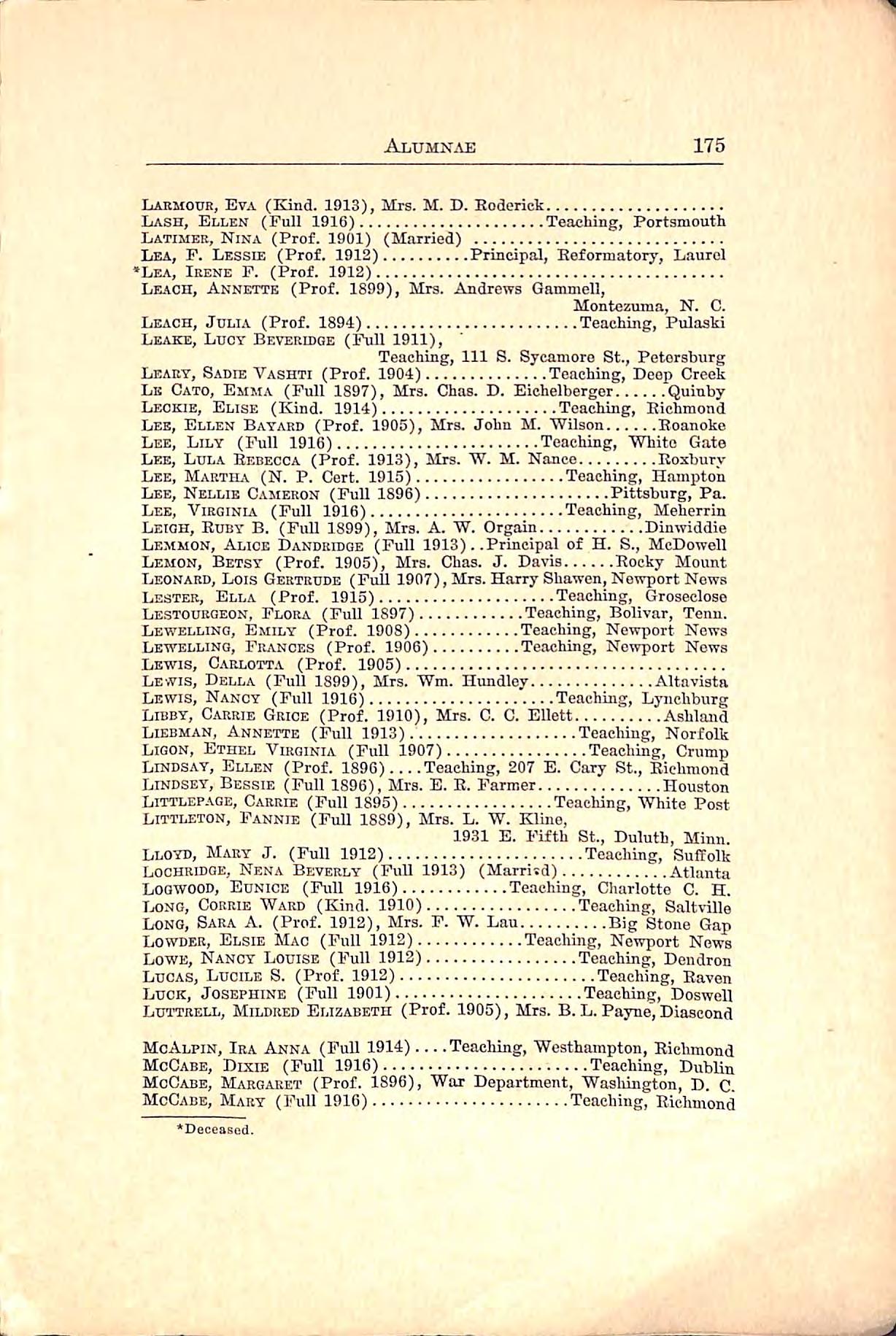
IiARMOUR,Eva(Kind.1913),Mrs.M.D.Eoderick Lash,Ellen(Full1916) Teaching,Portsmouth Latimer,Nina(Prof.1901)(Married)
Lea,F.Lessie(Prof.1912) Principal,Eeformatory,Laurel •Lea,Irene F.(Prof. 1912)
Le.'VCH,Annette(Prof.1899),Mrs.AndrewsGammell, Montezuma, N. C. Leach,Julia(Prof.1894) Teaching,Pulaski Leahe,LucvBeveridge(Full1911), Teaching,111S.SycamoreSt.,Petersburg Leary,SadieVashti(Prof.1904) Teaching,DeepCreek LkOato,Emma(Full1897),Mrs.Chas.D.Eichelberger Quinby Leckie,Elise(Kind.1914) Teaching,Eichmond Lee,EllenBayard(Prof.1905),Mrs.JohnM."Wilson Eoanoke Lee,Lily(Full1916) Teaching,"WhiteGate Lee,LulaEebecca(Prof.1913),Mrs.W.M.Nance Roxbury Lee,Martil^(N.P.Cert.1915) Teaching,Hampton Lee,NellieCameron(Full1896) Pittsburg,Pa. Lee,Virginia(Full1916) Teaching,Meherrin Leigh,RubyB.(Full1899),Mrs.A.W.Orgain Dinwiddie Lemmon,AliceDandridge(Full1913)..PrincipalofH.S.,McDowell Lemon,Betsy(Prof.1905),Mrs.Chas.J.Davis RockyMount Leonard,LoisGertrude(Full1907),Mrs.HarryShawen,NewportNews Lester,Ella(Prof.1915) Teaching,Groseclose Lestourgeon,Flora(Full1897) Teaching,Bolivar,Tenn. Lewelling,Emily(Prof.1908) Teaching,NewportNews Lewelling,Frances(Prof.1906) Teaching,NewportNews Lewis,Carlotta(Prof.1905) Lewis,Della(Full1899),Mrs.Wm.Hundley Altavista Lewis,Nancy(Full1916) Teaching,Lyiichburg Libby,CarrieGrice(Prof.1910),Mrs.C.C.Ellett Ashland LiEBMAN,Annette(Full1913) Teaehiag,Norfolk LiGON, Ethel Virginia (Full 1907) Teaching, Crump Lindsay,Ellen(Prof.1896) Teaching,207E.CarySt.,Eichmond LiNDSEY,Bessie(Full1896),Mrs.E.E.Farmer Houston Littlepage,Carrie(Full1895) Teaching,"WhitePost Littleton,Fannie(Full1889),Mrs.L.W.Klme, 1931E.FifthSt.,Duluth,Minn. Lloyd,MaryJ.(Full1912) Teaching,Suffolk LoCHRiDGE,NenaBeverly(FuU1913)(Marriid) Atlanta Logwood,Eunice(Full1916) Teaching,CharlotteC.H. TjONG,CoRRiEWard(Kind.1910) Teaching,SaltviUe Long,Sara A.(Prof.1912),Mrs.F.W.Lau Big Stone Gap Lowder,ElsieMac(Full1912) Teaching,NewportNews Lowe,NancyLouise(Full1912) Teaching,Dendron Lucas,LucileS.(Prof.1912) Teaching,Raven Luck,Josephine(Full1901) Teaching,Doswell Luttrell,MildredElizabeth(Prof.1905),Mrs.B.L.Payne,Diascond
McAlpin,Ira Anna(Pull1914) Teaching,Westhainpton,Richmond McCabe,Dixie(FuU1916) .....Teaching,Dublin McCabe,Margaret (Prof. 1896), War Department,Waaliington,D,C. McCabe,Mary(Full1916) Teaching,Riclimond
•Deceased.
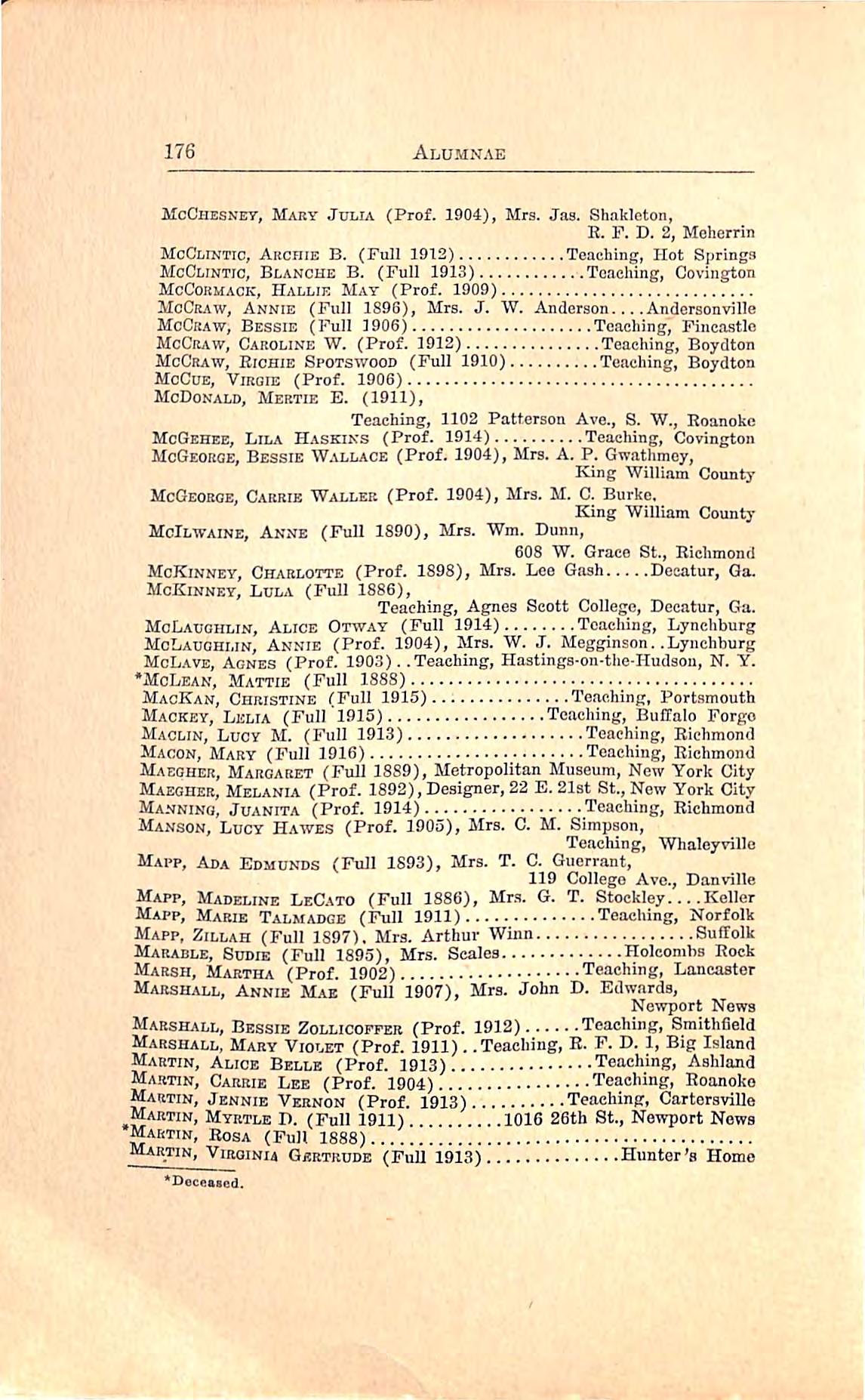
ifcCHESKBr,MaryJulia(Prof.1904),Mrs.Jas.Shakleton, R.F.D.2,Meherrin McClintic,ArchieB.(Full1912) Teaching,HotSprings McClintic,BlancheB.(Full1913) Teaching,Coving^on McCoiimack,HallieMat(Prof.1909) McCraw,Annie(Full1896),Mrs.J.W.Anderson. .Andersonville McCraw,Bessie(Full1906) Teaching,Fiiicastlo McC/lvw,CarolineW.(Prof.1912) Teaching,Boydton McCraw,RichieSpotswood(Full1910) Teaching,Boydton McCue,Virgie(Prof.1906) McDonald,MertieE.(1911), Teaching,1102PattersonAve.,S.W.,Roanokc McGehee,LilaHaskins(Prof.1914) Teaching,Covington McGeobge,BessieWallace(Prof.1904),Mrs.A.P.Gwathmcy, KingWilliamCounty McGeoroe,CarrieWaller(Prof.1904),Mrs.M.C.Burke. KingWilliamCounty McIlwaine, Anne (Full 1890), Mrs. Wm.Dunn, 608W.GraceSt.,Richmond McKinnet,Charlotte (Prof.1898), Mrs.Lee Gash Deeatur,Qa. McKinnet,Lula(Full1886), Teaching,AgnesScottCollege,Deeatur,Ga. McLaughlin,AliceOtwat(Full1914) Teaching,Lynchburg McLaughlin,Annie (Prof. 1904), Mrs. W.J. Megginson..Lynchburg McLave,Agnes(Prof.1903)..Teaching,Hastings-on-the-Hudson,N.Y. •McLean,Mattie(Full1888)
MacKan,Christine(Full1915)
Teaching,Portsmouth Mackey,Lelia (Full 1915) Teaching, BufTalo Forgo Maclin,Lucy M.(Full 1913) Teaching,Richmond Macon,Mary (Full 1916) Teaching,Richmond Maegher,Margaret(Full 18S9),Metropolitan Museum,New York City Maegher,Melania(Prof.1892),Designer,22E.21stSt.,New York City Manning, Juanita (Prof.1914) Teaching, Richmond Manson,Lucy Hawes (Prof.1905),Mrs.0. M.Simpson, Teaching,Whaleyrillo Mapp,Ada Edmunds (Full 1893), Mrs. T. C. Guerrant, 119CollegeAve.,Danville Mapp, Madeline LeCato (Full 1886), Mr.s. G. T. Stockley....Keller Mapp, Marie Talmadgb (Full 1911) Teaching, Norfolk Mapp,Zillah (Full 1897).Mrs.Arthur Winn Suffolk Marable, Sudie (Full 1895), Mrs. Scales Holcombs Rock Marsh, Martha (Prof. 1902) Teaching, Lancaster Marshall,Annie Mae (Full 1907), Mrs. John D.Edwards, NewportNews
Marshall,BessieZollicopper(Prof.1912) Teaching,Smithfield Marshall,Mary Violet(Prof.1911)..Teaching,R.F.D.1,BigIsland Martin, Alice Belle (Prof. 1913) Teaching, Aahland Martin, Carrie Lee (Prof. 1904) Teaching, Roanoko Martin, Jennie Vernon (Prof. 1913) Teaching, Cartorsville Martin, Myrtle D.(Full 1911) 1016 26th St., Newport News Martin, Rosa (Full 1888) Martin, Virginia Gertrude (Full 1913) Hunter's Home
^Deceased.
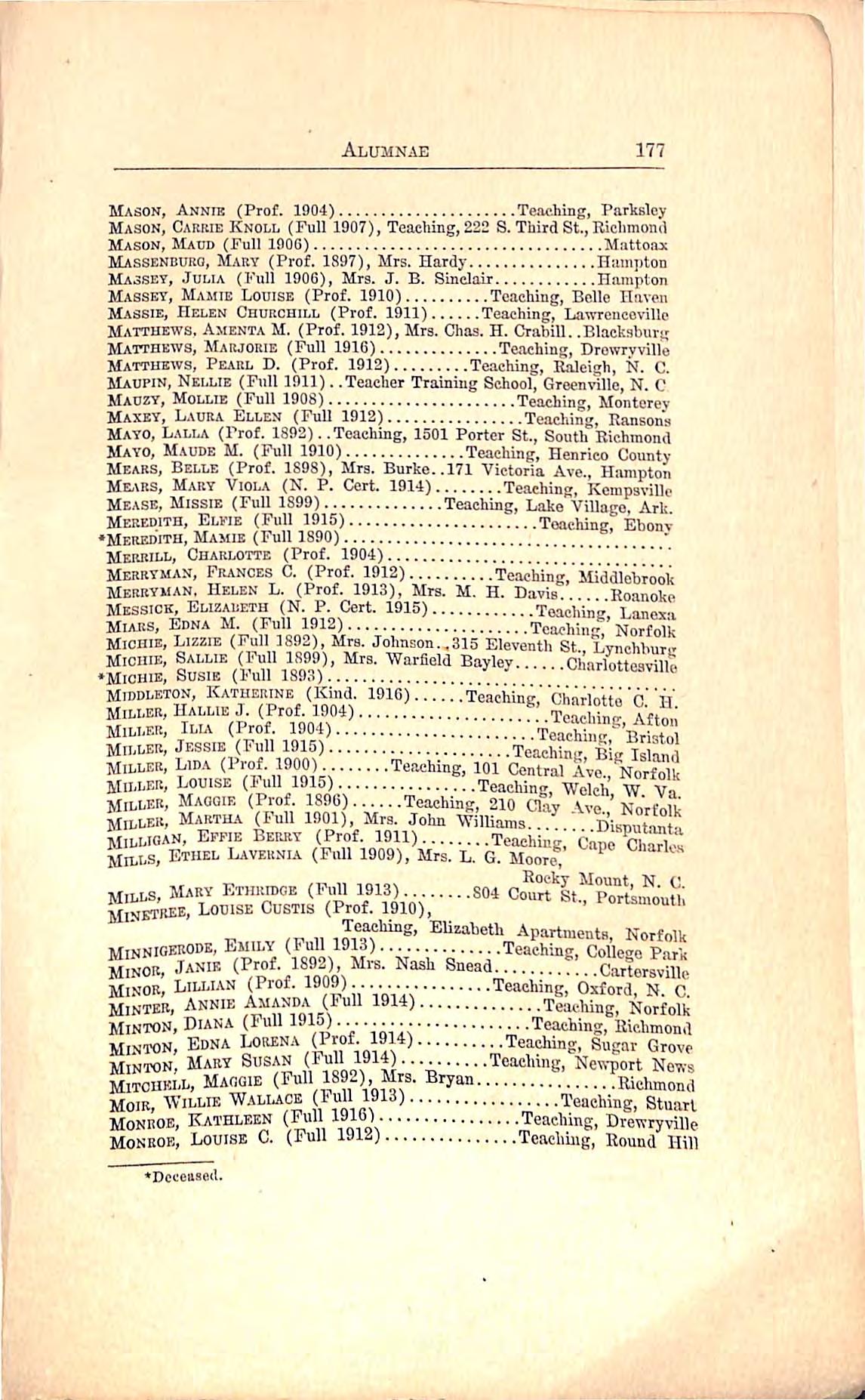
Masok,Annie(Prof.1904) Teaching,Parksley Mason,CarrieKnoll(Full1907),Teaching,2228.ThirdSt.,Richmond Mason,Maud(Full1006) Mattoax Massenburo,Mary(Prof.1897),Mrs.Hardy Hiunpton MaoSEY,Julia(Full1906),Mrs.J.B.Sinclair Hampton Massey,MamieLouise(Prof.1910) Teaching,BelleHaven Massie,HelenChurchill(Prof.1911) Teaching,La\vroiicovi!le Matthews.AmentaM.(Prof.1912),Mrs.Chas.H.Crahill..Blacksburg Matthews,Marjorie(Full1916) Teaching,Drowrvvillo Matthews,PearlD.(Prof.1912) Teaching,Raleigh,N.C. Maupin,Nellie(Full1911)..Teacher TrainingSchool,Greenville,N.C Madzy,Mollie(Full 1908) Teaching,Monterey Maxey,L.vura Ellen (Full 1912) Teaching, Ransona Mayo,Lalla(Prof.1892)..Teaching,1501PorterSt.,SouthRichmond Mayo, Maude M. (Full 1910) Teaching, Henrico County Mears, Belle (Prof. 1S98), Mrs. Burke..171 Victoria Ave., Hampton Me.\RS, Mary Viola (N. P. Cert. 1914) Teaching, Kcmpsvillc Mease, Missie (Full 1899) Teaching, Lake Village Ark Meredith, Elpie (Full 1915) Teaching, Ebonv •Meredith,Mamie(Full1890)
Merrill,Charlotte(Prof.1904) Merryman, Frances C. (Prof. 1912) TeachingVMiddlcbrook Merryman. Helen L.(Prof. 1913), Mrs. M.H. Davis.. Roanoke Messick, Elizabeth (N. P. Cert. 1915) Teaching, Lanoxa MiARS, Edna M. (Full 1912) Tcachln'- Norfolk MrcHiE,Lizzie(Full 1892),Mrs.Johnson.,315Eleventh St Lvnchbur.r MrcniE, Sallie (Fun 1899), Mrs. Warfield Bayley Cha&S •MicHiE,Susie(Full1893)
MiDDLETON, Katuertne (Kind. 1916) Teaching," Chnrlotto c"'h Miller, Hallie J. (Prof. 1904) .Sing Afton Miller. Ilu (Prof. 1904) VTeacS^
Miller, Jessie (Full 1915) TeacS
Miller,Lida (Prof. 1900) Teaching,101 Central Ave., Nor^lk Miller, Louise (1^11 1915) Teaching, Welch W Vn Miller, Maggie (Prof. 1890) Teaching, 210 Clay \ve'Norfolk Miller, Marth.a (Full 1901), Mrs. John Williams..^ DisuutS ^,,,igan, Efpie Berry (Prof 1911) Teaching CaprCh^ Mills,EthelLaveunia(Full1909),Mrs.L.G.Moore, Mills, Mary ETHnrooE (Full 1913) 804 Go^rt''st.fpTrtemoutii MiKBTREE, Louise Custis (Prof. 1910), Teaching, Elizabeth Apartments Norfolk MiNNiGEROOE, Emily (Full 1913) Teaching, ZoR,Janie (Prof. 1892) Mi-s. Naah Snead .Carters^li: Minor, Lillian (Prof. 1909)........ Teaching, Oxford, N. C. MiNTER, Annie Amanda (Full 1914) Teaching, Norfolk MiNTON,Diana (Full 191u)... .Teaching, Richmond MiNTON, Edna Teaching, Sugar Grove MiNTON, Mary SrVp'rir"""^ Ne^-port News Mitchell, Ma^ie lliehmond MoiR, Willie Wallace (Full 1913) .....Teaching, Stuart Monroe, Kathleen (Full 191b) .Teachmg, Drewryville Monroe, Louise C. (i'uli lyia) Tcaclmig, Round Hill
•Deceased.
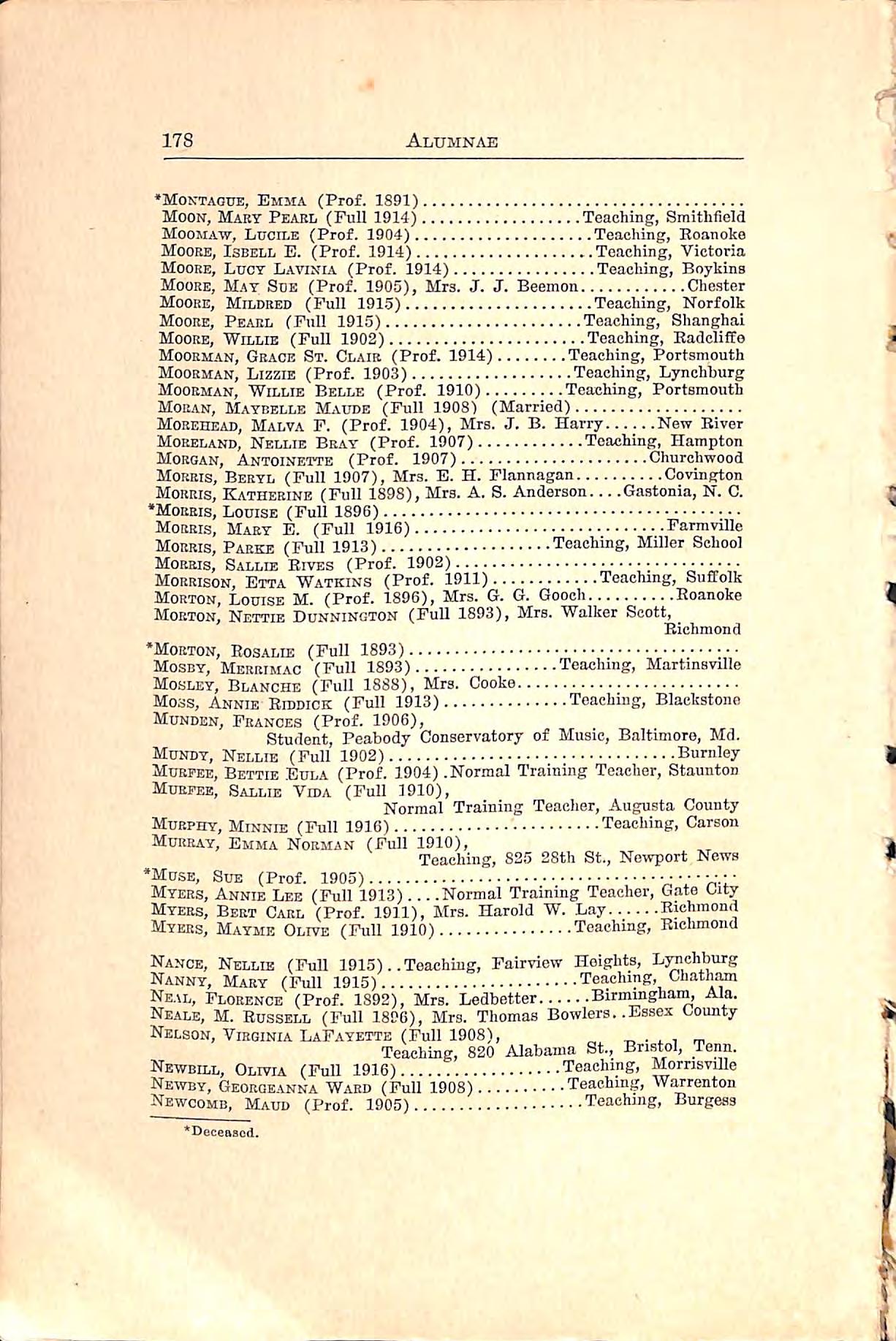 Alumnae
Alumnae
•Moktague,Emma(Prof.1891)
Moon',MaryPearl(Full1914)
Teaching,Smithfiold Moomaw,Lucile(Prof.1904) Teaching,Eoanoke Moore,IsbellE.(Prof.1914) Teaching,Victoria Moore,LucyLavinia(Prof.1914) Teaching,Boykins
Moore,MaySue(Prof.1905),Mrs.J.J.Beemon Chester Moore,Mildred(Full1915) Teaching,Norfolk Moore,Pearl(Full1915) Teaching,Shanghai Moore,Willie(Full1902) Teaching,Raclcliffo Moorman,GraceSt.Glair(Prof.1914) Teaching,Portsmouth Moorman,Lizzie(Prof.1903) Teaching,Lynchburg Moorman,WillieBelle(Prof.1910) Teaching,Portsmouth Moean,MaybelleMaude(Full1908)(Married) Morehead,MalvaF.(Prof.1904),Mrs.J.B.Harry....NewRiver Moreland,NellieBray(Prof.1907) Teaching,Hampton Morgan,Antoinette(Prof.1907) Churchwood Morris,Beryl(Full 1907),Mrs.B.H.Flannagan Covington Morris,Katherine(Full1898),Mrs.A.S.Anderson Gastonia,N.C. •Morris,Louise(Full1896)
Morris, Mary E. (Full 1916) Farmville Morris,Parks (Full 1913) Teaching, Miller School Morris, Sallie Rives (Prof. 1902) •*'':: X'l.*;,' Morrison,Etta Watkins (Prof. 1911) Teaching,Suffolk Morton, Louise M. (Prof. 1896), Mrs. G. G. Gooch Roanoke Morton,Nettie Dunnington (Full 1893),Mrs. Walker Scott, Richmond
•Morton, Rosalie (Full 1893)
Mosby, Merrimac (Full 1893) Teaching, Martinsville Mosley,Blanche (Full 1888), Mrs. Cooke Moss, Annie Riddick (Full 1913) Teaching, Blackstone Munden,Frances (Prof. 1906), Student, Peabody Conservatory of Music, Baltimore, Md. Mundy, Nellie (Full 1902) Burnley Murfee, Bettie Eula (Prof. 1904).Normal Training Teacher, Staunton Murfee, Sallie Vida (Full 1910), NormalTrainingTeacher,AugustaCounty Murphy, Minnie (Full 1916) Teaching, Carson Murray,Emma Norman (Full 1910), Teaching,825 28tii St., Newport News
•Muse, Sue (Prof. 1905) V;V-nM* Myers,AnnieLee(Full1913) NormalTraining Teacher,Gate Lity Myers, Bert Carl (Prof. 1911), Mrs. Harold W. Lay Richmond Myers, Mayme Olive (Full 1910) Teaching, Richmond
Nance, Nellie (Full 1915)..Teaching, Fairview Heights, Lj^chburg Nanny, Mary (Full 1915) Teaching, Chathm Neal, Florence (Prof. 1892), Mrs. Ledbetter Birmingham, Ala. Neale, M. Russell (Full 1896), Mrs. Thomas Bowlers..Essex County Nelson, Virginia LaFayette (Full 1908), ^ m Teaching, 820 Alabama St., Bristol, Tenn. Newbill, Olivia (Full 1916) Teaching, Morrisville Newby, Georgeanna Ward (Full 1908) Teaching, W^renton Newcomb, Maud (Prof. 1905) Teaching, Burgess
•Deceaaod.
Nichols,Helene(Full1916)
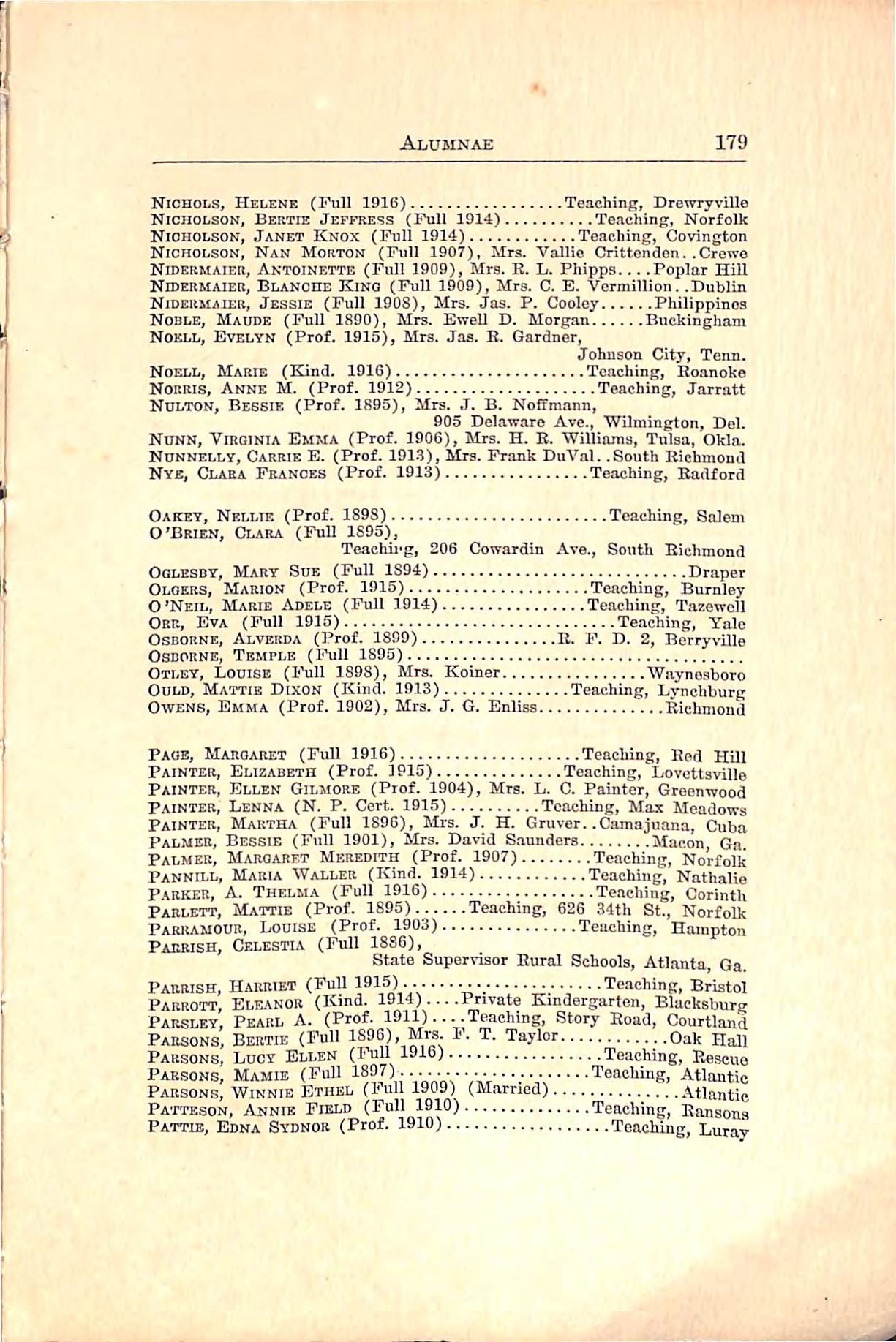
179
Teaching,Drowryville Nicholson, Bertie Jepfress (Full 1914) Teaching, Norfolk Nicholson,JanetKnox(Full1914) Teaching,Covington Nicholson, Nan Morton (Full 1907), Mrs. Vallic Crittonden..Crewo Nidermaier,Antoinette(Full1909),Mrs.R.L.Phipps PoplarHill Nidermaier,Blanche Kino(Full1909),Mrs.C.E.Vermillion..Dublin Nidermaier,Jessie(Full190S),Mrs.Jas.P.Cooley Philippines Noble,Maude(Full1890),Mrs.EwellD.Morgan Buckingham Nokll,Evelyn(Prof.1915),Mrs.Jas.E.Gardner, JohnsonCity,Tenn. Noell,Marie(Kind.1916) Teaching,Roanoke Norris,AnneM.(Prof.1912) Teaching,Jarratt Nulton,Bessie(Prof.1895),Mrs.J.B.Noffmann, 905DelawareAve.,Wilmington,Del. Nunn,VirginiaEmma(Prof.1906),Mrs.H.R.Williams,Tulsa,Okla. Ndnnelly,CarrieE.(Prof.191.3),Mrs.FrankDuVal..SouthRichmond Nye,ClaraFrances(Prof.1913) Teaching,Radford
Oakey,Nellie(Prof.1898)
Teaching,Salem O'Brien,Clara(Pull1S95), Teaching,206CowardinAve.,SouthRichmond Oglesdy, Mary Sue (Full 1894) Draper Olgers,Marion(Prof.1915) Teaching,Burnley O'Neil,MarieAdele(Full1914) Teaching,Tazewell Obr,Eva(Full1915) Teaching,Yale OscORNE,Alverda(Prof.1899) B.p.D.2,Berryville OsEORNE,Temple(Full1895) Otley,Louise(Full1898),Mrs.Koiner Wnynesboro OuLD,Mattie Dixon (Kind.1913) Teaching,Lynchburg Owens,Emma(Prof.1902),Mrs.J.G.Enliss Richmond
Page,Margaret(Full1916)
Teaching,RedHill Painter,Elizabeth(Prof.3915) Teaching,Lovettsville Painter,EllenGilmore(Prof.1904),Mrs.L.C.Painter,Groonwood Painter,Lenna(N.P.Cert.1915) Teaching,MaxMeadows Painter, Martha (Full 1896), Mrs. J. H. Gruvcr..Camajuana, Cuba Palmer,Bessie (Full 1901), Mrs. David Saunders Macon, Ga. Palmer,MargaretMeredith(Prof.1907) Teaching,Norfolk Pannill, Maria Waller (Kind. 1914) Teaching, Nathalie Parker, A. Thelma (Full 1916) Teaching, Corinth Parlett, Mattie (Prof. 1895) Teaching, 626 34th St., Norfolk Parramoub, Louise (Prof. 1903) Teaching, Hampton ParrisH, Celestia (Full 1886), State Supervisor Rural Schools,Atlanta,Ga. Parrish,Harriet(Full1915) •••. Teaching,Bristol PABRorr,Eleanor (Kind.1914) Private Kindergarten, Blucksburg Parsley, Pearl A. (Prof. 1911)....Teaching, Story Road, Courtland Parsons, Bertie (Full 1^96), Mrs. I. T. Taylor Oak Hall Parsons, Lucy Ellen (Full 1916) Teaching, Rescue Parsons, Mamie (FuU l^^J),: V'/ Teaching, Atlantic Parsons, Winnie Ethel (hull 1909) (Married) Atlantic Patteson, Annie Field (Full 1910) Teaching, Ransons Pattie, Edna Sydnor (Prof. 1910) Teaching, Luray
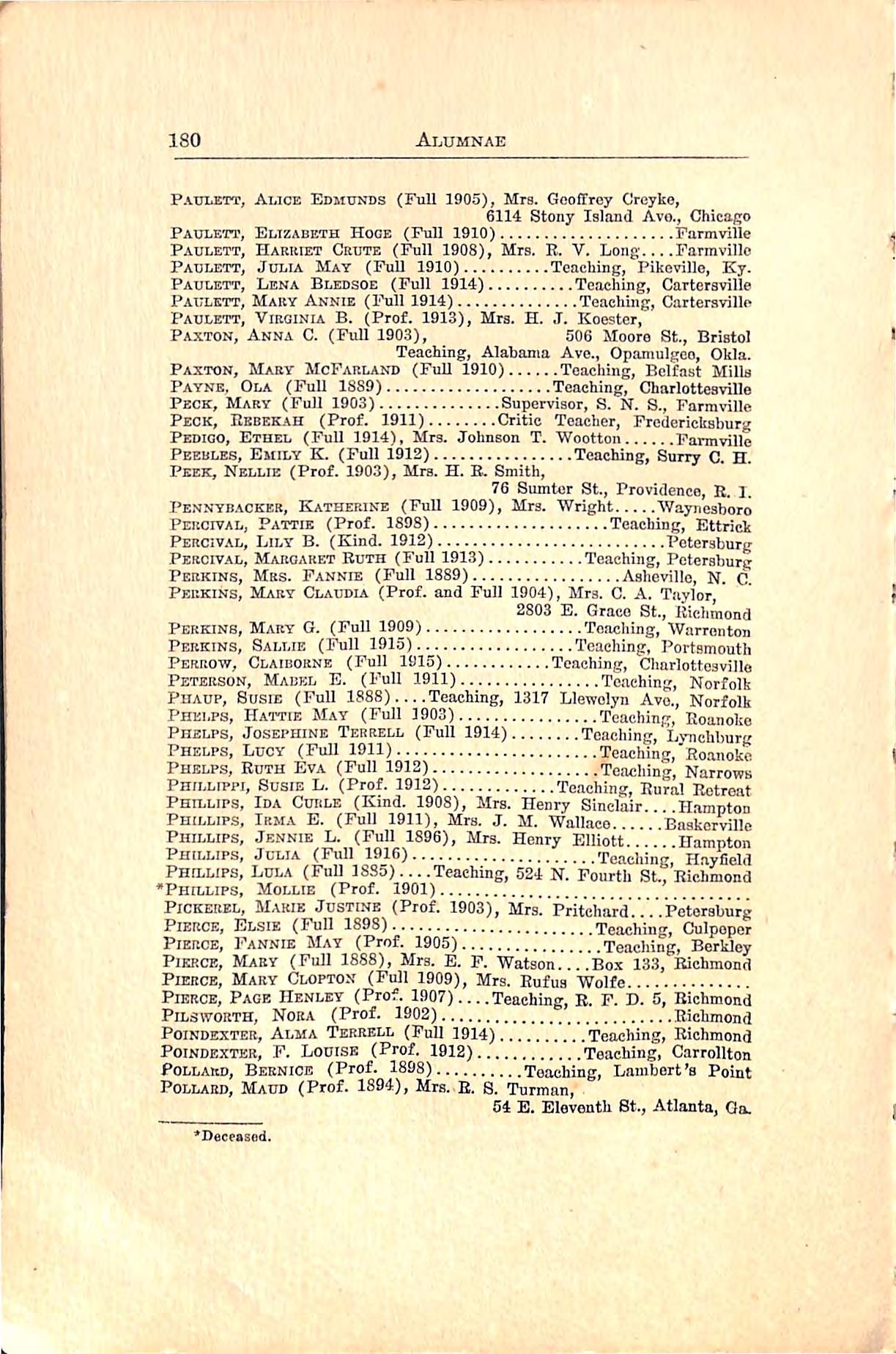
PattIiETt, Alice Edmunds(Full 1905), Mrs. Geoffrey Croyke, 6114StonyIslandAvo.,Chicago Paulett, Elizabeth Huge (Full 1910) Farmville Paulett,HaruietCrute(Ihill1908),Mrs.R.V.Long. .Farinvillo Paulett,JuliaMay(Full1910) Teaching,Pikevillo,Ky. Paulett,LenaBledsoe(Full1914) Teaching,Carteraville Paulett,MaryAnnie(Full1914) Teaching,Cartersvillo Paulett,VirginiaB.(Prof.1913),Mrs.H.J.Koestcr, Paxton,AnnaC.(Full1903), 506MooreSt.,Bristol Teaching,AlabamaAve.,Opaniulgco,Okla. Paxton,MabyMcFarland(Full1910) Teaching,BelfastMills Payne,Ola(Full18S9) Teaching,Charlottesville Peck,Mary(Full1903) Supervisor,S.N.S.,Farmville Peck, Ebbekah (Prof. 1911) Critic Teacher, Fredericksburg Pedigo,Ethel(Full1914),Mrs.JohnsonT.Wootton Farmville Peebles,Emily K.(Full 1912) Teaching,Surry C.H. Peek,Nellie(Prof.1903),Mra.H.E.Smith, 76 Sumter St.,Providence, R,]. Pennybackeb,Katherine(Full1909),Mrs.Wright Wayncsboro Percival,Pattie(Prof.1898) Teaching,Ettrick Percival, Lily B. (Kind. 1912) Petersburg Percival,MargaretRuth(Full1913) Teaching,Petersburg Perkins,Mrs.Fannie(Full1889) Aslieville,N.C. Perkins,Mary Claudia (Prof,and Full 1904),Mrs. C. A.Taylor, 2803 E.Graco St., lliclimond Perkins,MaryG.(Full1909) Tonching,Warronton Perkins, Sallie (Full 1915) Teaching, Portsmouth Perrow, Claiborne (Full 1915) Teaching, Charlottesville Peterson, Mabkl E. (Full 1911) Teaching, Norfolk Puaup, Susie (Full 1888) Teaching, 1317 Llewelyn Avo., Norfolk Phelps, Haitie May (Full 3903) Teaching, Roanoke Phelps,Josephine Terrell (Full 1914) Teaching, Lvnchburg Phelps, Lucy (Full 1911) Teaching,'Roanoke Phelps,Ruth Eva(Full 1912) Teaching, Narrows Phii.lippi, Susie L. (Prof. 3912) Teaching, Rural Retreat Phillips, Ida Curle (Kind.1908), Mrs. Henry Sinclair... Hampton Phillips,IrmaE.(Full1911),Mrs.J,M.Wallace. Easkorville Phillips, Jennie L. (Full 1896), Mrs. Henry Elliott. Hampton
Phillips, Julia (Full 1916).. Teaching, Hayfield Phillips, Lula (FuU ISSo)....Teaching, 524 N. Fourth St.. Richmond *Phillips, Mollie (Prof. 1901) ' Pickerel, Marie Justine (Prof. 1903), Mrs. piritchard. ..Petersburg Pierce, Elsie (Full 1898) Teaching, Culpoper Pierce, Fannie May (Prof. 1905) Teaching, Berkley
Pierce, Mary (Full 1888), Mrs. E. F. Watson Box 133, Richmond Pierce, Mary Clopton (Full 1909), Mrs. Rufua Wolfe Pierce, Page Henley (Prof. 1907) Teaching,B. F. D. 5, Richmond PiLswoRTH, Nora (Prof. 1902) Richmond PoiNDEXTER,Alma Terrell(Full 1914) Teaching,Richmond Poindexter, F. Louise (Prof. 1912) Teaching, Carrollton PoLLAKD, Bernice (Prof. 1898) Teaching, Lambert's Point Pollard,Maud (Prof.1894),Mrs.E.8.Turman, 54E.EleventhSt.,Atlanta,Qa. 'Deceased.
 Alumnae
Alumnae
POLiiARP,MmNiE(Prof.1897),Mrs.Austin Shepherds Pollard,Fattie(Full1897),Mrs.Morrow HighHill Pollock,LuluMay(Pull1910) Teaching,Ringgold Pond,Mary(Full1916) Teaching,HopcwcU PooLB,Aileen(Kind.1910)..Teaching,225N.CraigSt.,Pittsburg,Pa. PooLE,Susie(Full1910) Teaching,Sussex Pope,DeliaCaralyn(Full1914) Teaching,E-.F.D.,Ashland Pope,EllaBlanche(Full1913) Teaching,Richmond Porter,Belle(Full1892),Mrs.Ellington..105S.FifthSt.,Richmond Porter,ClaraHellen(Full1912) Teaching,Portsmouth Porter,Doris(Full1910) Teaching,Portsmouth Porter,KateT.(Full1912) Teaching,Portsmouth Potter, Belva Julia (Full 1914) TeacWng,"Woodstock Potts,Mildred(Full1913)..Teaching,1527PorterSt.,So.Richmond Powell,Lucy(Kind.1916) Hampton Powell,SusieJ.(Prof.1912) Teaching,Emporia Powers,Aurelia(Prof.1891,Full1S92),Mrs.Wm.Ahern, 109N.PlumSt.,Richmond Powers,MaryFrances(Prof.1903) Bayard Powers,MaryLittlepaoe(Prof.1904) Teaching,Gastonia,N.0. Preston,AnneCarter(N.P.Cert.1915) Teaching,Abingdon Preston,Mary(Prof.190C) Teaching,411SpencerSt.,Bristol Preston,Nellie(Full1S99) SevenMileFord Pribble,JessieWilbukn(Full1914) Teaching,Claremont Price,ElizabethHaskins(Prof.1913),Mrs.G.L.Rex..Akron,Ohio Price,FannieHarrison(Kind.1914) Teaching,Richmond Price,Honor(Prof.1912) Teaching,Batesvillo Price,IrliaF.(Prof.1912) Salem Price, Julia Bond (N. P. Cert. 1915) Teaching, Hickory •Price,Lily(Full1897) •Price, Mattie (FuU 1897) '' Price,MildredTurner(Full1908) Teaching,Dillons Price,MinnieEstellb(Piof.1906) Teaching,Dorchester Prince,Gertrude(Full 1916).. Teaching,Diniriddio Prince,Mabel(1916) Teaching,Cardwell Pritchett,Sallie (Prof. 18S2) 2321 W. Grace St., Richmond Pruden,Louise(Full 191.'3) Teaching, Beaverdam FUGH, Gay (Prof. 1915) Teaching, Covington PuLLiAM, Elizabeth (Kind. 1916) Teaching, Roanoke PuLLiAM, Louise "^'"augiian (Full 1914) Teaching, Roanoke Purcell,Evelyn Garrett (Prof. 1914)..Teaching, Highland Springs Puryeab, Lillian Blanche (Prof. 1910) Teaching,East Radford Putney,Mary Fr.^nces(FuU 1914) Teaching, Chatham
*Qdtnn, Sallie (Full 1887), Mrs. DUlard
Randolph, Ele.\nor (Prof. 1900) Greenville Eaney, Irma (Full 1916) Teaching, Alberta Raney, Mary Sue (Full 1895), Mrs. S. H. Short Lawrenceville Ranson, Estelle (Full 1887), Mrs. Marchant Mathews Ratclipee, Mary (Full 1895), Mrs. Richard Chenery Ashland Rawltnqs, Florence Baker (Prof. 1909) Teaching, Richmond Rea, Myrtle Ruckek (Full 1907), Mrs. B. W. Hargraves, 502 Lewis St., Chattanooga, Tenn •Deroasod.

Read,Daist(Prof.1899,Full1899) Pulaski Read,MaryDrumfield(Full1908),Teaching,HarrisonSt.,Lynchburg Reader,MaryEugenia(Full1910) Teaching,Holland Redd,FloraOverton(Prof.1912) Teaching,Martinsvillo Redd,MaryElizabeth(Full1906) Teaching,Guinea Redd,Ruth(Full1910) Teaching,Richmond Redd,SarahElizabeth(Prof.1912)..Teaching,Charleston,W.Va. Reed,MaryJosephine(Full1909)(Married) Wavcrly Renick,Mildred(Prof.1901),Mrs.P.F.Traynham..Greenville,S.C. Reynolds,Alda(Prof.1904),Mrs.J.WarrenSmitli....Maysville,Ga. Reynolds,AnnieLaura(Prof.1907), Teaching,117W.BrambletonAvc.,Norfolk Reynolds,Ethel(Prof.1904),Mrs.JohnE.White,ParkPlace,Norfolk Reynolds,PaulineElizmjeth(Prof.1907) Portsmouth Reynolds,Stella(Prof.1905),Mrs.Sellers....Teaching,Albereno Reynolds,VernaLee(Prof.1913) Teaching,GlenAllen Rice,Bessie(Full1900) CriticTeacher,Fredericksburg Rice,LillunE.(FulllOl.*^) Teaching,SouthBoston Rice,Lucy Kelly(FuU 1907,Kind.1907),Mrs.Pollard English, 14-AN.RowlandSt.,Richmond Rice,MartC.(Full1912) Teaching,Lynchburg Richardson,Alice Temple(Prof.1916) Teaching,Hopewell Richardson,AnneLavinu(Full1907),Mrs.H.Selater, 14 Taylor St.,E.Savannah,Ga. Richardson,Ellen(Prof.1899),Mrs.H.W.Walker, Hemphill Apartment,Fort Worth,Texas •Richardson,Eloisb(Prof.1890) Richardson, Emma (Full 1887), Mrs. John Geddy Toano •Richardson, Harriet Elizabeth (Prof. 1905, Kind. 1906)..._ Richardson,Katherine (Prof.1915) Teaching,Richmond Richardson, Lelia (Kind. 1916) Teaching, Richmond Richardson,Louise(Prof.1890),Mrs.JosephWhite, 414N.TenthSt.,Richmond Richardson,MaryKate(Prof.1900), Teaching, 1100 Porter St., South Richmond Richardson, Maude Katherine (Prof. 1910) South Boston Richardson, Mildred Rives (Full 1909), Mrs. L. M. Quarles..Richmond Richardson,Nellie (Prof. 1891),Mrs. A. G.Rogers, 520N.TenthSt.,Richmond Richmond, Patty S. (Prof. 1912) Teaching, Ewmg Ridoway, Minnie (Full 1916) Teaching, Roanoke Ridgway, Viola Mae (Full 1914)..Bookkeeper, Roanoke High School Riley, Katherine (Prof. 1898) Stenographer, Washington, U. L. Kitsch, Nannie (Full 1915) Teaching, Ebony Ritter, Bess (Full 1914) Teaching, liptop Rixet, Pannie Louise (Full 1913) Teaching, Culpeper Roberts, Alice Gertrude (Full 1911) Teaching, Hampton Roberts, Mabel (Full 1894), Mrs. S. D. Tankard Roberts, Mary (Full 189S), Mrs. Mark Pritchett Robertson, Annie Belle (Prof. 1912), Mrs. H. L. Paul Chatham Robertson,Hattie May(Full 1910),Mrs.B.F.Jnrratt..Stony Creok Robertson, Lelia E. (Full 1912) Larchmont, Norfolk Robertson,MaryL.(Prof.1912)..Teaching,110CourtSt.,Portsmouth
•Deceased.
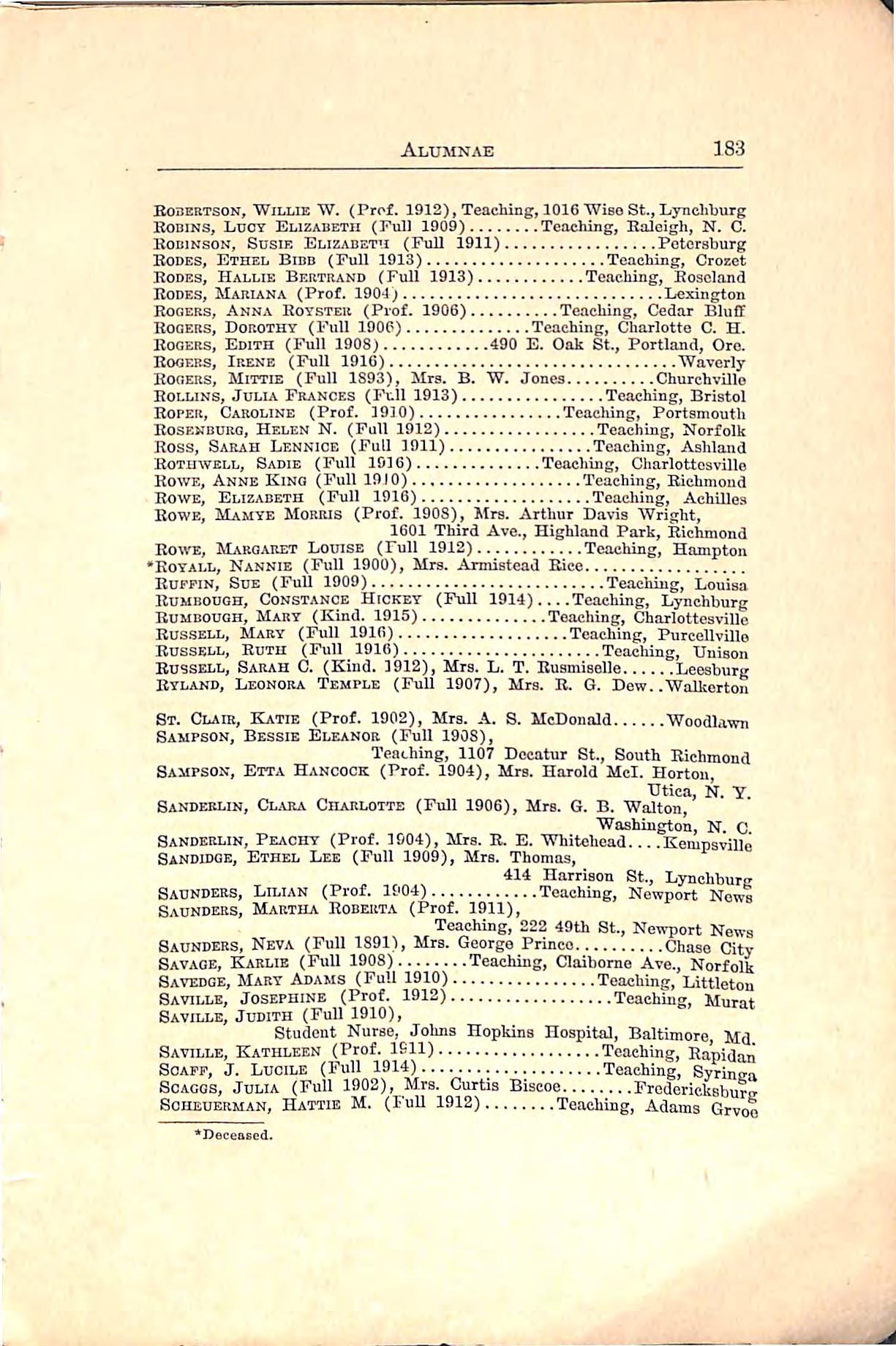
EOBERTSON,Willie"SV.(Prof.1912),TeacMng,1016WisoSt.,Lyncliburg Robins,Lucy Elizabeth (Full 1909) Teaching,Raleigh, N.C. Robinson,SusieElizabeth(Full1911) Petersburg Rodes, Ethel Bibb (Full 1913) Teaching, Crozct RODEs,HallieBertrand(Full1913) Teaching,Roscland Robes,Mariana(Prof.1904) Lexington Rogers,AnnaRoysteu(Prof.1906) Teaching,CedarBluff Rogers,Dorothy(Full1006) Teaching,CharlotteC.H. Rogers,Edith(Full1908) 490E.OakSt.,Portland,Ore. Rogers,Irene(Full1916) Waverly Rogers,Mittie(Full1S93),Mrs.B.W.Jones Churchvillo Rollins,JuliaFrances(Full1913) Teaching,Bristol Roper,Caroline(Prof.1910) Teaching,Portsmouth Rosenborg,HelenN.(Full1912) Teaching,Norfolk Ross,SarahLennice(Full1911) Teaching,Ashland Rothwell,Sadie(Full1916) Teaching,Charlottcsville Rowe,AnneKino(Full1910) Teaching,Richmond Rowe,Elizabeth(Full1916) Teaching,Achilles RowE,MamyeMorris(Prof.1908),Mrs.ArthurDavisWright, 1601ThirdAve.,HighlandPark,Richmond Ro\vE, M,\rgaret Louise (Full 1912) Teaching, Hampton •Royall,Nannie(Full1900),Mrs.ArmisteadBice RUFPiN,Sue(FuU1909) Teaching,Louisa RUMBOOGH, Constance Hickey (Full 1914) Teaching, Lynchburg RUMBOUOH,Mary(Kind.1915) Teaching,Charlottesvillc Russell,Mary(Full1916) Teaching,Purcellvillo Russell,Ruth(Full1916) Teaching,Unison Russell,Sarah C.(Kind.3912),Mrs.L.T.RuBmiselle Leesburg Ryland,LeonoraTemple(Full1907),Mrs.R.G.Dew..Walkerton St.Clair,Katie(Prof.1902),Mrs.A.S.McDonald Woodlawn Sampson,BessieEleanor(Full190S), Teaching,1107 Dccatur St., South Richmond Sampson,Etta Hancock (Prof.1904),Mrs. Harold McI.Horton, "Utiea,N.Y. Sandeelin,Clara Charlotte (Full 1906),Mrs. G. B. Walton, Washington,N.C Sanderlin,Peachy (Prof.3904),Mrs.R.E.Whitehead Kempsville Sandidge,EthelLee(Full1909),Mrs.Thomas, 414 Harrison St., Lynchburg Baunders, Lilian (Prof. 1904) Teaching, Newport News Saundees,MarthaRoberta(Prof.1911), Teaching,222 49th St.,Newport News Saunders, Neva (Full 1891), Mrs. George Prince Chase City Savage, Karlib (Full 1908) Teaching, Claibome Ave., Norfolk Savedge, Mary Adams (FuU 1910) Teaching, Littleton Saville, Josephine (Prof. 1912) Teaching, Murat Savxlle,Judith (Full 1910), Studcut Nurse, Johns Hopkins Hospital, Baltimore, Md Saville, Kathleen (Prof. 1911) Teaching, Rapidan SOAPF, J. Lucile (Full 1914) Teaching, Syringa Scaggs, Julia (Full 1902), Mrs. Curtis Biscoe Fredericksburg Scheuerman, Hattib M. (Full 1912) Teaching, Adams Grvoo
*UecG&Ecd.

ScnLossER,LydiaMae(Prof.1910) Teaching,Calvorton ScHOPiELD,MaryMerger(Full1907),Mrs.B.C."Watkins,Miuiothian Scott,Annie(Full1896),Mrs.RobertBranch Morven Scott,Beulah(Full1915) Teacliing,Portsmouth Scott,FannieG.(Pull1915) Teaching,RoundHill •Scott,Lelia(Full1899) Scott,Ehea(Kind.1906)
RuralSupervisor,Arkansas Seabuby,Cornelia(Full1916) Teaching,R.F.D.4,Richmond Sedwick,Beulah(Full1916) Teaching,Richmond Selden,Mary(Prof.1901) Teaching,NewportNews Semones,LouiseBernard(Prof.1907), Teaching,927GreenSt.,Danville Seybert,Sallie(Prof,jf'14) Monterey Seymour,AnniePbgram(Prof.1912) Teaching,Lacrosse Sh\kpe,Ida(Prof.1901),Mrs."WalterJ.Cos Teaching,Crowe Shaw,F.Margaret(Full1913) Teaching,Ebony Shaw,MaryAllen(Prof.1911),Mrs.H.McD.McCue, 312%33dSt.,Richmond Shell,Eptie(Full1894),Mrs.Chappell Dinwiddie Shell,Peachy(Prof.1897),Mrs.R.E.Brown,1295CarySt.,Richmond Shelor, Fitzhugh (Full 1916)... Teaching, R. F. D., Salem Shelton,MarySusanna(Full1909) Teaching,Bacon'sCastle Shepard,AgnesRuth(Prof.1911),Mrs.ClevelandForbes,Buckingham Shepard,JosephineC.(Full1914) Teaching,Charlottcsville Sherrard,JosephineC.(Full1914) Teaching,CliarJottesvillo Shewey,Mabel(Prof.1911) RockbridgoBaths
Short, Bettie H. (Full 1912) Teaching, Ebony Shorter,FannyBelle(Prof.1907) Teaching,Birmingham,Ala. Shugert,Maria Thornton (Full 1910) Bcrryville Sibley,Maggie(Prof.1900),Mrs.H.S.Smith Newport News Sinclair, Etta (Prof. 1903) Teaching, Hampton Sinclair, Mattie (Full 1916) Teaching, Phcebus Slaughter,Jane Chapman (Prof.1912) Teaching, Fairfield Slaughter, Marie (Prof, and Full 1897), Mrs. Harvie Hall..Roanoke Smith,Ada Bunkley (Full 1911), Teaching,2602CliestnutAve.,NewportNews
Smith, Ada May (Full 1906) Teaching, Ashland
Smith, Alice (Full 1916) Governess, Indian Bock
Smith,Clara Gresham (Full 1907),Mrs.L. T.Stoncburner,Jr., Richmond
Smith,DeBerniere (Full 3006), Mrs. M. McM.Gray, GintcrPark,Richmond
Smith,Emma R.(Full 1916) Teaching, Surry C. H. Smith, Eunice (Full 1916; Teaching, Rice Smith,Eva (Prof. 1896), Mrs. Ferebee "Virginia Beach
Smith, Frances W. N. (Full 1913), Mrs. Henry 0. Taylor, Petersburg Smith, Frances Yancey (Full 1902), Y. W. 0. A. Field Secretary, 1411 Locust St., St. Louis, Mo. Smith, Janet (Full 1915) Teaching, Port Norfolk
Smith,Lily (Prof. 1897),Mrs. W.W.Martin Akron,Ohio
Smith, Mabel Muir (Prof. 1911) Teaching, Palls
Smith, Martha Frances (Full 1911), Teaching,258 Maryland Ave.,Port Norfolk
•OocoaBod.
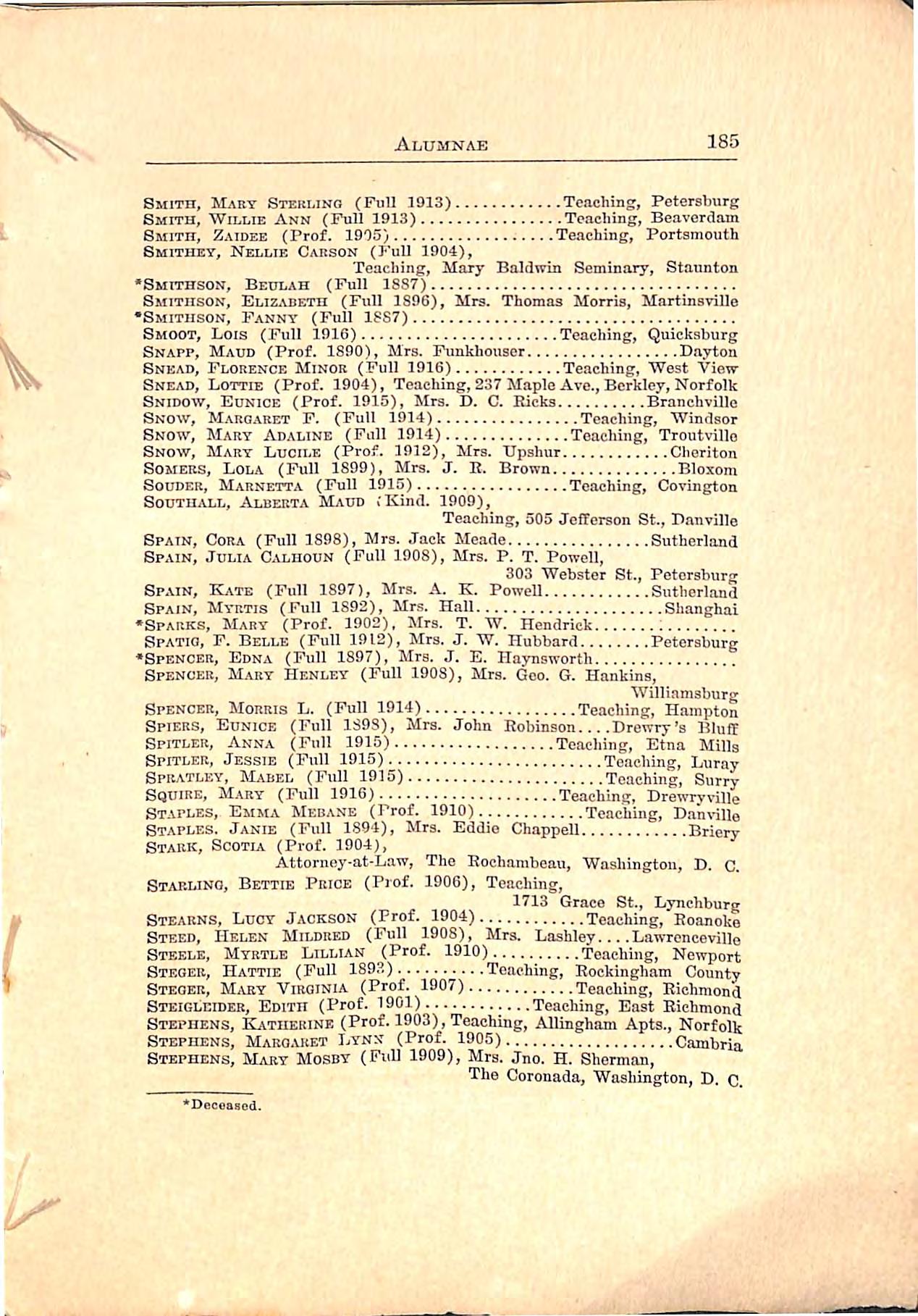
Alumnae 185
Smith,MaktSterling(Full1913)
Teaching,Petersburg Smith,WillieAnn(Full1913) Teaching,Beavordam Smith,Zaidee(Prof.1905) .....Teaching,Portsmouth
Smithey, Nellie Carson (Full 1904), Teaching,MaryBaldwinSeminary,Staunton •Smithson, Betilah (Full 18S7) Smitiison,Elizabeth(Full1896),Mrs.ThomasMorris,Martinsville •Smithson, Fanny (Full 1887) Smoot,Lois(Full1916)
Teaching,Quicksburg Snapp,Maud(Prof.1890),Mrs.Funkhouser Dayton Snead,FlorenceMinor(Full1916)
Teaching,WestView Snead,Lottie(Prof.1904),Teaching,237MapleAve.,Berkley,Norfolk Snidow,Eunice(Prof.1915),Mrs.D.C.Ricks Branchville Snow,MargaretF.(Full1914) Teaching,Windsor Snow,MaryAdaline(Full1914) Teaching,Troutvillo Snow,MaryLucile(Prof.1912),Mrs.Upshur Cheriton SOMERS,Lola(Full1899),Mrs.J.R.Brown Bloxom Souder,Marnetta(Full1915) Teaching,Covlngton Soutuall,AlbertaMaud»Kind.1909), Teaching,505JefTersonSt.,Danville Spain,Cora(Full1898),Mrs.JackMeade Sutherland Spain,JuliaCalhoun(Full1908),Mrs.P.T.Powell, 303WebsterSt.,Petersburg Spain,ILvte(Full1897),Mrs.A.K.Powell Sutherland Spain,Myrtis(Full1892),Mrs.Hall Shanghai •Sparks,Mary(Prof.1902),Mrs.T.W.Hendrick : Spatio, F.Belle (Full 1912), Mrs.J. W.Hubbard Petersburg •Spencer,Edna(Full1897),Mrs.J.E.Hajmsworth Spencer,MaryHenley(Full1908),Mrs.Goo.G.Hankins, Williamsburg
Spencer, Morris L.(Full 1914) Teaching, Hampton Spiers, Eunice (Full 1893), Mrs. John Robinson Drewry's Bluff Spitler,Anna(Full1915) Teaching,EtnaMills Spxtler, Jessie (Full 1915) Teaching, Luray Spratley, Mabel (Full 1915) Teaching, Surry Squire, Mary (Full 1916) Teaching, Drewryville Staples, Emma Mebane (Prof. 1910) Teaching, D.an\-ille Staples. Janie (Full 1894), Mrs. Eddie Chappell Briery Stark,Scotia(Prof.1904), Attorney-at-Law, The Rochambeau, Washington, D. C. Stap-lino, Bettie Price (Prof. 1906), Teaching, 1713 Grace St., Lynchburg Stearns, Lucy Jackson (Prof. 1904) Teaching, Roanoke Steed, Helen Mildred (Full 1908), Mrs. Lashley Lawrcnceville Steels, Myrtle Lillian (Prof. 1910) Teaching, Newport Stegek, Hattie (Full 1893) Teaching, Rockingham County Steoer, MxVey Virginia (Prof. 1907) Teaching, Richmond Steigleider,Edith (Prof.1901) ....Teaching,East Richmond Stephens,Katiiekine(Prof.1903),Teaching,AUingham Apts.,Norfolk
Stephen.s, Margaret Lynn (Prof. 1905) Cambria Stephens, Mary Mosby (Full 1909), Mrs. Jno. H. Sherman, The Coronada,Washington,D.C.
'Doco&sod.
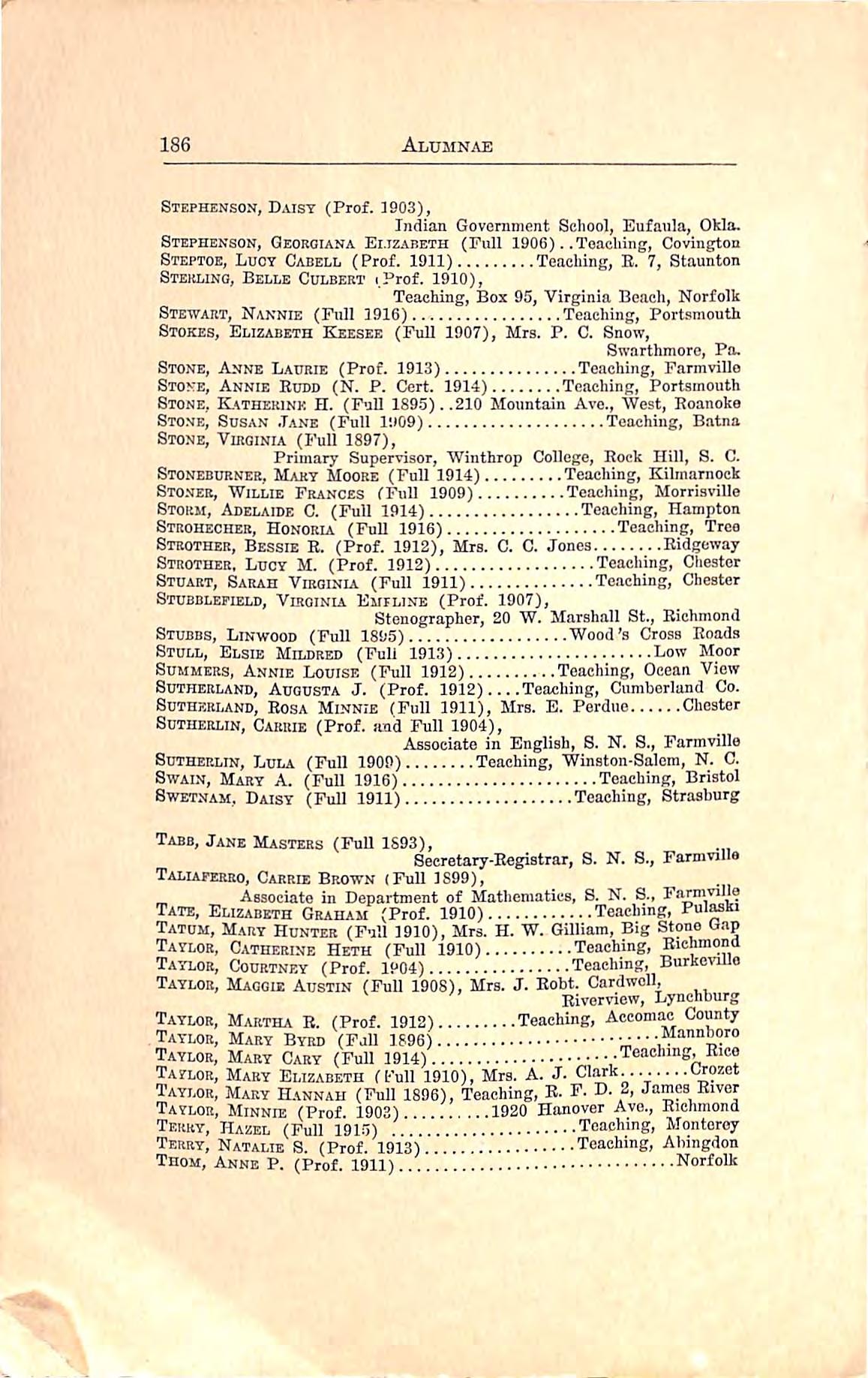
Stephenson,Daisy(Prof.1903), IndianGovernmentSchool,Eufaiila,Okla. Stbphenson,GeoroianaElizabeth(Full1906)..Toaching,Covington Steptob,LuotCabell(Prof.1911) Teaching,E.7,Staunton STEiaiNO,BelleCulberti.Prof.1910), Teaching,Box95,VirginiaBeach,Norfolk Stewart,Nannie(Full1916) Teaching,Portsmouth Stokes,ElizabethKeesee(Full1907),Mrs.P.C.Snow, Swarthmore,Pa. Stone,AnneLaurie(Prof.1913) Teaching,Farmvillo Stoke,AnnieRudd(N.P.Cert.1914) Teaching,Portsmouth Stone,K.atherinkH.(Full1895)..210MountainAre.,West,Roanoke Stone,Susan.Tane(Full1U09) Teaching,Batna Stone,Virginia(Full1897), PrimarySupervisor,WinthropCollege,RockHill,8.C. Stoneburner,MaryMoore(Full1914) Teaching,Kilmarnock Sto.ner,WillieFrancesCFuU1909) Teaching,Morrisville Storm,AdelaideC.(Full1914) Teaching,Hampton Strohecher,Honoru(Full1916) Teaching,Trco Strother,BessieR.(Prof.1912),Mrs.C.C.Jones Ridgoway Strother,Lucy M.(Prof. 1912) Teaching, Chester Stuart, Sarah Virginia (Full 1911) Teaching, Chester Stubblepield,VirginiaEmfline(Prof.1907), Stenographer,20 W.Marshall St.,Richmond Stubbs, Linwood (Full 1895) Wood's Cross Roads Stull, Elsie Mildred (Full 1913) Low Moor Summers,Annie Louise (Full 1912) Teaching, Ocean View Sutherland, Augusta J. (Prof. 1912)....Teaching, Cumberland Co. Sutherland,Rosa Minnie (Full 1911), Mrs. E.Perdue Chester SuTHERLiN,Carrie (Prof,and Full 1904), Associate in English,S. N. S., Farmville SuTHERLiN, Lula (FuU 1909) Teaching, Winston-Salem, N. C. Swain,Mary A.(Full 1916) Teaching,Bristol SwBTNAM,Daisy (Full 1911) Teaching, Strasburg
Tabb,Jane Masters(Full1893), Secretary-Registrar, 8. N. 8., Farmville Taliaperro,Carrie Brown (Full 1899), Associate in Department of Mathematics, S. N. S., Farnmlle Tate, Elizabeth Graham (Prof. 1910) Teaching, Pul^ki Tatum,Mary Hunter(Full1910),Mrs.H.W.Gilliam,Big Stonet»ap Taylor, Catherine Heth (Full 1910) Teaching, Richmond Taylor, Courtney (Prof. 1904) Teaching, Burkevillo
Taylor, Maggie Austin (Full 1908), Mrs. J. Robt. Cardwcll, ^ ' Rivorview,Lynehburg
Taylor, Martha R. (Prof. 1912) Teaching, Accomac County Taylor, Mary Byrd (FdU .Mannboro
Taylor, Mary Cary (Full 1914) Teaching, Rico
Taylor,Mary Elizabeth (Pull 1910),Mrs.A.J.Clark.... urozet
Taylor, Mary Hannah (Full 1896), Teaching, R. F. D. 2, James River Taylor,Minnie(Prof.1903) 1920 Hanover Avo.,Richmond
Terry, Hazel (Full 1915) . Teaching, Montoroy Terry, Natalie S. (Prof. 1913) Teaching, Abingdon Thom, Anne P.(Prof. 1911) Norfolk
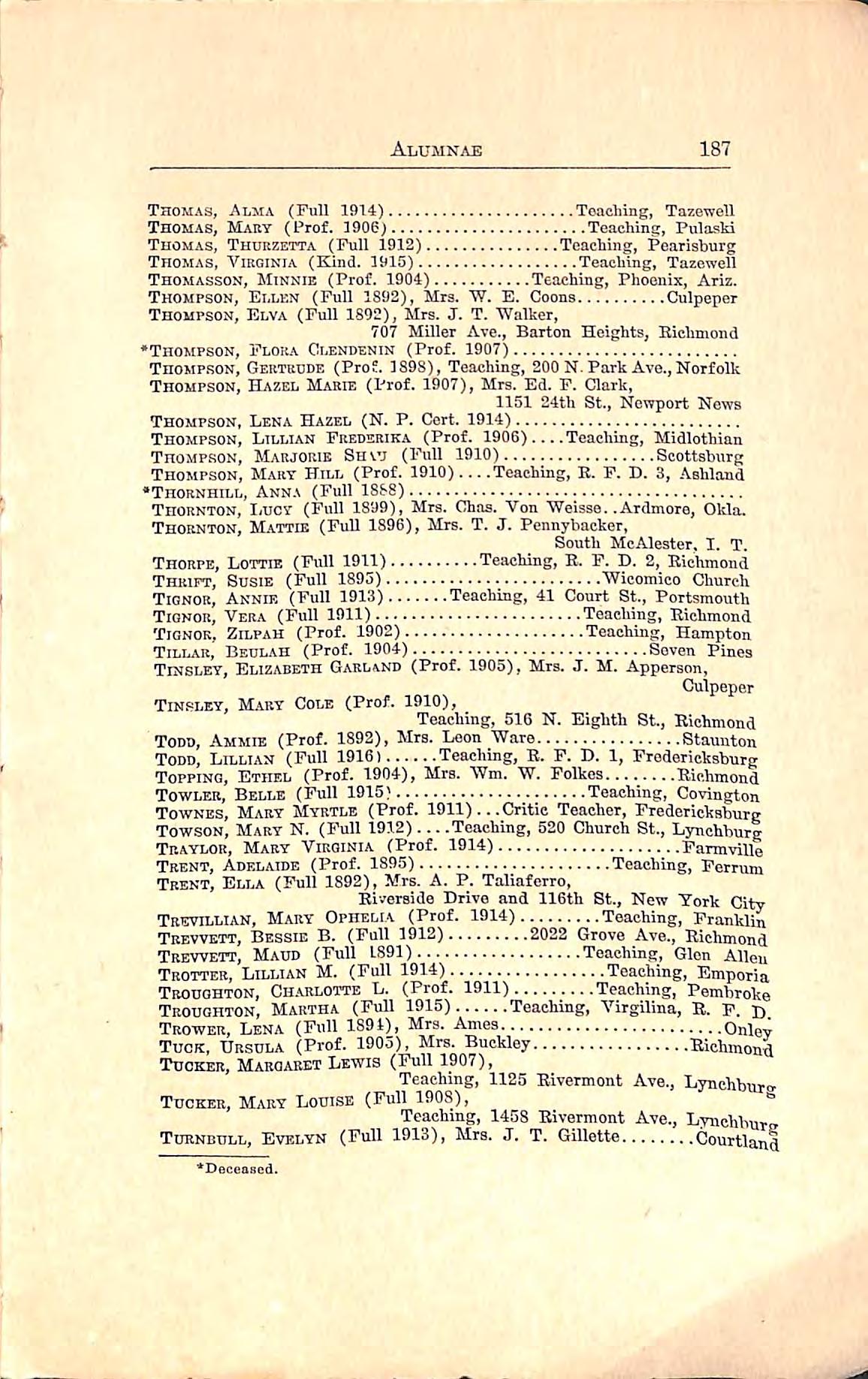
Thomas,Alma(Full1914)
Teaching,Tazewell Thomas, Mary (Prof. 1906) Teaching,Pulaski Thomas,Thubzetta(Full1912) Teaching,Pearisburg Thomas,Virginia (Kind.191G) Teaching, Tazewell Thomasson,Minnie(Prof.1904) Teaching,Phoenix,Ariz. Thompson,Ellen(Full1S92),Mrs."W.E.Coons Culpeper Thompson,Elva(Full1892),Mrs.J.T.Walker, 707MillerAve.,BartonHeights,Eiclunond •Thompson,FloilaClendenin(Prof.1907) Thompson,Gertrode(Prof.1898),Teaching,200N.ParkAve.,Norfolk Thompson,HazelMarie(Prof.1907),Mrs.Ed.F.Clark, 115124thSt.,NewportNews Thompson,LenaHazel(N.P.Cert.1914) Thompson,LillianFrederika(Prof.1906)....Teaching,Midlothian TnoMPKON, Marjorie Shvv (Full 1910) Scottsburg Thompson,MaryHill(Prof.1910)....Teaching,R.P.D.3,Aehland •TnoRNHiLL,Anna(Full1888) Thornton,IjUCY(Full1899),Mrs.Chas.VonWeisse..Ardmore,Okla. Thornton,Mattib(Full1896),Mrs.T.J.Pennybacker, SouthMcAlester,I.T.
Thorpe,Lottie (Full 1911) Teaching,R.F.D.2,Richmond Thrift, Susie (Full 1895) Wicomico Church Tignor, Annie (Full 1913) Teaching,41 Court St.,Portsmouth Tiqnor,Vera(Full1011) Teaching,Richmond Tignor,Zilpah(Prof.1902) Teaching,Hampton TilIuAR,Beulah(Prof.1904) SovenPines TiNSLEY,Elizabeth Garland (Prof.1905),Mrs.J. M.Apperson, Culpeper TiNSLEY, Mary Cole (Prof. 1910), Teaching,516N.EighthSt.,Richmond
TODD, Ammie (Prof. 1892),Mrs.Leon Ware Staunton
TODD,Lillian (Full 1916) Teaching,R.F.D.1,Fredericksburg Topping, Ethel (Prof. 1904), Mrs. Wm.W.Folkes Richmond Towler,Belle (Full 1915) Teaching, Covington Townes,Mary Myrtle(Prof.1911)...Critic Teacher,Fredericksburg TowsoN,Mary N.(Full 1912) Teaching,520 Church St., Lynchburg Traylob,MaryVirginia(Prof.1914) Farmville Trent,Adelaide(Prof.1895) Teaching,Ferrum Trent,Ella(Pull1892),Mrs.A.P.Taliaferro, Riverside Drive and 116th St., New York City Trevillian, Mary Ophelia (Prof. 1914) Teaching, Franklin Tbevvett,Bessie B.(Pull 1912) 2022 Grove Ave., Richmond Trewett, Maud (Full 1891) Teaching, Glon Allen Trotter,Lillian M.(Full 1914) Teaching,Emporia Trouohton, Charlotte L.(Prof.1911) Teaching, Pembroke Tboughton, Martha (Full 1915) Teaching, Virgilina, R. F. H Trower,Lena (Full 1894),Mrs.Ames Onlev Tuck, Ursula (Prof. 1905), Mrs. Buckley Richmond Tucker,MabcarbtLewis(Full1907),Teaching,1125 Rivermont Ave.,LynchbnroTucker, Mary Louise (Full 190S), Teaching,1458 Rivermont Ave.,Lynchbur» Turnbull, Evelyn (Full 1913), Mrs. J. T. Gillette Courtland
•Deceased.

Tcrnbull,Gertrude(Kind.3915).Teaching,GinterPaxk,Richmond Tuknbull,MaryT.(lOnd.1914),Mrs.WilliamVaugban,SouthBoston Turnbull,Pattie Prince ("Full 1911) Teaching, Richmond Turner,Bessie(Full1893) Teaching,Staunton Turner,Doris(Ihill1916) Teaching,BoxElder Turner,Marion(Prof.1910)....Teaching,BartonHeights,Richmond Turner,Martha(Full1898),Mrs.W.L.Cooke NewportNews Turner,Nannie(Prof.1903),Mrs.J.J.Montague, 811E.FranklinSt.,Richmond Turpin,MaryEt.izabeth(Thill1910),Mrs.HaskinsWilliams,Boydton Twelvetrees,IjOUISeV.(Full1892),Mrs.J.C.Hamlctt, R.F.D.4,Farmville Twitty,LauraLeigh(Pull1910) Teaching,Petersburg Tyus,AnnieMae(Full1915) Teaching,Whaleyvillo Ttus,MaryLouise(Full1914) Teaching,StonyCreek
•Upchurch,MargaretLee(Full1913) Upson, Sadie Margaret (Full 1914) Teaching, Big Island
Vaden,Mary (Pull 1898), Mrs.B.L. Blair Troy, N.C. Vaden, Sallie (Full 1890), Mrs. George Wray Cambridge, Md. Van Vort,Bertha (Full 1889),Teaching,314 E.Grace St.,Richmond Vaughan, Corinne (Full 1S91), Mrs. Hoffman Eoanoke Vaughan,Ellen (Full 1915) Teaching, R. 3, Charlotte C. H. Vaughan,IvaPearl(Prof.1906),Mrs.W.A.Chiklrey, 3509 E. Gary St., Richmond Vaughan,Julia (Full 1899),Mrs. Kirk Lunsford Roanoko Vaughan, Katherine (Prof. 1902), Mrs. Southall Farrar, Jetersville Vaughan, Lizzie (Full 1896) Teaching. Morven Vaughan, Louise F. (Prof. 1904), Mrs. M. A. French Sunnyside Vaugh^^vn,Rebecca Pocahontas (Prof.1907),Mrs.R. O.Graham, Goshen
Vaughan,S.Eugenia (Full 1896),Mrs.Brannon Pettit, Miss Venable, Genevieve (Full 1898), Mrs. Morton Holladay,Hampden-Sidney
Venable,Ruby (Ihill 1896), ^ ^ Trained Nurse, Base Hospital, Fort Sam Houston, San Antonio, Texas Verser, Elizabeth (Full 1906), Mrs. W.Brazeal Hobson, Farmville Verseb, Merrie (Full 189G),Mrs.W.O.Howard,Ginter Park,Richmond
Wade, Elizabeth Hamh.ton (PuR 1905), Mrs. Frank M. Wootten, Greenville, N.C. Wade, Mamie (Prof. 1902), Mrs. Wm. B. Pettigrew....Florence, 8. C. Wainweight, Mattie (Full 1897), Mrs. Frank W. Hubbard, Farmville Walker, Anne M. (Prof. 1912) Teaching Columbus, Walker, Fannie (Full 1S89), Mrs. J. H. Long White Spring, Fla. Walker, Gilliam (Full 1916) Teaching, Union, W. Va. Walker,Louise M.(Kind.1912), .rrr-i • ^ T^ i Teaching, 908 King St., Wilmington, Del. Walkup, Elisabeth Echoes (Kind. 1914) Empona Walkup, Nancy Wyndh.vm (Prof. 1910), Mrs. J. S. Wills...^omsa Wall,Lillian Clare (Pull 1911) Teaching, Bluefieid, W.Va. Wall, Mary Evans (Prof. 1913) Teaching, Marion ^Deceased.

WaIiLer, Roberta L.(Prof. 1912) Teaching, Woodford Walters,Eva Mebane (Full 1910) CHiarlottc
*Walthall, Julia (Prof. 1S96)
•Walthall,Rosa Epsib ^^Prof. 1905 Walton,EmmaLockett(Full1908) Farmville Walton,Lena(Full1893),Mrs.Roberts CharlotteCounty Walton,Lily(Full1896),Mrs.W.W.Bondurant, 2001N.FloresSt.,SanAntonio,Texas Walton,MaryGil^ce(Prof.1906),Mrs.P.B.Barton, St.ThomasAsoca,La. Warburton, Lucy Allen fFull 1909) Williamsburg Warbdrton,MadelineMapp(Full1916) Teaching,Cartersvillo Ward,Dorothea(Full1916) Teaching,Portsmouth Ward,EmilySusan(Full3910),Mrs.O.B.McLean, 1039WestoverAve.,Norfolk Ward,RuthA.(Full1912)..StudentNurse,St.Lake'sHospital,N.Y. Ware,Alice(Prof.1905) Teaching,Brarabletcn,Norfolk Waring,Emma(Prof.1906)(Married) Lynchburc Warner,SusieWare(Prof.1902),Mrs.W.A.Maddox, TeachersCollege,N.Y. Warren,Grace(Prof.1903),Mrs.Jas.R.Rowell,Jr Smithlleld Warren,Mary(Full1896),Asst.Metropolitan Museum,New York Citj' Warren,Odelle(FullISO'^;,Mrs.M.L.Bonham,BatonRouge,La. Watkins,Alice(Full1897),Stenographer,2421ParkAve.,Richmond Watkins,Elizabeth E.(Full 1900),Mrs. Harry E.Houston,Hampton Watkins,Eloise(Kind.IQ.'.ol Teaching,SevenMileFord Watkin.s,EuniceLeG.(Prof.1912),Mrs.L.W.Wood,Charlottesville Watkins,Henrietta(Prof.1903),Mrs.0.R.Warren Chatham W.A.TKINS,KateFriend(Full1909),Mrs.JamesD.Morton,Danville Watkins,Margaret(Full3892),Trained Nurse,910 Park Avo.,Richmond *Watkins,Marion (Full 1901),Mrs.A.L.Martin Watkins,Martha Lois(Full1908),Mrs. Winfrce Chewning,Hallsboro Watkins,MarthaScott Teaching,Cumberland W.ATKINS, Mary Venable (Full 1908) Teaching, Glen Alien Watkins,Nannie G.(Prof. 1911) 403 Chestnut St., Danville Watkins, Neville (Full 1903), Mrs. B. H. Martin, R.F.D. 2, Richmond Watkins, Suzanne Rocre (Prof. 1914)....Teaching, Charlotte C. H Watkins,Virginia (Kind.1916) Teaching,Richmond Watson, Calva Hamlet (J'rof. 1905) Teaching, Burkeville •Watson,Georgia (Full 1S93), Mrs. Copeland Watson, Vedah May (Full 1908), Mrs. L. H. Dressier Coi-ington Watterson, Pearl (Prof. 1901) Teaching, Olmstend, W. Va Watts, Ida (Full 1888) Teaching, 1001 Clay St., Lynehburc^ Wayts, Josephine (Full 1015) Teaching, Ashland Webb, Emma Ruth (Full 15)14). Teaching, Emporia Weiser, Mary Ware (Full 1913) Teaching, E. Radford Welker, Gertrude (Full 1915) Teaching, Norfolk Welker, Grace Louise (l''uil 1914) Teaching, Norfolk Wells,Bessie (Full 1901)..•.Teaching, 1520 Porter St., So. Richmond Wells, Florence M-ay (Full 1914) Teaching, LynchburoWei.sh, Alice (Prof. 1901), Seerotaiy John Marshall School, Richmond Welsh, Charlotte (Prof. 1897) Tenth Ave., S. W., Boanoko
•Deceased.

Alumnae
Welsh,Mabelle(Prof.38J'6),Mrs.CliffordEudd Bensley Wescott,CobinneM.(Full1914) Teaching,TomperancoviUe Wescott,Georgia(Full1894),Mrs."WillStockley, Teaching,Temperanceville West,Eixa(Prof.1892),Mrs.0.W.Gray Memphis,Tenn. Whealton,E.Janie(Full1901),Mrs.T.S.Leitner..Chester,S.C. Whitaker,Alice(Prof.1898),Mrs.EdwardBates Ivor White,EleanorC.(Prof.1903),Mrs.C.L.Yancey,Washington,D.C. White,ElizabethB.(Full1916) Teaching,AmeliaC.II. White,EvaLovelace(Kind.1908),Mrs.E.D.Lupton....Lynchburg White,Frances(Prof.1901),Mrs.P.S.Mertins..Montgomery,Ala. White,IndiaB.(Prof.19*2) Teaching,Eiw White,Jeannette(Prof.1901),Mrs.Morehead Cleveland,Ohio White,Josephine(N.P.CVrt.1914) Teaching,Curdsvillo •White,Marv(Full189.3),Mrs.Pearson White,Nellie(Prof.1903)
Teaching,Salem White,PenelopeB.(Full1911),Teaching,940NorthSt.,Portsmouth *Whiteheaj>,Lillian (Full 1893),Mrs.E.H.Eussell Whiting,HenbieAugustine(Full1887),Mrs.C.R.Mcllwaine, 2326HighlandAve.,Knoxville,Tenn. Whitlet, Mary Edith (Prof. 1905) Indika Whitman,Pearl(Full 1903),Mrs.S.R.Knox Mt.IJlla,N.C. Whitmore,Jessie Evans(Prof.1904),Mrs.ElliottR.Booker,FarmviUe WiATT,Eleanor Baytop (Full 1907), Mrs.Burton Belcher, Sunnyside,Fla. Wicker,Belle (Full 1893) Teaching,Beaufort, S. C. Wicker, Katherine (Full 1887), Teaching, Maury High School, Norfolk Wicker, Maud (Full 1896) FarmviUe Wicker, Nellie (Full 1895), TrainedNurse,ColumbiaHospital,Pittsburg,Pa. Wilder,Happy(FuU 1909) Teaching,South Boston WILKERSON, IVA N. (Full 1911) Teaching, Elba *Wilkie,Katkie (Full 1894) 4^"
WiLKiE, Mary C. (Full 1897) Teaching, Lexington, Ky. WiLKENSON, Anne C. (Full 1912) Teaching, S. N. S., FarmviUe Wilkinson, May I. (Prof. 1912) .....Teaching, Dendron Willard,Moffett(Prof.1915) Teaching,Prince George G.H. Williams, Janie (Prof. 1901) Teadnng, Well Water Williams,-LUCU.LE Katherine (Prof. 1914)......Te.aelung, Palmyra Williams, Lucy McMurray (Prof. 1913) Teaching, Brookneal Williams, Moodie Elizabeth (Full 1910) Teacliing, Cambria Wn.LiAMS, Virginia (Full 1915) '"T® wf!! Williamson, Florence J. (FuU 1913) Teaching, Crabbottom Williamson, Mary (Kind. 1916) *' Williamson, Pauline (Prof. 1906) Teaching, S. N. S., Farmvijle Willis,Eva (Prof.1892),Mrs.R.R.Crall6..........-.••• Wilson, Elsie E. (Full 1911), Teaching, 235 26^ St., Ne^ort News Wilson, Grace Macon (Prof. 1905), Mrs. Jas. E. Bosworth, Browns^llo Wilson, Lillian L. (Prof. 1912) Teaching, East Dupont, Del. Wilson, Marguerite A. (N. P. Cert. 1914), Teaching, Newport JJiws Wilson, Mattie (Full 1896), Mrs. James Womaclc...........Suffolk Wilson, Virginia Elmo (Prof. 1913)
WiMBisH, Helen (Prof. 1915) Teaching, CharlottesvUle
•Deceased.

WiMBisn,NannieC.(Prof.1911) Teaching,Potorsburg •WiNPiELD,Florence (PriiP.1902) WiNFREE,Emma(Prof.1S95) Teaching,BigStoneGap WiNQATE,PearlAgnes(Prof.190S),Mrs.Sturm Appalachia WiNGO,GermaniaJ.(Full1911) Teaching,AmeliaC.H. "WiNGO, Viola (Kind. 1915) Teaching, Norwood "WiNGPiELD,Nora(Prof.1S92),Mrs.W.N.Sebrell Courtland Winston,Helen(Prof.1902) CriticTeacher,Frcdericksburg Winston,Josje(Full1888),Mrs.T.A.Woodson, 528VictoriaAvc.,Lynchburg Winston,Lizzie (Full 1888) Teaching,1607 Grove Ave.,Richmond WOLP, Elizabeth T. (Full 1895) Teaching, Escuola, Arizona Wolfe, FitANCES Roberde.w (Prof. 1905) Teaching, Panicltown Womack,Mary(Pull1891),Teaching,511W.112thSt.,NowYorkCity WoMACK,Preston,(Full1892) Washington,D.C. Womack,Rose(Full1893),Mrs.Wm.Henderson,DarlingtonHeights Wonycott,Margaret(Full1916) Teaching,Portsmouth Wood,Carrie(Kind.1916) Teaching,Hampton Wood,Lucile(Full1915) Teaching,Hickory Wood,Lucy(Full1902)....Stenographer,309S.ThirdSt.,Richmond WoODHOUSE,Grace(Full1.912),Mrs.Wm.G.Hopkins..Baltimore,Md. WOODROOP,AnneMiller(Full191.8),Mrs.M.A.Creasy Gretna WOODROOP,HessieSt.Clair(Prof.1905),Mrs.J.LuckinBugg, Parmville Woodson,GraceT.(Prof.1912),Mrs.Jno.I.Burton Marion Woodson,LillianP.age(Piof.1910),Mrs.B.P.Coleman,Smithfiold Woodson,Lucile(Full1916) Teaching,Charlottesnlle Woodson,MabelHarris(Full1909),
Teaching, 2609 Fifth St., Lynchburg Woodward, Katherine F. fKind. 1914) Teaching, Clifton Forgo Woodward,MargaretD.(Prof.1912) Teaching,Richmond WoOTTEN,Agnes(Full1895),Mrs.RichardSpencer Fnrmville Wr/VY,Charlotte(Prof.1S97), PrimarySupervisor,2314StuartAvo.,Richmond Wkenn,EppieB.(Full1911) Teaching,SussexC.H Wright, Betty Campbell (Prof. 1909) Teaching, Smithfiold Wright,Lucy (Full 1899), Mrs. Robert James Newport News Wright,Nor.naBrenda(Full1911) Teaching,WittcnsMill Wright, Susan Dickenson (Prof. 1907), Teaching, Lake Village, Ark Wygal,Bonnie M.(Full 1914) Teaching, Lee Co Wynne, Bessie M. (Full 1912) Teaching, Ashland Wynne, Ella Letitia (Prof. 1913) Drewryvllie
Yancey, Martha Bedford (Prof. 1910), Mrs. L. T. Paylor, South Boston *
YoNGE, Mary (Prof. 1903) Teaching,331 28th St., Norfolk Young, Elizabeth Walker (Prof. 1916) ^ YOUNO, Eula (Prof. 1903), Mrs. R. D. Morrison, 310 E. Grace St., Richmond Young, Jessie (Full 1897) Teaching, Lexington
Zbbnow, Margaret (N. P. Ce^. 1915) Teaching, Matoaca
Total number of graduates, 3,697.
•Doc'oasod.

